Palm I70500 Handheld PDA with low duty cycle packet data User Manual Tornado conntoPC eps
Palm Inc Handheld PDA with low duty cycle packet data Tornado conntoPC eps
Palm >
Exhibit 8 Instruction Manual See page 227 for SAR and Part 15 statements
Handbook for the
Palm i705™ Handheld

Copyright
Copyright © 1998-2001 Palm, Inc. All rights reserved. Graffiti, HotSync, MyPalm, MultiMail, and Palm OS
are registered trademarks, and the HotSync logo, Palm, and the Palm logo are trademarks of Palm. Other
product and brand names may be trademarks or registered trademarks of their respective owners.
Query to Andover/Marketing: What is the official name of blaster, and is that a trademarked or registered
entity?
Disclaimer and Limitation of Liability
Palm assumes no responsibility for any damage or loss resulting from the use of this guide.
Palm assumes no responsibility for any loss or claims by third parties which may arise through the use of
this software. Palm assumes no responsibility for any damage or loss caused by deletion of data as a result
of malfunction, dead battery, or repairs. Be sure to make backup copies of all important data on other media
to protect against data loss.
IMPORTANT Please read the End User Software License Agreement with this product before using the
accompanying software program(s). Using any part of the software indicates that you accept the terms of the
End User Software License Agreement.
Software Download Available
Palm™ Desktop software is supplied on a CD-ROM disc. If you do not have access to a CD-ROM drive for
your computer, you can download the Palm Desktop software from www.palm.com.
PN: 406-2771-01

i
Contents
About This Book . . . . . . . . . . . . . . . . . . . . . . . . . . . . . . . . . . . . . . . . . . . . . . . . 1
Chapter 1: Setting Up . . . . . . . . . . . . . . . . . . . . . . . . . . . . . . . . . . . . . . . . . . . 3
System Requirements . . . . . . . . . . . . . . . . . . . . . . . . . . . . . . . . . . . . . . . . . . . . . . . . 3
Minimum requirements: Windows . . . . . . . . . . . . . . . . . . . . . . . . . . . . . . . . . . 3
Minimum requirements: Macintosh . . . . . . . . . . . . . . . . . . . . . . . . . . . . . . . . . 4
Internet Access . . . . . . . . . . . . . . . . . . . . . . . . . . . . . . . . . . . . . . . . . . . . . . . . . . . 4
Step 1: Connect the HotSync cradle . . . . . . . . . . . . . . . . . . . . . . . . . . . . . . . . . . . . 4
Step 2: Charge your Handheld . . . . . . . . . . . . . . . . . . . . . . . . . . . . . . . . . . . . . . . . 4
Step 3: Install Software . . . . . . . . . . . . . . . . . . . . . . . . . . . . . . . . . . . . . . . . . . . . . . . 5
Step 4: Perform HotSync Operations . . . . . . . . . . . . . . . . . . . . . . . . . . . . . . . . . . . 5
Palm Desktop software . . . . . . . . . . . . . . . . . . . . . . . . . . . . . . . . . . . . . . . . . . . . 5
Desktop e-mail director . . . . . . . . . . . . . . . . . . . . . . . . . . . . . . . . . . . . . . . . . . . . 6
The MyPalm Update conduit . . . . . . . . . . . . . . . . . . . . . . . . . . . . . . . . . . . . . . . 6
Wireless account . . . . . . . . . . . . . . . . . . . . . . . . . . . . . . . . . . . . . . . . . . . . . . . . . . 6
Step 5: Set Up Your Handheld . . . . . . . . . . . . . . . . . . . . . . . . . . . . . . . . . . . . . . . . 7
Step 6: Activate Your handheld . . . . . . . . . . . . . . . . . . . . . . . . . . . . . . . . . . . . . . . 7
Chapter 2: Exploring Your Handheld . . . . . . . . . . . . . . . . . . . . . . . . . . . . . . . 9
Palm i705 Components . . . . . . . . . . . . . . . . . . . . . . . . . . . . . . . . . . . . . . . . . . . . . . 10
Locating front panel controls . . . . . . . . . . . . . . . . . . . . . . . . . . . . . . . . . . . . . . 10
Using the backlight . . . . . . . . . . . . . . . . . . . . . . . . . . . . . . . . . . . . . . . . . . . . . . 11
Locating back panel components . . . . . . . . . . . . . . . . . . . . . . . . . . . . . . . . . . 12
Tapping and Typing . . . . . . . . . . . . . . . . . . . . . . . . . . . . . . . . . . . . . . . . . . . . . . . . 12
Tap with the stylus to get things done . . . . . . . . . . . . . . . . . . . . . . . . . . . . . . 12
Elements of the handheld interface . . . . . . . . . . . . . . . . . . . . . . . . . . . . . . . . . 14
Chapter 3: Entering Data in Your Handheld . . . . . . . . . . . . . . . . . . . . . . . . . 17
Using the Onscreen Keyboard . . . . . . . . . . . . . . . . . . . . . . . . . . . . . . . . . . . . . . . . 17
Using Graffiti Writing to Enter Data . . . . . . . . . . . . . . . . . . . . . . . . . . . . . . . . . . 18
Writing Graffiti characters . . . . . . . . . . . . . . . . . . . . . . . . . . . . . . . . . . . . . . . . 18
Graffiti tips . . . . . . . . . . . . . . . . . . . . . . . . . . . . . . . . . . . . . . . . . . . . . . . . . . . . . 20
The Graffiti alphabet . . . . . . . . . . . . . . . . . . . . . . . . . . . . . . . . . . . . . . . . . . . . . 20
Writing capital letters . . . . . . . . . . . . . . . . . . . . . . . . . . . . . . . . . . . . . . . . . . . . 21

Contents
ii
Writing numbers . . . . . . . . . . . . . . . . . . . . . . . . . . . . . . . . . . . . . . . . . . . . . . . . 22
Graffiti numbers . . . . . . . . . . . . . . . . . . . . . . . . . . . . . . . . . . . . . . . . . . . . . . . . . 22
Writing punctuation marks . . . . . . . . . . . . . . . . . . . . . . . . . . . . . . . . . . . . . . . 22
Additional Graffiti punctuation . . . . . . . . . . . . . . . . . . . . . . . . . . . . . . . . . . . . 23
Writing symbols and extended characters . . . . . . . . . . . . . . . . . . . . . . . . . . . 23
Writing accented characters . . . . . . . . . . . . . . . . . . . . . . . . . . . . . . . . . . . . . . . 23
Accent strokes . . . . . . . . . . . . . . . . . . . . . . . . . . . . . . . . . . . . . . . . . . . . . . . . . . . 24
Additional non-English characters . . . . . . . . . . . . . . . . . . . . . . . . . . . . . . . . . 24
Navigation strokes . . . . . . . . . . . . . . . . . . . . . . . . . . . . . . . . . . . . . . . . . . . . . . . 24
Graffiti ShortCuts . . . . . . . . . . . . . . . . . . . . . . . . . . . . . . . . . . . . . . . . . . . . . . . . 25
Beaming Data . . . . . . . . . . . . . . . . . . . . . . . . . . . . . . . . . . . . . . . . . . . . . . . . . . . . . . 25
Using your Computer Keyboard . . . . . . . . . . . . . . . . . . . . . . . . . . . . . . . . . . . . . 27
Importing Data . . . . . . . . . . . . . . . . . . . . . . . . . . . . . . . . . . . . . . . . . . . . . . . . . . . . 28
Importing data from a Windows computer . . . . . . . . . . . . . . . . . . . . . . . . . . 28
Importing data from a Macintosh . . . . . . . . . . . . . . . . . . . . . . . . . . . . . . . . . . 29
Using Note Pad . . . . . . . . . . . . . . . . . . . . . . . . . . . . . . . . . . . . . . . . . . . . . . . . . . . . 30
Using A Portable Keyboard . . . . . . . . . . . . . . . . . . . . . . . . . . . . . . . . . . . . . . . . . . 31
Chapter 4: Using Wireless Features . . . . . . . . . . . . . . . . . . . . . . . . . . . . . . . 33
Using the Wireless button . . . . . . . . . . . . . . . . . . . . . . . . . . . . . . . . . . . . . . . . . . . 33
Turning on the radio . . . . . . . . . . . . . . . . . . . . . . . . . . . . . . . . . . . . . . . . . . . . . . . . 33
Monitoring the transmission signal . . . . . . . . . . . . . . . . . . . . . . . . . . . . . . . . . . . 34
Using the indicator light . . . . . . . . . . . . . . . . . . . . . . . . . . . . . . . . . . . . . . . . . . . . . 35
What is Web Clipping? . . . . . . . . . . . . . . . . . . . . . . . . . . . . . . . . . . . . . . . . . . . . . . 36
Web Clipping, not web browsing . . . . . . . . . . . . . . . . . . . . . . . . . . . . . . . . . . 36
Using the MyPalm application . . . . . . . . . . . . . . . . . . . . . . . . . . . . . . . . . . . . . . . 37
Using Portal web clipping applications . . . . . . . . . . . . . . . . . . . . . . . . . . . . . 38
Browsing or searching the Internet . . . . . . . . . . . . . . . . . . . . . . . . . . . . . . . . . 38
Adding web clipping applications . . . . . . . . . . . . . . . . . . . . . . . . . . . . . . . . . 39
Working with web clipping applications . . . . . . . . . . . . . . . . . . . . . . . . . . . . . . 40
Using installed web clipping applications . . . . . . . . . . . . . . . . . . . . . . . . . . . 41
Example of web clipping . . . . . . . . . . . . . . . . . . . . . . . . . . . . . . . . . . . . . . . . . 41
Reviewing current queries and clippings . . . . . . . . . . . . . . . . . . . . . . . . . . . . 42
Reviewing stored clippings: History list . . . . . . . . . . . . . . . . . . . . . . . . . . . . 43
Saving information from a web clipping application . . . . . . . . . . . . . . . . . . 43
Sending e-mail from a page . . . . . . . . . . . . . . . . . . . . . . . . . . . . . . . . . . . . . . . 44
Web Clipping Preferences . . . . . . . . . . . . . . . . . . . . . . . . . . . . . . . . . . . . . . . . . . . 45
Protection of your wireless transactions . . . . . . . . . . . . . . . . . . . . . . . . . . . . . . . 46

Contents
iii
Chapter 5: Working with Applications . . . . . . . . . . . . . . . . . . . . . . . . . . . . . 47
Opening applications . . . . . . . . . . . . . . . . . . . . . . . . . . . . . . . . . . . . . . . . . . . . . . . 47
Opening expansion card applications . . . . . . . . . . . . . . . . . . . . . . . . . . . . . . . 48
Switching between applications . . . . . . . . . . . . . . . . . . . . . . . . . . . . . . . . . . . . . . 48
Categorizing applications . . . . . . . . . . . . . . . . . . . . . . . . . . . . . . . . . . . . . . . . . . . 49
Changing the Applications Launcher display . . . . . . . . . . . . . . . . . . . . . . . . . . 50
Copying applications to an expansion card . . . . . . . . . . . . . . . . . . . . . . . . . . . . 50
Using menus . . . . . . . . . . . . . . . . . . . . . . . . . . . . . . . . . . . . . . . . . . . . . . . . . . . . . . 51
Choosing application preferences . . . . . . . . . . . . . . . . . . . . . . . . . . . . . . . . . . . . . 53
Common tasks . . . . . . . . . . . . . . . . . . . . . . . . . . . . . . . . . . . . . . . . . . . . . . . . . . . . . 53
Creating records . . . . . . . . . . . . . . . . . . . . . . . . . . . . . . . . . . . . . . . . . . . . . . . . . 54
Editing records . . . . . . . . . . . . . . . . . . . . . . . . . . . . . . . . . . . . . . . . . . . . . . . . . . 54
Deleting records . . . . . . . . . . . . . . . . . . . . . . . . . . . . . . . . . . . . . . . . . . . . . . . . . 55
Purging records . . . . . . . . . . . . . . . . . . . . . . . . . . . . . . . . . . . . . . . . . . . . . . . . . 56
Categorizing records . . . . . . . . . . . . . . . . . . . . . . . . . . . . . . . . . . . . . . . . . . . . . 57
Finding information . . . . . . . . . . . . . . . . . . . . . . . . . . . . . . . . . . . . . . . . . . . . . . 60
Sorting lists of records . . . . . . . . . . . . . . . . . . . . . . . . . . . . . . . . . . . . . . . . . . . . 63
Attaching notes . . . . . . . . . . . . . . . . . . . . . . . . . . . . . . . . . . . . . . . . . . . . . . . . . . 64
Choosing fonts . . . . . . . . . . . . . . . . . . . . . . . . . . . . . . . . . . . . . . . . . . . . . . . . . . 65
Reviewing Reminders . . . . . . . . . . . . . . . . . . . . . . . . . . . . . . . . . . . . . . . . . . . . 66
Installing and removing applications . . . . . . . . . . . . . . . . . . . . . . . . . . . . . . . . . . 67
Installing add-on applications . . . . . . . . . . . . . . . . . . . . . . . . . . . . . . . . . . . . . 67
Removing applications . . . . . . . . . . . . . . . . . . . . . . . . . . . . . . . . . . . . . . . . . . . 71
Removing Palm Desktop software . . . . . . . . . . . . . . . . . . . . . . . . . . . . . . . . . 71
Chapter 6: Using Address Book . . . . . . . . . . . . . . . . . . . . . . . . . . . . . . . . . . 73
Creating an Address Book entry . . . . . . . . . . . . . . . . . . . . . . . . . . . . . . . . . . . . . . 74
Selecting types of phone numbers . . . . . . . . . . . . . . . . . . . . . . . . . . . . . . . . . . 75
Changing Address Entry details . . . . . . . . . . . . . . . . . . . . . . . . . . . . . . . . . . . 76
Address Book menus . . . . . . . . . . . . . . . . . . . . . . . . . . . . . . . . . . . . . . . . . . . . . 76
Chapter 7: Using Calculator . . . . . . . . . . . . . . . . . . . . . . . . . . . . . . . . . . . . . . 79
Performing Calculations . . . . . . . . . . . . . . . . . . . . . . . . . . . . . . . . . . . . . . . . . . . . . 79
Recent Calculations . . . . . . . . . . . . . . . . . . . . . . . . . . . . . . . . . . . . . . . . . . . . . . 80
Calculator menus . . . . . . . . . . . . . . . . . . . . . . . . . . . . . . . . . . . . . . . . . . . . . . . . 80
Chapter 8: Using Card Info . . . . . . . . . . . . . . . . . . . . . . . . . . . . . . . . . . . . . . 83
Reviewing Card Information . . . . . . . . . . . . . . . . . . . . . . . . . . . . . . . . . . . . . . . . . 83
Renaming a Card . . . . . . . . . . . . . . . . . . . . . . . . . . . . . . . . . . . . . . . . . . . . . . . . . . . 83
Formatting a Card . . . . . . . . . . . . . . . . . . . . . . . . . . . . . . . . . . . . . . . . . . . . . . . . . . 84

Contents
iv
Card Info Menus . . . . . . . . . . . . . . . . . . . . . . . . . . . . . . . . . . . . . . . . . . . . . . . . . . . 84
Card menus . . . . . . . . . . . . . . . . . . . . . . . . . . . . . . . . . . . . . . . . . . . . . . . . . . . . . 84
Chapter 9: Using Clock . . . . . . . . . . . . . . . . . . . . . . . . . . . . . . . . . . . . . . . . . . 85
Viewing the Time . . . . . . . . . . . . . . . . . . . . . . . . . . . . . . . . . . . . . . . . . . . . . . . . . . 85
Setting an Alarm . . . . . . . . . . . . . . . . . . . . . . . . . . . . . . . . . . . . . . . . . . . . . . . . . . . 86
Clock Menus . . . . . . . . . . . . . . . . . . . . . . . . . . . . . . . . . . . . . . . . . . . . . . . . . . . . . . . 86
Chapter 10: Using Date Book . . . . . . . . . . . . . . . . . . . . . . . . . . . . . . . . . . . . 89
Scheduling An Event . . . . . . . . . . . . . . . . . . . . . . . . . . . . . . . . . . . . . . . . . . . . . . . 90
Rescheduling An Event . . . . . . . . . . . . . . . . . . . . . . . . . . . . . . . . . . . . . . . . . . . . . 93
Setting An Alarm for an Event . . . . . . . . . . . . . . . . . . . . . . . . . . . . . . . . . . . . . . . 93
Scheduling Repeating or Continuous Events . . . . . . . . . . . . . . . . . . . . . . . . . . . 94
Changing the Date Book View . . . . . . . . . . . . . . . . . . . . . . . . . . . . . . . . . . . . . . . 96
Working in Week View . . . . . . . . . . . . . . . . . . . . . . . . . . . . . . . . . . . . . . . . . . . 97
Spotting event conflicts . . . . . . . . . . . . . . . . . . . . . . . . . . . . . . . . . . . . . . . . . . . 98
Working in Month View . . . . . . . . . . . . . . . . . . . . . . . . . . . . . . . . . . . . . . . . . . 98
Working in Agenda View . . . . . . . . . . . . . . . . . . . . . . . . . . . . . . . . . . . . . . . . . 99
Date Book Menus, Preferences, and Display Options . . . . . . . . . . . . . . . . . . . 100
Record menu . . . . . . . . . . . . . . . . . . . . . . . . . . . . . . . . . . . . . . . . . . . . . . . . . . . 100
Options menu . . . . . . . . . . . . . . . . . . . . . . . . . . . . . . . . . . . . . . . . . . . . . . . . . . 100
Chapter 11: Using Memo Pad . . . . . . . . . . . . . . . . . . . . . . . . . . . . . . . . . . . 103
Creating Memos . . . . . . . . . . . . . . . . . . . . . . . . . . . . . . . . . . . . . . . . . . . . . . . . . . 103
Reviewing Memos . . . . . . . . . . . . . . . . . . . . . . . . . . . . . . . . . . . . . . . . . . . . . . . . . 104
Memo Pad Menus . . . . . . . . . . . . . . . . . . . . . . . . . . . . . . . . . . . . . . . . . . . . . . . . . 104
Record menus . . . . . . . . . . . . . . . . . . . . . . . . . . . . . . . . . . . . . . . . . . . . . . . . . . 105
Options menus . . . . . . . . . . . . . . . . . . . . . . . . . . . . . . . . . . . . . . . . . . . . . . . . . 105
Chapter 12: Using Note Pad . . . . . . . . . . . . . . . . . . . . . . . . . . . . . . . . . . . . 107
Creating a Note . . . . . . . . . . . . . . . . . . . . . . . . . . . . . . . . . . . . . . . . . . . . . . . . . . . 107
Reviewing Notes . . . . . . . . . . . . . . . . . . . . . . . . . . . . . . . . . . . . . . . . . . . . . . . . . . 108
Setting an Alarm for a Note . . . . . . . . . . . . . . . . . . . . . . . . . . . . . . . . . . . . . . . . . 108
Note Pad Menus . . . . . . . . . . . . . . . . . . . . . . . . . . . . . . . . . . . . . . . . . . . . . . . . . . 109
Record menus . . . . . . . . . . . . . . . . . . . . . . . . . . . . . . . . . . . . . . . . . . . . . . . . . . 110
Options menus . . . . . . . . . . . . . . . . . . . . . . . . . . . . . . . . . . . . . . . . . . . . . . . . . 110
Chapter 13: Using Security . . . . . . . . . . . . . . . . . . . . . . . . . . . . . . . . . . . . . 111
Assigning A Password . . . . . . . . . . . . . . . . . . . . . . . . . . . . . . . . . . . . . . . . . . . . . 111
Locking your handheld . . . . . . . . . . . . . . . . . . . . . . . . . . . . . . . . . . . . . . . . . . 113
Recovering from a forgotten password . . . . . . . . . . . . . . . . . . . . . . . . . . . . 115

Contents
v
Making records private . . . . . . . . . . . . . . . . . . . . . . . . . . . . . . . . . . . . . . . . . . 115
Chapter 14: Using To Do List . . . . . . . . . . . . . . . . . . . . . . . . . . . . . . . . . . . . 119
Creating List Items . . . . . . . . . . . . . . . . . . . . . . . . . . . . . . . . . . . . . . . . . . . . . . . . 119
Setting Priority . . . . . . . . . . . . . . . . . . . . . . . . . . . . . . . . . . . . . . . . . . . . . . . . . . . . 120
Checking Off a To Do List Item . . . . . . . . . . . . . . . . . . . . . . . . . . . . . . . . . . . . . . 120
Changing To Do List Item Details . . . . . . . . . . . . . . . . . . . . . . . . . . . . . . . . . . . 121
Setting a due date . . . . . . . . . . . . . . . . . . . . . . . . . . . . . . . . . . . . . . . . . . . . . . . 121
To Do Show Options . . . . . . . . . . . . . . . . . . . . . . . . . . . . . . . . . . . . . . . . . . . . 122
To Do List menus . . . . . . . . . . . . . . . . . . . . . . . . . . . . . . . . . . . . . . . . . . . . . . . 123
Chapter 15: Using MultiMail® Deluxe . . . . . . . . . . . . . . . . . . . . . . . . . . . . . 125
Receiving E-mail . . . . . . . . . . . . . . . . . . . . . . . . . . . . . . . . . . . . . . . . . . . . . . . . . . 125
Reading e-mail . . . . . . . . . . . . . . . . . . . . . . . . . . . . . . . . . . . . . . . . . . . . . . . . . 126
Switching to other folders . . . . . . . . . . . . . . . . . . . . . . . . . . . . . . . . . . . . . . . . 127
Moving e-mail between folders . . . . . . . . . . . . . . . . . . . . . . . . . . . . . . . . . . . 127
Sending e-mail . . . . . . . . . . . . . . . . . . . . . . . . . . . . . . . . . . . . . . . . . . . . . . . . . 128
Completing drafts . . . . . . . . . . . . . . . . . . . . . . . . . . . . . . . . . . . . . . . . . . . . . . 129
Replying to or forwarding e-mail . . . . . . . . . . . . . . . . . . . . . . . . . . . . . . . . . 129
Deleting e-mail . . . . . . . . . . . . . . . . . . . . . . . . . . . . . . . . . . . . . . . . . . . . . . . . . 130
Emptying trash . . . . . . . . . . . . . . . . . . . . . . . . . . . . . . . . . . . . . . . . . . . . . . . . . 131
Using the Message menu . . . . . . . . . . . . . . . . . . . . . . . . . . . . . . . . . . . . . . . . 131
Configuring MultiMail Deluxe . . . . . . . . . . . . . . . . . . . . . . . . . . . . . . . . . . . . . . 131
Before you begin . . . . . . . . . . . . . . . . . . . . . . . . . . . . . . . . . . . . . . . . . . . . . . . . 132
Using Account Setup . . . . . . . . . . . . . . . . . . . . . . . . . . . . . . . . . . . . . . . . . . . . 132
Editing e-mail accounts . . . . . . . . . . . . . . . . . . . . . . . . . . . . . . . . . . . . . . . . . . 136
Deleting an account . . . . . . . . . . . . . . . . . . . . . . . . . . . . . . . . . . . . . . . . . . . . . 139
Setting Notification Options . . . . . . . . . . . . . . . . . . . . . . . . . . . . . . . . . . . . . . . . 139
Using custom notification . . . . . . . . . . . . . . . . . . . . . . . . . . . . . . . . . . . . . . . . 140
Scheduling notification . . . . . . . . . . . . . . . . . . . . . . . . . . . . . . . . . . . . . . . . . . 141
Creating Filters . . . . . . . . . . . . . . . . . . . . . . . . . . . . . . . . . . . . . . . . . . . . . . . . . . . 142
Setting MultiMail Deluxe Preferences . . . . . . . . . . . . . . . . . . . . . . . . . . . . . . . . 144
Chapter 16: Performing HotSync® Operations . . . . . . . . . . . . . . . . . . . . . 147
Selecting HotSync Setup Options . . . . . . . . . . . . . . . . . . . . . . . . . . . . . . . . . . . . 147
Customizing HotSync Application Settings . . . . . . . . . . . . . . . . . . . . . . . . . . . 151
Performing Cradle HotSync Operations . . . . . . . . . . . . . . . . . . . . . . . . . . . . . . 153
Performing a cradle HotSync operation: Windows . . . . . . . . . . . . . . . . . . 154
Performing a direct HotSync operation: Macintosh . . . . . . . . . . . . . . . . . . 155
IR HotSync Operations . . . . . . . . . . . . . . . . . . . . . . . . . . . . . . . . . . . . . . . . . . . . . 158

Contents
vi
Preparing your computer for infrared communication . . . . . . . . . . . . . . . 158
Performing an IR HotSync operation . . . . . . . . . . . . . . . . . . . . . . . . . . . . . . 160
Returning to cradle HotSync operations . . . . . . . . . . . . . . . . . . . . . . . . . . . 160
Conducting a HotSync Operation Via Modem . . . . . . . . . . . . . . . . . . . . . . . . . 161
Preparing your computer . . . . . . . . . . . . . . . . . . . . . . . . . . . . . . . . . . . . . . . . 162
Preparing your handheld . . . . . . . . . . . . . . . . . . . . . . . . . . . . . . . . . . . . . . . . 163
Selecting the conduits for a modem HotSync operation . . . . . . . . . . . . . . 165
Performing a HotSync operation via a modem . . . . . . . . . . . . . . . . . . . . . . 165
Conducting a HotSync Operation via a Network . . . . . . . . . . . . . . . . . . . . . . 166
Connecting to your company’s dial-in server . . . . . . . . . . . . . . . . . . . . . . . 166
Performing a network HotSync operation . . . . . . . . . . . . . . . . . . . . . . . . . . 168
Creating a User Profile . . . . . . . . . . . . . . . . . . . . . . . . . . . . . . . . . . . . . . . . . . . . . 169
Chapter 17: Setting Preferences for Your Handheld . . . . . . . . . . . . . . . . . 173
Viewing Preferences . . . . . . . . . . . . . . . . . . . . . . . . . . . . . . . . . . . . . . . . . . . . . . . 173
Buttons preferences . . . . . . . . . . . . . . . . . . . . . . . . . . . . . . . . . . . . . . . . . . . . . 174
Pen preferences . . . . . . . . . . . . . . . . . . . . . . . . . . . . . . . . . . . . . . . . . . . . . . . . . 174
HotSync buttons preferences . . . . . . . . . . . . . . . . . . . . . . . . . . . . . . . . . . . . . 175
Digitizer preferences . . . . . . . . . . . . . . . . . . . . . . . . . . . . . . . . . . . . . . . . . . . . 176
Formats preferences . . . . . . . . . . . . . . . . . . . . . . . . . . . . . . . . . . . . . . . . . . . . . 176
General preferences . . . . . . . . . . . . . . . . . . . . . . . . . . . . . . . . . . . . . . . . . . . . . 177
Date and Time preferences . . . . . . . . . . . . . . . . . . . . . . . . . . . . . . . . . . . . . . . 179
Connection preferences . . . . . . . . . . . . . . . . . . . . . . . . . . . . . . . . . . . . . . . . . . 180
Network preferences and TCP/IP software . . . . . . . . . . . . . . . . . . . . . . . . 182
Owner preferences . . . . . . . . . . . . . . . . . . . . . . . . . . . . . . . . . . . . . . . . . . . . . . 194
ShortCuts preferences . . . . . . . . . . . . . . . . . . . . . . . . . . . . . . . . . . . . . . . . . . . 195
Appendix A: Maintaining Your Handheld . . . . . . . . . . . . . . . . . . . . . . . . . 197
Caring for Your Handheld . . . . . . . . . . . . . . . . . . . . . . . . . . . . . . . . . . . . . . . . . . 197
Battery Considerations . . . . . . . . . . . . . . . . . . . . . . . . . . . . . . . . . . . . . . . . . . . . . 197
Resetting Your Handheld . . . . . . . . . . . . . . . . . . . . . . . . . . . . . . . . . . . . . . . . . . . 198
Performing a soft reset . . . . . . . . . . . . . . . . . . . . . . . . . . . . . . . . . . . . . . . . . . 198
Performing a hard reset . . . . . . . . . . . . . . . . . . . . . . . . . . . . . . . . . . . . . . . . . . 199
Appendix B: Frequently Asked Questions . . . . . . . . . . . . . . . . . . . . . . . . . 203
Software Installation Problems . . . . . . . . . . . . . . . . . . . . . . . . . . . . . . . . . . . . . . 204
Operating Problems . . . . . . . . . . . . . . . . . . . . . . . . . . . . . . . . . . . . . . . . . . . . . . . 205
Tapping and Writing Problems . . . . . . . . . . . . . . . . . . . . . . . . . . . . . . . . . . . . . . 206
Wireless Problems . . . . . . . . . . . . . . . . . . . . . . . . . . . . . . . . . . . . . . . . . . . . . . . . . 207
Application Problems . . . . . . . . . . . . . . . . . . . . . . . . . . . . . . . . . . . . . . . . . . . . . . 208

Contents
vii
HotSync problems . . . . . . . . . . . . . . . . . . . . . . . . . . . . . . . . . . . . . . . . . . . . . . . . . 208
Beaming Problems . . . . . . . . . . . . . . . . . . . . . . . . . . . . . . . . . . . . . . . . . . . . . . . . . 214
Recharging Problems . . . . . . . . . . . . . . . . . . . . . . . . . . . . . . . . . . . . . . . . . . . . . . 214
Password Problems . . . . . . . . . . . . . . . . . . . . . . . . . . . . . . . . . . . . . . . . . . . . . . . . 215
Technical Support . . . . . . . . . . . . . . . . . . . . . . . . . . . . . . . . . . . . . . . . . . . . . . . . . 215
Product Regulatory Information . . . . . . . . . . . . . . . . . . . . . . . . . . . . . . . . . 217
FCC RF Exposure Information . . . . . . . . . . . . . . . . . . . . . . . . . . . . . . . . . . . . 217
Index . . . . . . . . . . . . . . . . . . . . . . . . . . . . . . . . . . . . . . . . . . . . . . . . . . . . . . . . 221

Contents
viii

1
About This Book
Welcome to the Palm™ i705 handheld. This handbook is designed to help you get
up and running quickly on your handheld. It describes all you need to know about
how to use your handheld and the applications that come with it. It walks you
through:
■Enabling wireless features
■Sending and receiving personal and business e-mail wirelessly
■Locating all the parts of your handheld
■Viewing and entering data
■Working with expansion cards
■Using your handheld with your computer
■Personalizing your handheld with your own preference settings
After you become familiar with the basic functionality of your handheld, you can
use the rest of this handbook as a reference for less common tasks, for maintaining
your handheld, and also as a source of information if you have problems operating
it.

About This Book
2

3
CHAPTER 1
Setting Up
Note: Information in this section and in the Getting Started Guide will be updated
when the out of box experience is finalized.
Your new Palm™ i705 handheld is wirelessly enabled so that you can use it, like a
cellular phone, to transmit and receive information over the airwaves. Use your
handheld to do the following:
■Receive enterprise e-mail wherever you are, and rely on your handheld’s
blinking indicator light to notify you of its arrival.
■Set filters and notification preferences so that you determine what e-mail is
forwarded from your desktop.
■Read, compose, and send e-mail on the go.
■Access the internet and view content formated for viewing on your handheld,
or browse or search the internet.
Before you can use these features, you must set up your handheld, install software
on your desktop computer, and activate your wireless account.
System Requirements
To install and operate Palm™ Desktop software, your computer system must meet
the following requirements:
Minimum requirements: Windows
■IBM-compatible Pentium-class computer
■Windows 98/ME/2000 (Windows 95/NT operating systems require a serial
cradle/cable, sold separately)
■16 MB RAM (64 MB recommended with Windows 2000)
■30 MB available hard disk space
■VGA monitor or better (the Quick Tour requires 256-color video display; for best
results, use High Color: 16 bit)
■CD-Rom drive (you can also download Palm Desktop software from
www.palm.com.
■Mouse

Setting Up
4
■One USB port or available serial port (serial cradle/cable sold separately)
Minimum requirements: Macintosh
■Apple Macintosh or compatible with a Power PC processor
■Mac OS 8.51 to 9
■One USB port or available serial port (serial cradle/cable sold separately)
■25 MB available hard disk space
■6 MB free RAM
Internet Access
For easiest activation of your wireless account, and to receive updates to the
MyPalm™ application, your desktop computer must have the following:
■A modem
■An account with an internet service provider
■A web browser
If you are upgrading from another Palm OS® handheld:
If you already own a Palm OS handheld, you must install the version of Palm
Desktop software that comes with your new handheld. Also, perform a HotSync®
operation using your old handheld and cradle before you complete the set up
tasks. This ensures all data on your handheld is on your desktop computer.
Step 1: Connect the HotSync cradle
Step 2: Charge your Handheld
Just place your handheld on the cradle for two hours for an initial charge before
you use it. Then, place it on the cradle for a few minutes each day to recharge it to
Shut down and turn off your computer.
Plug the USB connector into a USB port on your
computer.
Connect the power cord that attaches to the back of
the cradle’s USB port connector to the AC adapter
cord.
Plug the AC adapter into any AC current outlet.
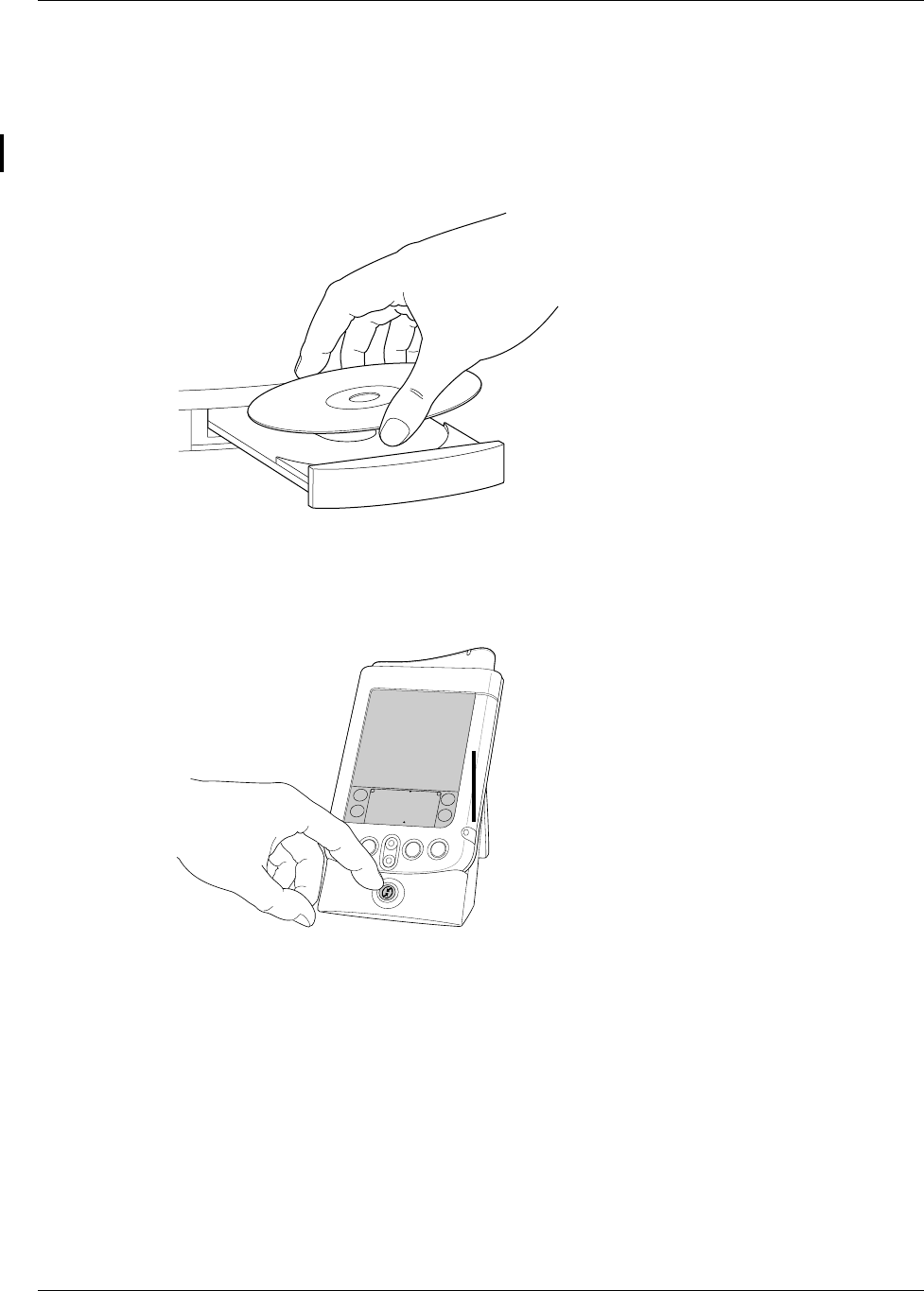
Step 3: Install Software
5
full capacity. Your handheld’s indicator light displays solid green when it is
charging.
Step 3: Install Software
Step 4: Perform HotSync Operations
Palm Desktop software
Palm Desktop software includes the same organizer applications as your
handheld: Date Book, Address Book, To Do List, Note Pad, and Memo Pad.
Changes you make in one place appear in the other after you perform a HotSync
operation.
Insert the CD labeled Palm Desktop software
and follow the onscreen instructions.
Query to Marketing: How will the
CD be labeled?
After Palm Desktop software installs, you are
prompted to install the desktop e-mail
forwarder, a conduit for updating the
MyPalm® application, and to activate your
wireless account. The instructions guide you
through these tasks.
See the next section for details.
As part of the installation process, you will be
prompted to perform HotSync operations.
Just place your handheld on the cradle and press the
HotSync button.
When the HotSync operations complete, remove the
handheld from the cradle by gently rocking it forward
and then lifting it from the cradle.

Setting Up
6
Desktop e-mail director
The desktop e-mail director securely forwards e-mail from your Windows
enterprise mailbox to your handheld. Your handheld notifies you of its arrival by
blinking its red indicator light at paired intervals.
ADDITIONAL DOC/CONFIG INFO TBD
What is the official name of the desktop director, and is it trademarked/registered?
The MyPalm Update conduit
The MyPalm application on your handheld is a portal, like portal sites on the
internet. It allows you to quickly and wirelessly access internet content formatted
for your handheld. If installed, the MyPalm Update conduit will initiate an
Internet connection each time you perform a HotSync operation. If a newer version
of the MyPalm application is found, it replaces the current version on your
handheld.
Wireless account
As the first HotSync operation completes, the installer launches a web browser on
your desktop and opens the Palm i705 Activation URL where you will register
your wireless account, select a service plan, provide billing information, and begin
activation.
New users: Click Sign up and Register.
Palm VII/VIIx users: Logon using your existing palm.net username and password.
You must also check the box beneath the password that identifies you as a Palm
VII/VIIx user.
MyPalm portal members: Logon using your MyPalm portal username and
password.
If you do not have Internet access, call Customer Care to set up your wireless
account. You will need to provide your handheld’s hardware serial number, which
is printed on the back panel of the handheld.
IMPORTANT When you complete registration, you receive a five digit activation key
that you need to activate wireless service on your handheld.
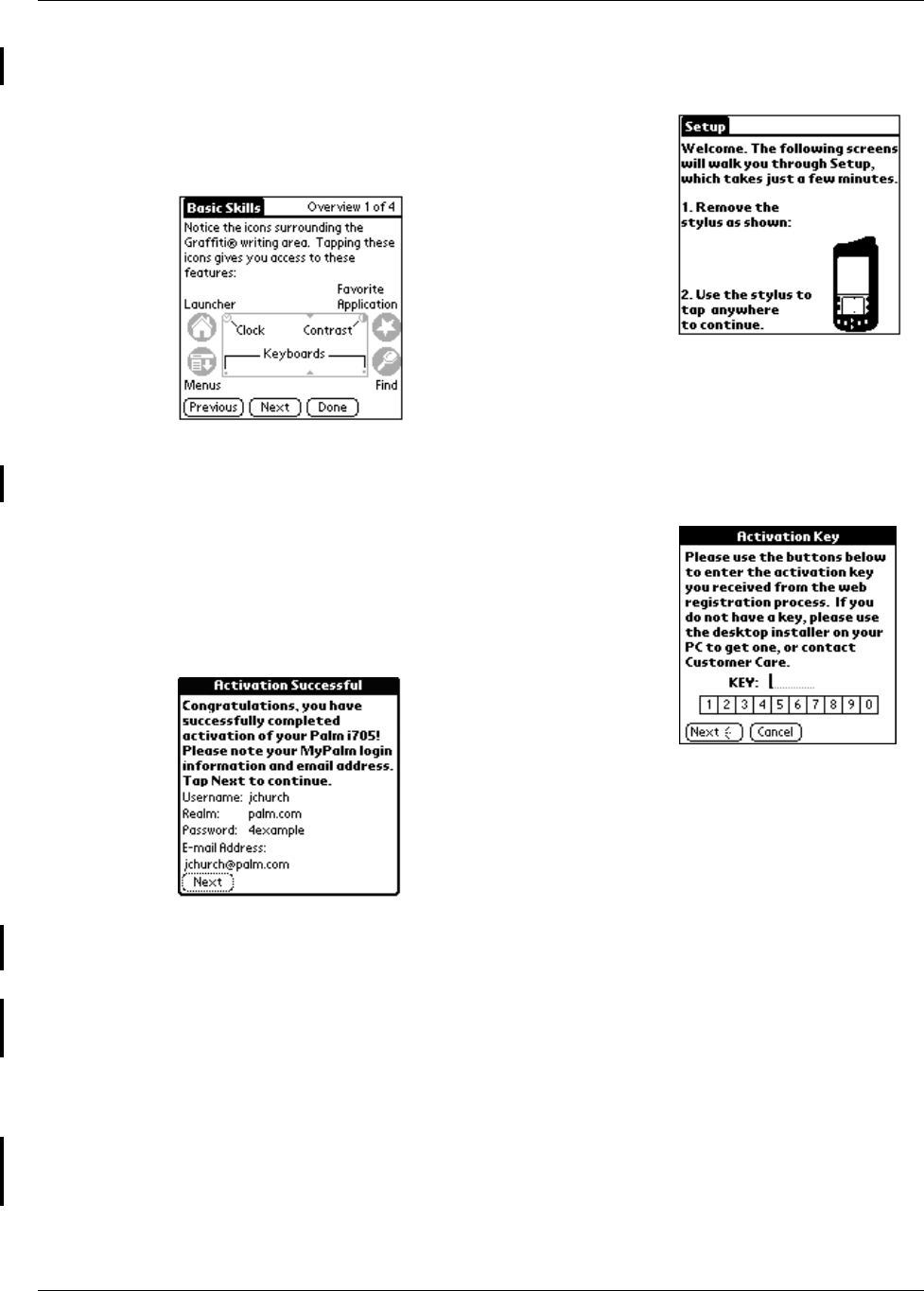
Step 5: Set Up Your Handheld
7
Step 5: Set Up Your Handheld
Step 6: Activate Your handheld
You’ve set up your handheld, installed the Palm Desktop software, registered your
wireless account, and activated wireless features on your handheld. For more
information about using your handheld, continue reading this electronic Handbook
which provides comprehensive documentation for your handheld.
For more information about using Palm Desktop Software, see the following:
■The Windows tutorial for Palm Desktop software, Quick Tour. To access this
tutorial, go to the Help menu in Palm Desktop software and choose Quick Tour.
■The electronic Palm Desktop Software for the Macintosh User’s Guide. To access this
guide, open the Palm folder, and then open the Documentation folder. Double-
click the file Palm Desktop.pdf.
The Setup screen appears when you press the power button.
Just follow the onscreen directions.
When you finish Setup, take a few minutes to review the Basic
Skills and Graffiti® writing tutorials
Tap Activate and follow the onscreen directions.
You’ll need to enter the Activation Key you received when you
registered your wireless account. Activation will also configure
the e-mail application to work with your Palm wireless account.
At the Activation Successful screen, write down your user name
and login information.

Setting Up
8
■The online help for Palm Desktop software. To access the online help, go to the
Help menu in Palm Desktop software.
NOTE If you have upgraded, your new handheld and your old handheld have the
same user name after completing the upgrade process. We strongly recommend that
you perform a hard reset on your old handheld to erase all data from it and assign it
a new user name during the next HotSync operation. See “Performing a hard reset”
in Chapter 5 for details.

9
CHAPTER 2
Exploring Your Handheld
Your Palm™ i705 handheld is wirelessly enabled. It will help you stay in touch
with important e-mail and information, and to stay organized, on time, and up to
date with daily tasks while you are away from your desk. Use your new handheld
to do the following:
■Receive, compose, and send business or personal e-mail wirelessly
■Rely on the indicator light to alert you of incoming e-mail
■Access internet information with the MyPalm® portal application
■Browse or search the internet
■Download and use web clipping applications that help you find information
quickly
■Enter your schedule in Date Book
■Keep all your contact names, addresses, and phone numbers in Address Book
■Prioritize and assign your tasks a due date in To Do List
■Jot quick notes directly on the screen in Note Pad
■Set alarms from Clock, Date Book, and Note Pad, to keep yourself on schedule
and remind yourself of appointments and notes
■Set preferences for how you receive alarms: hearing a sound, seeing a blinking
indicator light, or feeling your handheld vibrate
■Synchronize your data with Palm™ Desktop software on your Windows or
Macintosh computer so you always have a copy
■Insert MultiMediaCard or Secure Digital (SD) cards to add additional software
or memory, or to back up your data
■Beam information to another Palm OS® handheld that is close by and has an IR
(infrared) port
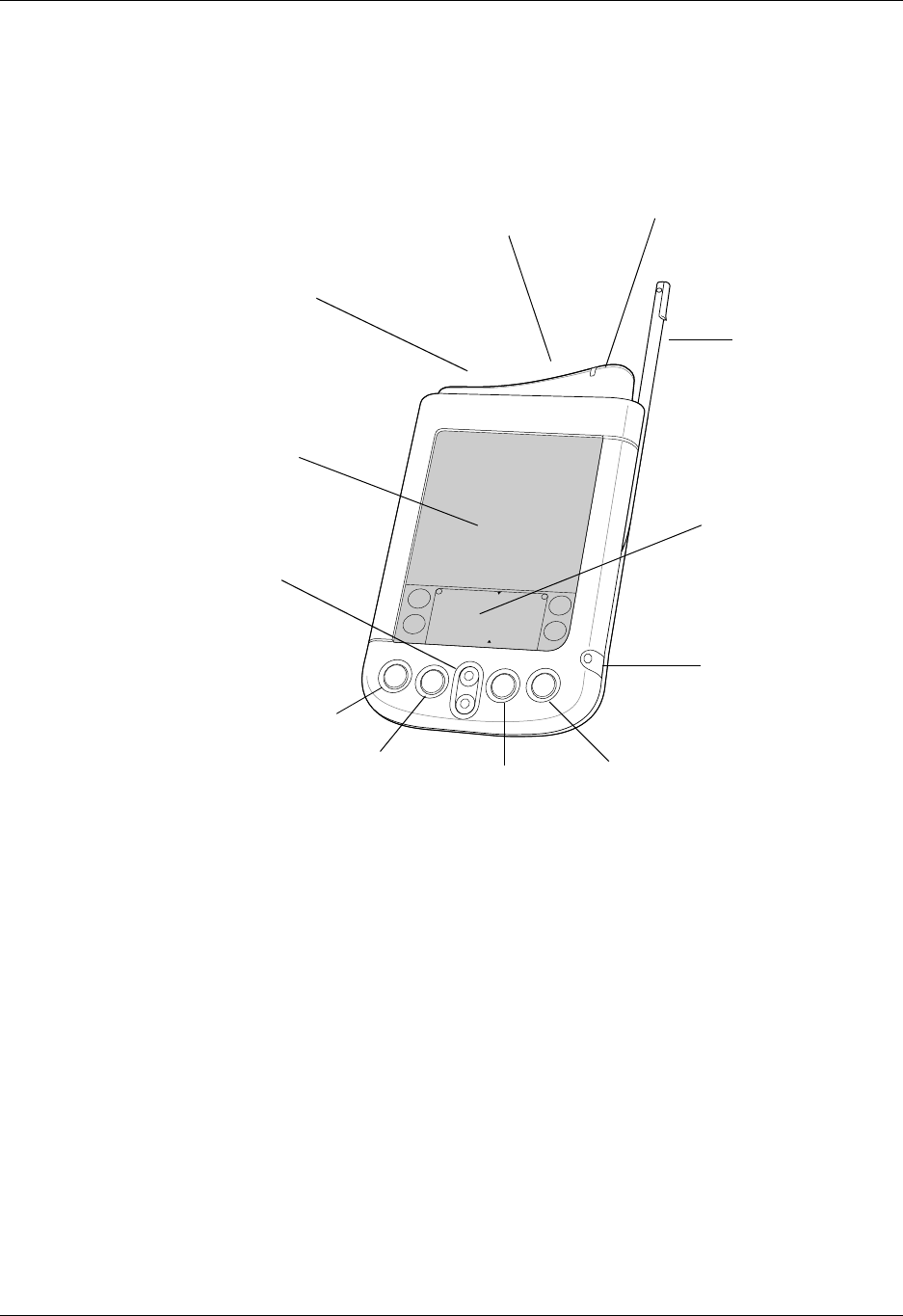
Exploring Your Handheld
10
Palm i705 Components
Locating front panel controls
IR port Uses infrared technology to transmit data to and receive data
from other Palm OS handhelds, and to perform HotSync
operations. See “Beaming Data” in Chapter 3 and see “IR
HotSync Operations” in Chapter 16 or more information.
Red and green
indicator light Indicates when you are within or out of range for wireless
transmission. It also notifies you of incoming e-mail, or Date
Book/Clock/Note Pad alarms.
Stylus Slides in and out of the slot in the side channel of the
handheld. To use the stylus, remove it from the slot and hold
it as you would a pen or pencil. Unscrew the top of the stylus
to access the reset tool.
Graffiti writing area The area where you write letters and numbers using the
Graffiti alphabet. See “Using Graffiti Writing to Enter Data” in
Chapter 3 to learn how to write Graffiti characters.
Screen
Graffiti® writing
area
Application buttons
Scroll
buttons
Power button/
Backlight control
Red and Green Indicator Light
Antenna cap
Stylus
IR port
Date
Book
Address
Book Wireless MultiMail®
Deluxe

Palm i705 Components
11
Using the backlight
If lighting conditions make it difficult for you to see the information on your
handheld, you can use the backlight to illuminate your screen.
To activate the backlight:
■Press the power button and hold it down for about two seconds. Release the
button when the backlight turns on.
TIP In addition, you can assign the full-screen pen stroke to activate the
backlight. See “Pen preferences” in Chapter 17 for details.
To turn off the backlight:
■Press and hold the power button for about two seconds. The backlight also
turns off automatically (after a period of inactivity) with the Auto-off feature.
See “General preferences” in Chapter 17 for more information.
Power button/
Backlight control Turns your handheld on or off and controls the backlight
feature. If your handheld is turned off, pressing the power
button turns the handheld on and returns you to the last
screen you viewed.
If your handheld is turned on, pressing the power button turns
the unit off. Pressing the power button for about two seconds
turns the backlight on or off.
Application buttons Activates the individual handheld applications that
correspond to the icons on the buttons: Date Book, Address
Book, the MyPalm portal application, and MultiMail Deluxe.
See “Buttons preferences” in Chapter 17 for details on
reassigning these buttons to activate any application on your
handheld.
Scroll buttons Displays text and other information that extends beyond the
area of the handheld screen. Pressing the lower scroll button
scrolls down to view information below the viewing area, and
pressing the upper scroll button scrolls up to view the
information above the viewing area.
Handheld screen Displays the applications and information stored in your
handheld. It is touch-sensitive and responds to the stylus.
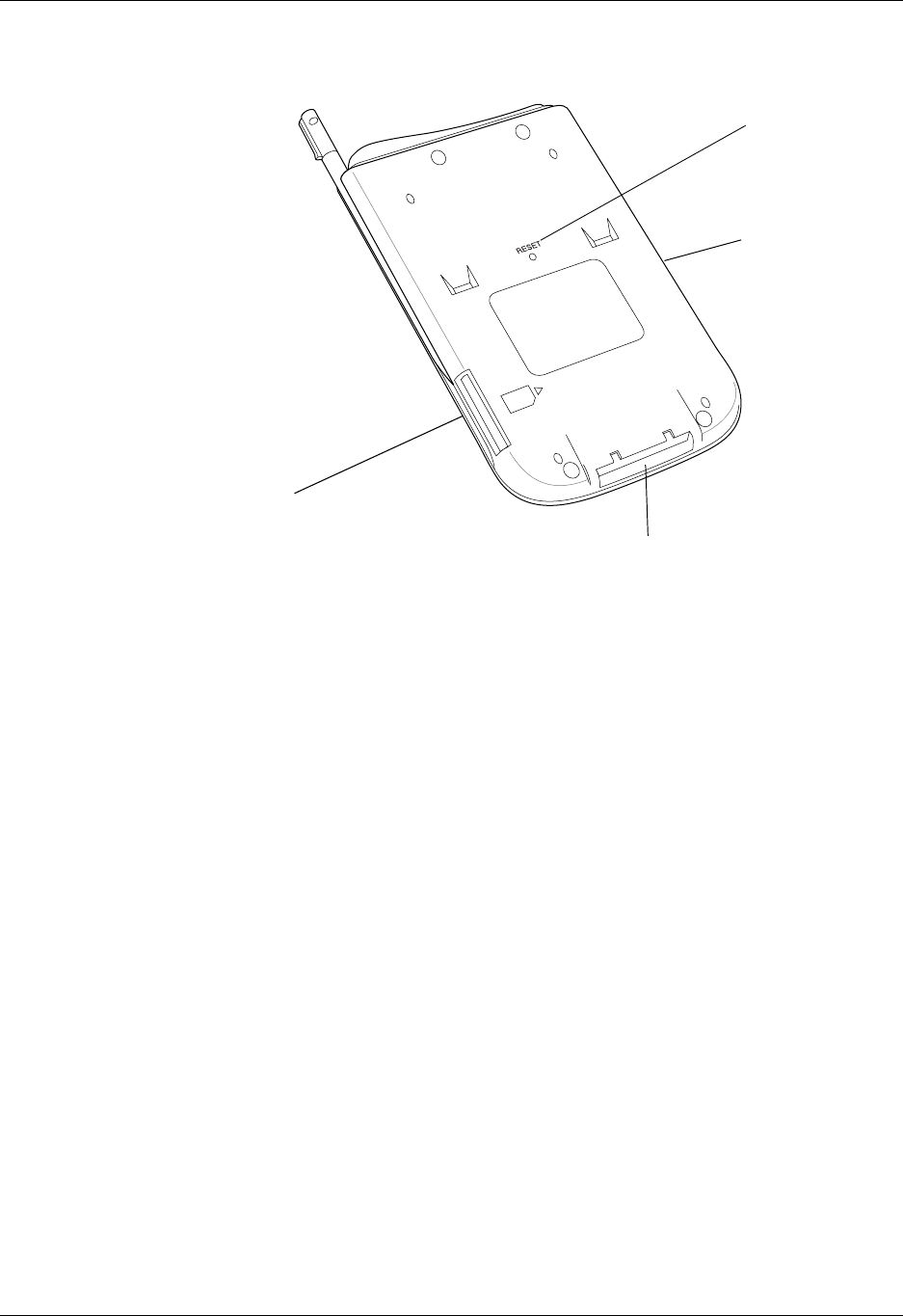
Exploring Your Handheld
12
Locating back panel components
Tapping and Typing
Tap with the stylus to get things done
Like using a mouse to click elements on a computer screen, using the stylus to tap
elements on your handheld screen is the basic action that gets things done on your
handheld.
Reset button Under normal use, you should not have to use the reset
button. See “Resetting Your Handheld” in Appendix A for
information about when and how to use the reset button.
Side channel The left side channel holds the front cover, which slides in and
out.
Universal connector Connects your handheld to the cradle, which in turn connects
to the back of your computer and through the AC adapter to
the wall current. This allows you to recharge your handheld as
well as update the information between your handheld and
computer using HotSync® technology.
The universal connector also connects peripheral hardware
devices to your handheld.
Expansion card slot Accepts Secure Digital (SD) or MultiMediaCard expansion
cards, enabling you to add more memory or applications. You
can also back up data to an expansion card.
Universal
connector
Expansion
card slot
Side
channel for
cover
Reset
button

Tapping and Typing
13
The first time you start your handheld, setup instructions appear on the screen.
These instructions include a calibration screen. Calibration aligns the internal
circuitry of your handheld with its touch-sensitive screen so that when you tap an
element on the screen, the handheld can detect exactly which task you want to
perform.
IMPORTANT Always use the point of the stylus for tapping or making strokes on the
handheld screen. Never use an actual pen, pencil, or other sharp object to write on
the handheld screen.
With your handheld turned on, you can tap the handheld screen to do many
operations, such as the following:
■Open applications
■Choose menu commands
■Initiate a Find operation to search through applications installed on your
handheld for specific text (Find operations do not search through applications
on expansion cards)
■Select options in dialog boxes
■Open the onscreen keyboards
Just as you can drag the mouse to select text or move objects on your computer,
you can also drag the stylus to select text. You can also use the stylus to drag the
slider of any scroll bar.
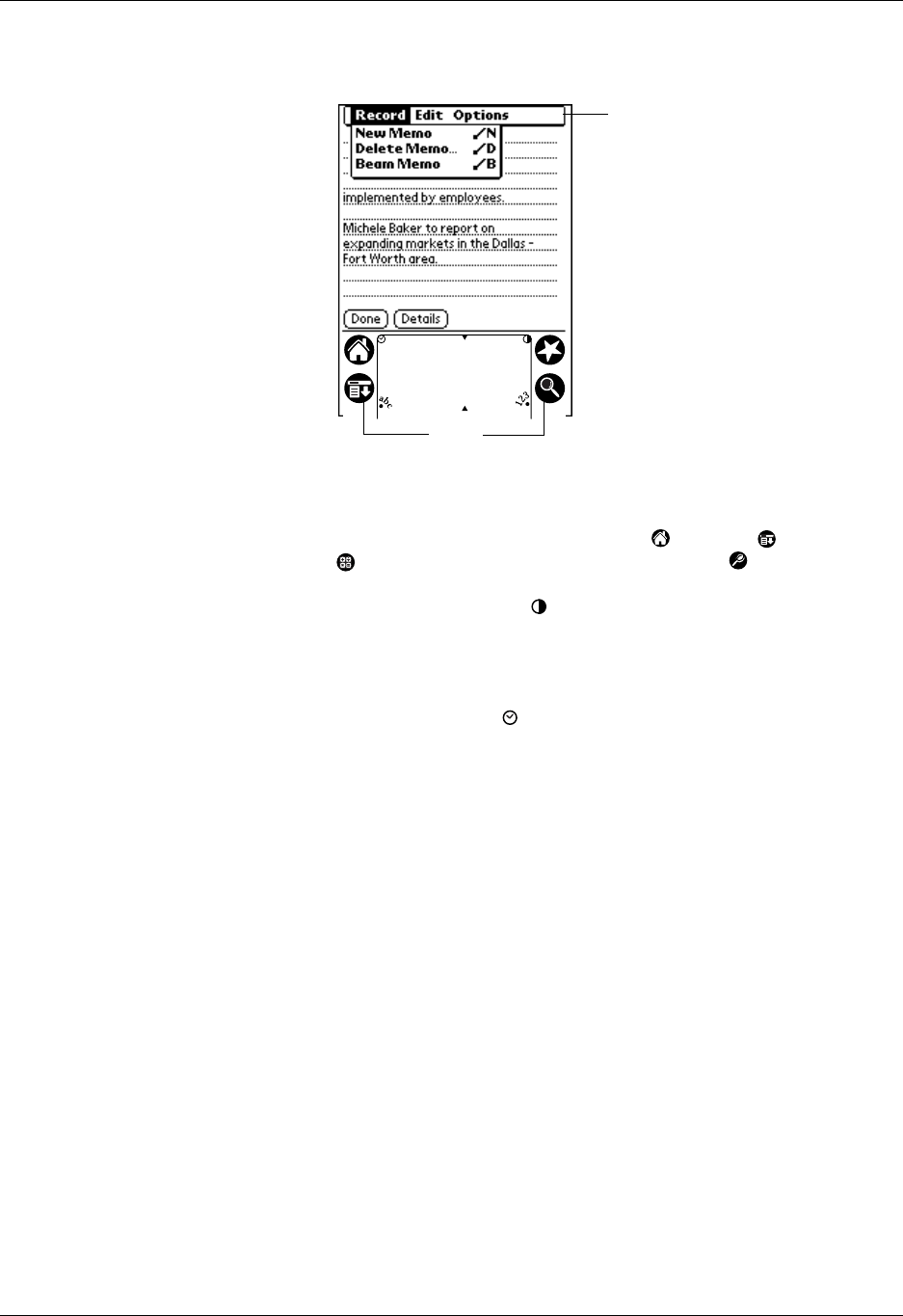
Exploring Your Handheld
14
Elements of the handheld interface
Menu bar A set of commands that are specific to the application. Not all
applications have a menu bar.
Icons Tap the icons to open applications , menus , Calculator
, and to find text anywhere in your data .
Contrast control Tap the Contrast icon to open the Adjust Contrast dialog
box. Tap to the left or right of the slider to adjust the contrast
in small increments or drag the slider to change the contrast in
large increments.
Clock Tap the Clock icon to display the time and date.
abc With the cursor in an input field, tap the dot to activate the
alphabetic keyboard.
123 With the cursor in an input field, tap the dot to activate the
numeric keyboard.
Menu
bar
Icons
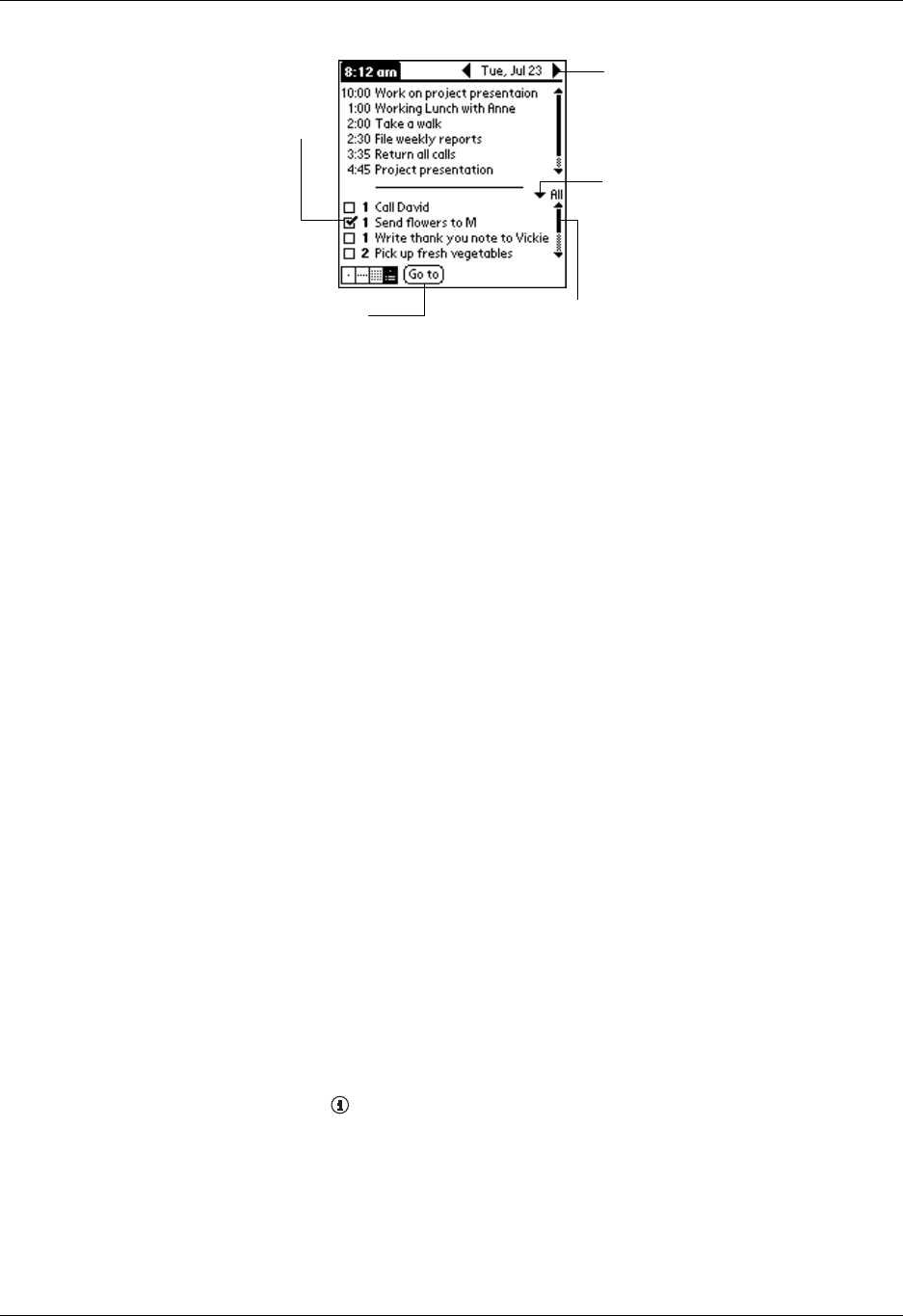
Tapping and Typing
15
Displaying online tips
Many of the dialog boxes that appear on your handheld contain an online Tips icon
in the upper-right corner. Online tips anticipate questions you have in a dialog box,
provide shortcuts for using the dialog box, or give you other useful information.
To display an online tip:
1. Tap the Tips icon .
2. After you review the tip, tap Done.
Check box When a check mark appears in a check box, the corresponding
option is active. If a check box is empty, tapping it inserts a
check mark. If a check box is checked, tapping it removes the
check mark.
Command buttons Tap a button to perform a command. Command buttons
appear in dialog boxes and at the bottom of application
screens.
Next/previous
arrows Tap the left and right arrows to display the previous and next
record; tap the up and down arrows to display the previous
and next page of information.
Pick list Tap the arrow to display a list of choices, and then tap an item
in the list to select it.
Scroll bar Drag the slider, or tap the top or bottom arrow, to scroll the
display one line at a time. To scroll to the previous page, tap
the scroll bar just above the slider. To scroll to the next page,
tap the scroll bar just below the slider.
You can also scroll to the previous and next pages by pressing
the upper and lower scroll buttons on the front panel of your
handheld.
Scroll
bar
Previous/next arrows
Check
box
Command
button
Pick list
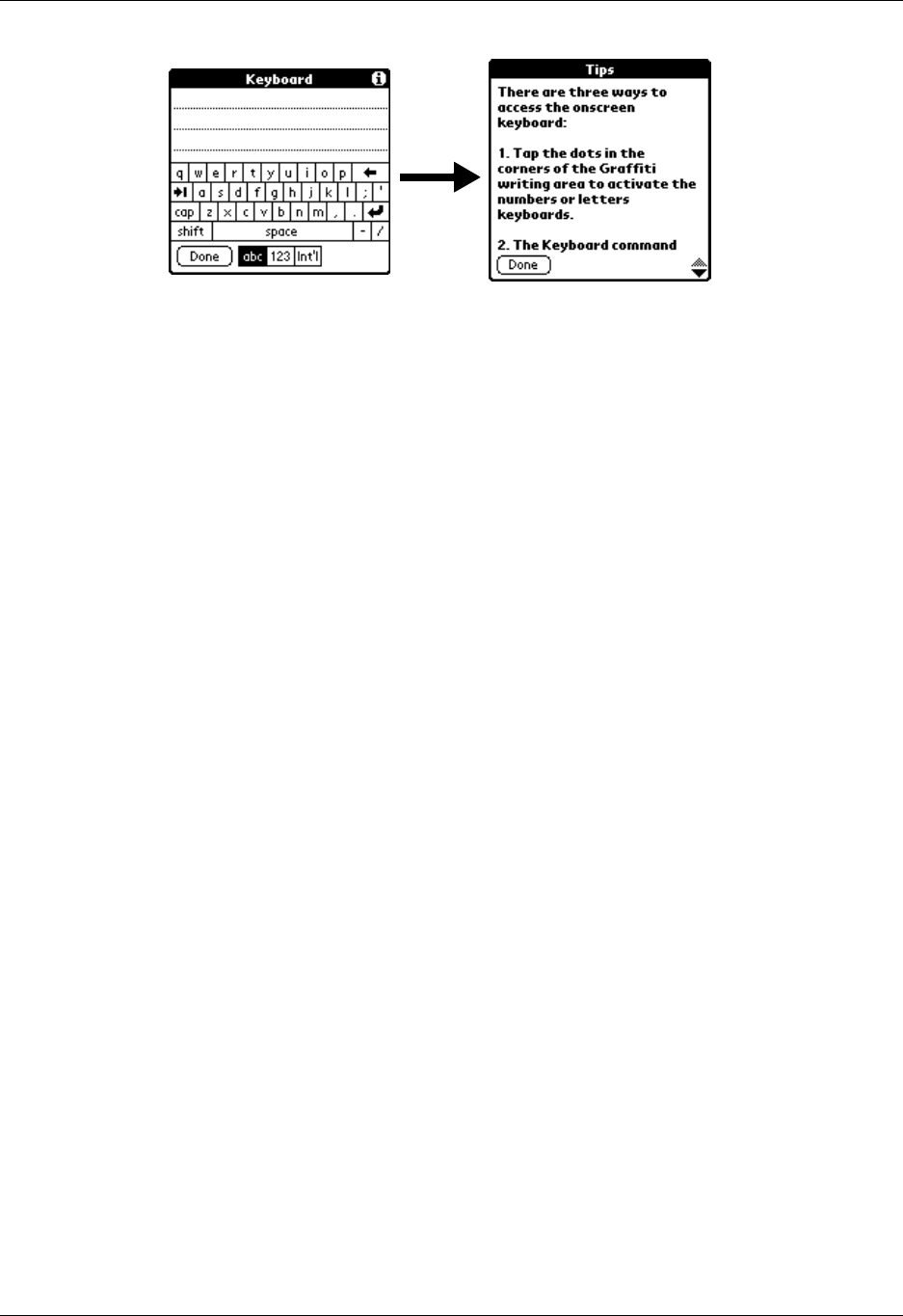
Exploring Your Handheld
16

17
CHAPTER 3
Entering Data in Your Handheld
This chapter explains how to enter data into your handheld. There are several
ways to enter data into your handheld:
■Using the onscreen keyboard
■Using Graffiti® writing
■Beaming data from another Palm OS® handheld that is close by and has an
infrared port.
■Entering or importing data in Palm Desktop software and then synchronizing
with your handheld
■Using Note Pad
■Using a portable keyboard accessory, sold seperately, and attached to the
universal connector
Using the Onscreen Keyboard
You can open the onscreen keyboard anytime you need to enter text or numbers on
your handheld.
To use the onscreen keyboard:
1. Open any application (such as Memo Pad).
2. Tap any record, or tap New.
3. Tap “abc” to open the alphabetic keyboard, or tap “123” to open the numeric
keyboard.
4. Tap the characters to enter text and numbers.
When a keyboard is open, you can tap to open any of the other keyboards,
including the international keyboard.
Tap here for
alphabetic keyboard
Tap here for numeric
keyboard
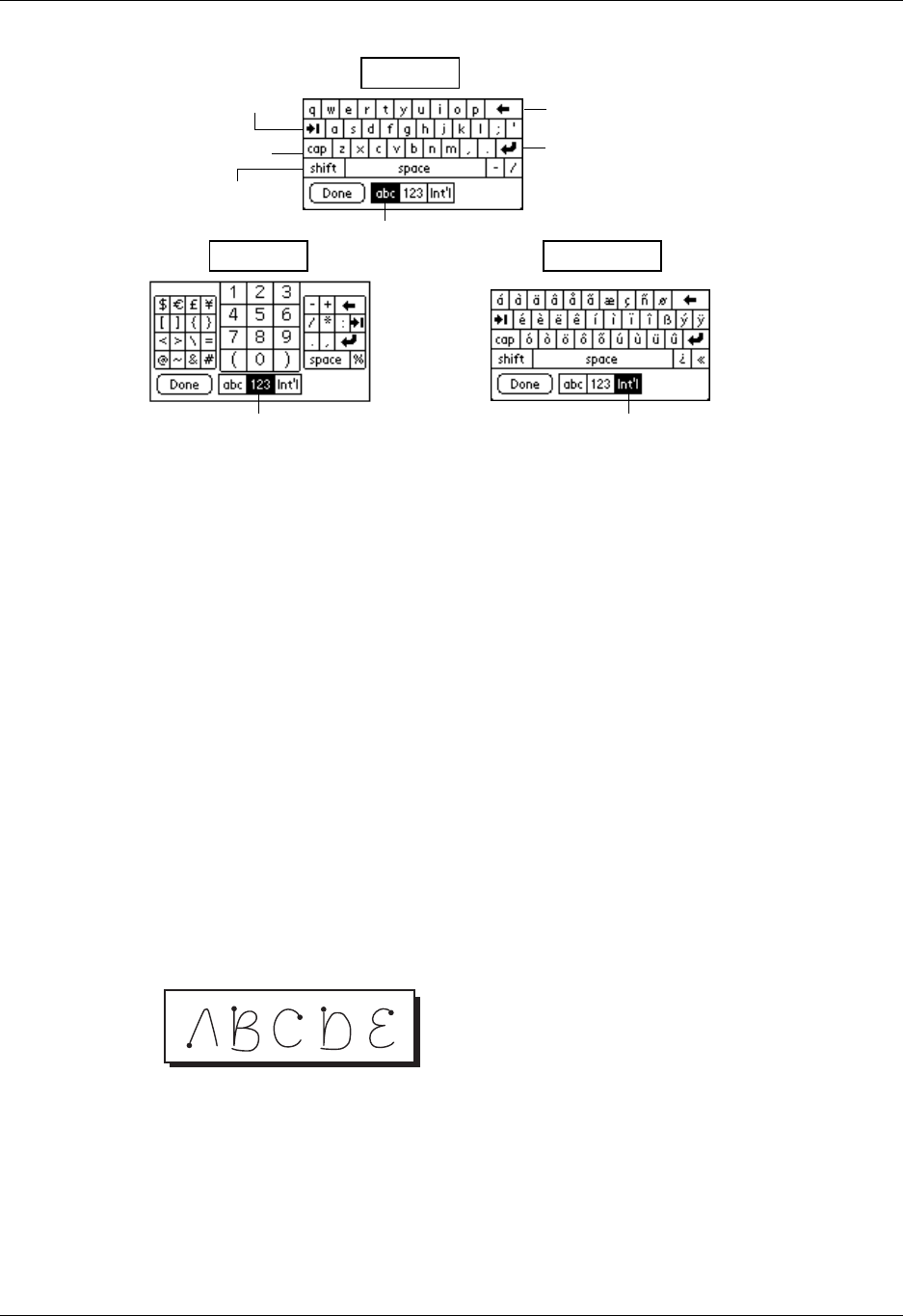
Entering Data in Your Handheld
18
After you finish, tap Done to close the onscreen keyboard and place the text in the
record.
Using Graffiti Writing to Enter Data
In this section, you learn the procedures for creating letters, numbers, punctuation,
and symbols, as well as some Graffiti tips and tricks.
Writing Graffiti characters
Most people find they can enter text quickly and accurately with only minutes of
practice. Graffiti writing includes any character you can type on a standard
keyboard. The Graffiti strokes closely resemble the uppercase letters of the regular
alphabet, which makes Graffiti writing easy to learn.
There are four basic concepts for success with Graffiti writing:
■If you draw the character shape exactly as shown in the tables later in this
chapter (like the shapes shown in the following diagram), you achieve 100%
accuracy.
■The heavy dot on each shape shows where to begin the stroke. Certain
characters have similar shapes, but different beginning and end points. Always
begin the stroke at the heavy dot (you should not create the heavy dot; it is only
there to show you where to begin the stroke).
■Most characters require only a single stroke. When you lift the stylus from the
Graffiti writing area, your handheld recognizes and displays the text character
Backspace
Carriage return
Ta b
Caps lock
Caps shift
Tap here to display
alphabetic keyboard
Tap here to display
numeric keyboard
Tap here to display
international keyboard
Alpha
Numeric International

Using Graffiti Writing to Enter Data
19
immediately. To accomplish single strokes, some Graffiti strokes are portions of
the regular alphabet equivalents.
■The Graffiti writing area is divided into two parts: one for writing the letters of
the alphabet and one for writing numbers. The small marks at the top and
bottom of the Graffiti writing area indicate the two areas.
To write Graffiti letters:
1. Tap the screen where you want your text to go.
You need to tap above the Graffiti writing area, and must see a blinking cursor
before you write the text.
2. Use the tables on the following pages to find the stroke shape for the letter you
want to create. For example, the stroke shown below creates the letter “n.”
There are two different stroke shapes available for some letters. For these letters,
choose the one that’s easiest for you.
As you’ll see later, you use the same shape to create both the uppercase and
lowercase version of a letter.
3. Position the stylus in the left-hand side of the Graffiti writing area.
4. Start your stroke at the heavy dot and draw the stroke shape as it appears in the
tables.
5. Lift the stylus from the screen at the end of the stroke shape.
That’s all there is to it! When you lift the stylus from the screen, your handheld
recognizes your stroke immediately and prints the letter at the insertion point on
the screen.
As soon as you lift the stylus from the screen, you can begin the stroke for the next
character you want to write.
NOTE You must begin the character strokes in the Graffiti writing area. If you do not
make Graffiti strokes in the Graffiti writing area, your handheld does not recognize
them as text characters.
Write letters here Write numbers here
Division marks
Start stroke
at heavy dot
Lift stylus
here
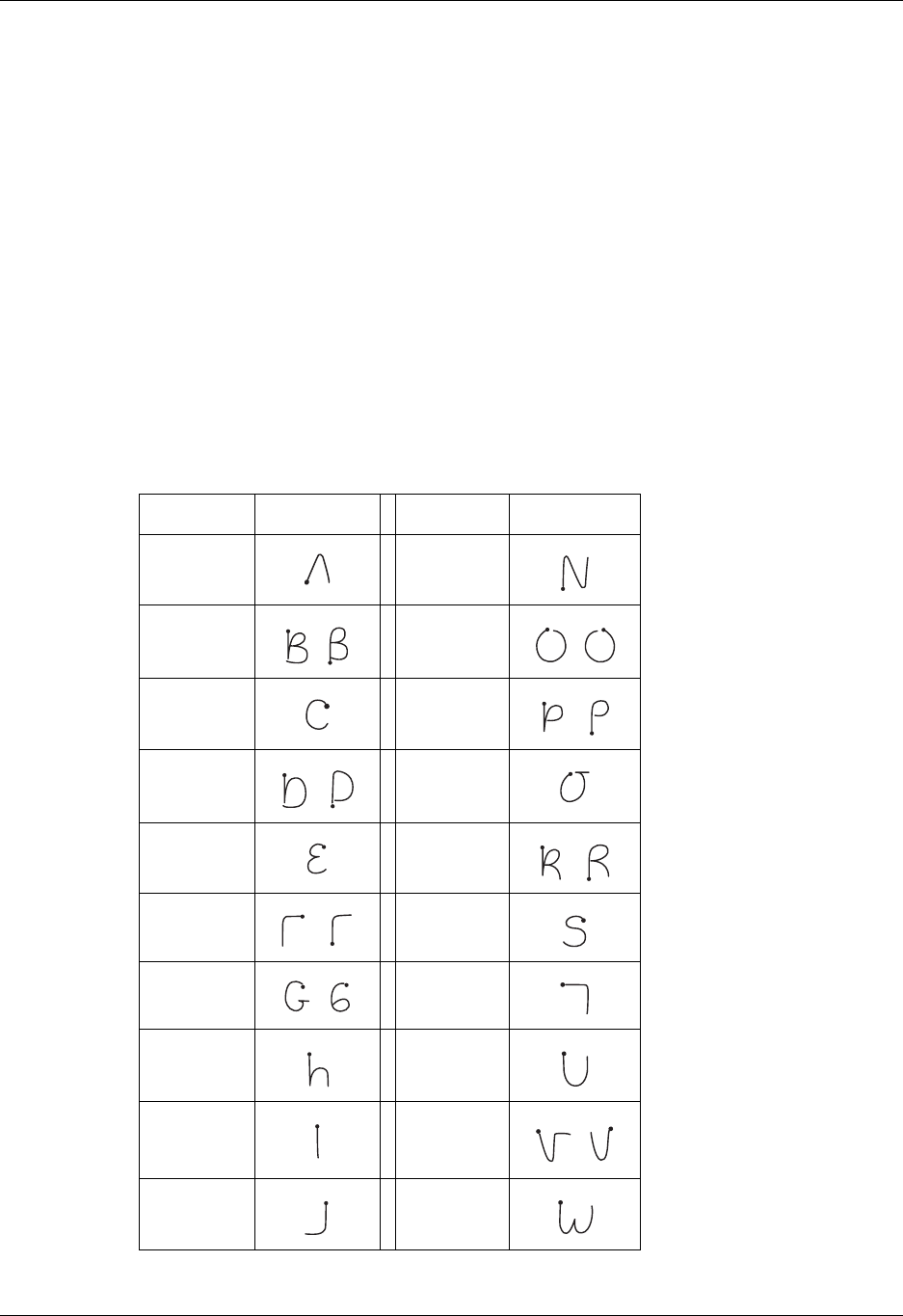
Entering Data in Your Handheld
20
Graffiti tips
When using Graffiti writing, keep these tips in mind:
■Accuracy improves when you write large characters. You should draw strokes
that nearly fill the Graffiti writing area.
■To delete characters, simply set the insertion point to the right of the character
you want to delete and make the backspace stroke
(a line from right to left) in the Graffiti writing area.
■Write at natural speed. Writing too slowly can generate recognition errors.
■Do not write on a slant. Vertical strokes should be parallel to the sides of the
Graffiti writing area.
■Press firmly.
The Graffiti alphabet
Letter Strokes Letter Strokes
AN
B O
CP
D Q
ER
F S
G T
HU
IV
JW
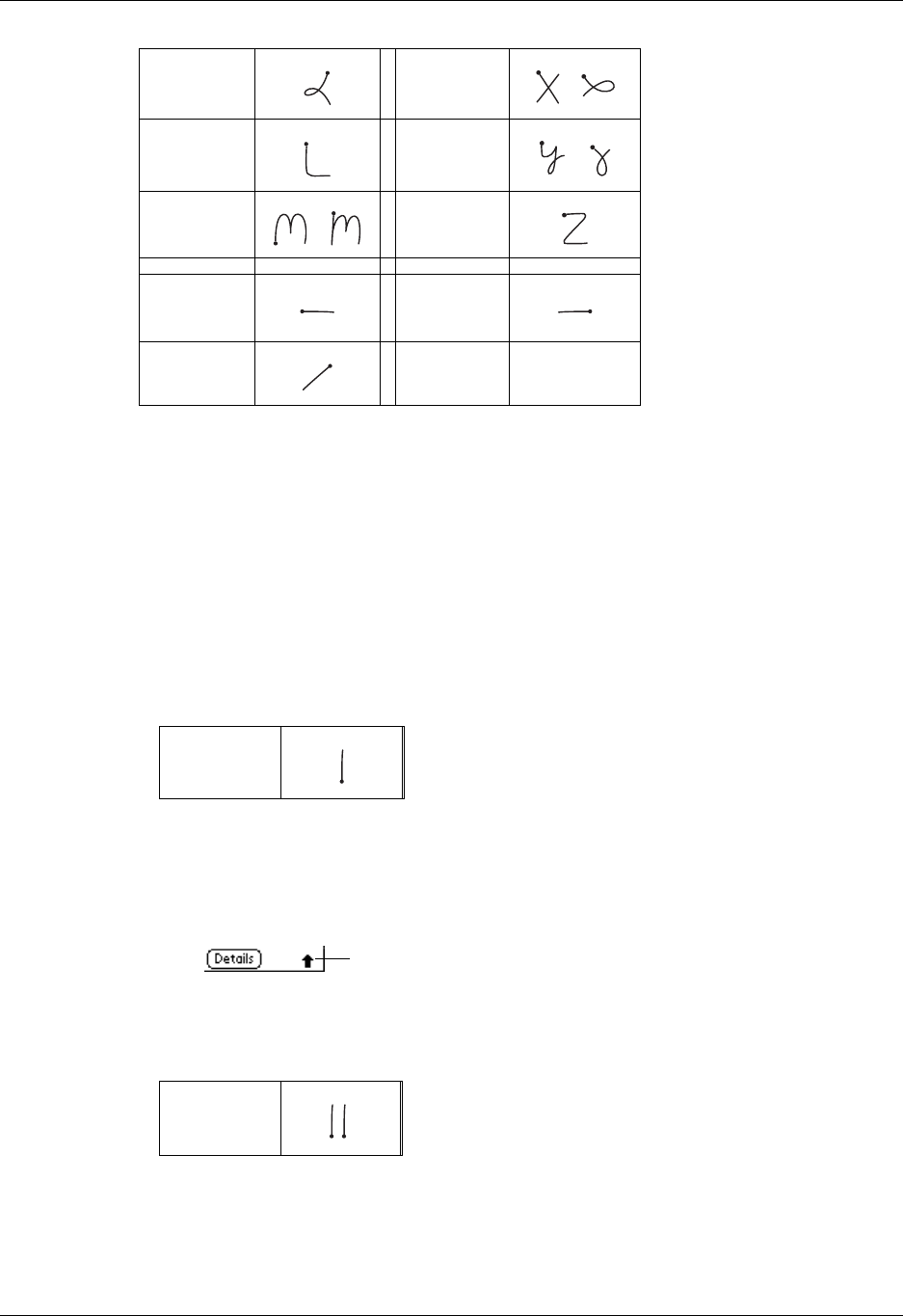
Using Graffiti Writing to Enter Data
21
Writing capital letters
You make capital letters with the same stroke shapes as the basic alphabet
characters. To make capital letters, you must first “shift” to caps — just as you press
the Shift key on a keyboard — and then write the character strokes.
Graffiti writing includes a feature that automatically capitalizes the first letter
when you create a new sentence or a new record (by tapping New or a blank line).
To draw the first letter of a word as a capital letter:
■Use the Caps Shift stroke:
TIP When Caps Shift is active, an “up arrow” symbol appears in the lower-
right corner of the handheld screen. If you accidentally activate Caps Shift,
backspace will cancel it.
To enter only capital letters (Caps Lock):
■Use the Caps Lock stroke:
TIP When Caps Lock is active, an underlined “up arrow” symbol appears in
the lower-right corner of the handheld screen. To return to lowercase, make the
Caps Shift stroke.
KX
LY
M Z
Space Back Space
Carriage
Return
Period tap twice
Caps
Shift
Caps
Lock
Caps Shift
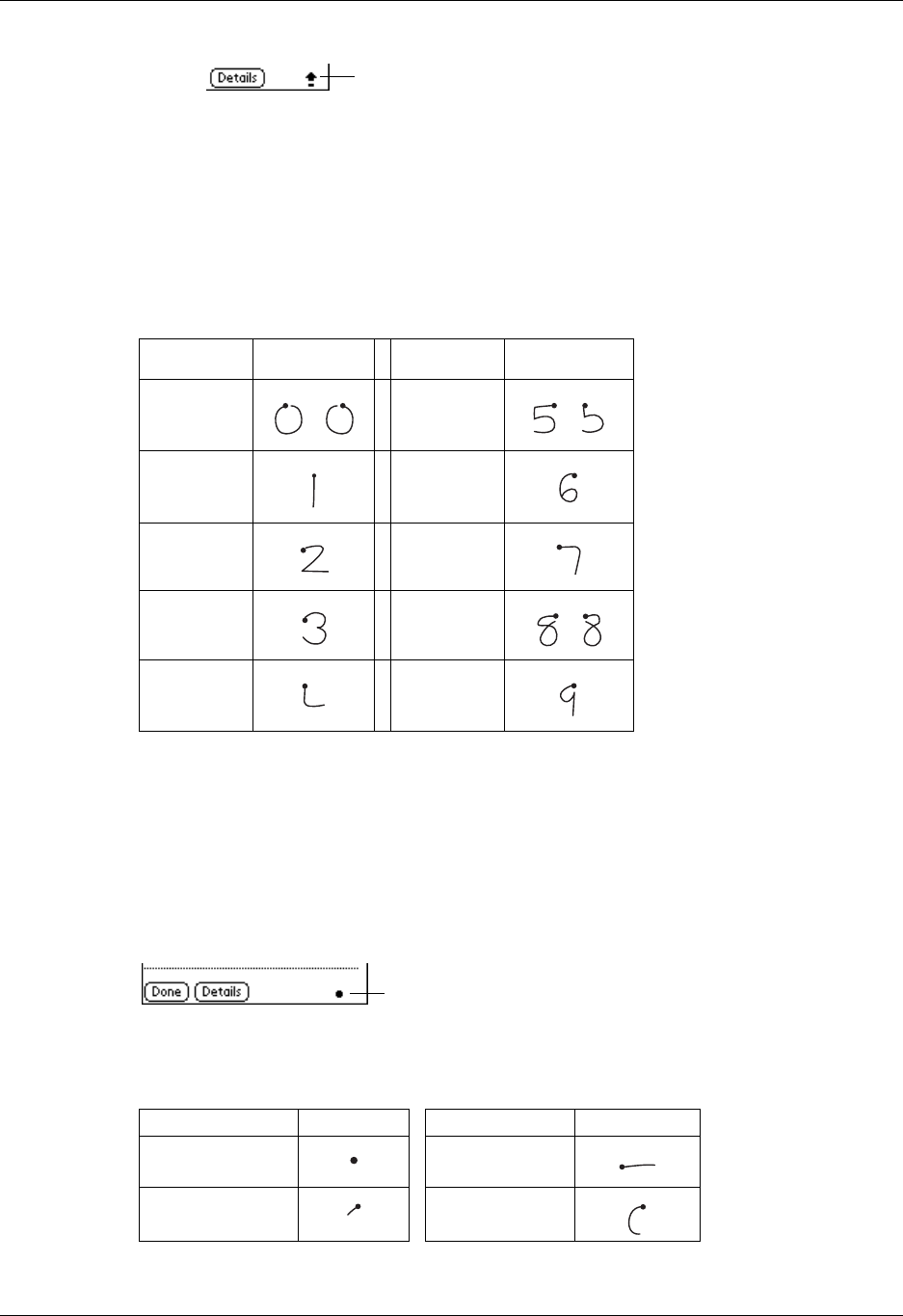
Entering Data in Your Handheld
22
Writing numbers
Writing numbers with Graffiti writing is similar to writing letters of the alphabet,
except that you make the character strokes on the right-hand side (numbers side)
of the Graffiti writing area.
Graffiti numbers
Writing punctuation marks
Graffiti writing can create any punctuation symbol that you can enter from a
standard keyboard. All punctuation marks begin with a single tap on the Graffiti
writing area. When you make this tap, you activate Punctuation Shift and a dot
appears to show it is active. The next stroke you make with the stylus creates a
punctuation mark.
When Punctuation Shift is active, you can make a symbol stroke anywhere in the
Graffiti writing area (the letters or numbers side).
Caps Lock
Number Strokes Number Strokes
0 5
1 6
27
38
4 9
Symbol Stroke Symbol Stroke
Period
.
Dash
—
Comma
,
Left Paren
(
Punctuation shift
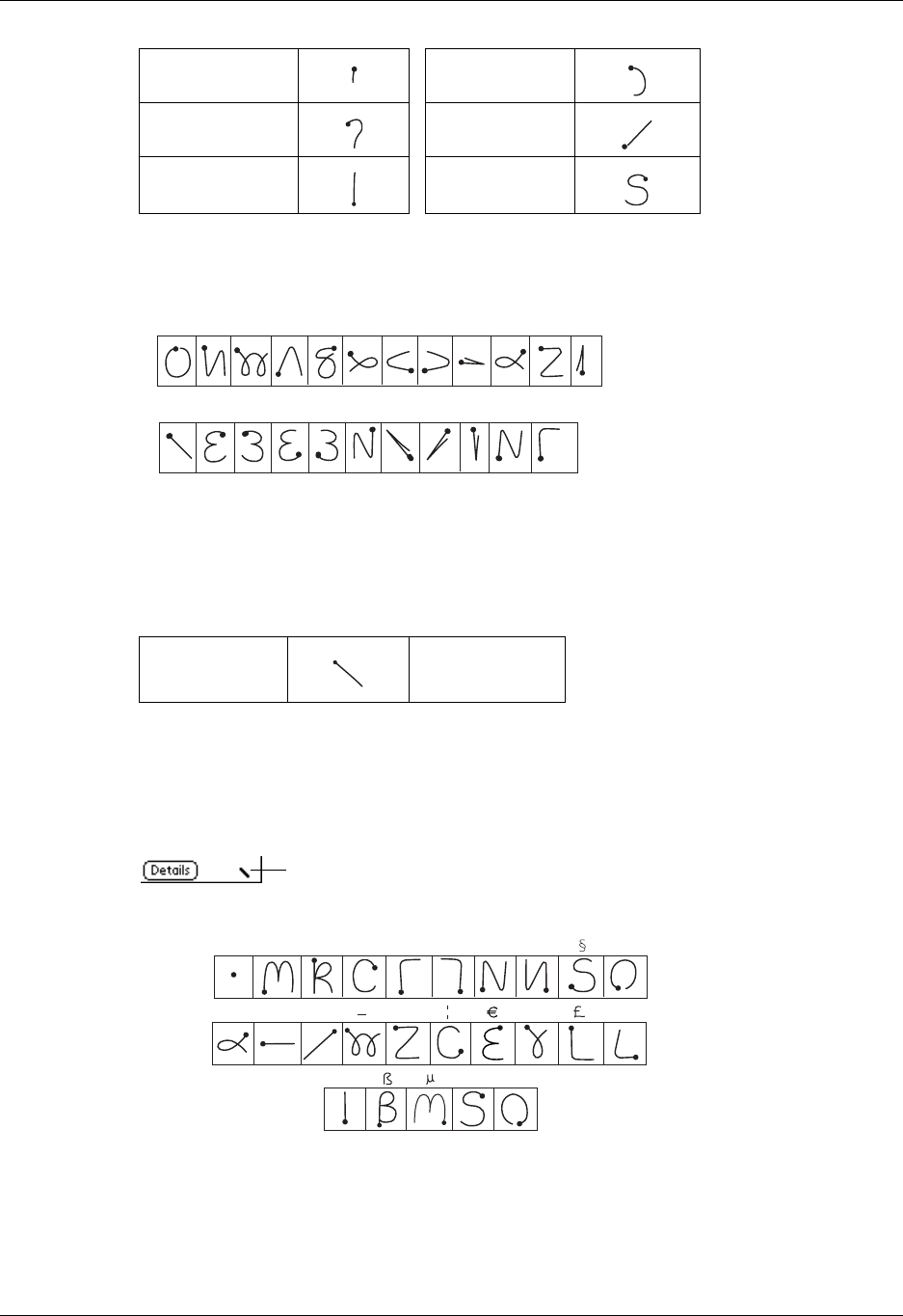
Using Graffiti Writing to Enter Data
23
Additional Graffiti punctuation
Writing symbols and extended characters
All symbols and extended characters begin with the stroke in the Graffiti writing
area of your handheld:
When the Symbol Shift is active, a slanted shift symbol appears in the lower-right
corner of the screen. The next stroke that you make creates the symbol or extended
character.
Writing accented characters
To create accented characters, draw the stroke normally used to create the letter,
followed by an accent stroke. Graffiti writing then adds the accent to the letter.
Apostrophe
'
Right Paren
)
Question
?
Slash
/
Exclamation
!
Dollar
$
@ # % ^ & * < > + = |
—
\ { } [ ] ~ ` ; : " tab
Symbol
Shift
Symbol Shift
•
,
,
,
,
,°
,
+—X:==
cY
?
!
ƒ∅
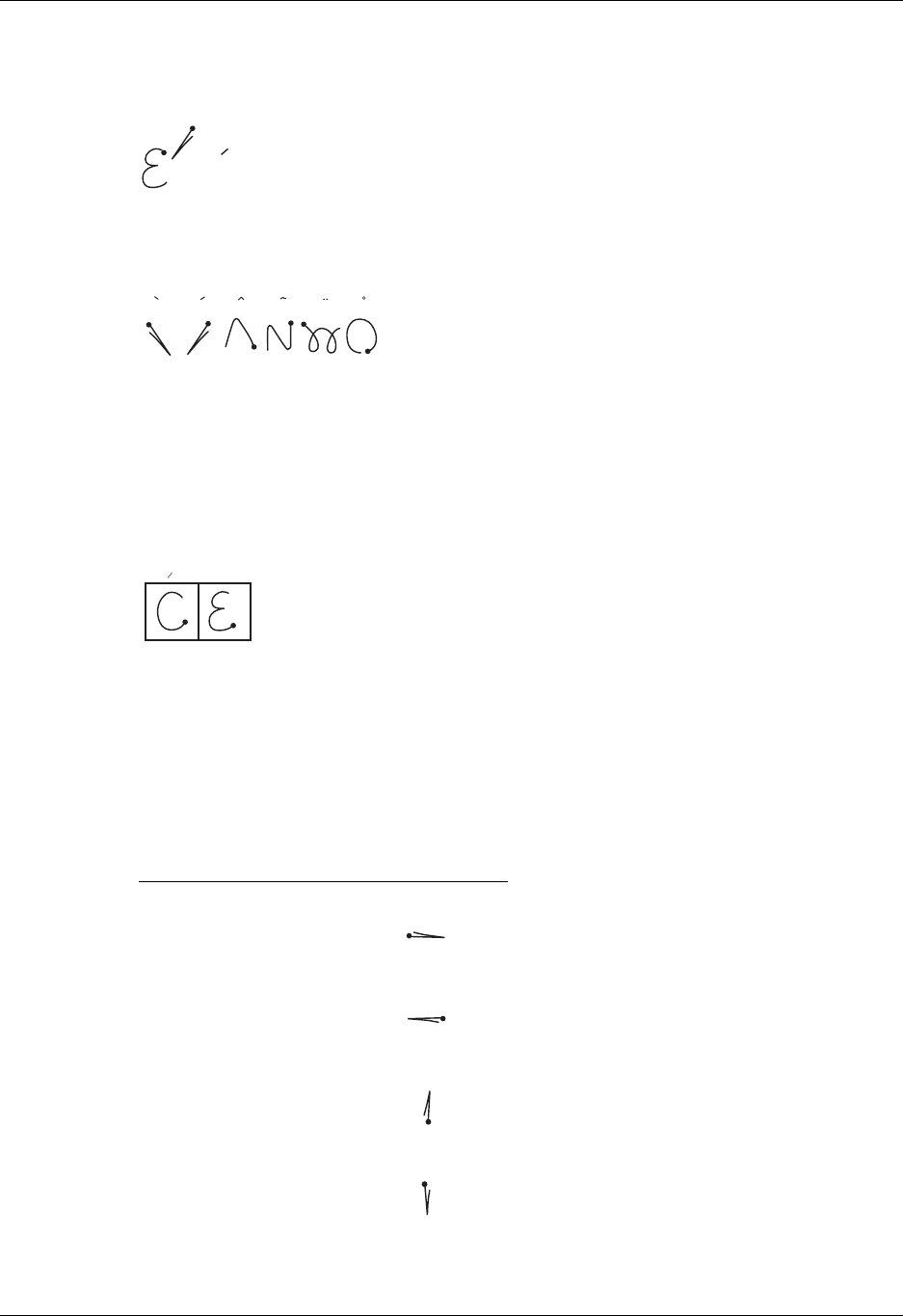
Entering Data in Your Handheld
24
For example, the following diagram shows the strokes required to draw an
accented “e.”
Accent strokes
U
Using these accent strokes, you can write the following accented letters:
à á â ã ä å è é ê ë ì í î ï ò ó ô õ ö ù ú û ü ÿ ý ñ
Additional non-English characters
You can write the following characters without any special punctuation or shifting:
You must write these non-English characters in the left side of the Graffiti writing
area.
Navigation strokes
In addition to character symbols, Graffiti writing includes special strokes that you
can use to navigate within text or fields in your applications.
= e
a a a a a a
cae
Command Stroke
Move cursor right
Move cursor left
Previous field
(Address Book only)
Next Field
(Address Book only)
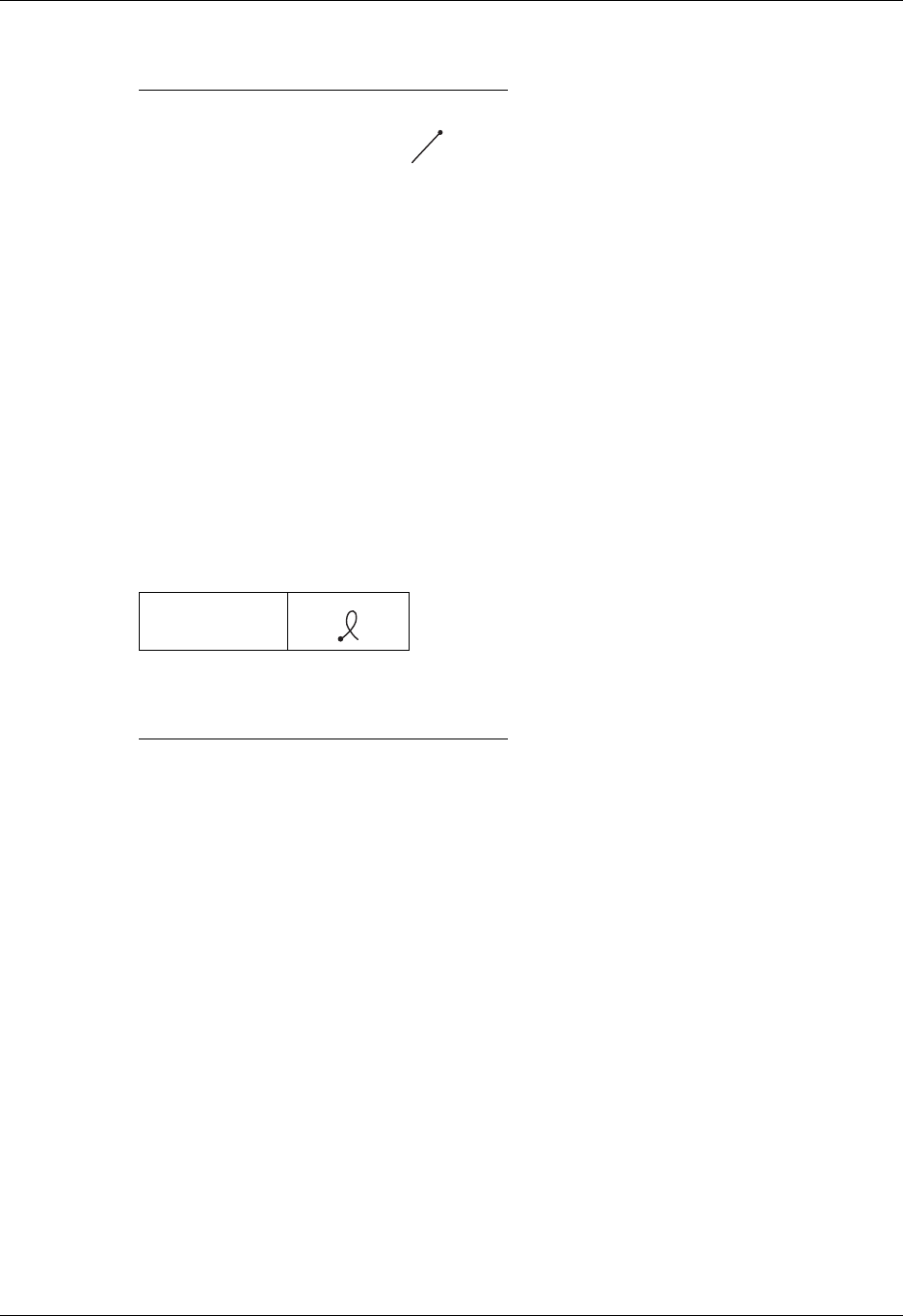
Beaming Data
25
Graffiti ShortCuts
Graffiti ShortCuts make entering commonly used words or phrases quick and
easy. ShortCuts are similar to the Glossary or Autotext features of some word
processors.
Graffiti writing comes with several predefined ShortCuts, and you can also create
your own. Each ShortCut can represent up to 45 characters. For example, you
might create a ShortCut for your name, or for the header of a memo. See
“ShortCuts preferences” in Chapter 17 to learn about creating your own ShortCuts.
To use a ShortCut, draw the ShortCut stroke followed by the ShortCut characters.
When you draw the ShortCut stroke, the ShortCut symbol appears at the insertion
point to show that you are in ShortCut mode.
Your handheld includes the following predefined Graffiti ShortCuts:
Beaming Data
Your handheld is equipped with an IR (infrared) port that you can use to beam
information to another Palm OS handheld that’s close by and also has an IR port.
The IR port is located at the top of the handheld, behind the small dark shield.
You can beam the following information between Palm OS handhelds:
Open Address Record
(Address Book only)
Command Stroke
ShortCut
Entry Shortcut
Date Stamp ds
Time stamp ts
Date / time stamp ds
Meeting me
Breakfast br
Lunch lu
Dinner di

Entering Data in Your Handheld
26
■The record currently displayed in Date Book, Address Book, To Do List, Note
Pad, or Memo Pad
■All records of the category currently displayed in Address Book, To Do List,
Note Pad, or Memo Pad
■A special Address Book record that you designate as your business card,
containing information you want to exchange with business contacts
■An application installed in RAM memory
■An application installed on an expansion card that is seated in the card slot
TIP You can also perform HotSync operations using the IR port. See “IR
HotSync Operations” in Chapter 16 for more details.
To select a business card:
1. Create an Address Book record that contains the information you want on your
business card.
2. Tap the Menu icon .
3. Tap Record, and then tap Select Business Card.
4. Tap Yes.
To beam a record, business card, or category of records:
1. Locate the record, business card, or category you want to beam.
2. Tap the Menu icon .
3. Tap Record, and then tap one of the following:
The Beam command for an individual record
In Address Book only: Beam Business Card
Beam Category
4. When the Beam Status dialog box appears, point the IR port directly at the IR
port of the receiving handheld.
For best results, handhelds should be between 10 centimeters (approximately 4
inches) and 1 meter (approximately 39 inches) apart, and the path between the
two handhelds must be clear of obstacles. Beaming distance to other Palm OS
handhelds may be different.
5. Wait for the Beam Status dialog box to indicate that the transfer is complete
before you continue working on your handheld.
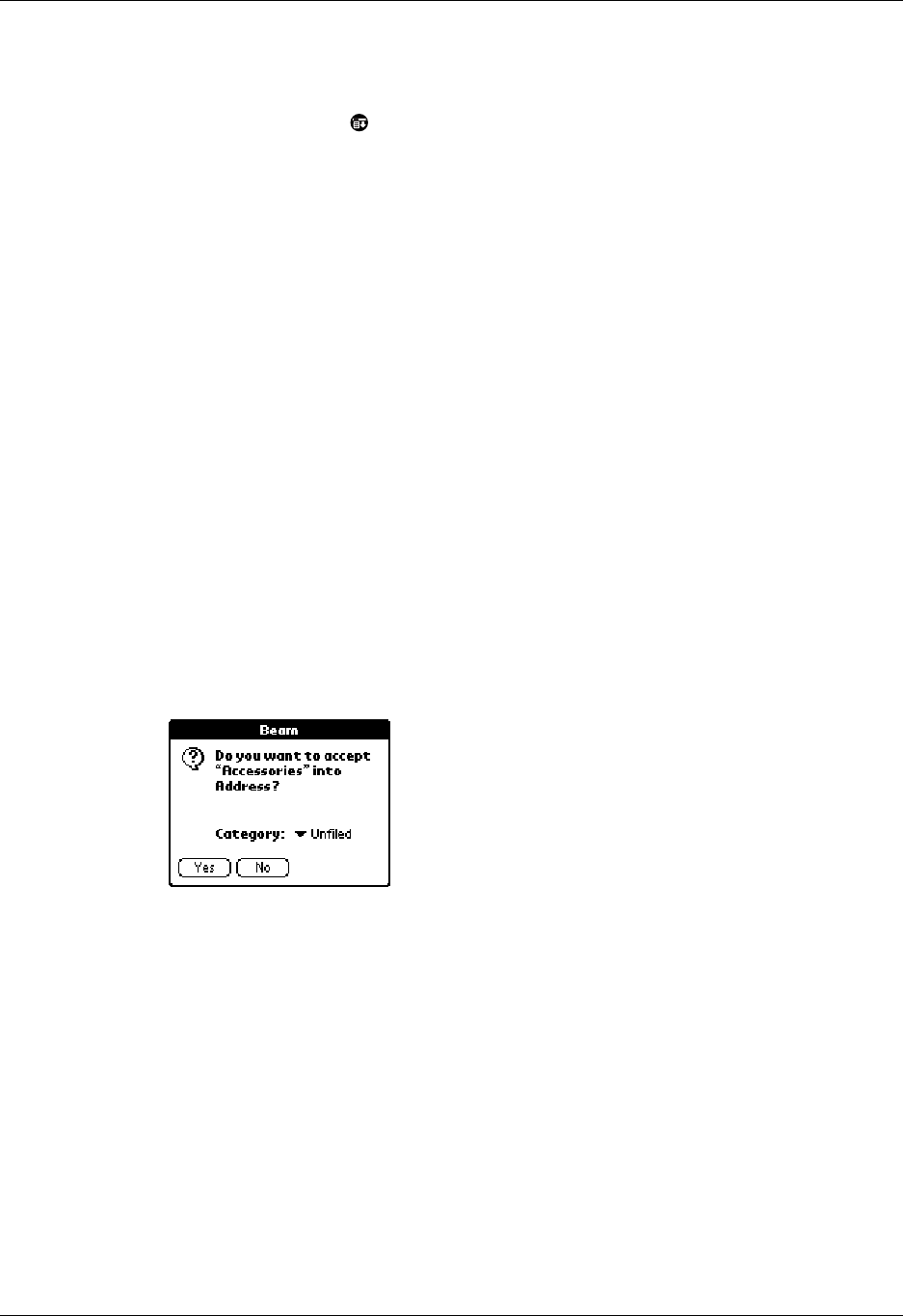
Using your Computer Keyboard
27
To beam an application:
1. Open the Applications Launcher.
2. Tap the Menu icon .
3. Tap App, and then tap Beam.
4. Select either Handheld or Card from the Beam From pick list.
5. Tap the application you want to transfer.
Some applications are copy-protected and cannot be beamed. These are listed
with a lock icon next to them.
6. Tap Beam.
7. When the Beam Status dialog box appears, point the IR port directly at the IR
port of the receiving handheld.
8. Wait for the Beam Status dialog box to indicate that the transfer is complete
before you continue working on your handheld.
To receive beamed information:
1. Turn on your handheld.
2. Point the IR port directly at the IR port of the transmitting handheld to open the
Beam dialog box.
3. Select a category for the incoming information, create a new category, or leave
the information unfiled.
4. Tap Yes.
Tips on beaming information
■You can set the full-screen pen stroke to beam the current entry.
See “Pen preferences” in Chapter 17 for more information.
■You can draw the Graffiti Command stroke to activate the Command toolbar,
and then tap the beam icon.
■You can use the Graffiti Command stroke “/ B” to beam the current entry.
Using your Computer Keyboard
If you have a lot of data to enter, or prefer to use the computer keyboard, you can
use Palm Desktop software or any supported PIM to enter information. You can

Entering Data in Your Handheld
28
then perform a HotSync operation to synchronize the information on your
computer with the information on your handheld. Most of the applications that
came with your handheld are also available in Palm Desktop software and in most
PIMs, so you don’t need to learn different applications. For more information on
entering data on your computer, refer to the online Help in Palm Desktop
software, the Quick Tour in Palm Desktop software (for Windows users), and the
Palm Desktop Software for the Macintosh User’s Guide on the Palm Desktop software
CD-ROM.
Importing Data
If you have data stored in computer applications such as spreadsheets and
databases, or if you want to import data from another handheld, you can transfer
the data to your handheld without having to key it in manually. Save the data in
one of the file formats listed below, import it into Palm Desktop software, and then
perform a HotSync operation to transfer the data to your handheld.
Importing data from a Windows computer
Palm Desktop software can import data in the following file formats:
■Comma delimited (.csv, .txt): Address Book and Memo Pad only
■Tab delimited (.tab, .tsv, .txt): Address Book and Memo Pad only
■CSV (Lotus Organizer 2.x/97 Mapping): Address Book only
■vCal (.vcs): Date Book only
■vCard (.vcf): Address Book only
■Date Book archive (.dba)
■Address Book archive (.aba)
■To Do List archive (.tda)
■Memo Pad archive (.mpa)
Archive formats can only be used with Palm Desktop software. Use the archive file
formats to share information with other people who use a Palm OS® handheld or
to create a copy of your important Palm Desktop information.
To import data from a Windows computer:
1. Open Palm Desktop software.
2. Click the application into which you want to import data.
3. If you are importing records that contain a field with category names, do the
following:
Select All in the Category box.

Importing Data
29
Be sure that the same categories that appear in the imported file also exist in the
application. If the categories do not exist, create them now; otherwise, the
records are imported into the Unfiled category.
4. From the File menu, choose Import.
5. Select the file you want to import.
6. Click Open.
If you are importing a vCal or vCard file, skip to step 10. You do not have to
specify which fields correspond to the imported data.
7. To import data into the correct Palm Desktop fields, drag fields in the left-hand
column so that they are opposite the corresponding imported field on the right.
8. If you do not want to import a field, deselect the check box for that field.
9. Click OK.
The imported data is highlighted in the application.
10. To add the imported data to your handheld, perform a HotSync operation.
See Palm Desktop online Help for more information on importing and exporting
data.
Using File Link
The File Link feature enables you to import Address Book and Memo Pad
information to your handheld from from a separate external file on your Windows
computer, such as a company phone list. You can configure the File Link feature to
check for changes to the external file when you perform a HotSync operation.
HotSync Manager stores the data in a separate category in Palm Desktop software
and on your handheld.
With File Link, you can import data stored in any of the following formats:
■Comma-separated (*.csv)
■Memo Pad archive (*.mpa)
■Address Book archive (*.aba)
■Text (*.txt)
For information on how to set up a file link, see the Palm Desktop online Help.
Importing data from a Macintosh
Palm Desktop software can import data from any of the following applications
when you export the data in the appropriate file format:
■Address Book Plus (text file)
■Claris Organizer (Palm Desktop software can open these files directly)
■ClarisWorks (save under new name as ASCII text file)

Entering Data in Your Handheld
30
■DateBook Pro (text file)
■DayMaker (text file)
■Dynodex (text file)
■FileMaker Pro (tab separated text file)
■Meeting Maker (text file)
■Newton running OS 1.0 with Newton Connection Kit:
Names; Date Book Calendar; and Notepad (text file)
■Now Contact (text file)
■Now Up-to-Date (text file)
■QuickDex (text file)
■TouchBase Pro (text file)
To import data from a Macintosh:
1. Open Palm Desktop software.
2. From the File menu, choose Import.
3. Select the file you want to import.
4. Click Open.
5. If you want to change the order of the fields you’re importing, point to a field,
wait for the cursor to change to a double arrow, and then drag the field to a new
location.
6. If you do not want to import a field, click the arrow between the field names.
7. From the Fields pop-up menu, choose the appropriate field.
8. From the Delimiters pop-up menu, choose the appropriate delimiter.
9. Click OK.
10. To add the imported data to your handheld, perform a HotSync operation.
See Palm Desktop online Help for more information on importing and exporting
data.
Using Note Pad
In addition to using Graffiti characters and the onscreen keyboard, you can enter
data on your handheld using the Note Pad application. When you use Note Pad,
you write quick notes directly on the handheld screen in your own handwriting.
See Chapter 12 for more information and instructions.

Using A Portable Keyboard
31
Using A Portable Keyboard
You can connect a portable keyboard accessory to the universal connector on your
handheld so you can type data directly into your handheld. Portable keyboards are
very helpful when you need to enter large amounts of data quickly and accurately
while you are away from your computer. For additional information about this
optional accessory, go to the web site: http://www.palm.com.

Entering Data in Your Handheld
32

33
CHAPTER 4
Using Wireless Features
Your handheld is wirelessly enabled so that you can use it, like a cellular phone, to
transmit and receive information over the airwaves.
To use the wireless features, you must first register for a wireless account and
activate your handheld. See Getting Started with the Palm™ i705 Handheld for details.
After registration and activatation, you can quickly access Internet information
from the MyPalm™ portal application and additional web clipping applications.
You can also use your wireless account to send and receive e-mail. See Chapter 15
for details.
Whenever you use the wireless features of your handheld, please observe the
guidelines or prohibitions on the use of wireless devices in your current location.
For example, when you are on an airplane, do not turn on your radio at times when
government or airline regulations prohibit the use of cellular phones. You can, of
course, use all other applications of your handheld in accordance with airline
regulations for electronic devices.
Using the Wireless button
The Wireless button has two functions:
■Press the button to open the MyPalm application where you can easily access
the Internet information.
■Press and hold the button for one second to access the Wireless Preferences
screen where you can turn on or off the radio.
Turning on the radio
To send and receive information and receive notifications, the radio needs to be
turned on. Use the Wireless Preferences screen to turn the radio on or off, or to
schedule radio coverage.
You can open the Wireless Preferences screen in multiple ways:
■Press and hold down the Wireless button for one second.
■Tap the Applications icon , tap the Prefs icon , tap the pick list in the upper-
right corner, and then tap Wireless.
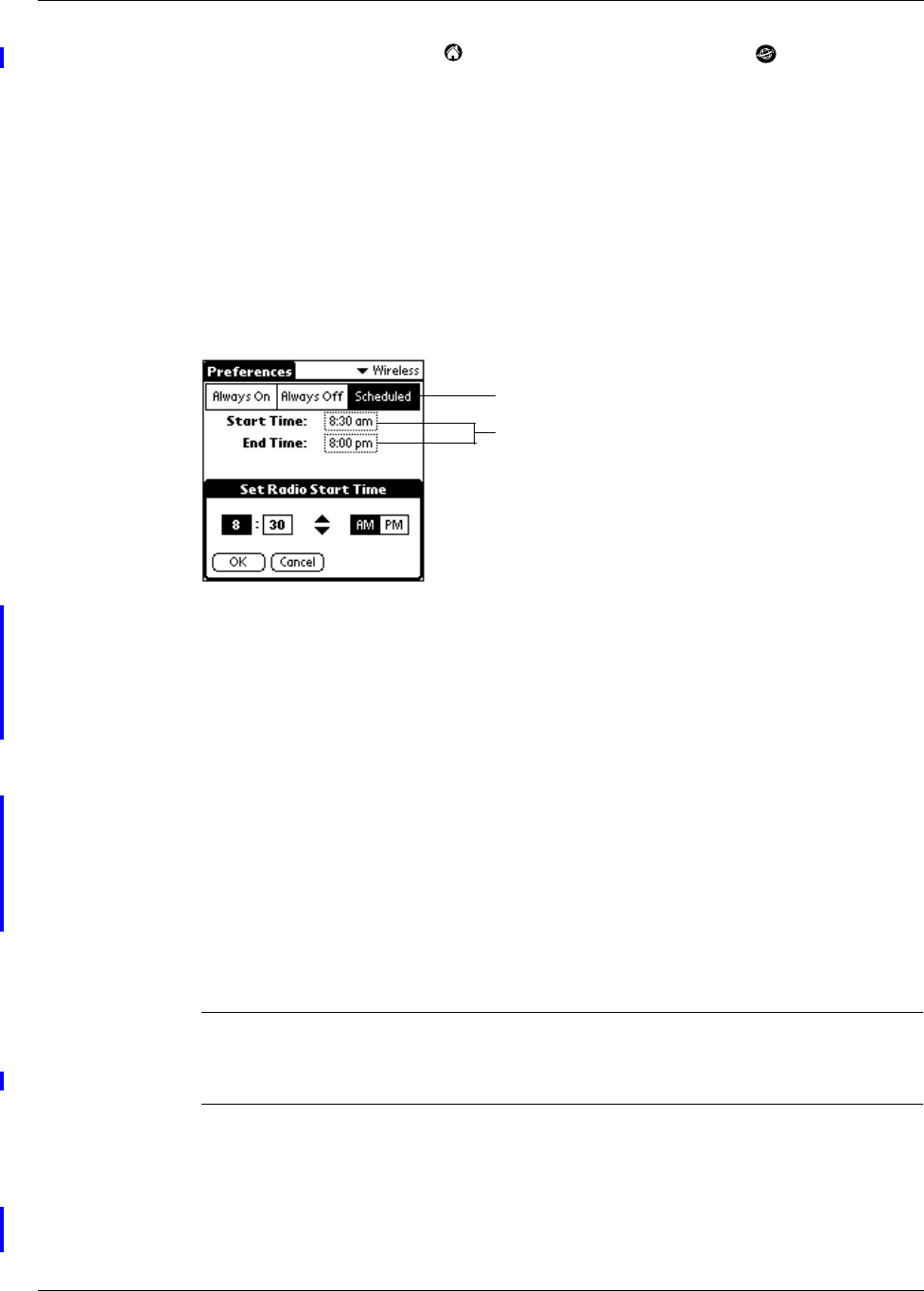
Using Wireless Features
34
■Tap the Applications icon and then tap the MyPalm icon or any web
clipping application. If the radio is off, you are prompted to turn it on.
Tap the Wireless Radio pick list and select one of the following options:
To schedule radio coverage:
1. Tap the Wireless Radio pick list and select Schedule.
2. Tap the Start Time box.
3. Tap the up or down arrows to adjust the hour.
4. Tap the minutes box, and then tap the arrows to adjust the minutes.
5. Tap AM or PM.
6. Tap OK.
7. Tap the End Time box, and then repeat steps 3 through 6.
The radio turns off in multiple ways:
■Turn off the radio from the Wireless Preferences screen by tapping Always Off.
■The radio turns off automatically at a preset time when scheduling is used.
■The radio turns off automatically if the battery is very low.
IMPORTANT Turning off the handheld does not turn off the radio. When the
handheld is turned off, the radio can remain on to receive notification of e-mail.
The indicator light shows radio and notification status.
Monitoring the transmission signal
When the radio is turned on, a signal strength bar graph and text message appear
on the Wireless Preferences screen.
Always Off Radio remains off until you turn it on.
Always On Radio remains on until you turn it off.
Schedule Radio turns on and off at the hours you select.
Tap Scheduled
Tap for Start
and End Time
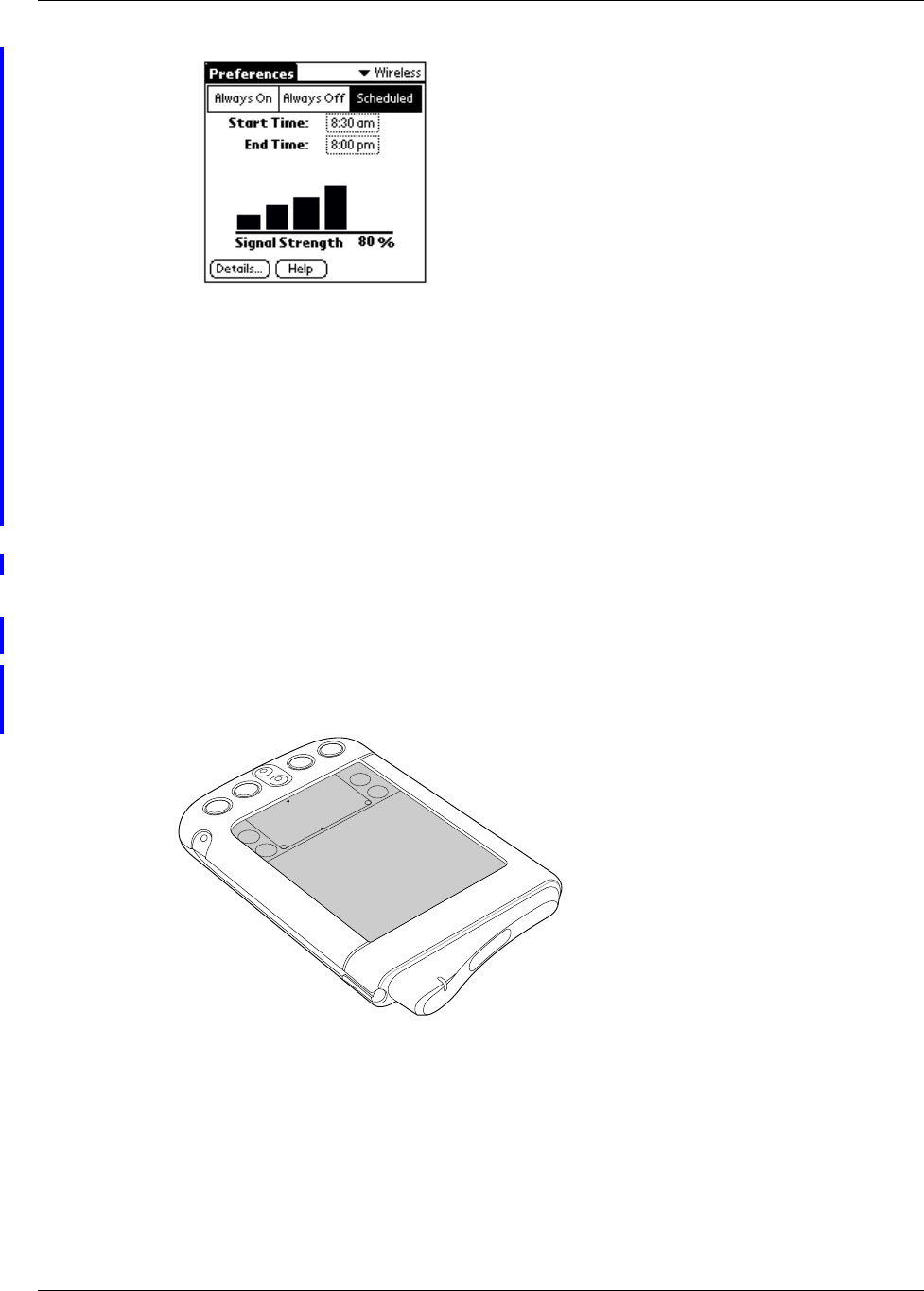
Using the indicator light
35
Both the bar graph and the number represent the signal strength:
■The graph represents signal strength as a series of bars. The more bars
displayed, the stronger the signal.
■The number represents signal strength as a percentage. The higher the number,
the stronger the signal.
If you experience poor reception, often you can improve it simply by moving five
or ten feet in any direction away from the spot where reception is poor. As you
move around to improve reception, you can monitor the increase or decrease in
signal strength.
Using the indicator light
The indicator light at the top of the handheld blinks to indicate the following status
levels:
No light Radio is off.
Green light
flashes every
5 seconds
Radio is on and transmitter is within range.
Red light
flashes every
5 seconds
Radio is on, but transmitter is out of range. You
need to move to another area to bring the
transmitter within range.

Using Wireless Features
36
What is Web Clipping?
Web clipping is a fast and simple way to submit information to, and retrieve
information from, the Internet.
Just as your web browser gives you access to many different web sites, your
handheld gives you access to many different “sites” for web clipping — either
through the MyPalm portal application, or downloaded and installed directly on
your handheld.
These “sites” are called web clipping applications. You access and work with them
just as you would with a handheld application like Address Book.
Web clipping applications give you access to a wide variety of practical Internet
information. Each web clipping application is designed to let you query the
Internet for a specific kind of information.
For example, there are web clipping applications that give you access to traffic and
weather conditions; airline, hotel, and restaurant information; locations of
automatic teller machines; driving directions; stock market data; movie listings;
availability of tickets to local events; business and general news; definitions,
spelling, and synonyms of words; and business and residential phone numbers,
addresses, and e-mail addresses.
Web Clipping, not web browsing
It can be impractical to browse the Internet from a small handheld computer and
look at elaborate, animated, graphics-laden web pages on a small screen. As a way
to access Internet information, web clipping offers you the following advantages:
■Convenience: You can be sitting on a park bench or in the back of a taxi while
accessing information from the Internet.
■Focus: Web clipping applications focus on retrieving specific, up-to-date
information for the quickest, most efficient experience.
So when you’re near a desktop computer and have some time, you can take
advantage of the elaborate graphics, variety, and many choices offered by a web
site.
Red light
flashes at
paired
intervals
A notification that:
E-mail or other content has been received
Date Book/Note Pad/Clock event alarm occurred
A dialog box appears describing the reason for
notification. Acknowledging the notification
turns off the indicator light.
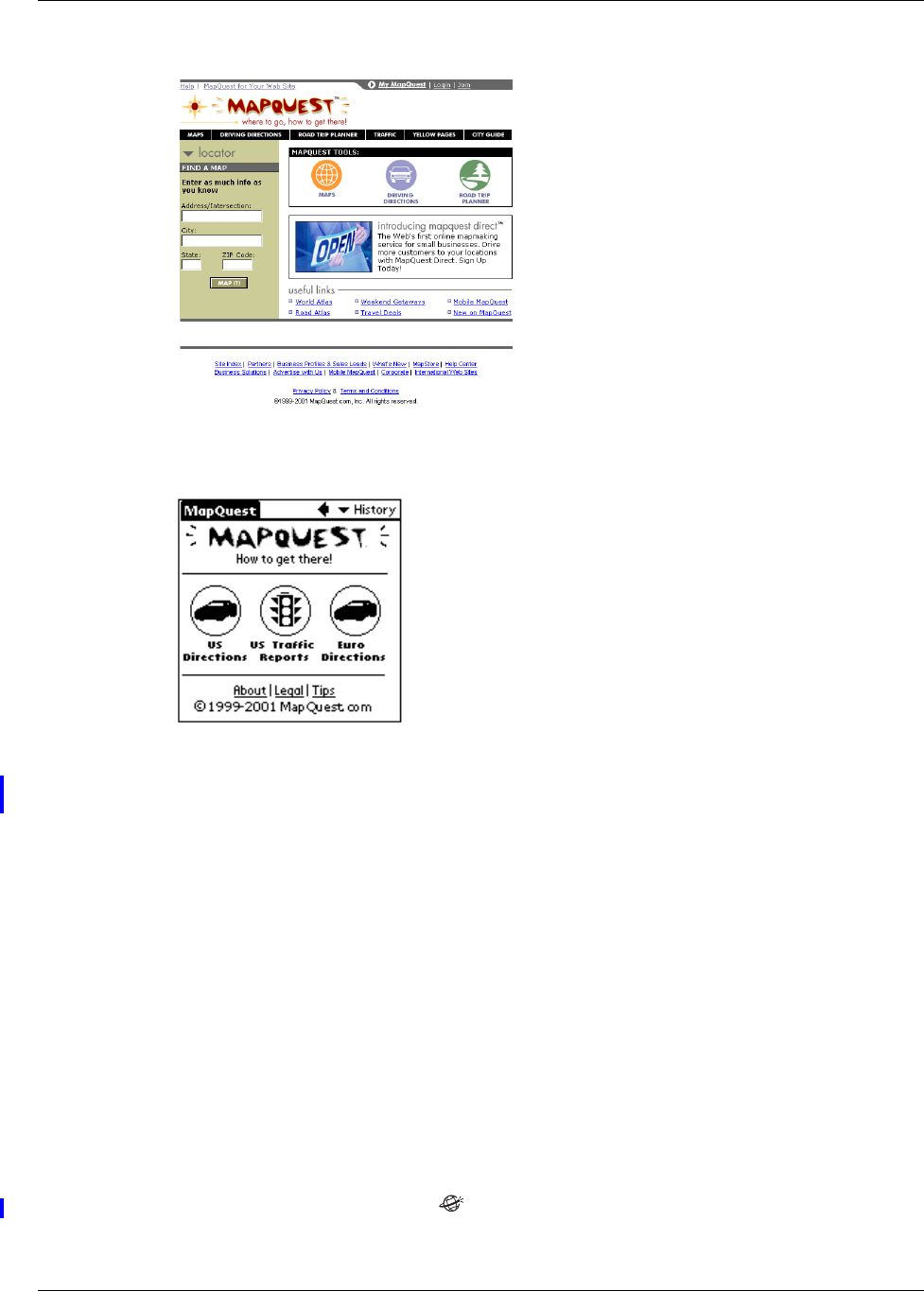
Using the MyPalm application
37
But when you’re in a taxi or a hotel lobby and need information fast, a web clipping
application makes it easy to find the specific information you need.
Using the MyPalm application
The MyPalm application is a portal. Like portals on the Internet that aggregate
other web sites into content channels, the MyPalm application aggregates web
clipping applications into content channels. Web clipping applications allow you
to access a wide array of Internet information, and view that information in a
format that is easy to read on your handheld screen and reduces the cost of
transmission.
This application is also dynamic. If you installed the MyPalm Update conduit
when you installed Palm™ Desktop software, you automatically receive newer
versions of the application when you perform a HotSync operation with an active
Internet connection. Because of this, the application you see on your handheld may
differ slightly from the images of it shown in this chapter.
To access the MyPalm application:
Do one of the following:
■Press the Wireless button on your handheld.
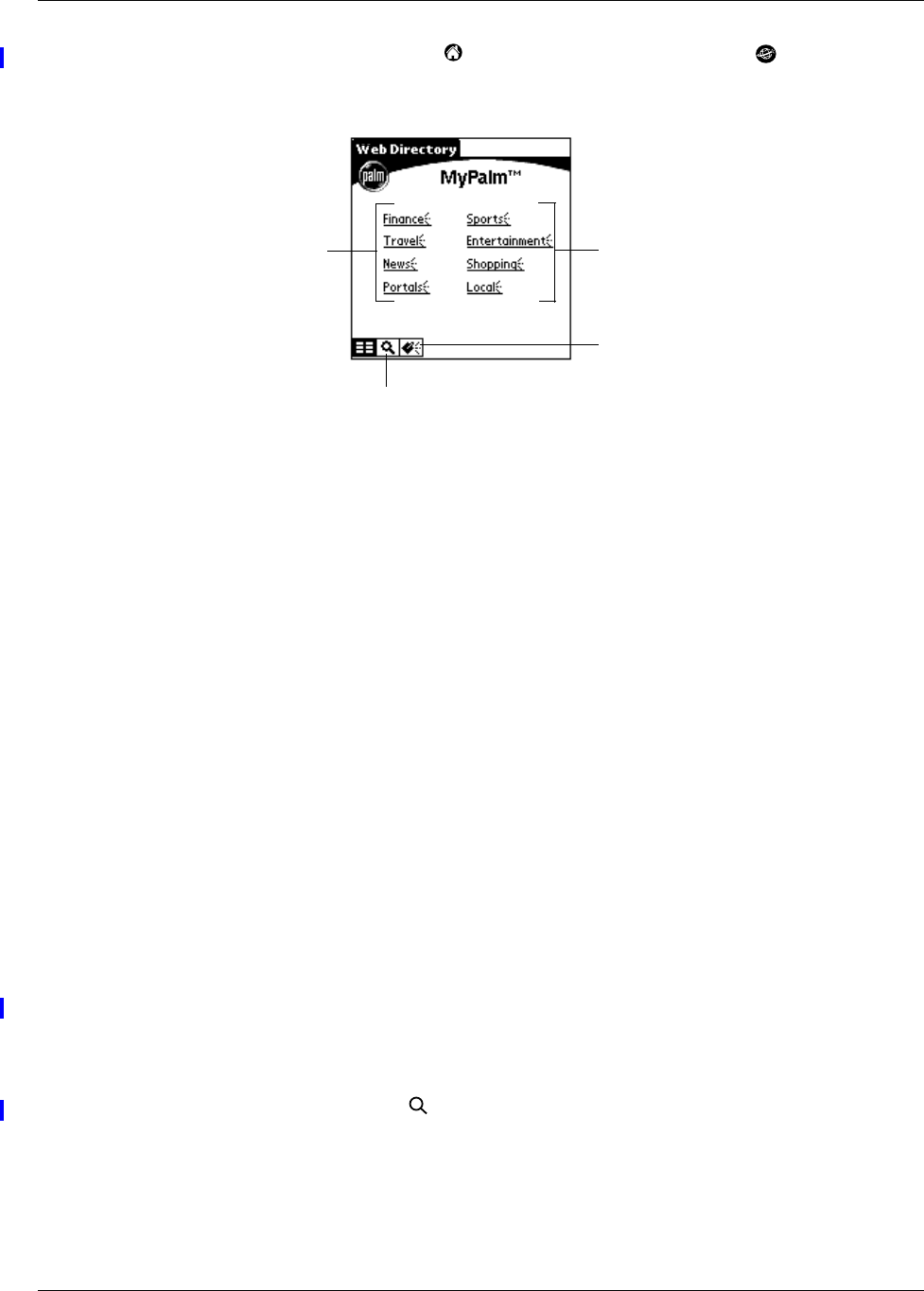
Using Wireless Features
38
■Tap the Applications icon and then tap the MyPalm icon .
If the radio is not on, the Radio dialog box appears. Turn on the radio.
Using Portal web clipping applications
The content channels of the MyPalm portal application host web clipping
applications, grouped together by categories. These channels provide a convenient
way to access information quickly, even without downloading and installing web
clipping applications on your handheld.
To access Internet content by channel:
1. Tap a content channel, such as Finance.
2. Tap an icon to view the content.
If you want to access more web clipping applications, tap More or More Content
at the bottom of the screen.
Browsing or searching the Internet
Browsing or searching Internet sites directly using a URL is available from the
MyPalm application. Keep in mind, however, that downloading information
directly from an Internet site has certain limitations: downloading is slow, the
presentation is not optimized for display on the handheld, and the amount of data
transferred is higher, and therefore, more costly. We recommend that you access a
web site using web clipping applications that are modified for use with your
handheld. See “What is Web Clipping?” earlier in this chapter for more
information.
To browse or search the Internet:
1. Tap the search button .
2. Enter an URL to browse, or a search term, and then tap Go.
Tap to view
Internet content
by channel
Tap to search the Internet
Tap to download
web clipping
applications
Tap to view
Internet content
by channel
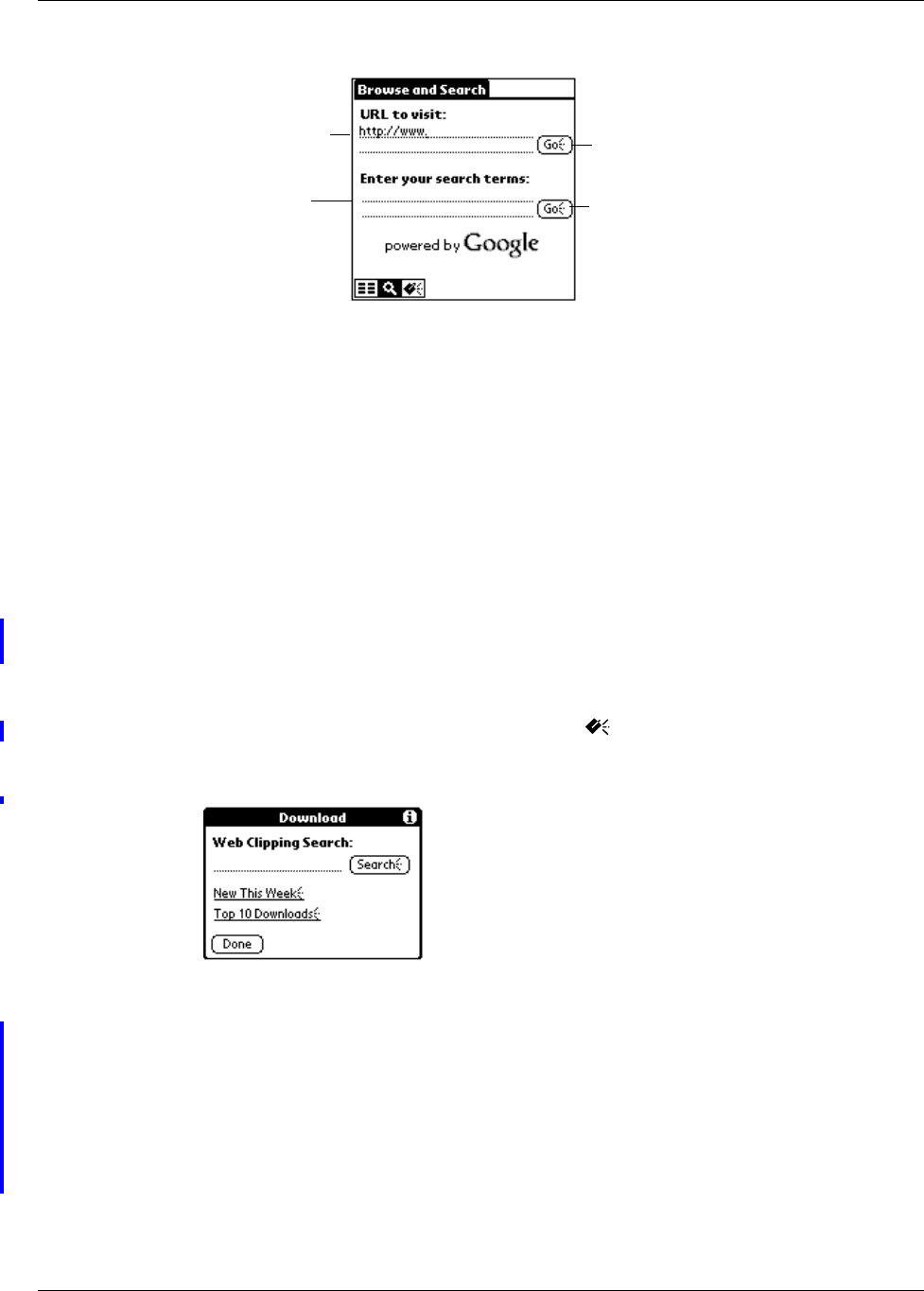
Using the MyPalm application
39
Adding web clipping applications
In addition to the web clipping applications available through the MyPalm portal
application, you can also download and install web clipping applications directly
on your handheld.
You can add web clipping applications to your handheld Applications Launcher
in two ways:
■Download an application directly using the Portal application.
■Download the application onto your computer desktop and perform a
HotSync® operation. This is the same procedure you would use for any other
application. See “Installing add-on applications” in Chapter 5 for details.
To add web clipping applications using the MyPalm application:
1. Tap the web clipping applications button .
2. Tap Download.
3. Do one of the following:
Enter search terms, and then tap Search.
Tap New This Week.
Tap Top 10 Downloads.
Your handheld initiates a wireless transaction, and returns results.
4. Tap a web clipping application to see more information about it.
Enter an URL
Enter search
terms
Tap to browse
an URL
Tap to search
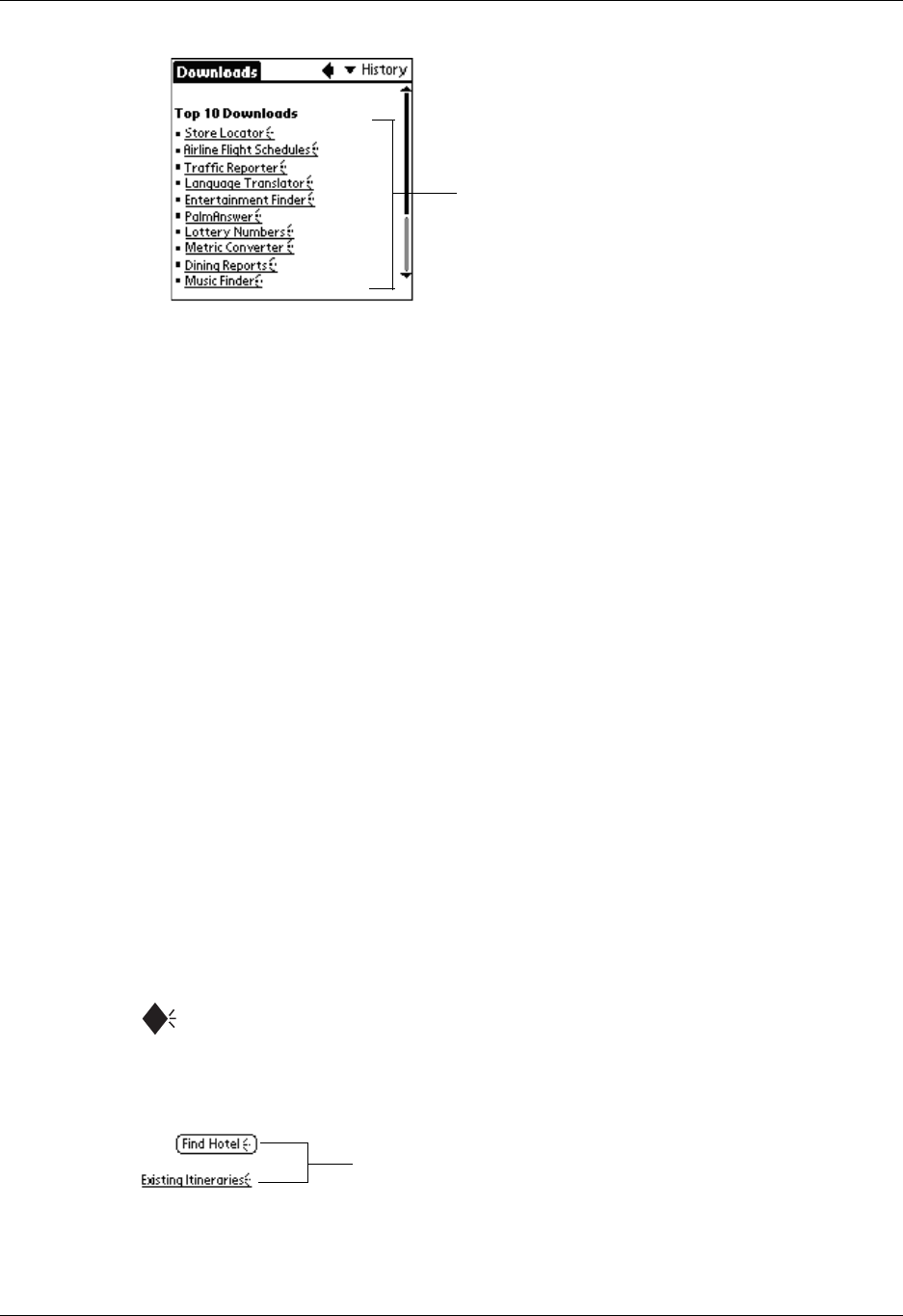
Using Wireless Features
40
5. Tap Download.
6. Tap Start Download.
7. Tap OK.
Working with web clipping applications
Web clipping applications are designed so that you can use them as you most
handheld applications. Skills you learn in other applications can also be used to
work in web clipping applications. For example:
■Tap to select an item or perform an action.
■Use Graffiti® writing or the onscreen keyboard to enter text.
■In edit lines, select, cut, copy, and paste text as you do in other applications on
your handheld.
■Elements of the interface that look familiar—edit lines, pick lists, check boxes,
scroll arrows, buttons, menus, etc.—behave in web clipping applications just as
they behave in basic applications like Address Book.
When you install a web clipping application on your handheld, it appears by
default in the Palm.Com category of the Applications Launcher. Most web
clipping application icons are easy to recognize because they usually include the
over-the-air icon: three short lines radiating from the right side of the application
icon. Often the application icons also have a dark diamond shape as their
background:
After you establish a wireless connection, tapping a command button or other
object that displays the over-the-air icon initiates a wireless transaction.
Tap a web clipping application
for more information
Common identifiers used in many icons
of web clipping applications
Examples of the
over-the-air icon
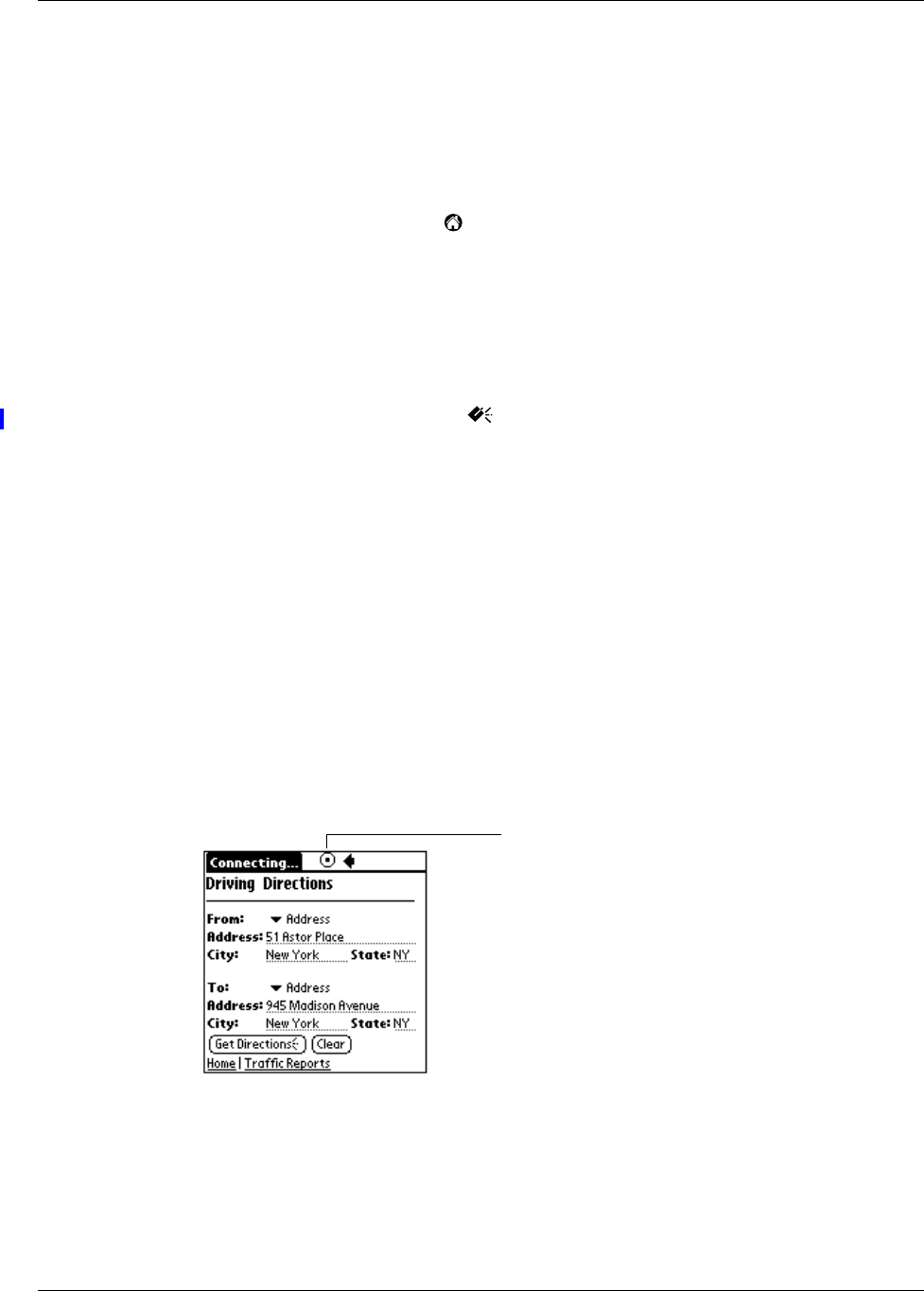
Working with web clipping applications
41
Using installed web clipping applications
Web clipping applications installed on your handheld appear in a list accessible
from the MyPalm application. They also appear by default in the Palm.Com®
category of the Applications Launcher.
To open a web clipping application from the Applications Launcher:
1. Tap the Applications icon .
2. Tap the pick list in the upper-right corner of the screen.
3. Tap Palm.Com.
4. Tap the icon of the web clipping application you want to open.
To open a web clipping application from the MyPalm application:
1. Tap the web clipping button .
2. Tap a web clipping application in the list.
Once the web clipping application opens, you can query the Internet for
information.
To query the Internet for information:
1. Follow the directions onscreen to specify the information you want from the
Internet.
2. Tap the button or other object that displays the over-the-air icon to submit your
query to the Internet.
The response — your clipping — typically appears onscreen within seconds.
To stop a wireless transaction:
■Tap the Stop icon.
Any data that is downloaded to your handheld before you tap the Stop icon
appears onscreen.
Example of web clipping
This example takes you through the process of finding driving directions using the
MapQuest web clipping application.
Stop icon
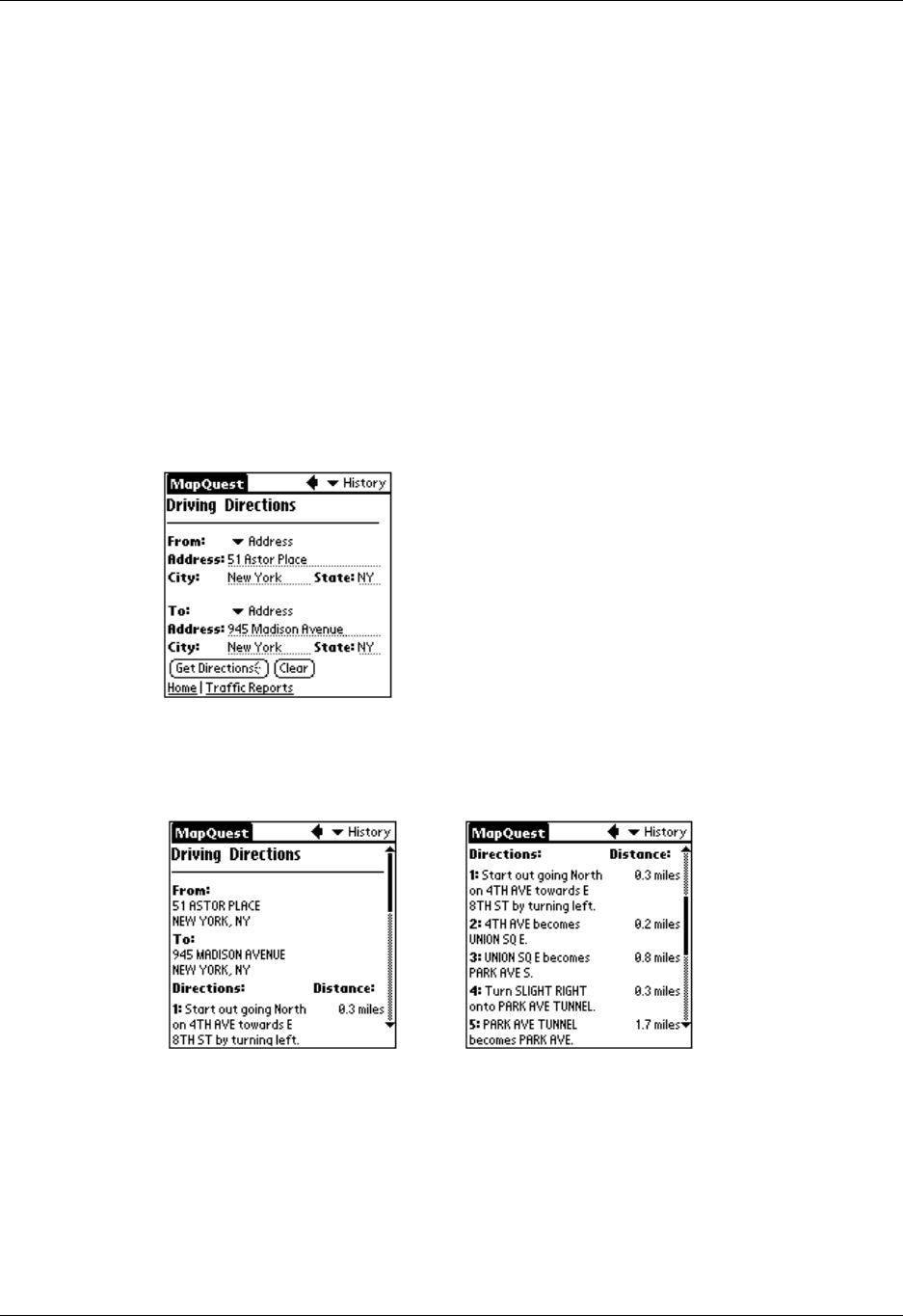
Using Wireless Features
42
Example: To find driving directions:
1. Tap the MapQuest icon.
2. Under From, tap the Address field and enter the street address of the place you
are leaving from.
You can use Graffiti writing or the onscreen keyboard to enter data.
3. Complete the From address by entering the city and state.
4. Under To, tap the Address field and enter the street address of the place you
want to go to.
5. Complete the To address by entering the city and state.
6. Tap Get Directions.
Note the over-the-air icon following the word “Directions.” That’s your clue
that the button initiates a wireless transaction.
Within seconds, your clipping appears. In this example, the clipping needs
more than one screen to display all the directions. Use the scroll bar to see the
rest of the clipping.
Reviewing current queries and clippings
Your handheld stores the queries and clippings of your current session so that you
can review them. Use the Back arrow to review the pages you displayed since you
opened the web clipping application.
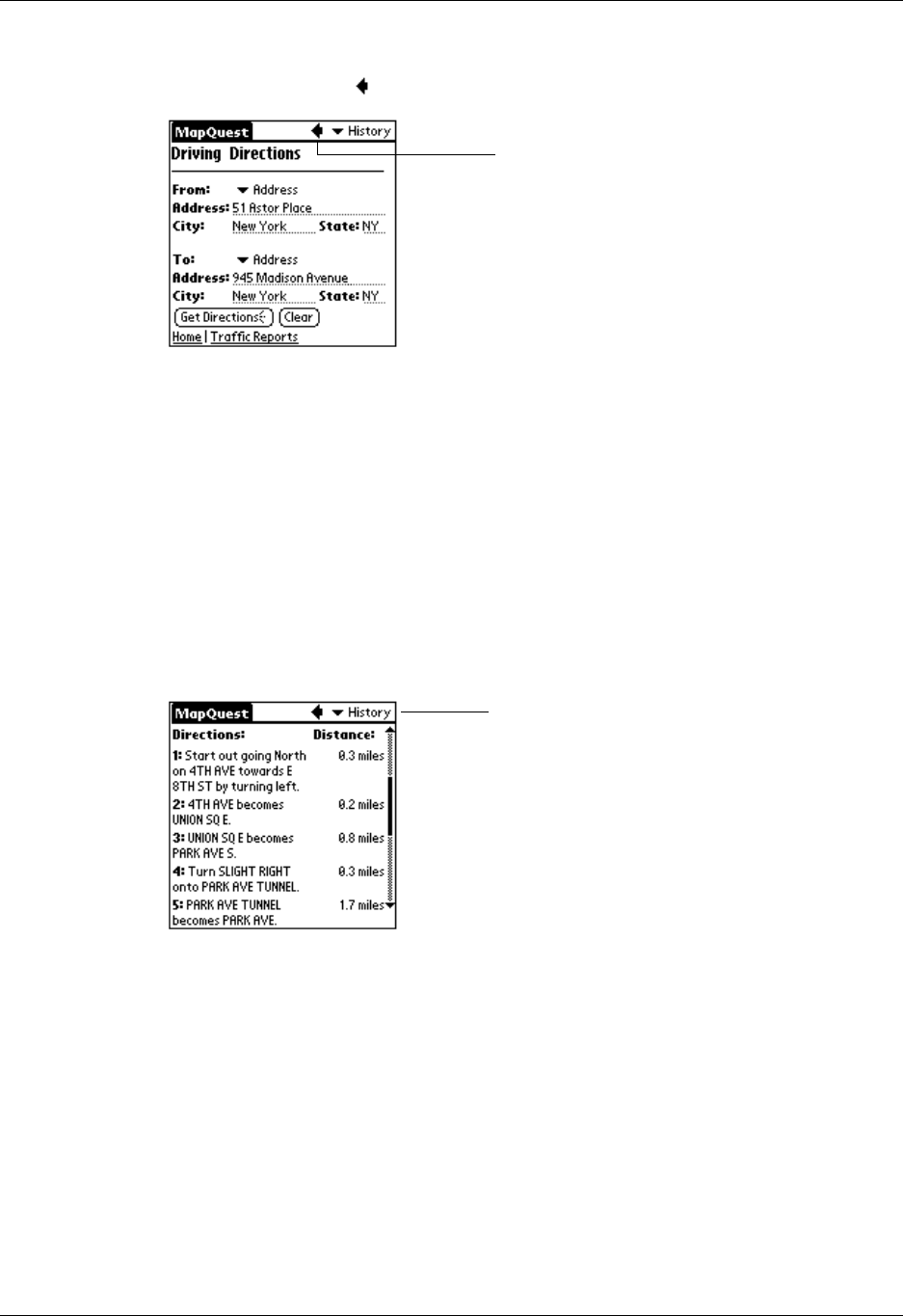
Working with web clipping applications
43
To go back to a previously viewed page:
■Tap the Back arrow in the web clipping application.
Reviewing stored clippings: History list
You can see a list of stored clippings in the History list and then select the one you
want to review. You can see clippings that pertain only to the web clipping
application that is open. When you open another web clipping application, the
History list changes to display only clippings that you received in that web
clipping application.
To review the History list:
1. Open the web clipping application that has clippings you want to review.
2. Tap the History pick list.
3. Select the clipping you want to review.
Saving information from a web clipping application
You can copy the text of a clipping or a page of a web clipping application and
paste it into another application. For example, you can copy driving directions and
paste them into Memo Pad.
To save the text of a clipping or page:
1. Make sure the clipping or page you want to copy is onscreen.
You can use the Back arrow or the History list to display the clipping or page
you want.
Back arrow
History pick list
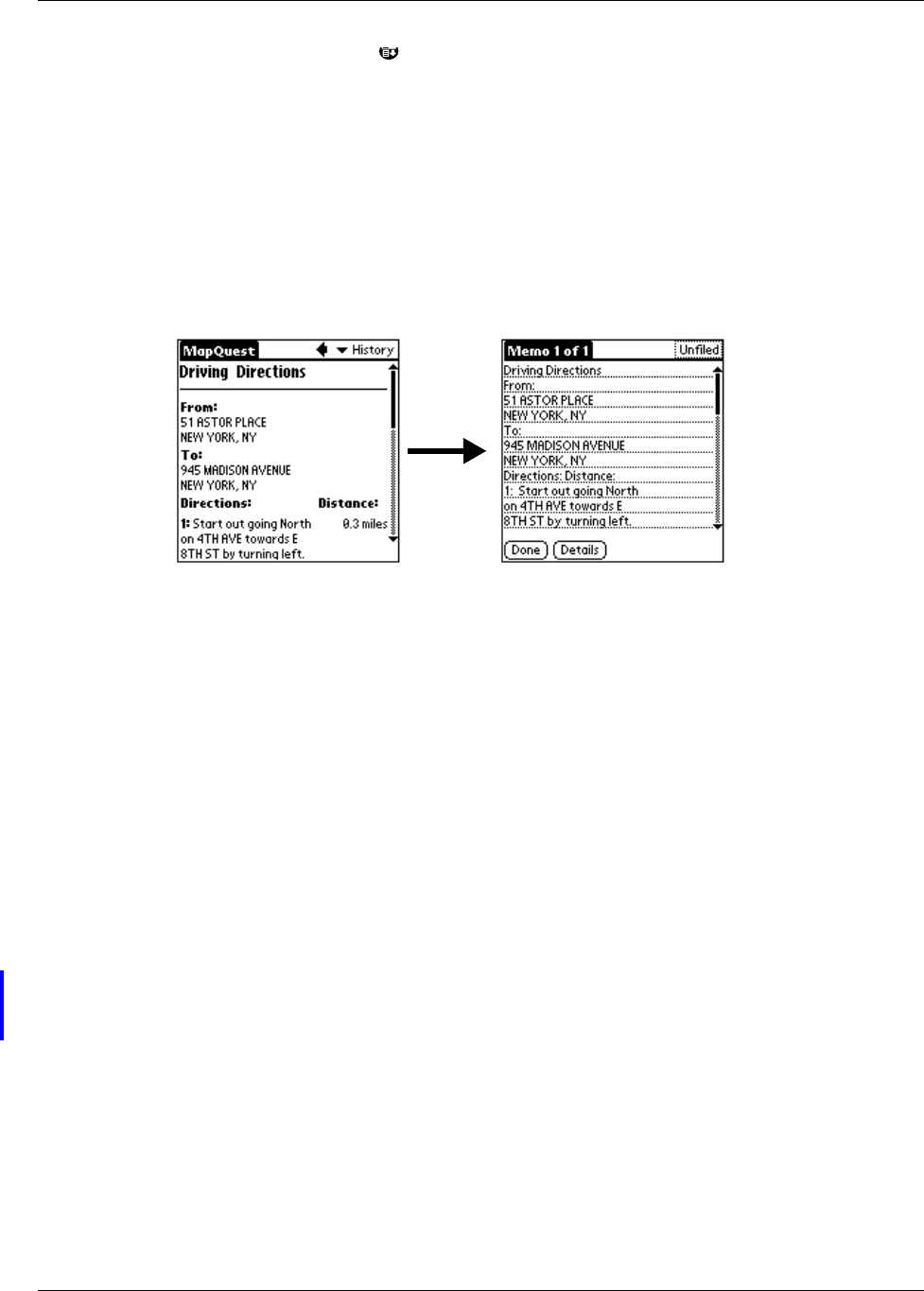
Using Wireless Features
44
2. Tap the Menu icon .
3. Tap Edit, and then tap Copy Page.
4. Open one of the handheld applications, such as Memo Pad.
5. Create a new record.
6. Tap the Menu icon.
7. Tap Edit, and then tap Paste.
For example, here are the directions found in the sample procedure above, pasted
into Memo Pad:
Keep the following points in mind about the Copy Page command:
■Copying always starts at the top of the current clipping or page, regardless of
what is displayed onscreen.
■The Copy Page command copies only the first 4,000 bytes (4KB) of data. If the
clipping or page you copy contains more than 4KB of data, your handheld
appends the word “truncated” to the end of the pasted text.
TIP Use the Info command in the Options menu to find out how large a
clipping is.
The Copy Page command does not copy images or icons; table structures; or text
formatting such as bold, italics, and so on.
Sending e-mail from a page
Note to Andover/Mimi-G team: The following text is a pickup from MultiMail SE
for the Battra project. Does this apply for Everest? I can’t find a WCA with a mailto
link. Please confirm or edit as needed.
If a web clipping application or clipping gives you the opportunity to reply to an
e-mail address, you can do so.
To send e-mail from a page:
1. Tap the address displayed in the page.
MultiMail Deluxe opens. The To: field contains the address to reply to.

Web Clipping Preferences
45
2. Enter the text of your message.
3. Do one of the following:
Tap Put in Outbox to file the message in the Outbox. Your message is sent the
next time you open the e-mail application and tap Get & Send.
Tap Cancel, and then tap Yes to save the message in the MultiMail Draft folder.
Tap No to delete the message.
Web Clipping Preferences
The Web Clipping Preferences screen enables you to change the connection and
the proxy server with which your handheld communicates and to prevent the
transmission of your handheld’s ID.
IMPORTANT If you are working within a corporate environment, do not change these
settings unless your corporate system administrator instructs you to do so.
To view or change Web Clipping Preferences:
1. Tap the Applications icon .
2. Tap the Prefs icon .
3. Tap the pick list in the upper-right corner of the screen.
4. Select Web Clipping.
5. Access any of the following options:
To change the proxy server:
1. From the Web Clipping Preferences screen, tap Server.
2. Enter your new Proxy server name or IP address.
3. Tap OK.
Connection Displays the name of the current connection, either the Palm
Wireless Service or a network dialup connection. Changes you
make in the Network preferences panel update this field.
User ID Displays your User ID.
Server Displays the name of the proxy server.
Warn when
sending personal
information
Displays a warning when you submit a query that transmits your
personal information, such as your unique handheld ID. The
warning gives you a choice; you can continue the transaction or
cancel it before any information is sent. If you want to be warned,
select this check box.
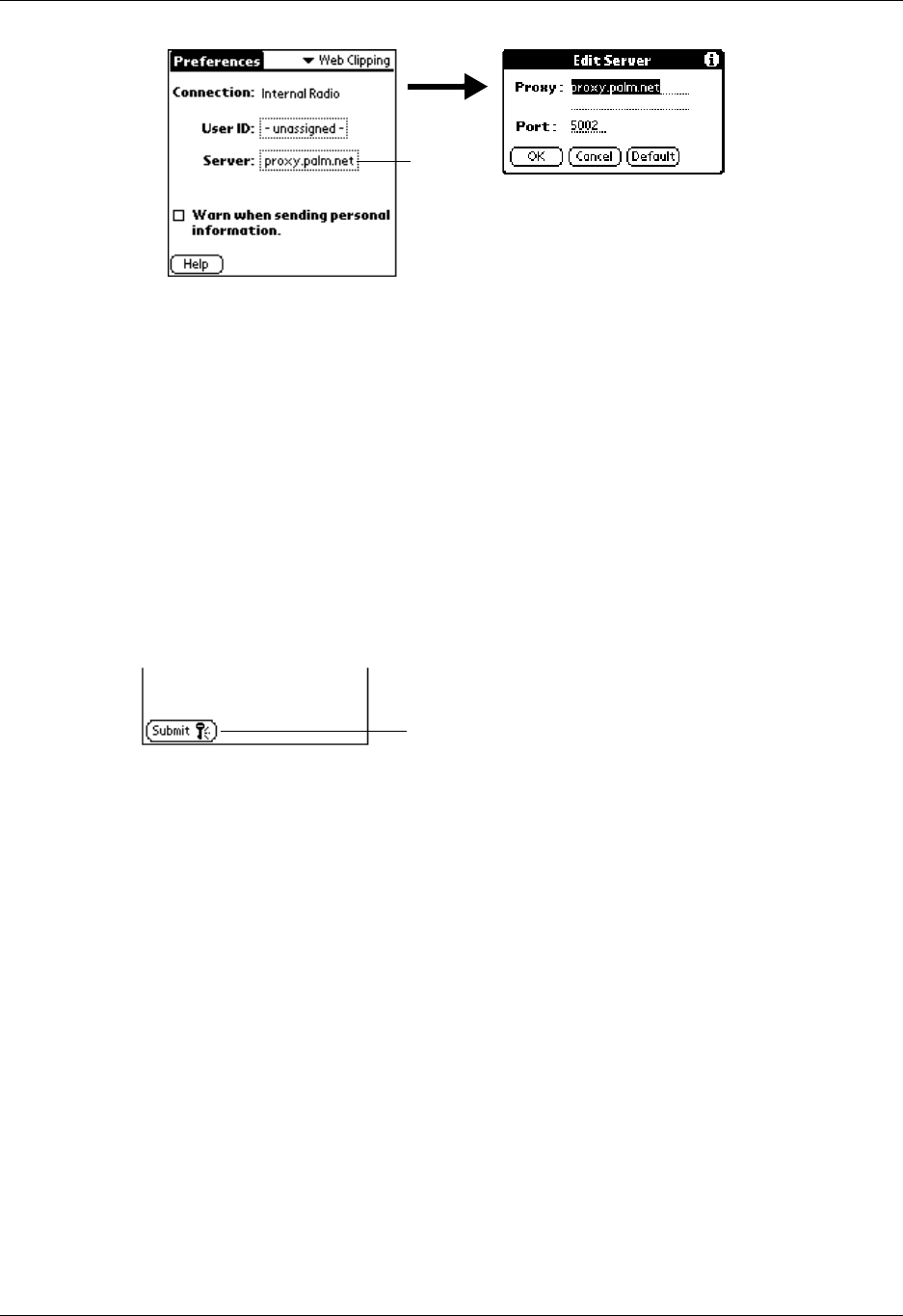
Using Wireless Features
46
To restore the initial proxy server setting, tap Default.
Protection of your wireless transactions
Your handheld uses next generation encryption technology. This encryption
technology secures the transmission of sensitive information such as passwords
that are sent over the network. Data is protected both when sent from your
handheld over the network and when coming in from the Internet to your
handheld.
When a wireless transaction is secured, the command button that initiates the
transaction is marked not only by the over-the-air icon, but also by the security
icon.
Encryption makes your data unreadable by anyone but the intended recipient.
Encryption is done using a technology used in a wide variety of consumer
handheld devices and enterprise applications.
It’s not unusual to experience a delay of several seconds when a wireless
transaction is being encrypted.
In addition to the protection provided by the encryption technology, individual
web clipping applications may add another layer of protection to their
transactions. For example, a web clipping application may require you to create
and use a password to access sensitive information (for example, your checking
account).
Ta p h e r e
The security icon indicates that your
transmission is encrypted
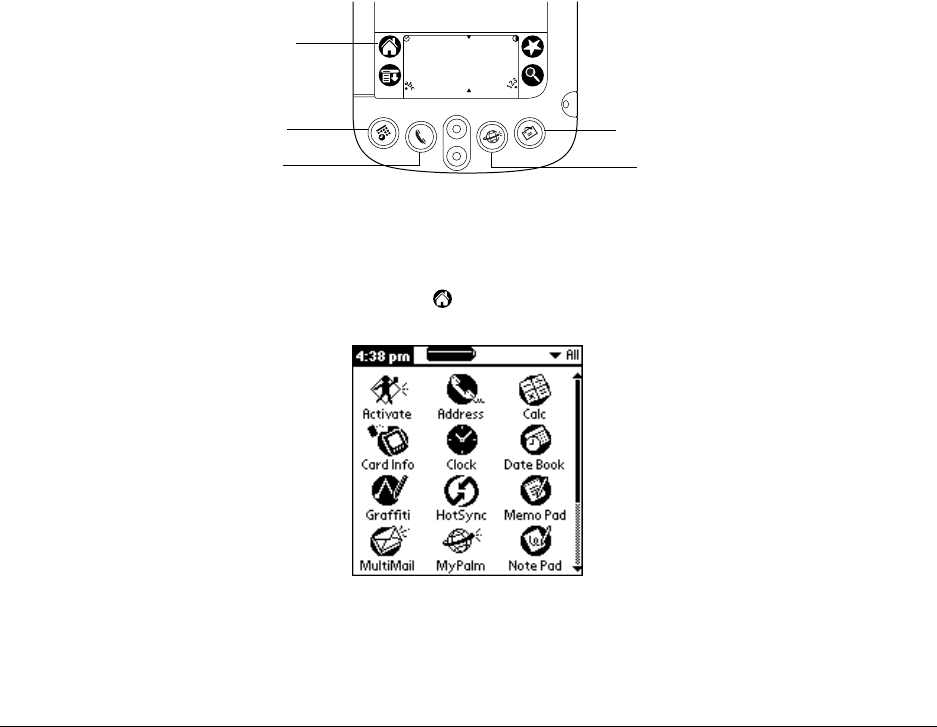
47
CHAPTER 5
Working with Applications
This chapter explains how to open and switch between applications on your
handheld, how to change application settings so they are personalized to your
work methods, and how to categorize applications so you view them in related
groups.
Opening applications
You can use the Applications Launcher to open any application installed on your
handheld or an expansion card. You can also open Date Book, Address Book, the
MyPalm® portal application, and MultiMail Deluxe with the application buttons
on the front panel of your handheld.
In addition to providing a way for you to open applications, the Applications
Launcher displays the current time, battery level, and application category.
To open an application on your handheld:
1. Tap the Applications icon .
2. Tap the icon of the application that you want to open. If you have many
applications installed on your handheld, tap the scroll bar to see all of your
applications.
Applications
Launcher
Address Book
Date Book MultiMail
Deluxe
Wireless
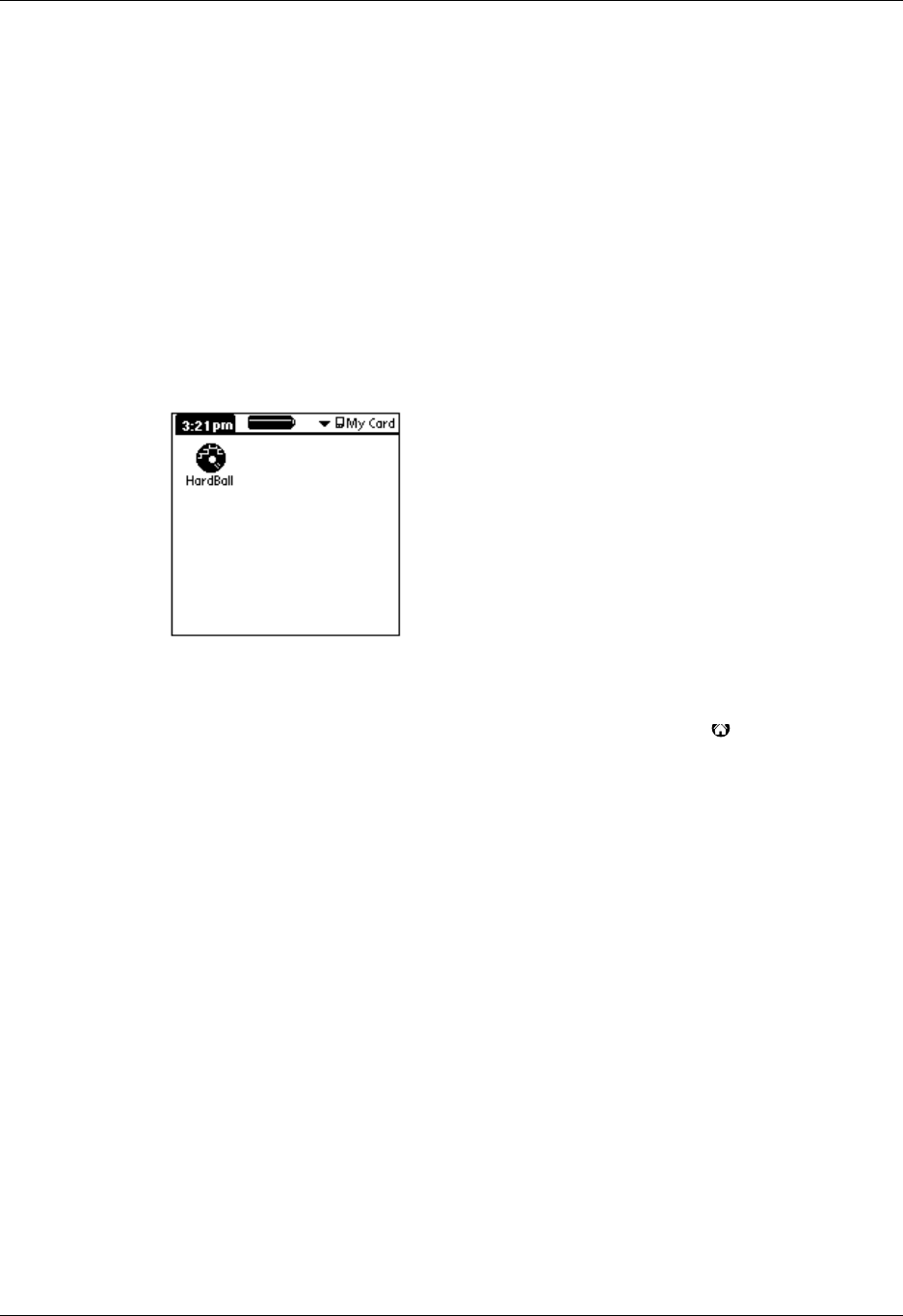
Chapter 5 Working with Applications
48
TIP To find an application quickly, you can write the Graffiti® character for the
first letter of its name. The Applications Launcher scrolls to the first application
with a name that begins with that letter.
Opening expansion card applications
When an expansion card is properly seated in the expansion card slot, the
Applications Launcher switches to the card and displays its contents. The pick list
in the upper-right corner of the screen displays the name of the card.
To open an application on an expansion card:
■Tap the icon of the application that you want to open.
Switching between applications
When working in any application, tap the Applications icon or press an
application button on the front panel of your handheld to switch to another
application. Your handheld automatically saves your work in the current
application and displays it when you return to that application.
When you use an expansion card, your handheld creates and displays a new
category that matches the name of the expansion card. You can easily switch
between applications installed on your handheld and on the expansion card.
To switch to an expansion card:
1. Tap the pick list in the upper-right corner.
2. Tap the category item that matches the name of the expansion card.
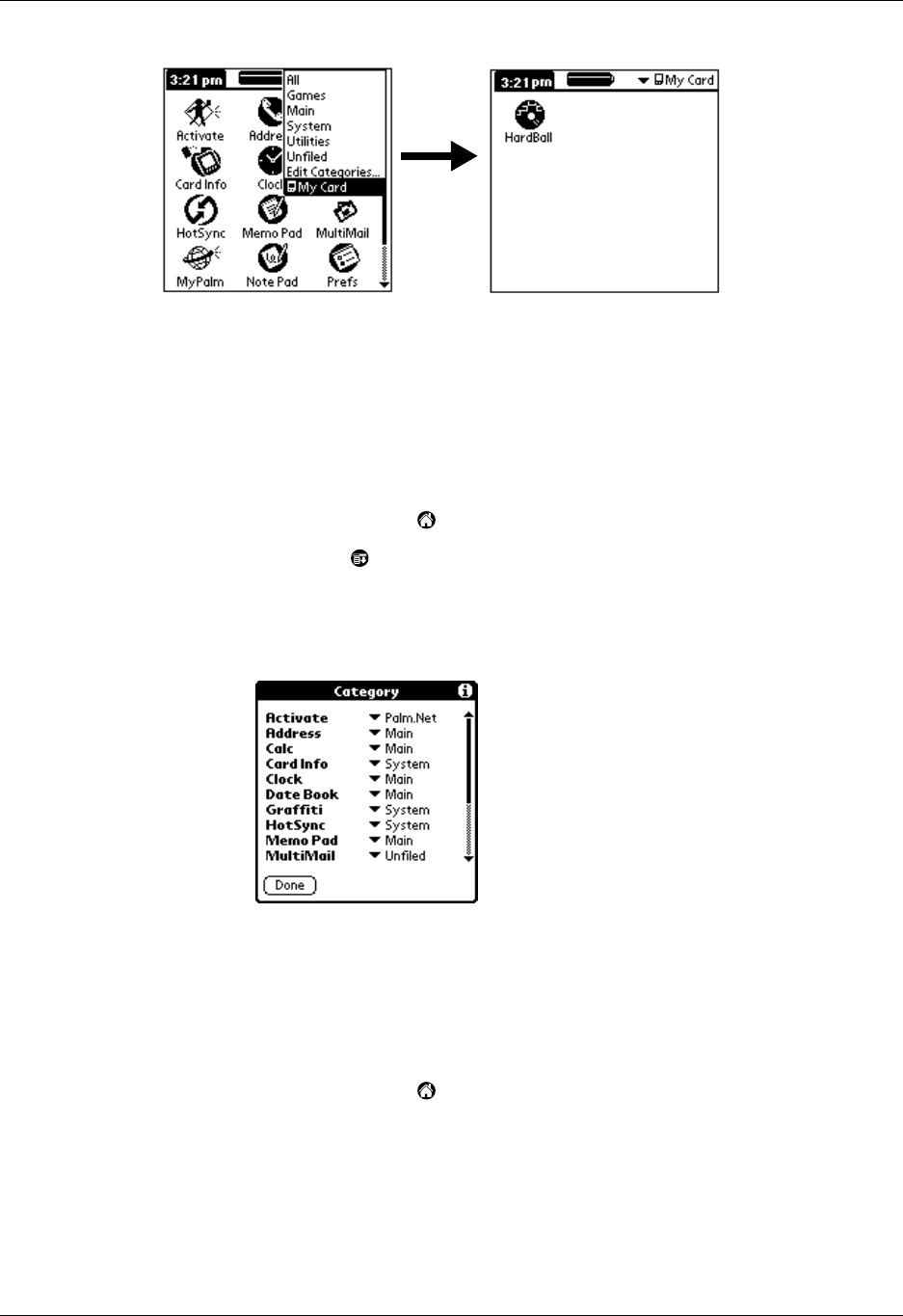
Categorizing applications
49
Categorizing applications
The category feature enables you to manage the number of application icons that
appear onscreen in the Applications Launcher. You can assign an application to a
category and then display a single category or all your applications.
To categorize an application:
1. Tap the Applications icon .
2. Tap the Menu icon .
3. Tap Category on the App menu.
4. Tap the pick list next to each application to select a category.
TIP To create a new category, tap Edit Categories from the pick list. Tap New,
enter the category name, and then tap OK to add the category. Tap OK.
5. Tap Don e.
To display applications by category:
1. Tap the Applications icon .
2. Do one of the following:
Tap the Applications icon repeatedly to cycle through all your categories.
Tap the pick list in the upper-right corner of the screen and
select the category you want to display.
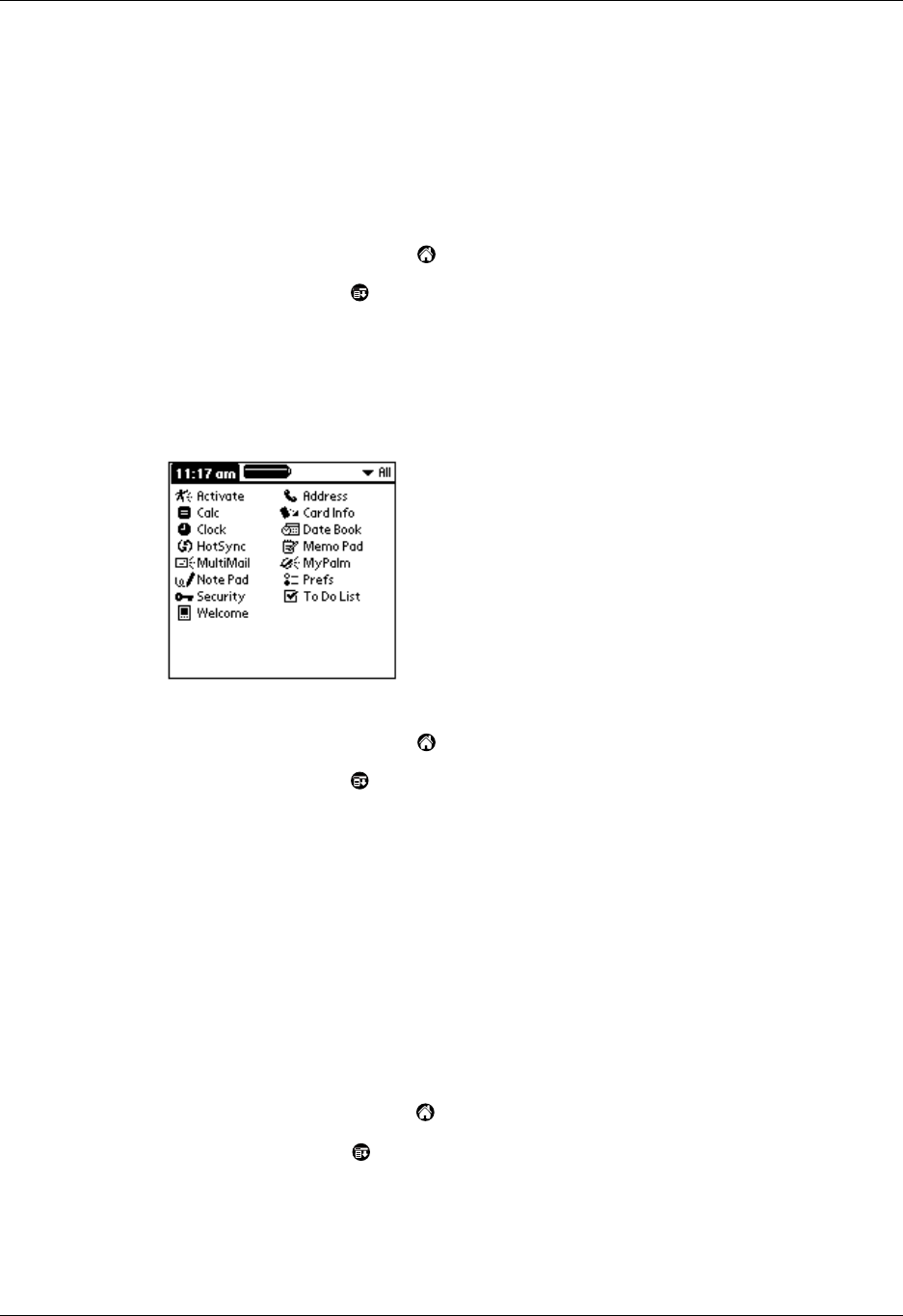
Chapter 5 Working with Applications
50
Changing the Applications Launcher display
By default, the Applications Launcher displays each application as an icon. As an
alternative, you can choose to show a list of applications. You can also choose to
view the same category of applications each time you open the Applications
Launcher.
To change the Applications Launcher display:
1. Tap the Applications icon .
2. Tap the Menu icon .
3. Tap Options, and then tap Preferences.
4. Tap the View By pick list and select List.
5. Tap OK.
To open the Applications Launcher to the last opened category:
1. Tap the Applications icon .
2. Tap the Menu icon .
3. Tap Options, and then tap Preferences.
4. Tap the Remember Last Category check box to select it.
5. Tap OK.
Copying applications to an expansion card
You can copy applications from your handheld to an expansion card, or from an
expansion card to your handheld.
To copy an application to an expansion card:
1. Tap the Applications icon .
2. Tap the Menu icon .
3. Tap Copy on the App menu.
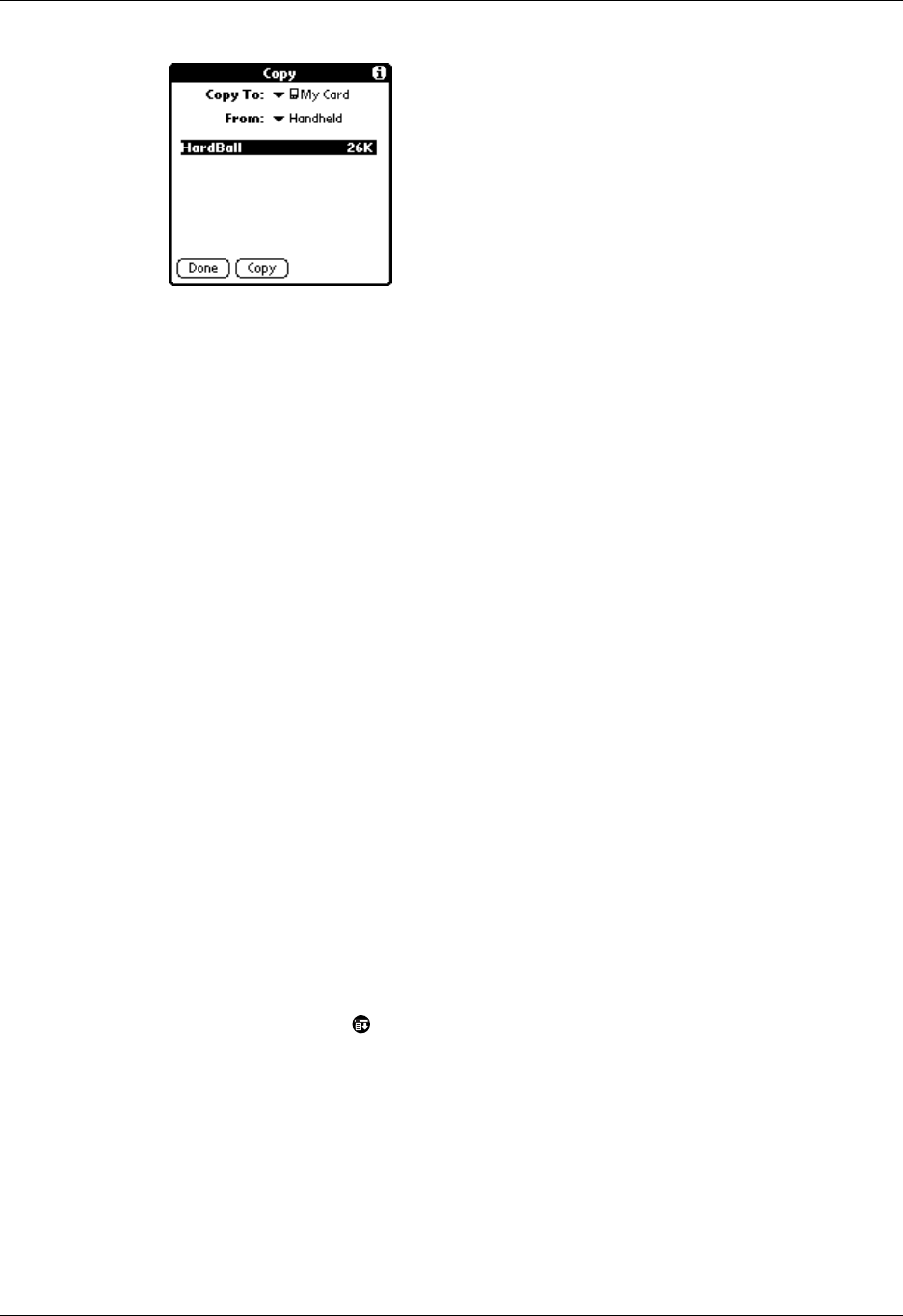
Using menus
51
4. Select the card name from the Copy To pick list.
5. Select Handheld from the From pick list.
6. Tap an application to copy.
7. Tap Copy.
8. Tap Don e.
You can install applications to a card that is seated in the expansion card slot
during a HotSync operation; see “Installing add-on applications” later in this
chapter for details.
NOTE If you copy applications between your handheld and multiple
expansion cards, and then attach a card with a copied application to a Card
Reader/Writer, you may notice that the copied application’s filename has been
changed to the name of a database file it contains. You will only see this if you
use your cards with a Card Reader/Writer.
Using menus
Menus on your handheld are easy to use. Once you have mastered them in one
application, you can use them the same way in all other applications.
The menus of each application are illustrated in the chapter on that application.
To open the menu bar:
1. Open an application (such as Memo Pad).
2. Do one of the following:
Tap the Menu icon .
Tap on the inverted title area at the top of the screen.
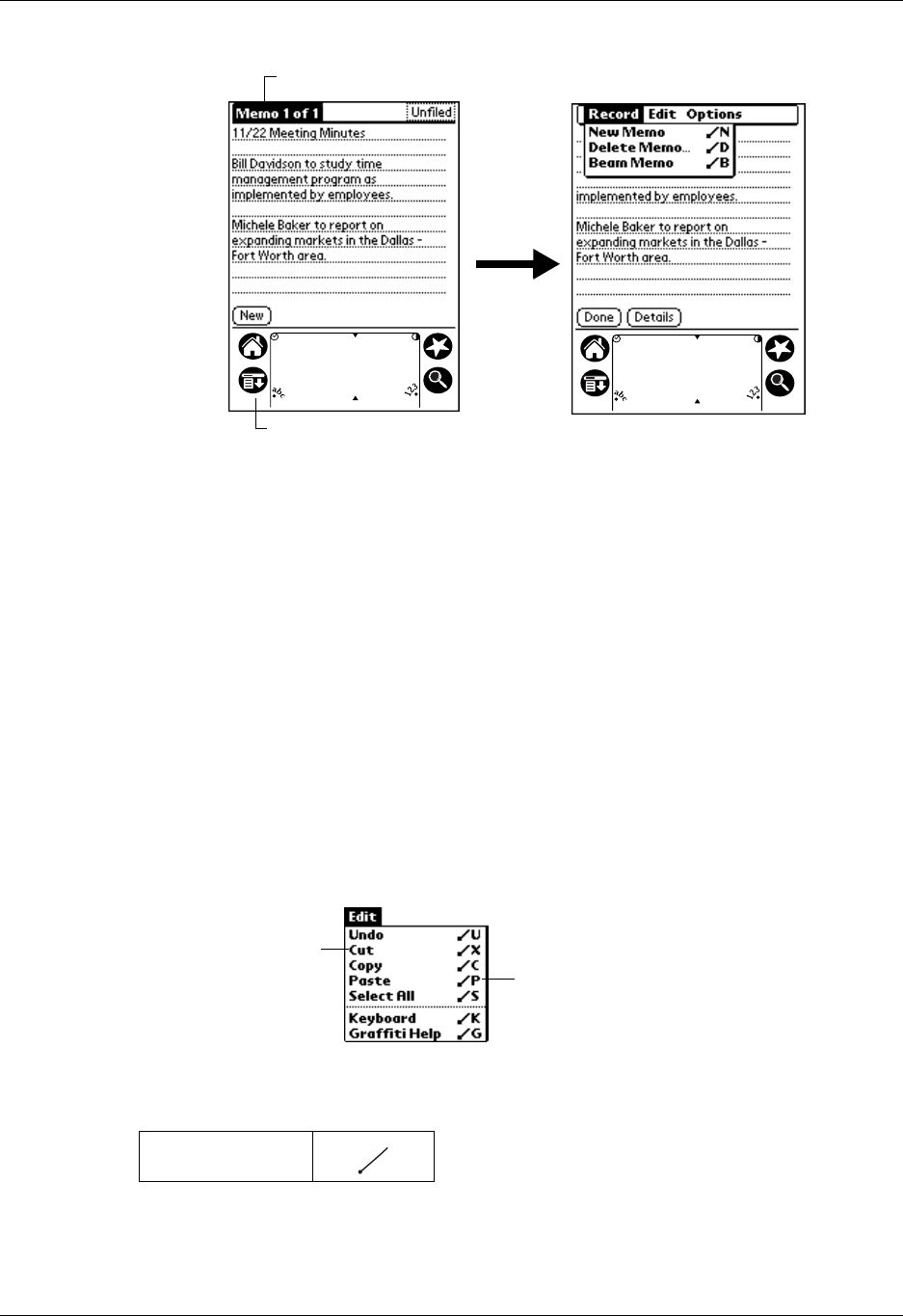
Chapter 5 Working with Applications
52
In this example, three menus are available: Record, Edit, and Options. The Record
menu is selected and contains the commands New Memo, Delete Memo, and Beam
Memo.
Choosing a menu
After you open the menu bar for an application, tap the menu that contains the
command you want to use.
The menus and menu commands that are available depend on the application that
is currently open. Also, the menus and menu commands vary depending on which
part of the application you’re currently using. For example, in Memo Pad, the
menus are different for the Memo list screen and the Memo screen.
Graffiti menu commands
Most menu commands have an equivalent Graffiti Command stroke, which is
similar to the keyboard shortcuts used to execute commands on computers. The
command letters appear to the right of the command names.
Draw the Command stroke anywhere in the Graffiti area. When you draw the
Command stroke, the Command toolbar appears just above the Graffiti writing
area to indicate that you are in Command mode.
Command
Tap the Menu icon
Tap the title area
Command letters
Menu commands
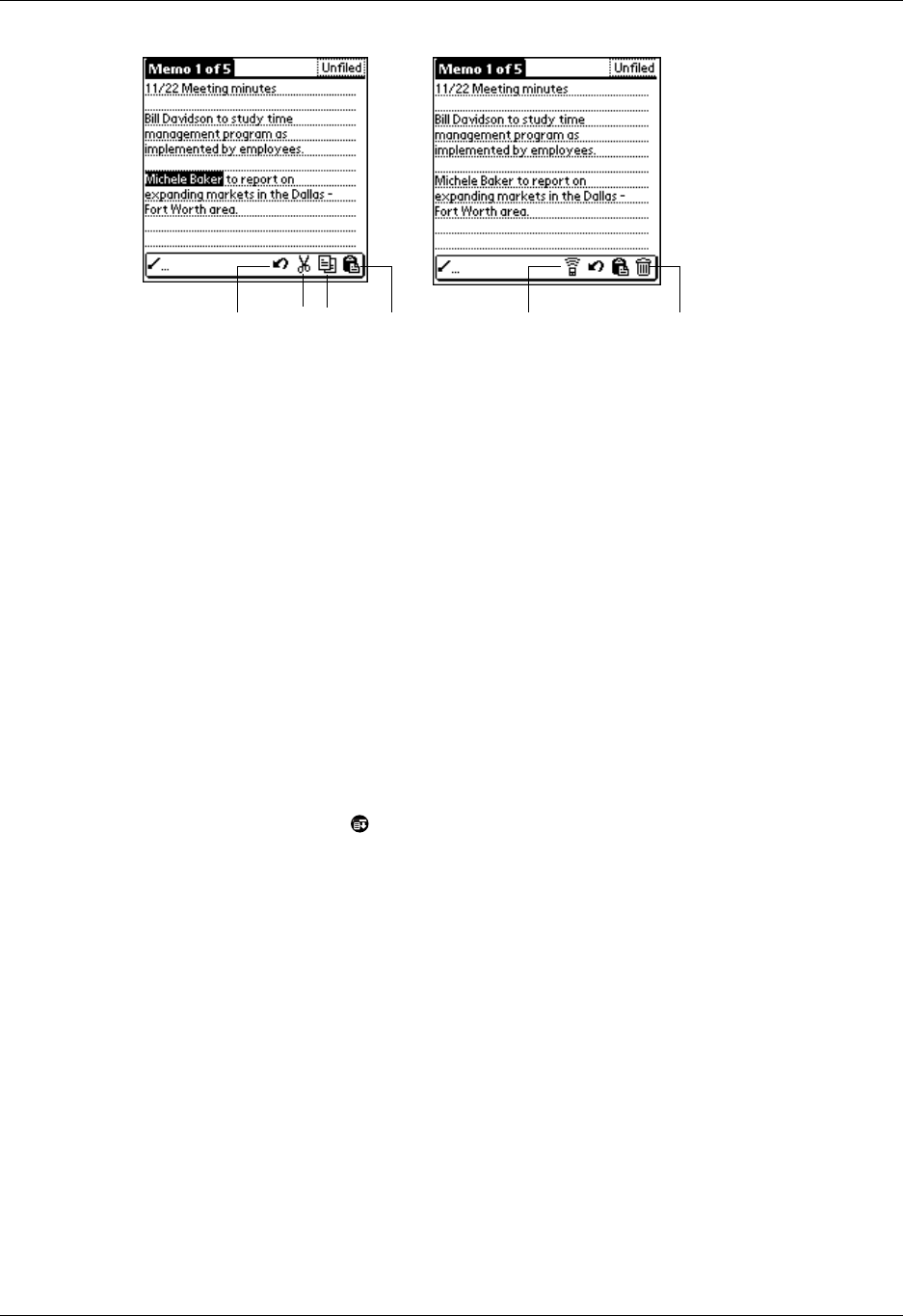
Choosing application preferences
53
The command toolbar displays context sensitive menu commands for the current
screen. For example, if text is selected the menu icons displayed may be undo, cut,
copy, and paste. Tap on an icon to select the command, or immediately write the
corresponding command letter for an appropriate command in the Graffiti writing
area.
For example, to choose Select All in the Edit menu, draw the Command stroke,
followed by the letter “s.”
Command mode is only active for a short time, so you must tap an icon or write
the command letter immediately to choose the menu command.
Choosing application preferences
You can set options that affect an entire application in the application’s Preferences
dialog box.
To change preferences for an application:
1. Open an application.
2. Tap the Menu icon .
3. Tap Options, and then tap Preferences.
NOTE Not all applications have a Preferences command.
4. Make changes to the settings.
5. Tap OK.
Common tasks
The tasks described in this section use the term “records” to refer to an individual
item in any of the applications: a single Date Book event, Address Book entry, To
Do List item, Note Pad note, or Memo Pad memo.
CutUndo Copy Paste Beam Delete
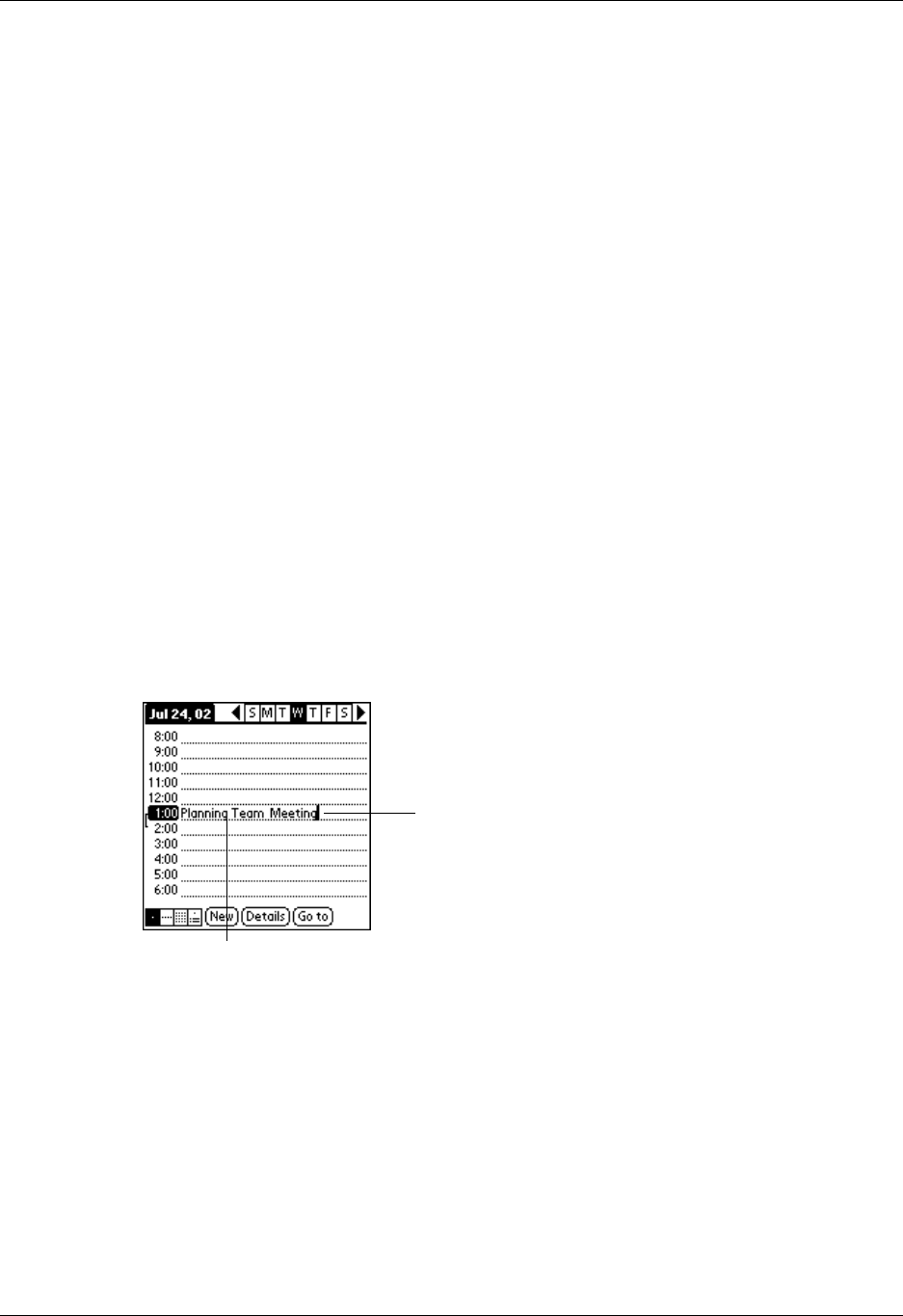
Chapter 5 Working with Applications
54
Creating records
You can use the following procedure to create a new record in Date Book, Address
Book, To Do List, Note Pad, and Memo Pad.
To create a record:
1. Select the application in which you want to create a record.
2. Tap N ew.
3. In Date Book only: Select start and end times for your appointment and tap OK.
4. Enter text for the record.
5. (Optional) Tap Details to select attributes for the record. (Not available in Note
Pad.)
6. In Address Book, Note Pad, and Memo Pad only: Tap Done.
There’s no need to save the record because your handheld saves it automatically.
Editing records
After you create a record, you can change, delete, or enter new text at any time.
Two screen features tell you when your handheld is in editing mode:
■A blinking cursor
■One or more dotted edit lines
NOTE In Note Pad you can write anywhere on the screen. So, you will not see
an edit line or blinking cursor.
Entering text
For information on how to enter text using Graffiti writing, the onscreen keyboard,
or the keyboard attached to your computer, see . For information on entering text
in Note Pad, see Chapter 12.
Edit menu
The Edit menu is available with any screen where you enter or edit text. In general,
commands available in the Edit menu apply to text that you select in an application.
Edit line
Blinking cursor

Common tasks
55
To select text in an application:
1. Tap the beginning of the text that you want to select.
2. Drag the stylus over the text to highlight it (in black).
NOTE You can also double tap to select a word, or triple tap to select a line of
text.You can also drag across the text to select additional words, or drag down
to select a group of lines.
The following commands may appear in an Edit menu:
NOTE In Note Pad, the Edit menu appears only when the title of a note is selected.
To edit a note in Note Pad, use the eraser tool to remove lines, and the pen tool to add
lines.
Deleting records
To delete a record:
1. Select the record you want to delete.
2. Tap the Menu icon .
3. Tap Record, and then tap the Delete command:
Date Book: Delete Event
Address Book: Delete Address
Undo Reverses the action of the last edit command. For example, if you
used Cut to remove text, Undo restores the text you removed.
Undo also reverses deletions done by using backspace.
Cut Removes the selected text and stores it temporarily in the memory
of your handheld. You can paste the text you cut into another area
of the current application or into a different application.
Copy Copies the selected text and stores it temporarily in the memory of
your handheld. You can paste the text that you copy into another
area of the current application or into a different application.
Paste Inserts the text that you cut or copied at the selected point in a
record. The text you paste replaces any selected text. If you did not
previously cut or copy text, Paste does nothing.
Select All Selects all of the text in the current record or screen. This enables
you to cut or copy all of the text and paste it elsewhere.
Keyboard Opens the onscreen keyboard. When you finish with the onscreen
keyboard, tap Done.
Graffiti Help Opens screens that show all the Graffiti character strokes. Use this
command anytime you forget a stroke for a character.

Chapter 5 Working with Applications
56
To Do L is t : Delete Item
Note Pad: Delete Note
Memo Pad: Delete Memo
A confirmation dialog box appears. If you want to save a copy of the deleted
item to an archive file in Palm Desktop software, be sure that the check box is
checked. If you don’t want to save a copy, tap the check box to remove the check.
(The archive check box does not appear in Note Pad because you can’t archive
Note Pad notes.)
4. Tap OK.
If you choose to save a copy of the selected item, your handheld transfers it to the
archive file on your desktop the next time you perform a HotSync operation.
Other ways to delete records
You can also delete records in the following ways:
■In Date Book, Address Book, To Do List, and Memo Pad, open the Details dialog
box for the record, tap Delete, and then tap OK.
■In Note Pad, open the note you want to delete, and then tap Delete.
■Delete the text of the record.
NOTE In Date Book, you can choose to delete the text of the current repeating
event, current and future events, or all instances of that event.
Purging records
Over time, as you use Date Book and To Do List, you’ll accumulate records in these
applications that have outlived their usefulness. For example, events that occurred
months ago remain in the Date Book, and To Do List items that you marked as
completed remain in the list.
All these outdated records take up memory on your handheld, so it’s a good idea
to remove them by using Purge. If you think Date Book or To Do List records might
prove useful later, you can purge them from your handheld and save them in an
archive file on your computer.
Purging is not available in Address Book, Note Pad, or Memo Pad; you must delete
outdated records manually from these applications.
To purge records:
1. Open the application.
2. Tap the Menu icon .
3. Tap Record, and then tap Purge.
A confirmation dialog box appears.

Common tasks
57
Date Book: Tap the pick list and select how old a record must be to be purged.
Purge deletes repeating events if the last of the series ends before the date that
you purge records.
Date Book, To Do List: If you want to save a copy of the purged records to an
archive file on your desktop, be sure that the check box is checked. If you don’t
want to save a copy, tap the check box to remove the check box.
4. Tap OK.
If you chose to save a copy of the purged records, your handheld transfers them to
an archive file on your desktop the next time you perform a HotSync operation.
NOTE Purging does not happen automatically. You must tap the command to make
it happen.
Categorizing records
Categorize records in the Address Book, To Do List, Note Pad, and Memo Pad
applications so that they are grouped logically and are easy to review.
When you create a record, your handheld automatically places it in the category
that is currently displayed. If the category is All, your handheld assigns it to the
Unfiled category. You can leave an entry as Unfiled or assign it to a category at any
time.
System-defined and user-defined categories
By default, your handheld includes system-defined categories, such as All and
Unfiled, and user-defined categories, such as Business and Personal.
You cannot modify the system-defined categories, but you can rename and delete
the user-defined categories. In addition, you can create your own user-defined
categories. You can have a maximum of 15 user-defined categories in each
application.
When you have an expansion card properly seated in the expansion card slot, the
last item in the category pick list will be the name of the expansion card. You
cannot otherwise categorize applications that reside on an expansion card.
Address Book contains the QuickList user-defined category, in which you can store
the names, addresses, and phone numbers you might need in emergencies (doctor,
fire department, lawyer, etc.).
The illustrations in this section come from Address Book, but you can use these
procedures in all the applications in which categories are available.
To move a record into a category:
1. Select the record you want to categorize.
2. In Address Book only: Tap Edit.
3. Tap Details.
4. Tap the Category pick list to display the list of available categories.
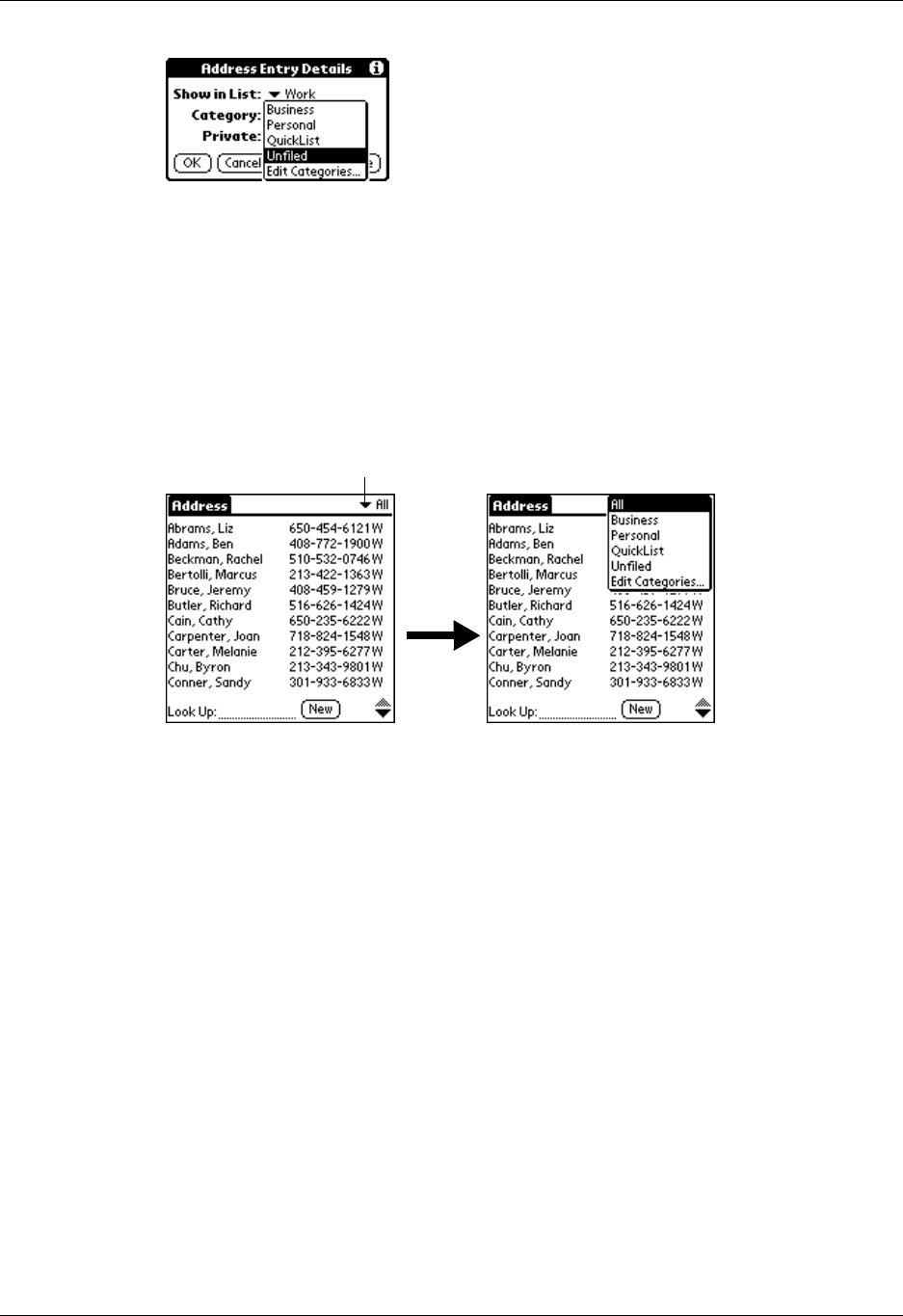
Chapter 5 Working with Applications
58
5. Select the category for the record.
6. Tap OK.
NOTE In Address Book, Note Pad, and Memo Pad you can tap the category
name in the upper-right corner of the screen and select a new category for the
item.
To display a category of records:
1. Tap the category pick list in the upper-right corner of the list screen.
NOTE In the Date Book Agenda view, the pick list is in the upper right of the To
Do list.
2. Select the category you want to view.
The list screen now displays only the records assigned to that category.
TIP Pressing an application button on the front panel of the handheld toggles
through all the categories of that application.
Tap here
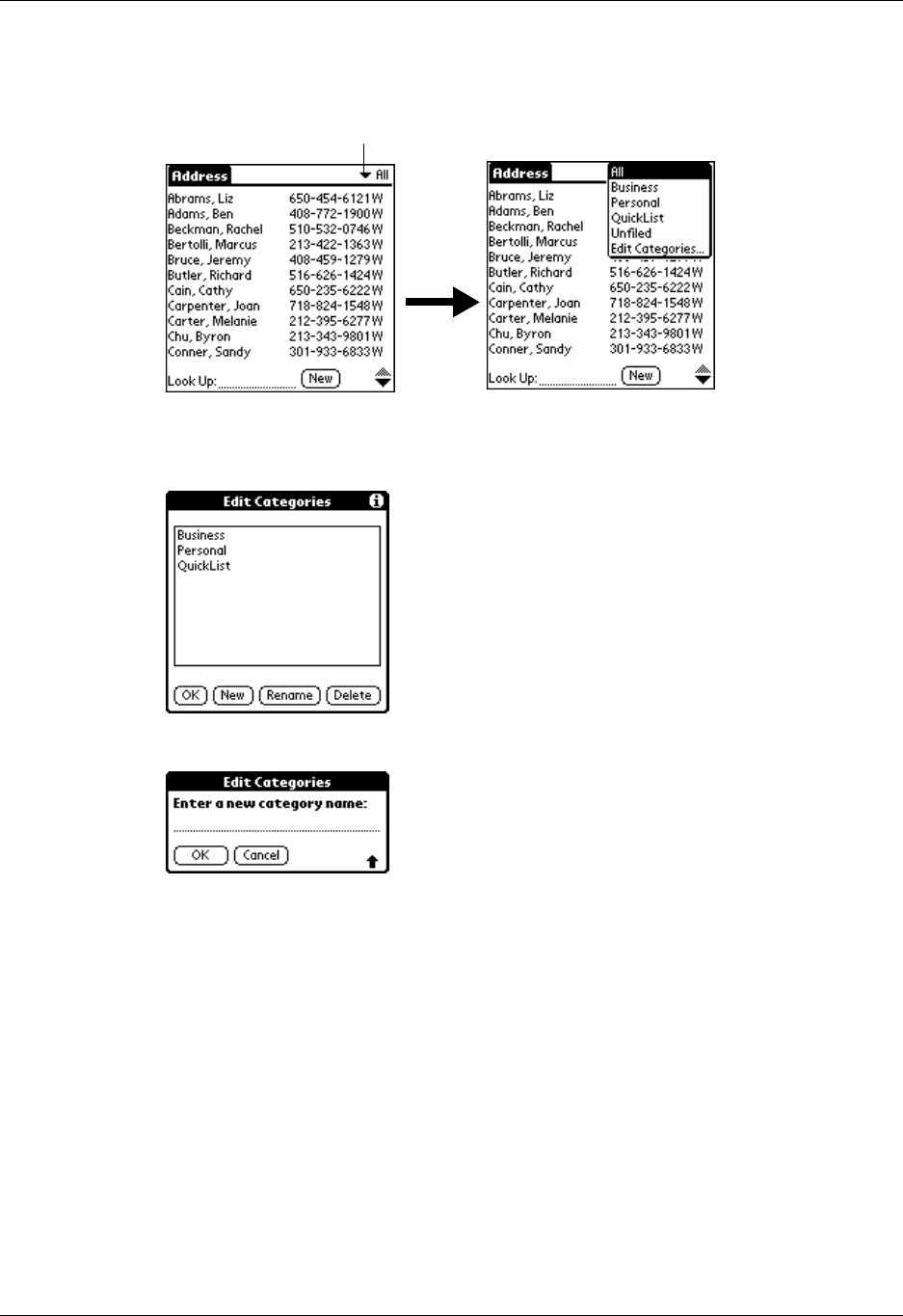
Common tasks
59
To define a new category:
1. Tap the category pick list in the upper-right corner of the screen or list.
2. Tap Edit Categories.
3. Tap N ew.
4. Enter the name of the new category, and then tap OK.
5. Tap OK.
You can assign any of your records to the new category.
To rename a category:
1. Tap the category pick list in the upper-right corner of the screen or list.
2. Tap Edit Categories.
3. Select the category that you want to rename, and then tap Rename.
Tap here
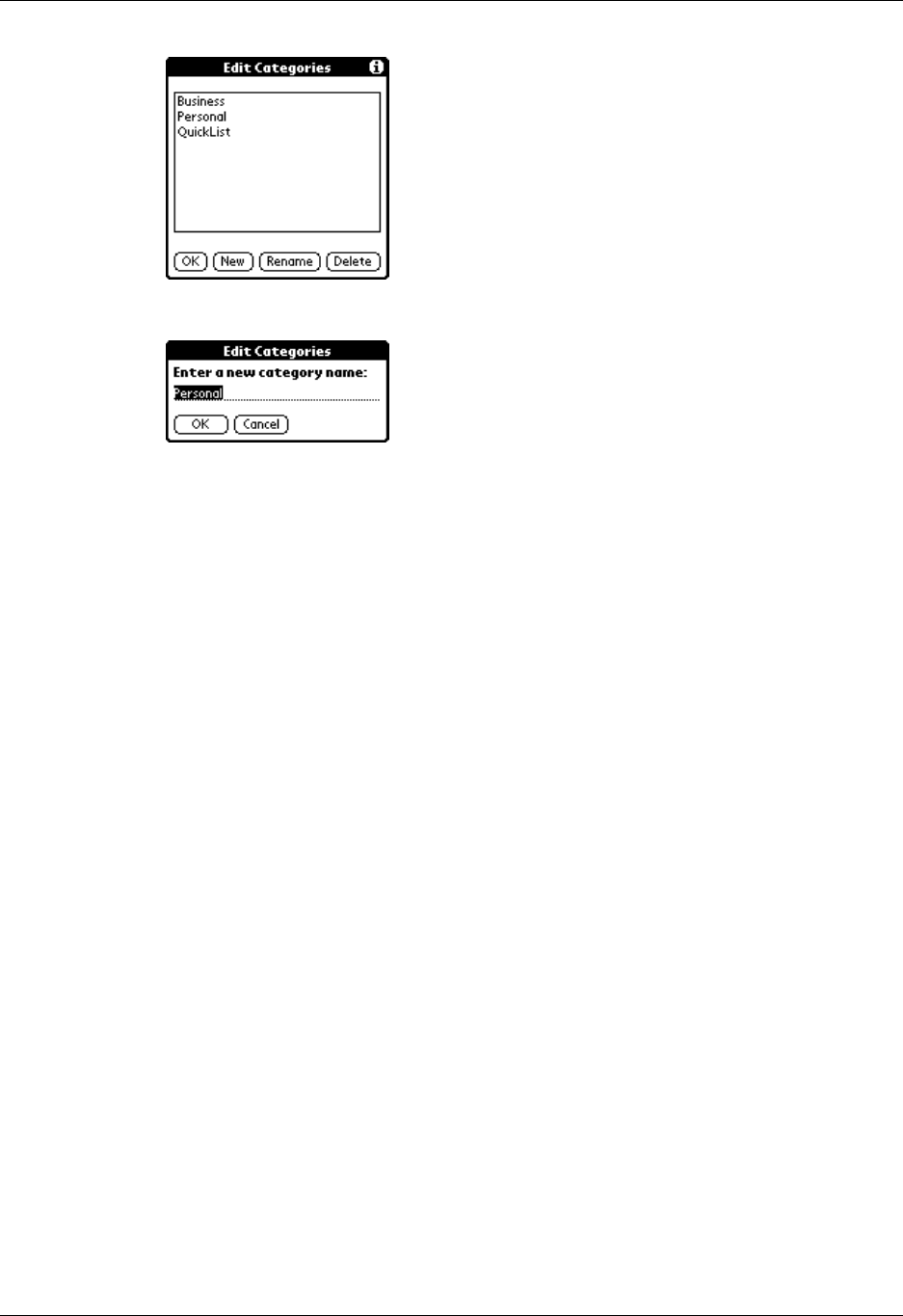
Chapter 5 Working with Applications
60
4. Enter the new name for the category, and then tap OK.
5. Tap OK.
TIP You can group the records in two or more categories into one category by
giving the categories the same name. For example, if you change the name of
the Personal category to Business, all records formerly in the Personal category
appear in the Business category.
Finding information
Your handheld offers several ways to find information quickly:
■All applications that reside on your handheld: Find locates any text that you
specify, always starting with the current application. However, Find does not
search through applications on expansion cards.
■Date Book, To Do List, Memo Pad: Phone Lookup displays the Address list
screen and lets you add the information that appears in this list to a record.
■Address Book: The Look Up line lets you enter the first letters of a name to scroll
immediately to that name.
Looking up Address Book records
When working with Address Book, the scroll button on the front panel of the
handheld makes it easy to navigate among your address entries.
■In the Address list screen, the scroll button moves up or down an entire screen
of records. If you hold down the scroll button, you accelerate the scrolling and
display every third screen.
■In the Address view screen, the scroll button moves to the previous or next
address record.
You can also use the Address list Look Up feature to quickly scroll to any of your
Address Book entries.
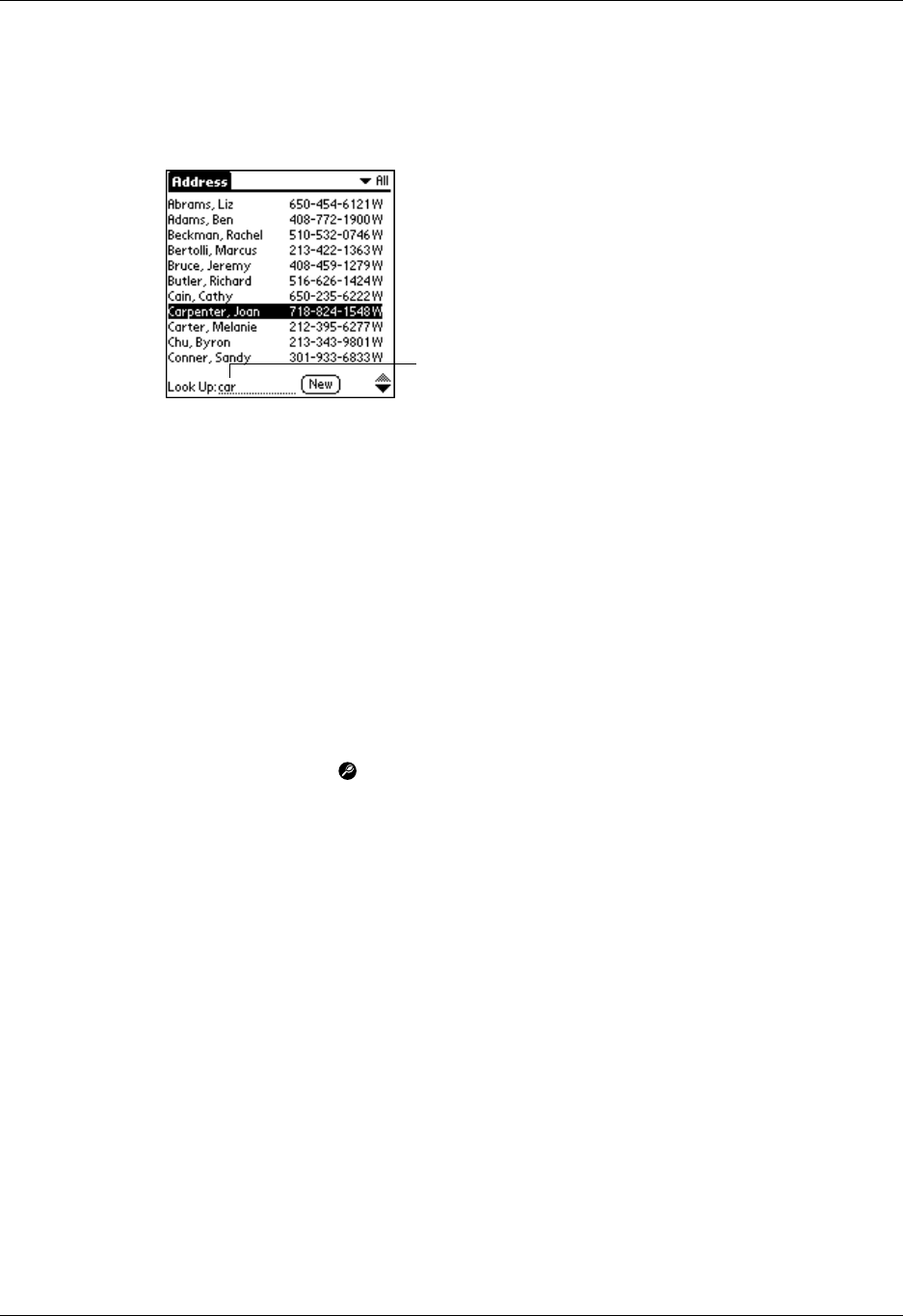
Common tasks
61
To look up an Address Book record:
1. Display the Address list screen.
2. Enter the first letter of the name you want to find.
The list scrolls to the first entry that begins with that letter. If you write another
letter, the list scrolls to the first entry that starts with those two letters. For
example, writing an “s” scrolls to “Sands,” and writing “sm” scrolls further to
“Smith.” If you sort the list by company name, the Look Up feature scrolls to the
first letter of the company name.
3. Tap the record to view its contents.
Using Find
You can use Find to locate any text that you specify, in any application that resides
on your handheld. Find does not search applications that reside on an expansion
card.
To use Find:
1. Tap the Find icon .
TIP If you select text in an application before you tap Find, the selected text
automatically appears in the Find dialog box.
2. Enter the text that you want to find.
Find is not case-sensitive. For example, searching for the name “davidson” also
finds “Davidson.”
Find locates any words that begin with the text you enter. For example,
searching for “plane” finds “planet,” but not “airplane.”
3. Tap OK.
Find searches for the text in all records and all notes.
Look Up line
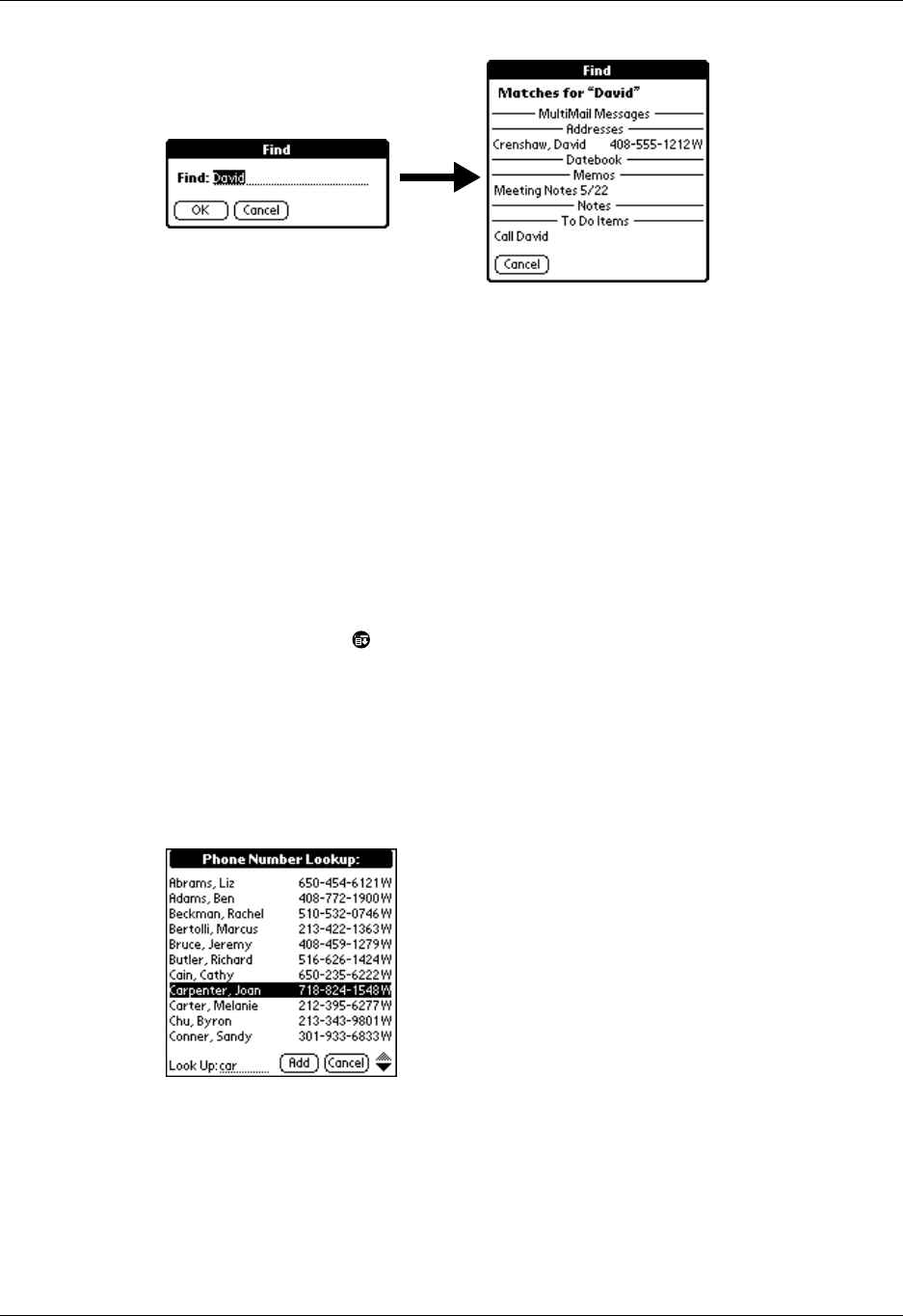
Chapter 5 Working with Applications
62
As your handheld searches for the text, you can tap Stop at any time. You may
want to do this if the entry you want appears before your handheld finishes the
search. To continue the search after you tap Stop, tap Find More.
4. Tap the text that you want to review.
Using Phone Lookup
Phone Lookup displays the Address list screen and lets you add the information
that appears in this list to a record.
To use Phone Lookup:
1. Display the record in which you want to insert a phone number. The record can
be in Date Book, To Do List, Memo Pad, or Mail.
2. Tap the Menu icon .
3. Tap Options, and then tap Phone Lookup.
4. Begin to spell the last name of the name you want to find.
The list scrolls to the first record in the list that starts with the first letter you
enter. Continue to spell the name you’re looking for, or when you see the name,
tap it.
5. Tap Add.
The name you selected, along with the other information associated with it, is
pasted into the record you selected in step 1.

Common tasks
63
Phone Lookup tips
Write the Graffiti Command stroke “/L” to activate the Phone Lookup feature. You
can also activate it in the following circumstances:
■While entering text: For example, to insert the full name and phone number for
someone with the last name “Williams,” write the Graffiti characters for “Wi”
and then the Phone Lookup Command stroke “/L.”
Assuming you have only one Address Book record that begins with “Wi,” your
handheld inserts the full name “Fred Williams” (and its associated
information). If you have more than one name that begins with “Wi,” the Phone
Lookup screen appears and highlights the first record that begins with “Wi.”
■For selected text: Drag to highlight the text, and then write the Phone Lookup
Command stroke “/L.” Your handheld replaces the selected text and adds the
name and its associated information.
Sorting lists of records
You can sort lists of records in various ways, depending on the application. Sorting
is available in applications that have list screens: Address Book, To Do List, and
Memo Pad.
NOTE You can also assign records to categories. See “Categorizing records” earlier
in this chapter.
To sort records in To Do List:
1. Open the application to display the list screen.
2. Tap Show.
3. Tap the Sort by pick list and select an option.
4. Tap OK.
To sort records in Address Book, Note Pad, and Memo Pad:
1. Open the application to display the list screen.
2. Tap the Menu icon .
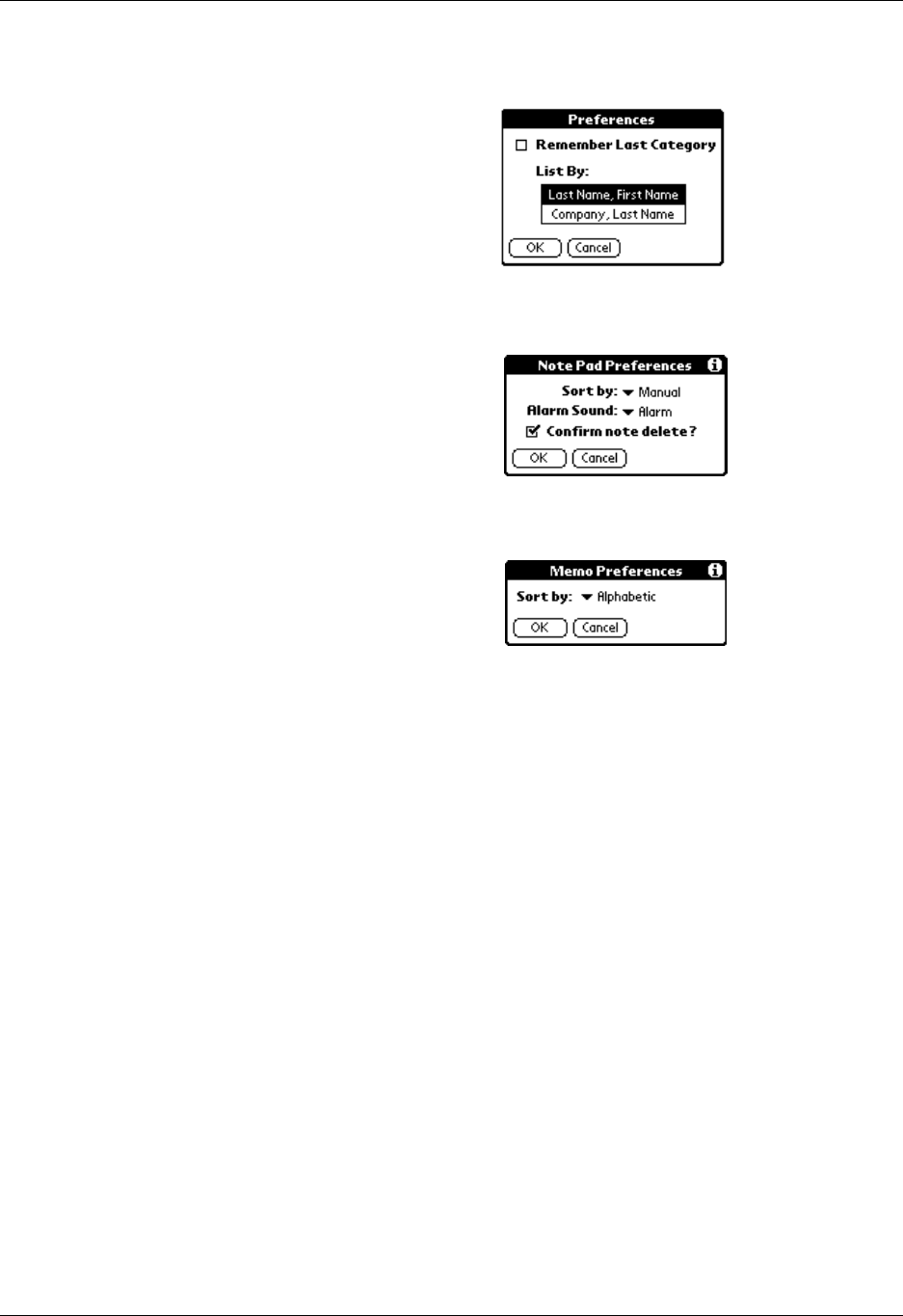
Chapter 5 Working with Applications
64
3. Tap Options, and then tap Preferences.
4. Do one of the following:
Address Book: Tap the setting you want.
Note Pad: Tap the Sort by pick list and select Alphabetic, Date, or Manual.
Memo Pad: Tap the Sort by pick list and select Alphabetic or Manual.
5. Tap OK.
To sort the Note Pad or Memo list manually, tap and drag a memo or note to a
new location in the list.
To make the list of your memos appear in Palm Desktop software as you
manually sorted it on your handheld, open Memo Pad in Palm Desktop
software and click List by. Then select Order on handheld.
Attaching notes
In applications except Memo Pad and Note Pad, you can attach a note to a record.
A note can be up to several thousand characters long. For example, for an
appointment in Date Book, you can attach a note with directions to the location.
Address Book
Note Pad
Memo Pad
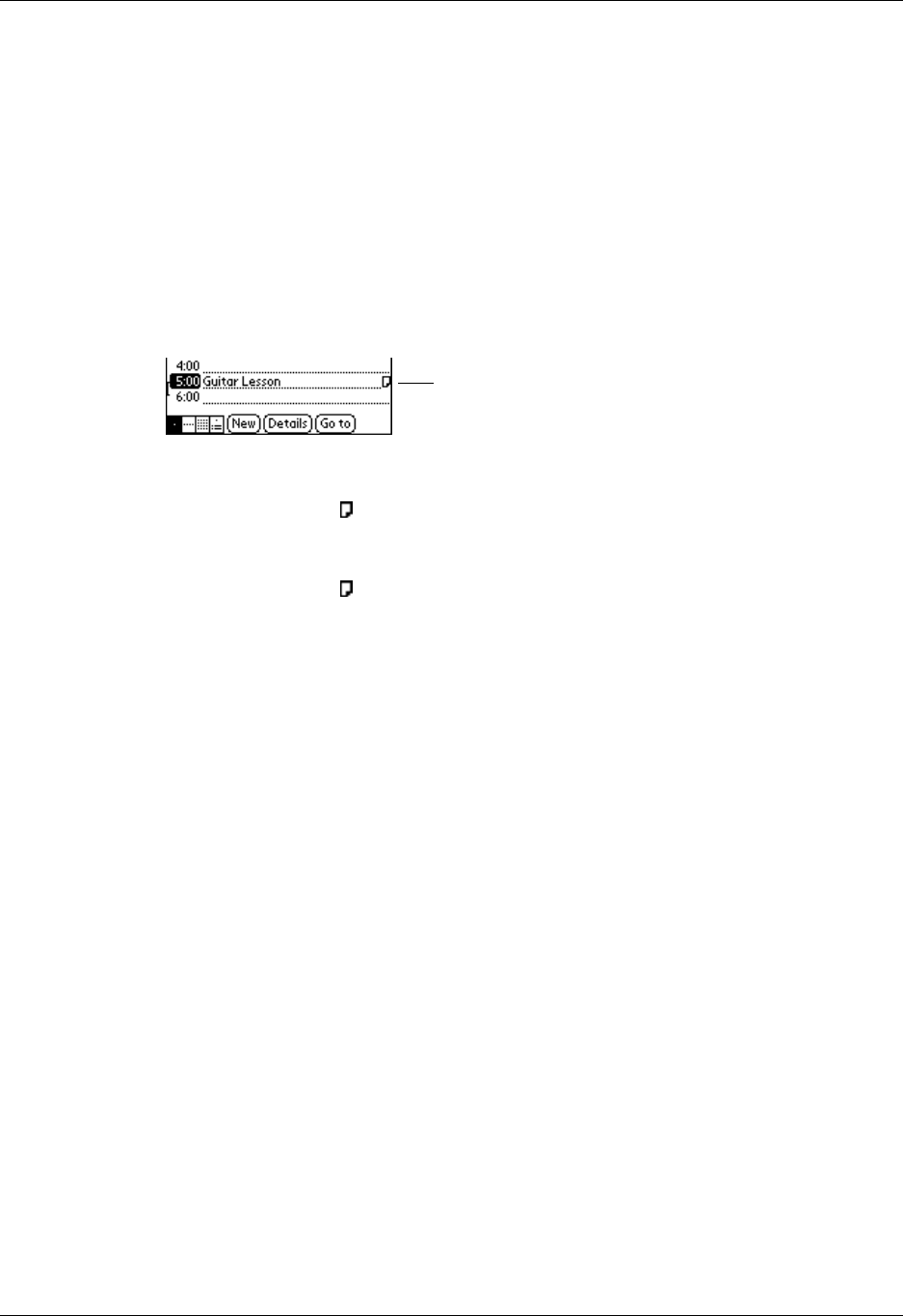
Common tasks
65
To attach a note to a record:
1. Display the entry to which you want to add a note.
2. In Address Book only: Tap Edit.
3. Tap Details.
4. Tap N o te.
5. Enter your note.
6. Tap Don e.
A small note icon appears at the right side of any item that has a note.
To review or edit a note:
■Tap the Note icon .
To delete a note:
1. Tap the Note icon .
2. Tap Delete.
3. Tap Yes.
Choosing fonts
In many applications, you can change the font style to make text easier to read. You
can choose small, large, or bold fonts in each application that allows you to change
font sytle.
Note icon
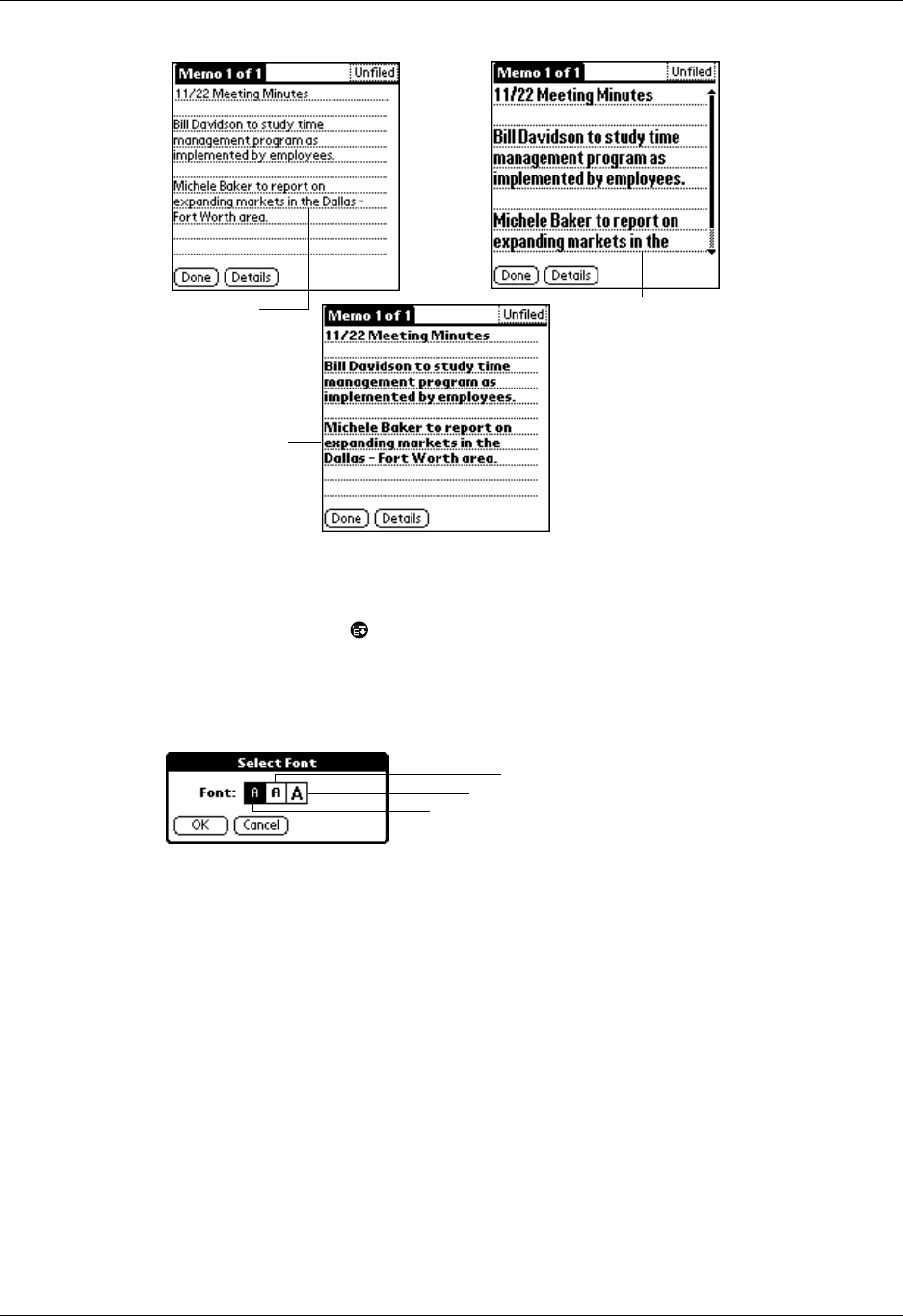
Chapter 5 Working with Applications
66
To change the font style:
1. Open an application.
2. Tap the Menu icon .
3. Tap Options, and then tap Font.
4. Tap the font style you want to use.
5. Tap OK.
Reviewing Reminders
You can set alarms to notify you of appointments, notes, and alarms in Date Book,
Note Pad, and Clock. When an alarm occurs, your handheld displays a reminder
message. If you tap Snooze in response to an alarm message, your handheld
Small font Large font
Bold font
Tap here for small font
Tap here for large font
Tap here for bold font

Installing and removing applications
67
reminds you of the alarm again in five minutes. The Reminder screen displays
alarms that await attention.
To respond to reminders, do one of the following:
■Select an item’s check box to clear the item.
■Tap an item (either the icon or the text description) to open the application
where the alarm was set. The application opens to the entry associated with the
alarm.
■Tap Done to close the reminder list and return to the current screen. An
attention indicator will blink in the upper-left corner of the screen; tap it to view
the reminder list again.
■Tap Snooze to see the list again in five minutes.
If you tap Done or Snooze and view the reminder list later, the current time
displays in the Reminder bar and the original alarm time displays with each list
item.
■Tap Clear All to dismiss all reminders in the list.
Hiding or masking private records
You can use the Security application to set a password and select whether to mask
your private records or hide them completely. See Chapter 13 for details.
Installing and removing applications
This section explains how to install and remove applications on your handheld or
on an expansion card, and how to remove Palm™ Desktop software from your
computer.
Installing add-on applications
Your handheld comes with applications installed and ready to use, but you can
also install additional applications, such as games and other software, on your
handheld or on a card that is seated in the expansion card slot. Applications or
games that you install reside in RAM memory on your handheld, and you can
delete them at any time.
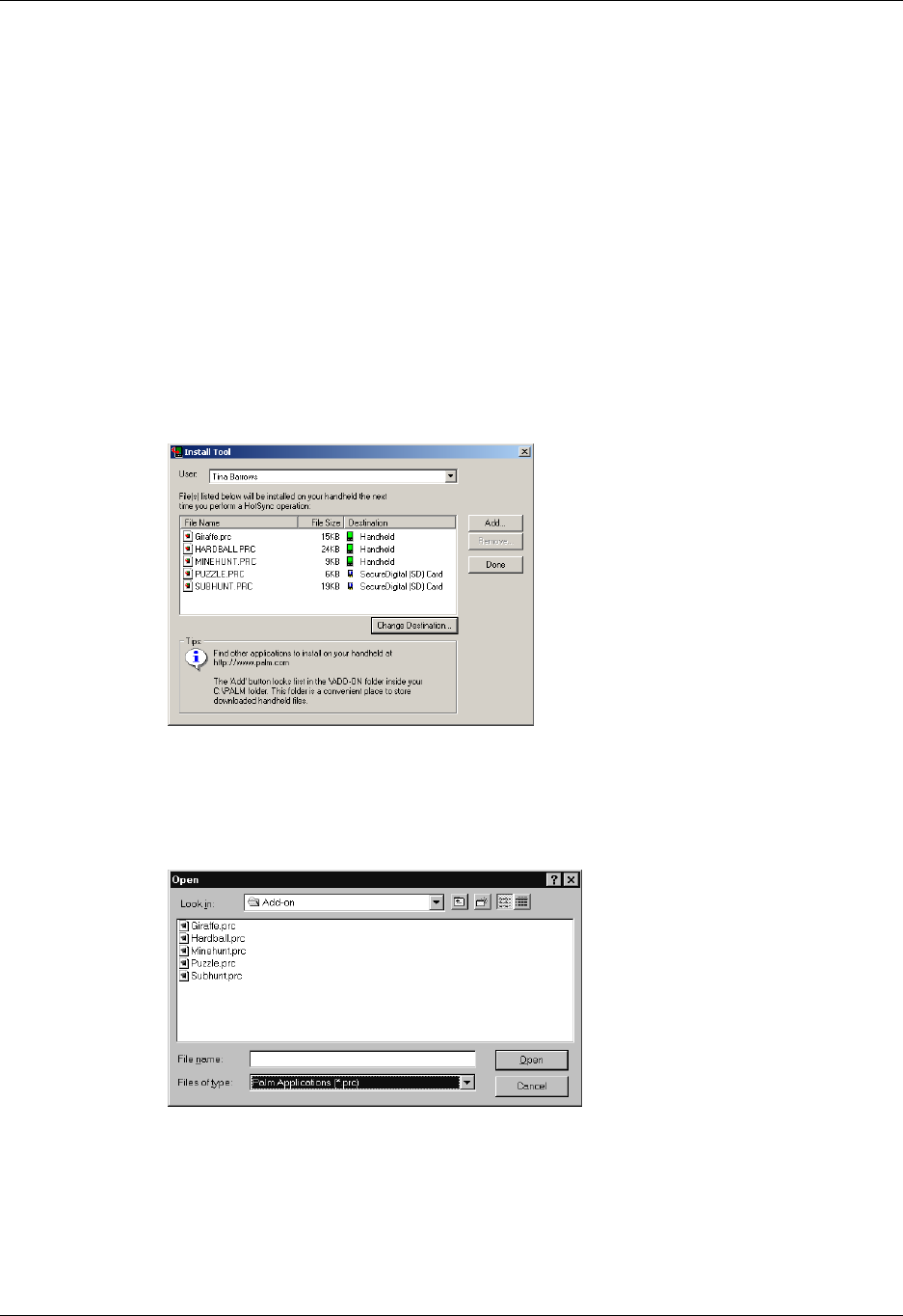
Chapter 5 Working with Applications
68
The Install Tool makes it easy to install software during a HotSync® operation.
There are a variety of third-party applications available for your handheld. To
learn more about these applications, go to the web site: www.palm.com.
To install add-on software on your handheld using a Windows computer:
1. On your computer, copy or download the application you want to install into
the add-on folder in your Palm Desktop directory on your computer.
2. Double-click the Palm Desktop icon on your desktop.
3. Click Install.
TIP You can also access the Install Tool dialog by selecting Install Tool from
the Palm Desktop program group or by double-clicking any file with a PRC,
PDB, PQA, PNC, or SCR file extension.
4. In the User drop-down list, select the name that corresponds to your handheld.
5. Click Add.
6. Select the application(s) that you want to install.
7. Click Open.
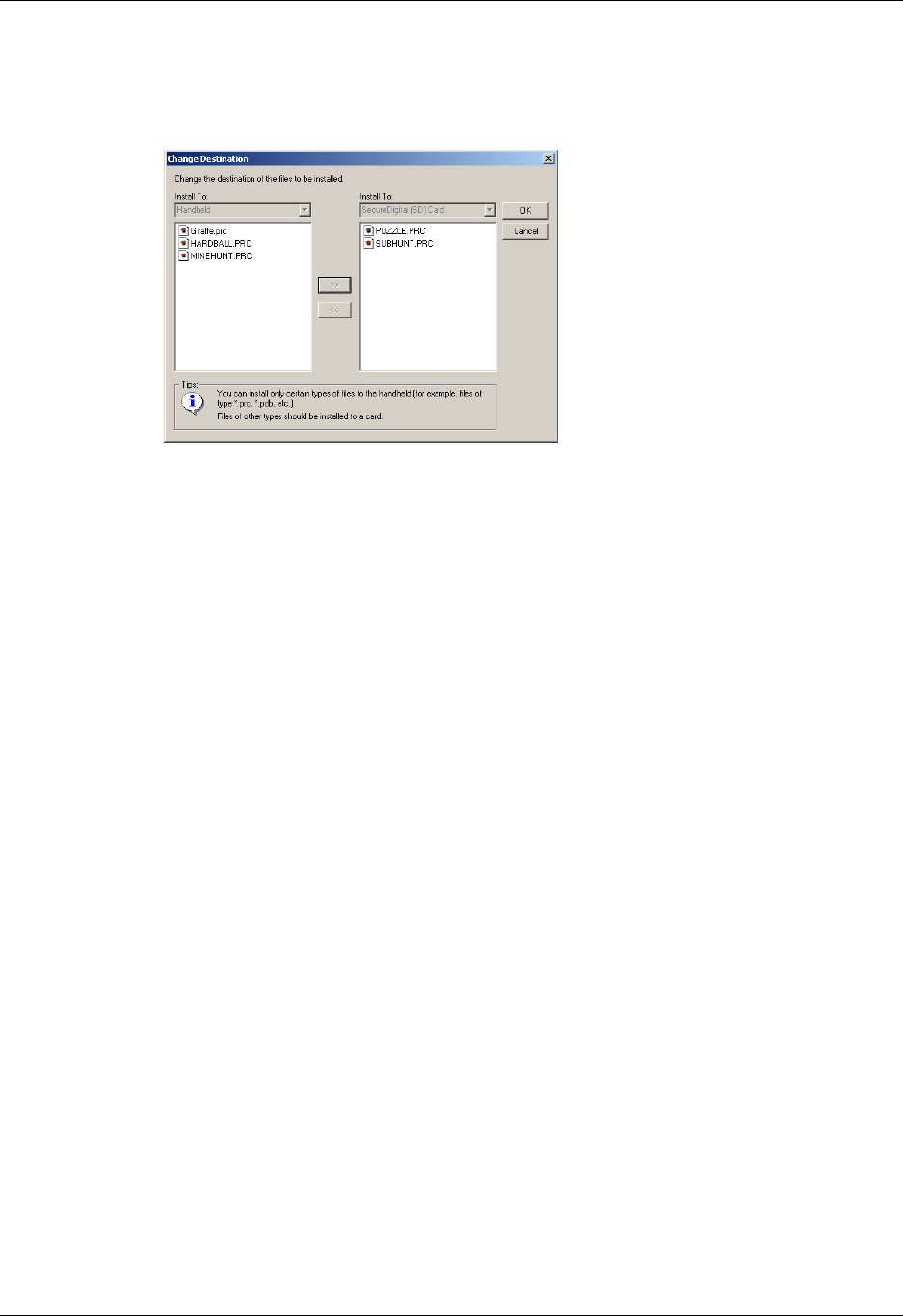
Installing and removing applications
69
8. If you need to change the destination of the application you are installing, click
Change Destination on the Install Tool window, and then use the arrows to
move applications between your handheld and an expansion card.
9. Click OK to close the Change Destination window.
10. Click Done to close the Install Tool window.
11. Perform a HotSync operation to install the selected application(s). See
“Performing Cradle HotSync Operations” in Chapter 16 for details.
NOTE Files that remain in the list after you perform a HotSync operation did
not install. This can happen if the file type was not recognized during the
HotSync operation. Expansion cards may hold applications that use files other
than the Palm™ application files. In order for your handheld to recognize such
a file, you must launch the application that uses these files at least once.
To install add-on software on your handheld using a Macintosh:
1. On your Macintosh, copy or download the application you want to install into
the add-on folder in your Palm folder.
2. Double-click the Hotsync Manager icon in the Palm folder.
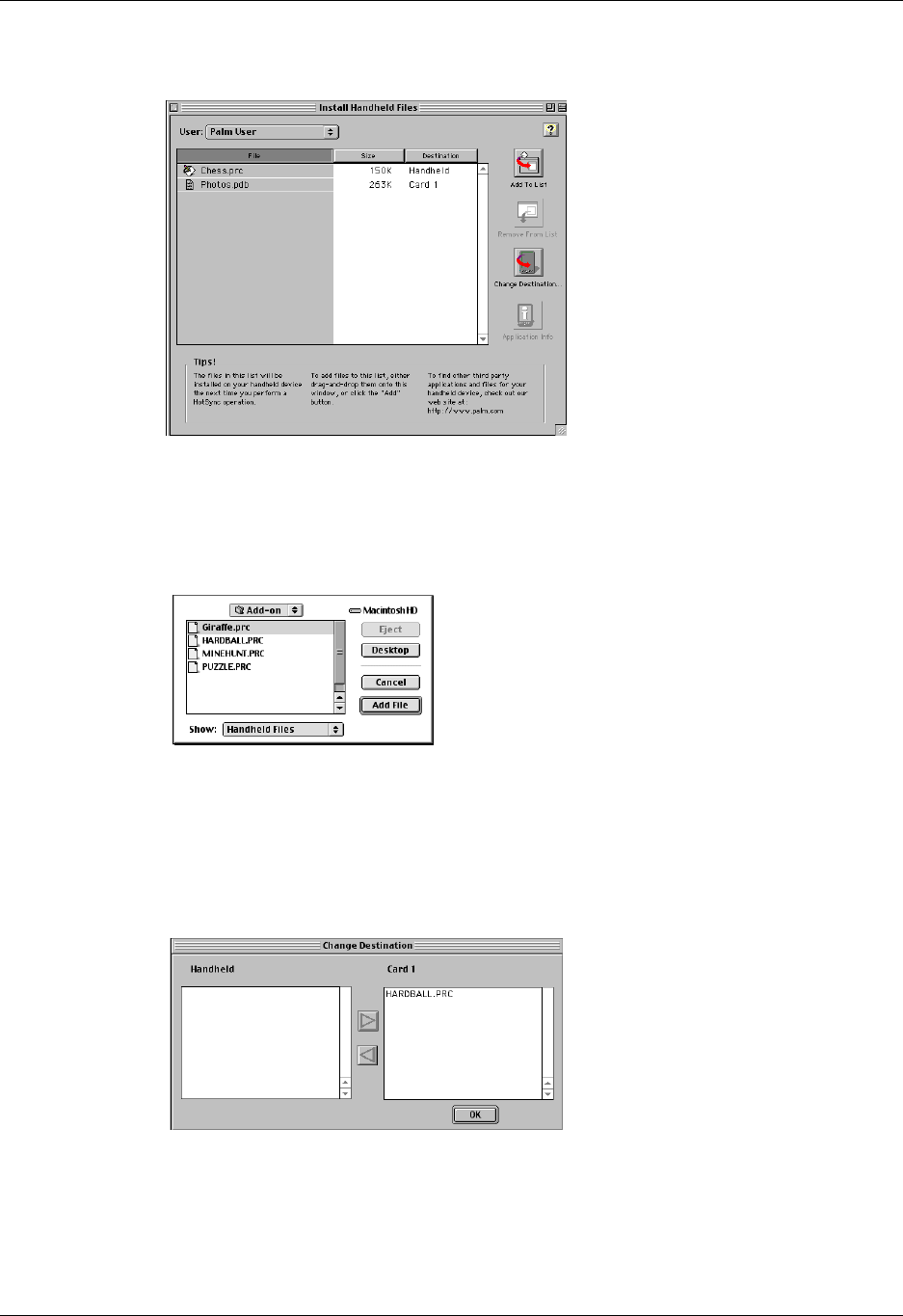
Chapter 5 Working with Applications
70
3. From the HotSync menu, choose Install Handheld Files.
4. From the User pop-up menu, select the name that corresponds to your
handheld.
5. Click Add to List.
6. Select the Add-on folder from the pop-up menu.
7. Select the application(s) you want to install.
8. Click Add File to add the selected application to the Install Handheld Files list.
9. If you need to change the destination of the application you are installing, click
Change Destination on the Install Handheld Files window, and then use the
arrows to move applications between your handheld and an expansion card.
10. Click OK to close the Change Destination window.
11. Close the Install Handheld Files window.
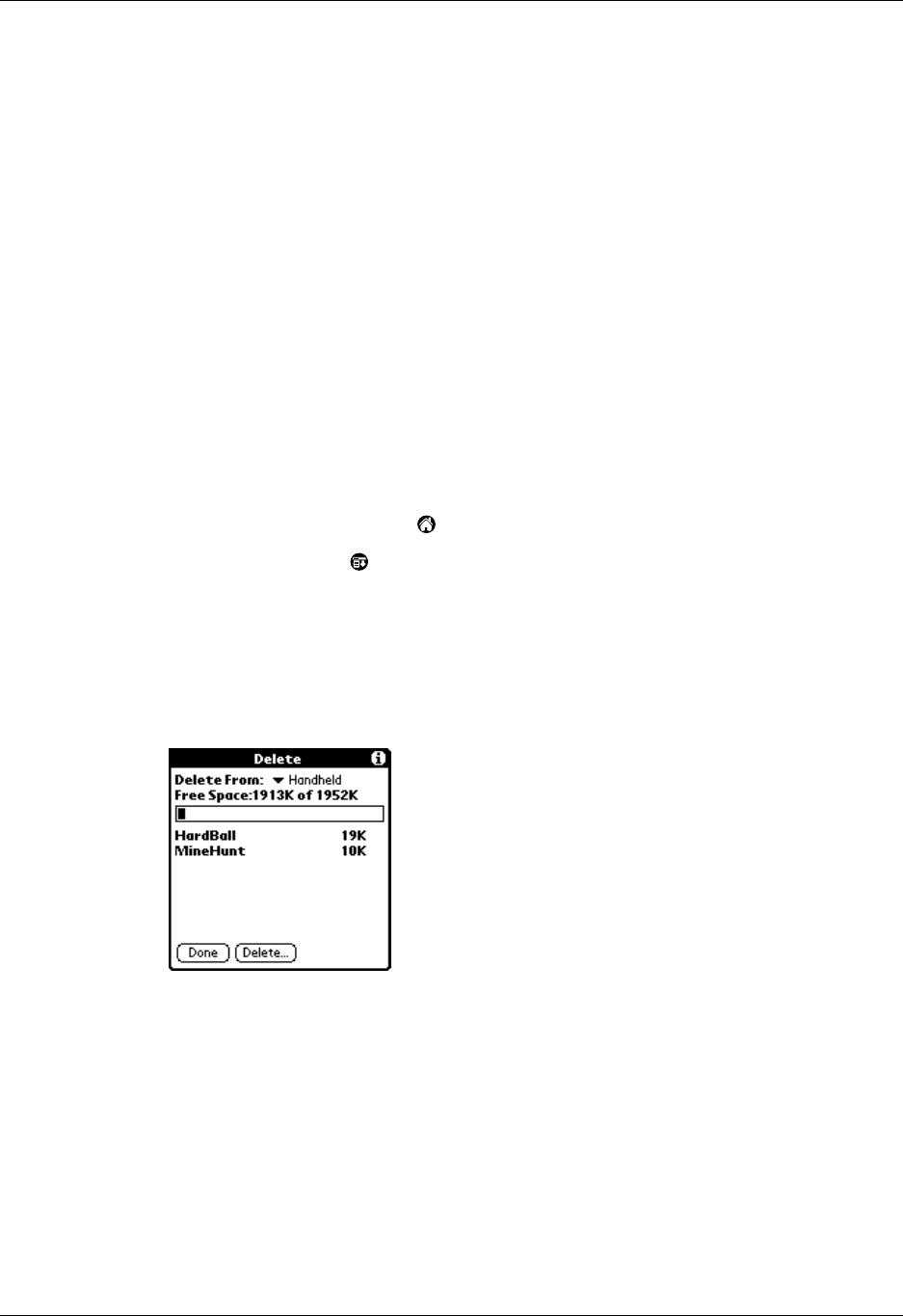
Installing and removing applications
71
12. Perform a HotSync operation to install the selected application(s) on your
handheld. See “Performing Cradle HotSync Operations” in Chapter 16 for
details.
NOTE Files that remain in the list after you perform a HotSync operation did
not install. This can happen if the file type was not recognized during the
HotSync operation. Expansion cards may hold applications that use files other
than the Palm application files. In order for your handheld to recognize such a
file, you must launch the application that uses these files at least once.
Removing applications
In the event that you run out of memory or decide that you no longer need an
application you installed, you can remove applications from your handheld or
from an expansion card. From your handheld, you can remove only add-on
applications, patches, and extensions that you install; you cannot remove the
applications that reside in the ROM portion of your handheld.
To remove an add-on application:
1. Tap the Applications icon .
2. Tap the Menu icon .
3. Tap Delete on the App menu.
4. Tap the Delete From pick list and select either Handheld or Card. To delete
applications from a card, the card must be seated in the expansion card slot.
5. Tap the application that you want to remove.
6. Tap Delete.
7. Tap Yes.
8. Tap Don e.
Removing Palm Desktop software
If you no longer want to use Palm Desktop software, you can remove it from your
computer.

Chapter 5 Working with Applications
72
To remove Palm Desktop software from a Windows computer:
1. From the Windows Start menu, choose Settings, and then Control Panel.
2. Double-click the Add/Remove Programs icon.
3. Click the Change or Remove Programs button.
4. Select Palm Desktop.
5. Click Change/Remove.
6. Click Yes in the Confirm File Deletion box.
7. Click OK.
8. Click Close.
NOTE You need to install the HotSync Manager from the installation CD if you
want to synchronize data with another PIM.
1. To remove Palm Desktop software from a Macintosh:
2. Locate the Palm Desktop Installer icon and double-click this icon.
3. From the Easy Install screen, choose Uninstall from the pop-up menu.
4. Select the software you want to remove.
5. Click Uninstall.
6. Select the folder that contains your Palm Desktop software files.
7. Click Remove.
This process removes only the application files. The data in your Users folder
remains untouched.
8. Restart your Macintosh.
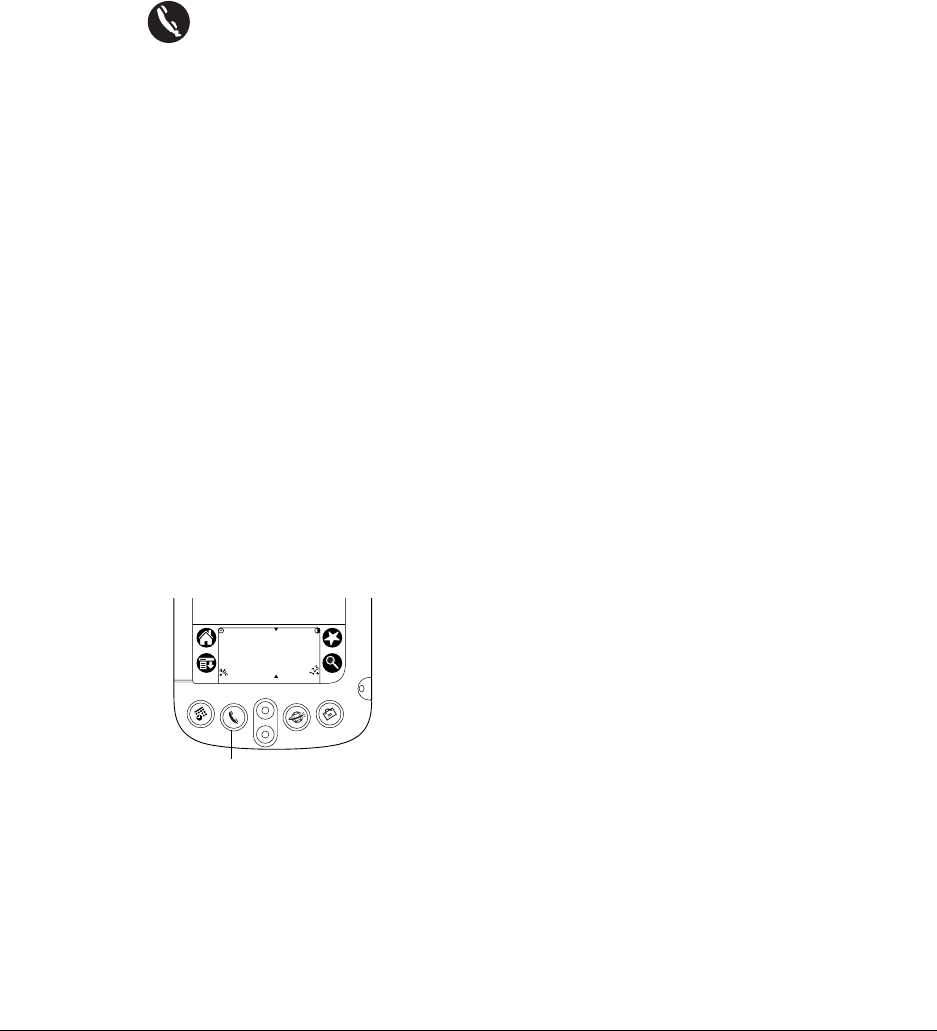
73
CHAPTER 6
Using Address Book
Address Book enables you to keep names, addresses, phone numbers, and
other information about your personal or business contacts. Use Address
Book to do the following:
■Quickly look up or enter names, addresses, phone numbers, and other
information.
■Enter up to five phone numbers (home, work, fax, mobile, etc.) or e-mail
addresses for each name.
■Define which phone number appears in the Address list for each Address Book
entry.
■Attach a note to each Address Book entry, in which you can enter additional
information about the entry.
■Assign Address Book entries to categories so that you can organize and view
them in logical groups.
■Create your own digital business card that you can beam to other Palm OS®
handhelds.
To open Address Book:
■Press the Address Book application button on the front panel of your handheld.
Address Book opens to display the list of all your records.
■Press the Address Book application button repeatedly to cycle through the
categories in which you have records.
■Press and hold the Address Book application button to instantly beam your
business card to another Palm OS® handheld.
Address Book
button
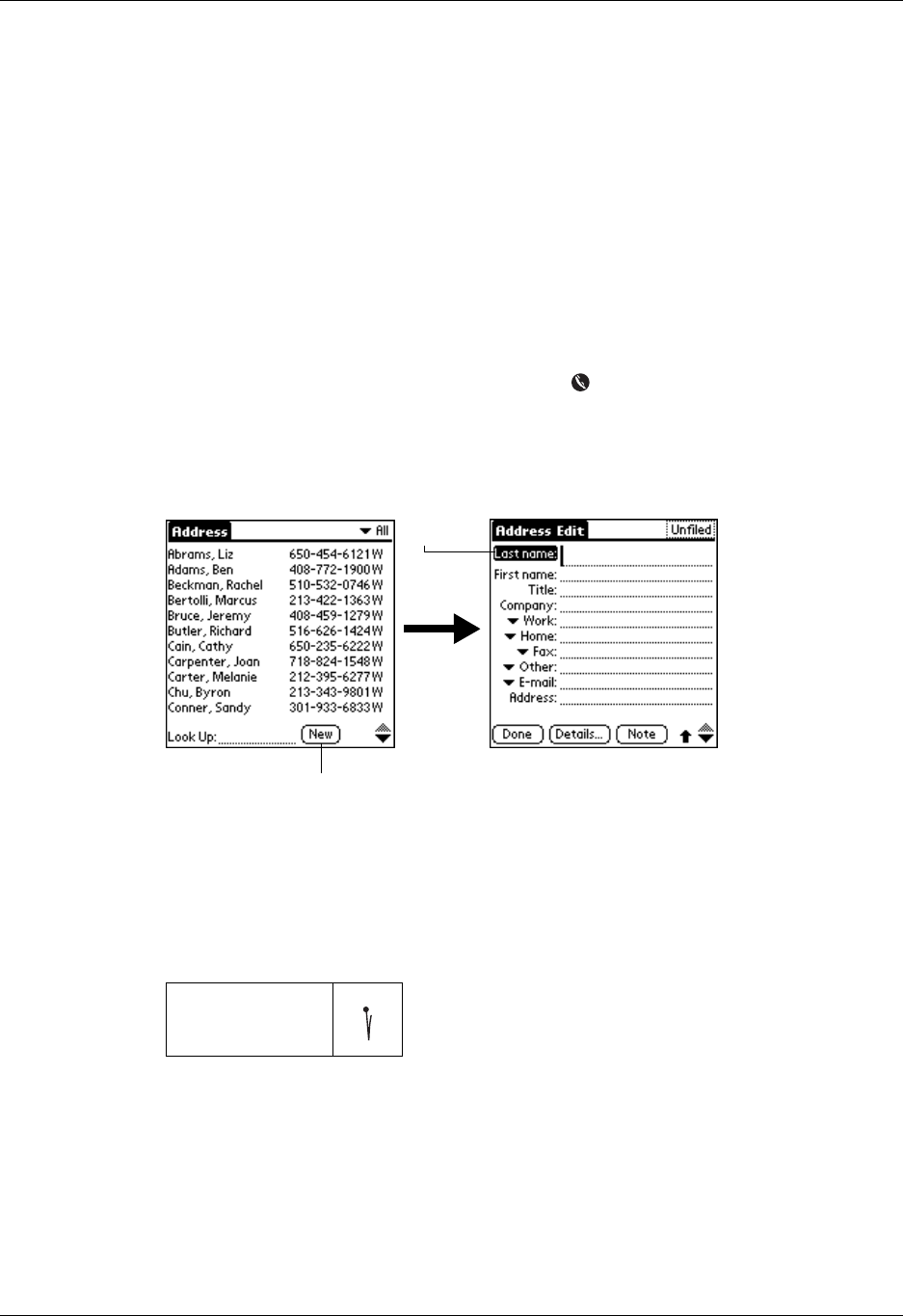
Chapter 6 Using Address Book
74
Creating an Address Book entry
A record in Address Book is called an “entry.” You can create entries on your
handheld, or you can use Palm Desktop software to create entries on your
computer and then download the entries to your handheld with your next
HotSync® operation.
Palm Desktop software also has data import capabilities that enable you to load
database files into Address Book on your handheld.
See “Importing Data” in Chapter 3 and Palm Desktop online Help for more
information.
To create a new Address Book entry:
1. Press the Address Book application button on the front of your handheld to
display the Address list.
2. Tap N ew.
3. Enter the last name of the person you want to add to your Address Book.
The handheld automatically capitalizes the first letter of each field (except
numeric and e-mail fields). You do not have to use the Graffiti capital stroke to
capitalize the first letter of the name.
4. Use the Next Field Graffiti stroke to move to the First Name field.
TIP You can also move to any field by tapping it directly.
5. Enter the person's first name in the First Name field.
6. Enter the other information that you want to include in this entry.
As you enter letters in the Title, Company, City, and State fields, text appears for
the first logical match that exists in your Address Book. As you enter more
Next Field
Tap New
Cursor
at Last
name
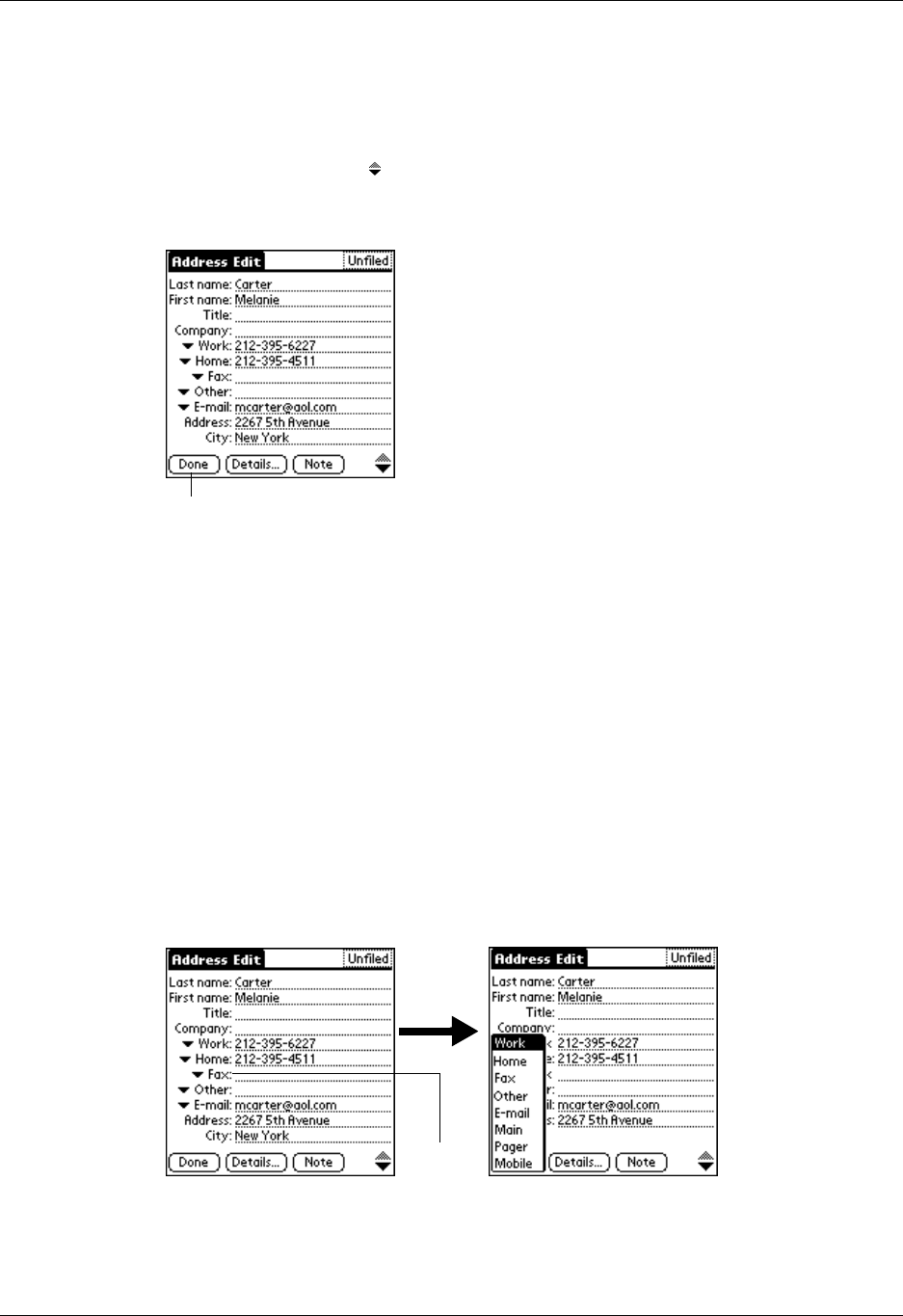
Creating an Address Book entry
75
letters, a closer match appears. For example, you may already have Sacramento
and San Francisco in your Address Book. As you enter “S” Sacramento appears,
and as you continue entering “a” and “n” San Francisco replaces Sacramento.
As soon as the word you want appears, tap in the next field to accept the word.
7. Tap the scroll arrows to move to the next page of information.
8. After you finish entering information, tap Done.
TIP To create an entry that always appears at the top of the Address list, begin the
Last name or Company field with a symbol, as in *If Found Call*. This entry can
contain contact information in case you lose your handheld.
Selecting types of phone numbers
You can select the types of phone numbers or e-mail addresses that you associate
with an Address Book entry. Any changes you make apply only to the current
entry.
To select other types of phone numbers in an entry:
1. Tap the entry that you want to change.
2. Tap Edit.
3. Tap the pick list next to the label you want to change.
4. Select a new label.
Tap Done
Ta p
triangle
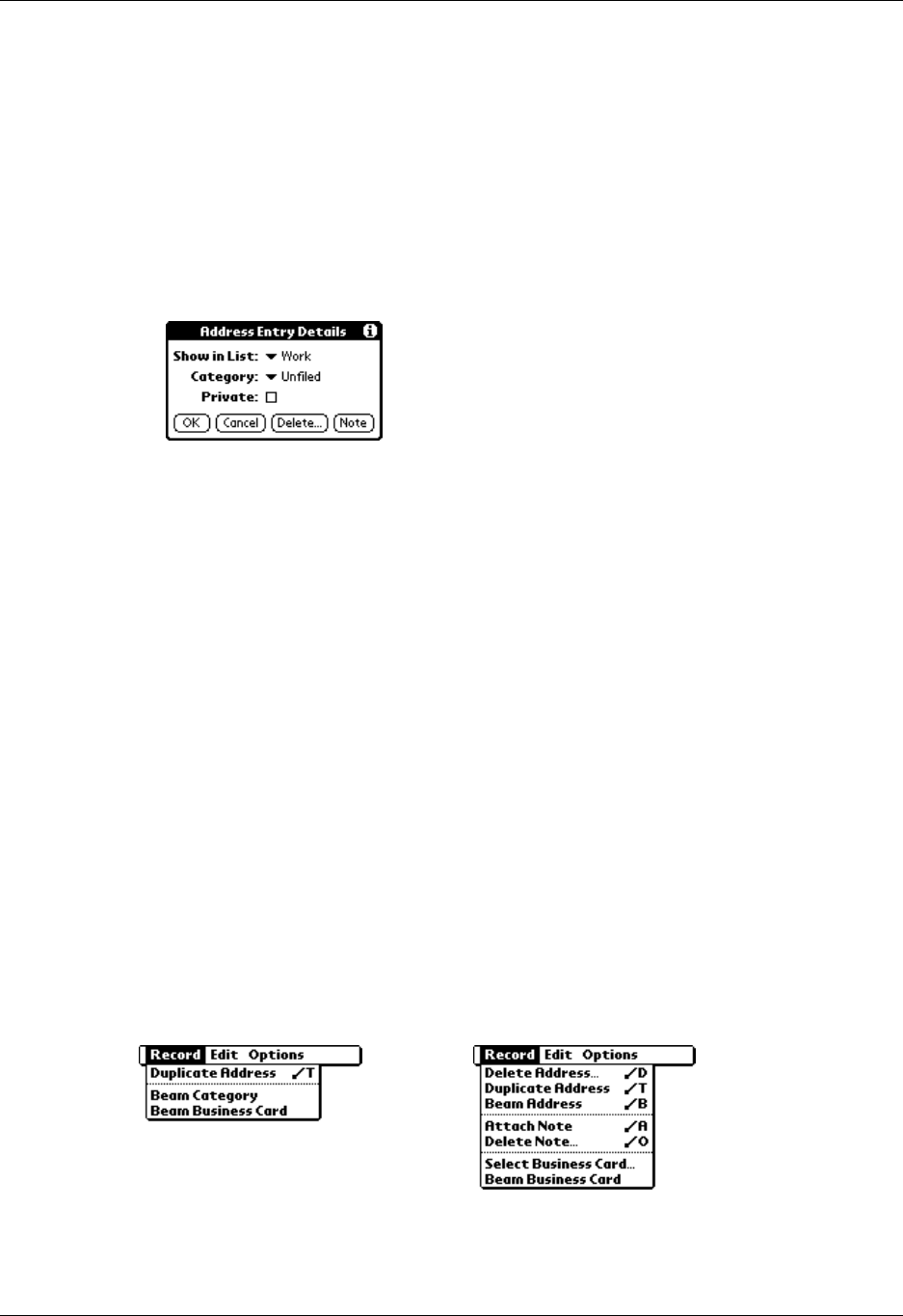
Chapter 6 Using Address Book
76
Changing Address Entry details
The Address Entry Details dialog box provides a variety of options that you can
associate with an entry.
To open the Address Entry Details dialog box:
1. Tap the entry whose details you want to change.
2. Tap Edit.
3. Tap Details.
4. Select any of the following settings:
Address Book menus
Address Book menus are shown here for your reference, and Address Book
features that are not explained elsewhere in this book are described here.
See “Using menus” in Chapter 5 for information about choosing menu commands.
The Record and Options menus differ depending on whether you’re displaying the
Address list screen or the Address view screen.
Record menus
Show in List Select which type of phone or other information appears in the
Address list screen. Your options are Work, Home, Fax, Other,
E-mail, Main, Pager, and Mobile. The identifying letters W, H,
F, O, M, or P appear next to the record in the Address list,
depending on which information is displayed. If you select E-
mail, no identifying letter is displayed.
Category Assign the entry to a category.
Private Hide this entry when Security is turned on.
Address list
Address view
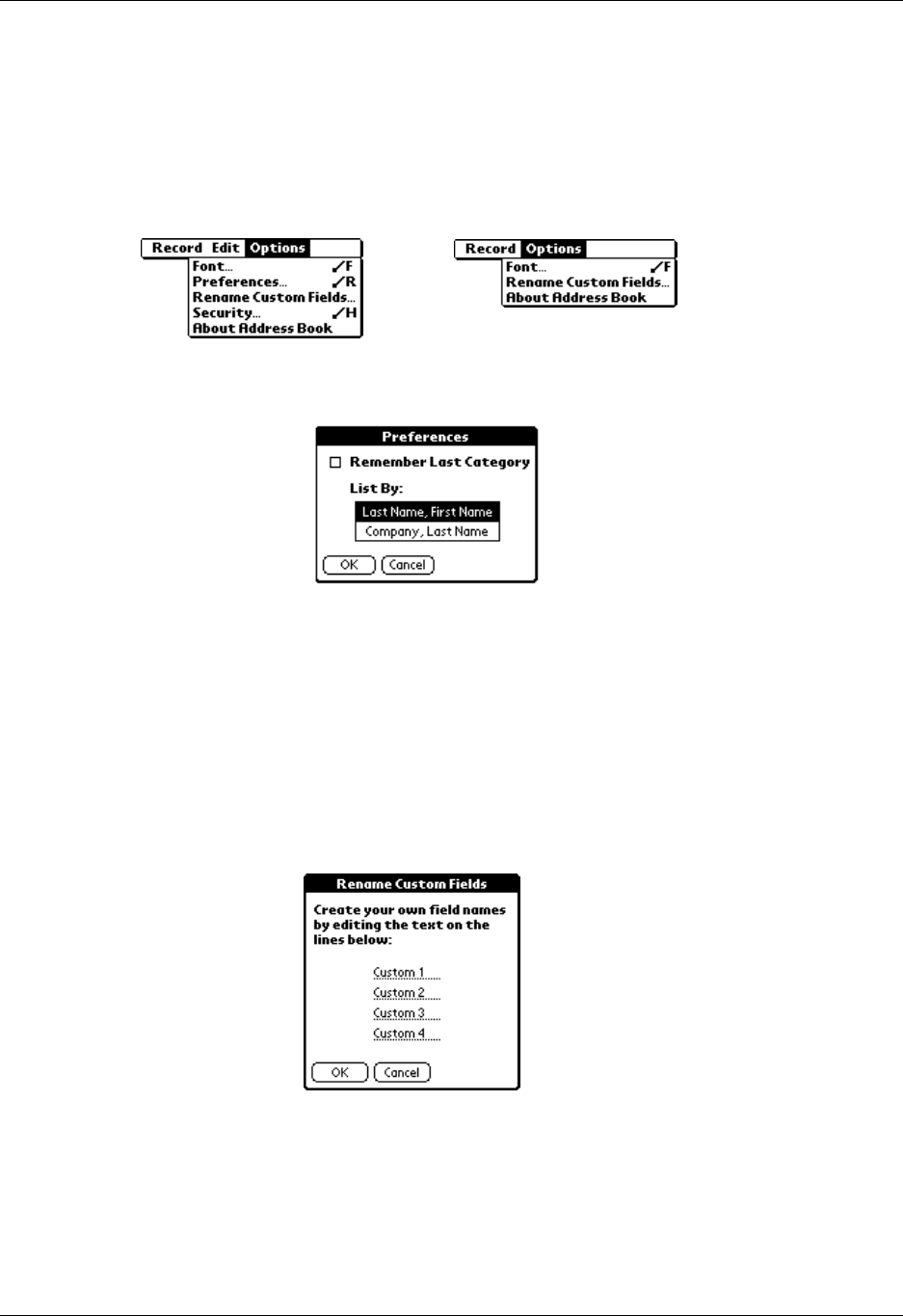
Creating an Address Book entry
77
Options menus
Duplicate
Address
Makes a copy of the current record and displays the copy in
Address Edit so you can make changes to the copied record.
The copy has the same category and attached notes as the
original record.
Preferences
Remember last category. Determines how Address Book
appears when you return to it from another application. If
you select this check box, Address Book shows the last
category you selected. If you clear it, Address Book displays
the All category.
Rename Custom
Fields These custom fields appear at the end of the Address Edit
screen. Rename them to identify the kind of information you
enter in them. The names you give the custom fields appear
in all entries.
About Address
Book Shows version information for Address Book.
Address list
Address view

Chapter 6 Using Address Book
78
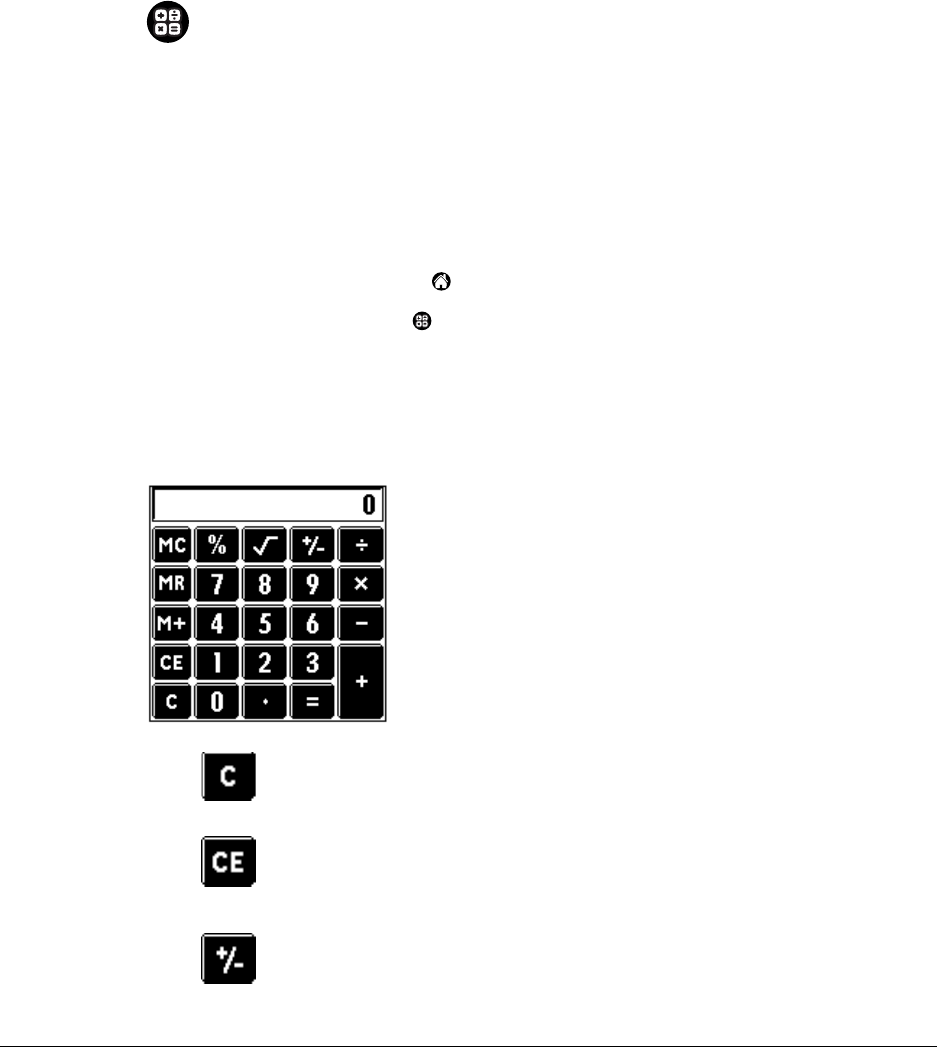
79
CHAPTER 7
Using Calculator
Calculator enables you to perform basic calculations. Use Calculator to do
the following:
■Perform addition, subtraction, multiplication, division, and square root
operations.
■Store and retrieve values.
■Display the last series of calculations, which is useful for confirming a series of
“chain” calculations.
To open Calculator:
1. Tap the Applications icon .
2. Tap the Calculator icon .
Performing Calculations
The Calculator includes several buttons to help you perform calculations.
Clears the entire calculation and enables you to begin a fresh
calculation.
Clears the last number you entered. Use this button if you make
a mistake while entering a number in the middle of a calculation.
This button enables you to re-enter the number without starting
the calculation over.
Toggles the current number between a negative and positive
value. If you want to enter a negative number, enter the number
first and then press the +/- button.
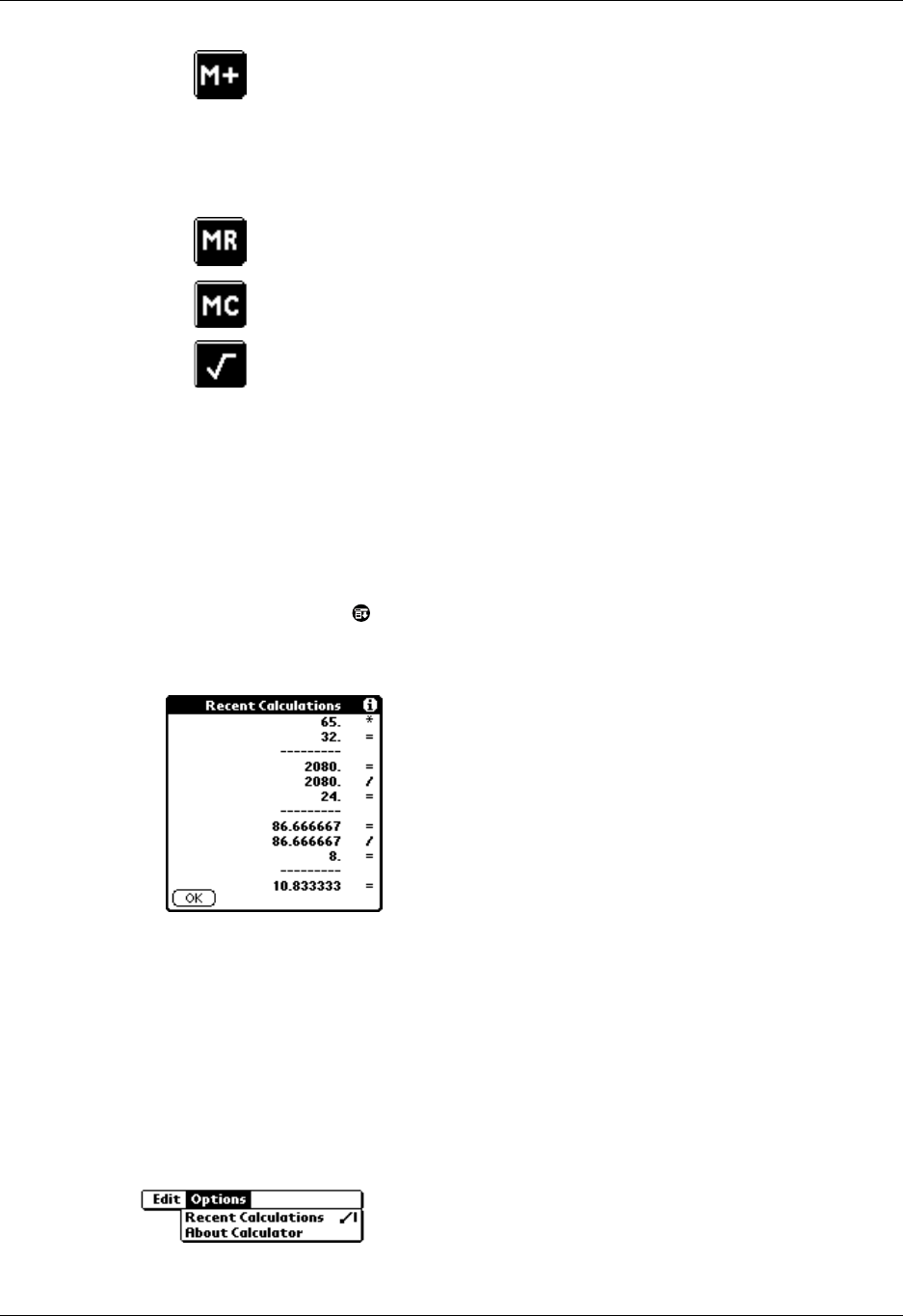
Using Calculator
80
Recent Calculations
The Recent Calculations command enables you to review the last series of
calculations and is particularly useful for confirming a series of “chain”
calculations.
To display recent calculations:
1. Tap the Menu icon .
2. Tap Options, and then tap Recent Calculations.
3. After you finish reviewing the calculations, tap OK.
Calculator menus
Calculator menus are shown here for your reference, and Calculator features that
are not explained elsewhere in this book are described here.
See “Using menus” in Chapter 5 for information about choosing menu commands.
Options menus
Places the current number in memory. Each
new number you enter with the M+ button is
added to the total already stored in memory. The number that you
add can be either a calculated value or any number you enter by
pressing the number buttons. Pressing this button has no
effect on the current calculation (or series of calculations); it
merely places the value into memory until it is recalled.
Recalls the stored value from memory and inserts it in the current
calculation.
Clears any value that is stored in the Calculator memory.
Calculates the square root of a number. Enter the number, then
tap the square root button.

Performing Calculations
81
About Calculator Shows version information for Calculator.

Using Calculator
82
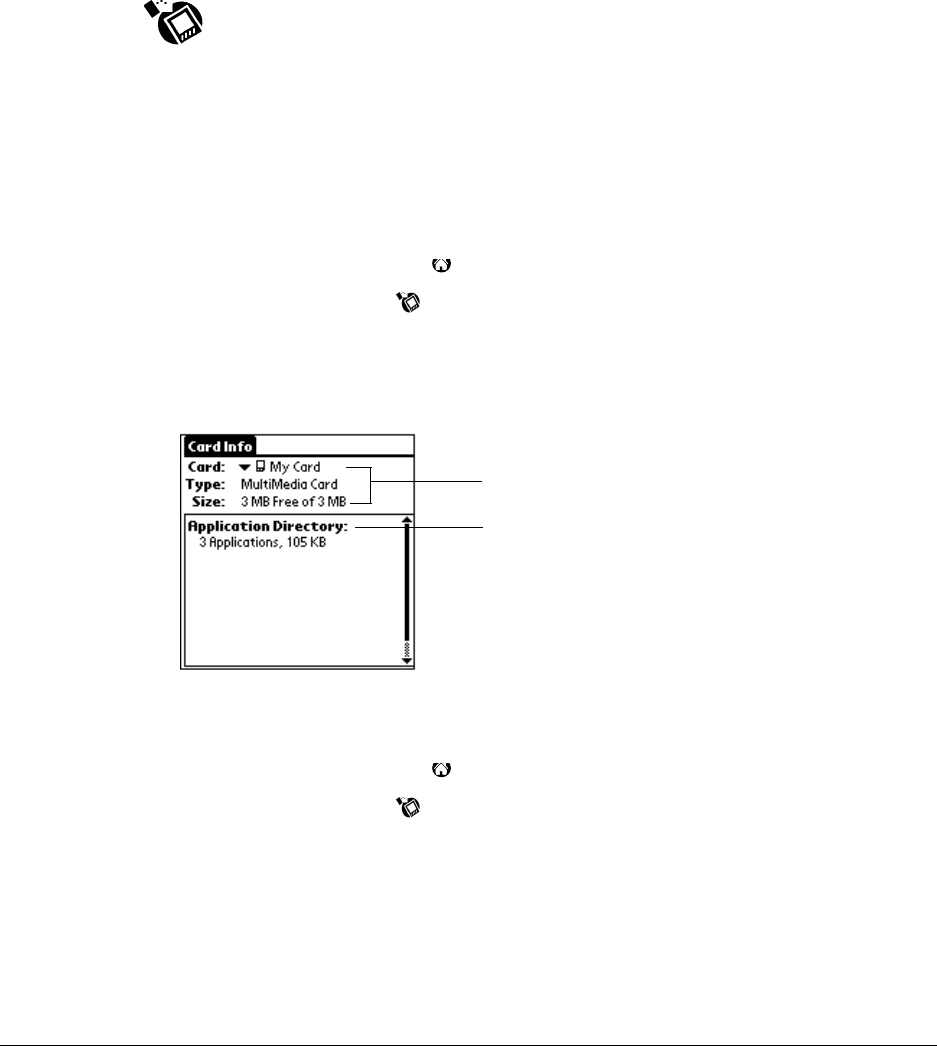
83
CHAPTER 8
Using Card Info
Card Info lets you review general information about an expansion card.
Use Card Info to do the following:
■Review card contents.
■Rename a card.
■Format a card.
Reviewing Card Information
1. Tap the Applications icon .
2. Tap the Card Info icon .
3. Review Card name, Type, and Size.
4. Review card contents summarized by directory.
Renaming a Card
1. Tap the Applications icon .
2. Tap the Card Info icon .
3. Tap the Menu icon.
4. Tap Card, and then tap Rename Card.
5. Enter the new name for the card.
Review card information
Review summarized
card contents
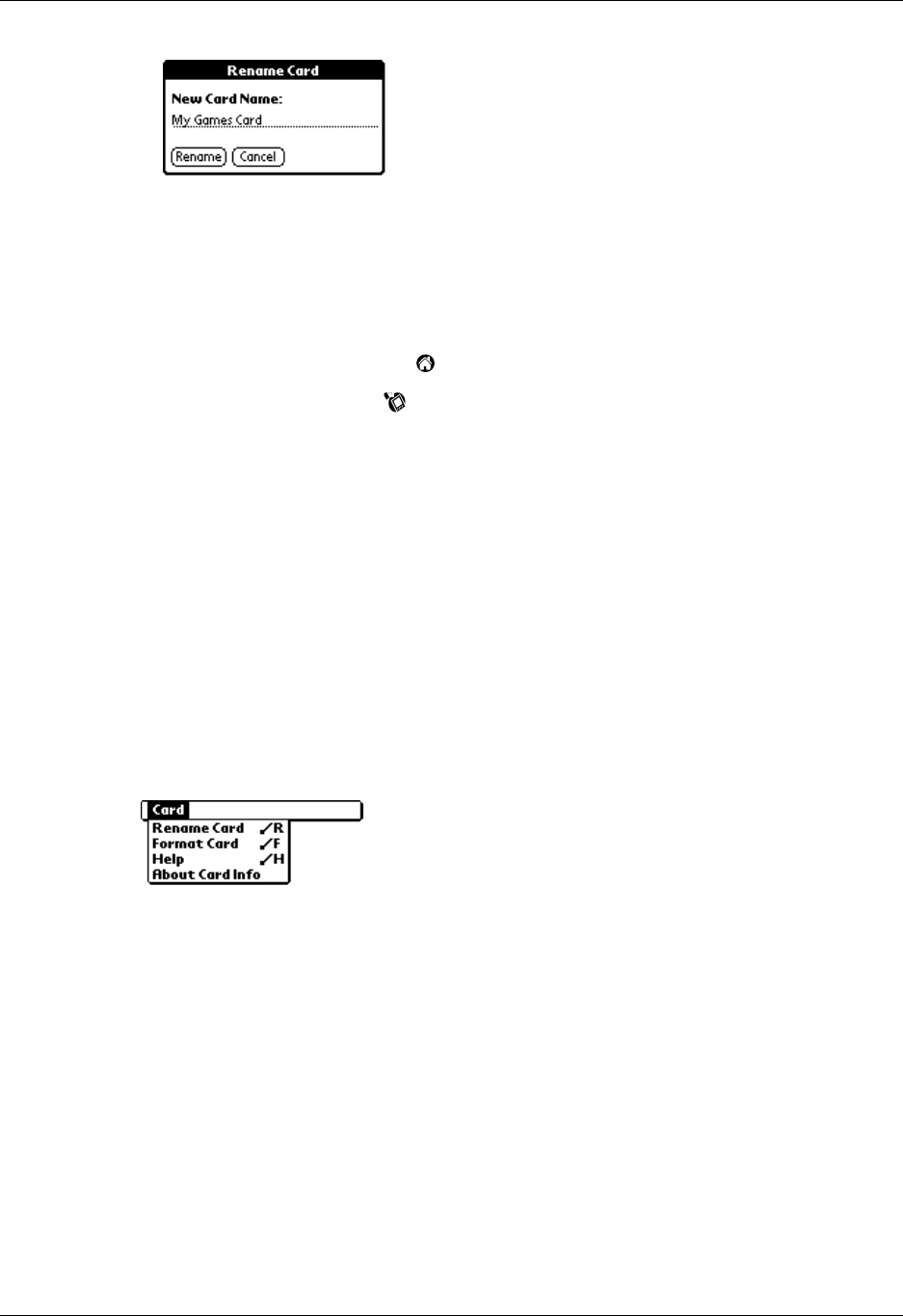
Using Card Info
84
6. Tap Rena me.
Formatting a Card
Formatting a card destroys all its data and prepares it to accept new applications
and data.
1. Tap the Applications icon .
2. Tap the Card Info icon .
3. Tap the Menu icon.
4. Tap Card, and then tap Format Card.
5. Tap OK.
Card Info Menus
Card Info menus are shown here for your reference, and Card Info features that are
not explained elsewhere in this book are described here.
See “Using menus” in Chapter 5 for information about choosing menu commands.
Card menus
Help Provides help text.
About Card Info Shows version information for Card Info.

85
CHAPTER 9
Using Clock
Clock enables you to view the current time and date and to set an alarm. Use Clock
to do the following:
■View the current time and date.
■Open a preferences screen where you can set the time and date for all the
applications on your handheld.
■Set an alarm.
To open Clock:
1. Tap the Applications icon .
2. Tap the Clock icon .
TIP You can also tap the clock icon in the upper-left corner of the Graffiti
writing area to open clock.
Viewing the Time
Clock makes it easy for you to check the time and date, and provides a convenient
travel alarm feature. See “Date and Time preferences” in Chapter 17 for details on
setting the current date and time for all the applications on your handheld.
In addition to setting the date and time, you can set an alarm to sound during the
next 24-hour period.
To view the time:
Do one of the following:
■When your handheld is on, tap the Clock icon in the upper left corner of the
Graffiti writing area.
■Tap the Applications icon , and then tap the Clock icon .
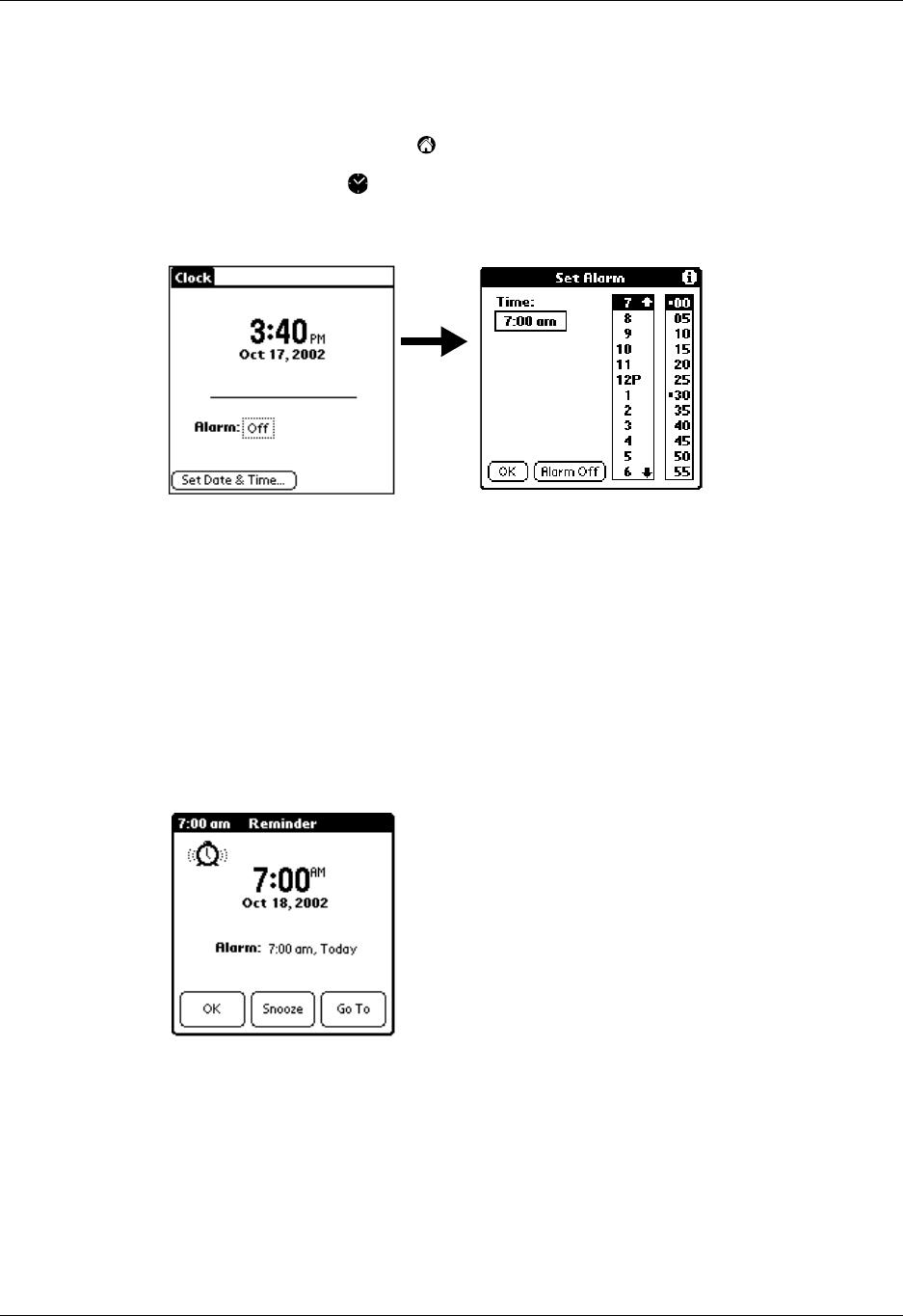
Using Clock
86
Setting an Alarm
To set an alarm:
1. Tap the Applications icon .
2. Tap the Clock icon .
3. Tap the Alarm box to open the Set Alarm dialog box.
4. Tap the time columns to set the hour and minute.
5. When the alarm reminder message appears, do one of the following:
Tap OK to permanently dismiss the reminder and return to the current screen.
Tap Snooze to dismiss the reminder and return to the current screen. The
reminder message appears again in five minutes, and an attention indicator
blinks in the upper-left corner of the screen to remind you of the pending alarm.
When the reminder message reappears, the current time displays in the
Reminder bar and the alarm time displays on the screen.
6. Tap Go To to open Clock.
Clock Menus
Clock menus are shown here for your reference, and Clock features that are not
explained elsewhere in this book are described here.
See “Using menus” in Chapter 5 for information about choosing menu commands.

Clock Menus
87
Options menu
Display Options Allows you to choose which information appears on the Clock
screen.
Day. Activates the day of the week display. When it is on, the day
appears above the time.
Date. Activates the date display. When it is on, the date appears
below the time.
Alarm
Preferences
Sound. Sets the sound of the alarm. The choices are Alarm,
Bumble Bee, Reveille, Sonata, Wake Up, and Warbler.
Volume. Defines how loud the alarm sounds. The choices are Low,
Medium, and High.
About Clock Shows version information for Clock.

Using Clock
88
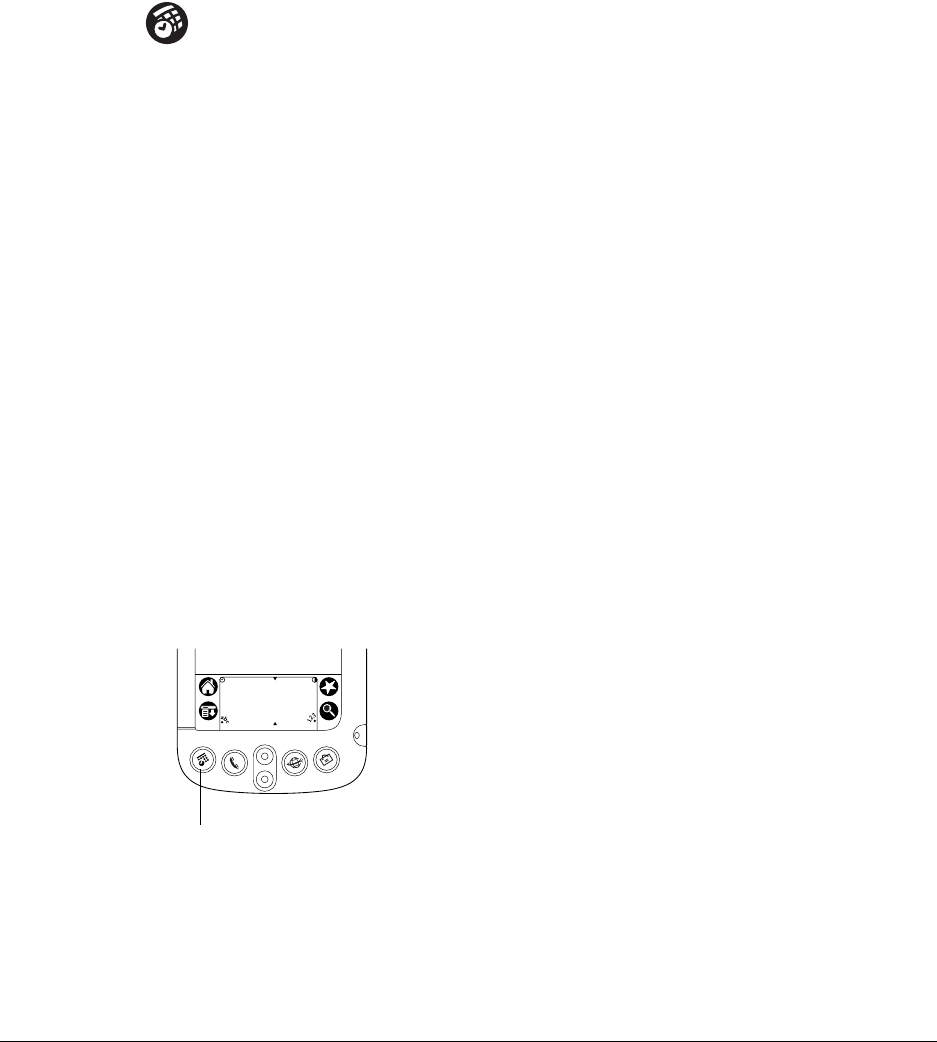
89
CHAPTER 10
Using Date Book
Date Book lets you quickly and easily schedule appointments or any kind of
activity associated with a time and date. Use Date Book to do the following:
■Enter a description of your appointment and assign it to a specific time and
date.
■Display a chart of your appointments for an entire week. The Week View makes
it easy to spot available times and any potential scheduling overlaps or
conflicts.
■Display a monthly calendar to quickly spot days where you have morning,
lunch, or afternoon appointments.
■Display an agenda showing appointments, untimed events, and your To Do
items for the day.
■Set an alarm to notify you of the scheduled activity.
■Create reminders for events that are based on a particular date, rather than time
of day. Birthdays and anniversaries are easy to track with your handheld.
■Attach notes to individual events for a description or clarification of the entry
in your Date Book.
To open Date Book:
■Press the Date Book application button on the front panel of your handheld.
Date Book opens to today’s schedule.
TIP Press the Date Book application button repeatedly to cycle through the
Day, Week, Month and Agenda views.
Date Book button
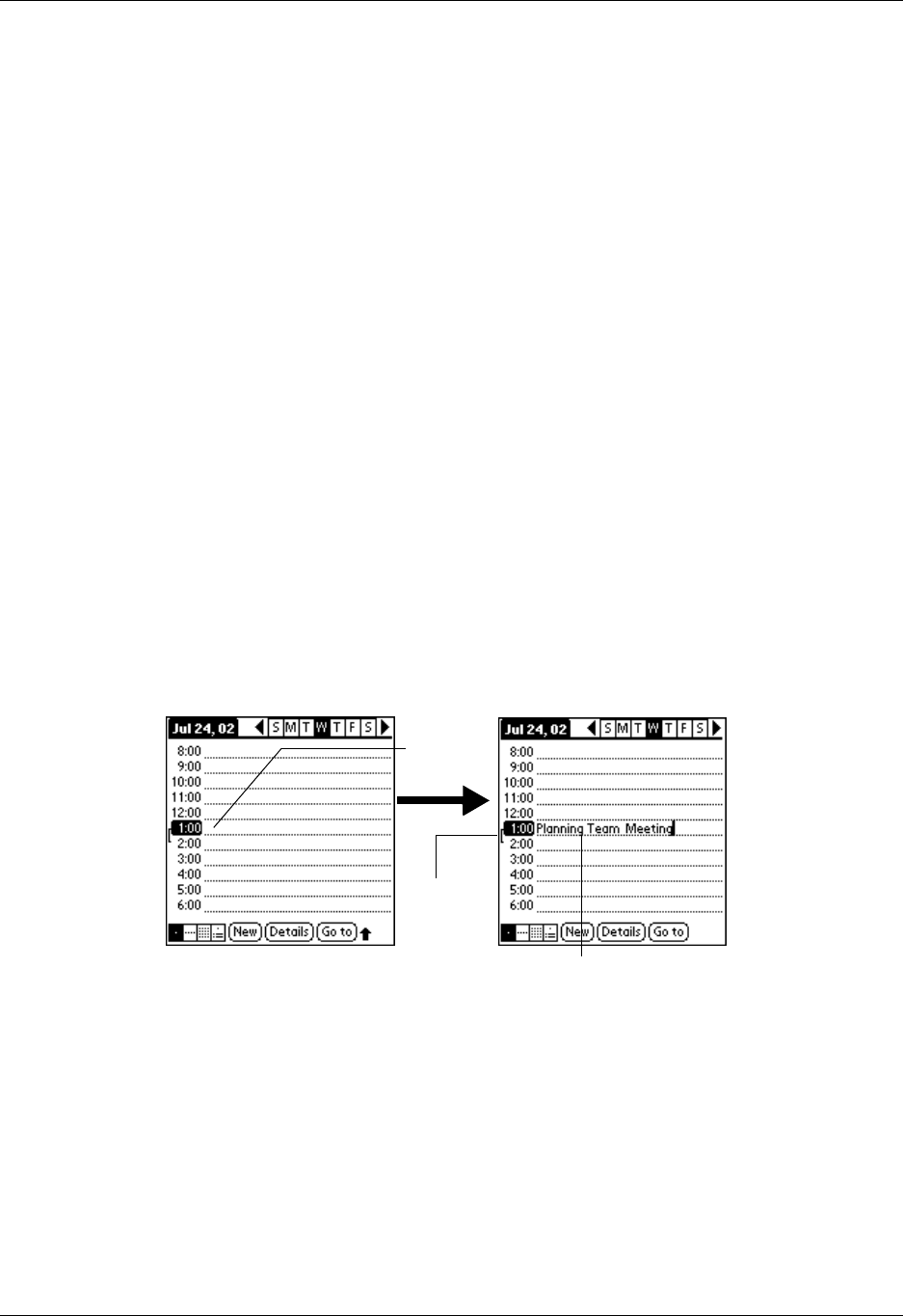
Using Date Book
90
When you open Date Book, the screen shows the current date and a list of times for
a normal business day.
Scheduling An Event
A record in Date Book is called an “event.” An event can be any kind of activity
that you associate with a day. You can enter a new event on any of the available
time lines.
When you schedule an event, its description appears on the time line, and its
duration is automatically set to one hour. You can easily change the start time and
duration for any event.
It’s possible to schedule events that overlap, but Date Book makes it easy to find
such conflicts. See“Spotting event conflicts” later in this chapter.
You can also schedule events in your Date Book that occur on a particular date but
have no specific start or end times, such as birthdays, holidays, and anniversaries.
These are referred to as “untimed events.” Untimed events appear at the top of the
list of times, marked with a diamond. You can have more than one untimed event
on a particular date.
You can also schedule a repeating event, such as a weekly meeting, and continuous
events, such as a three-day conference or a vacation.
To schedule an event for the current day:
1. Tap the time line that corresponds to the beginning of the event.
2. Enter a description of the event. You can enter up to 255 characters.
3. If the event is one hour long, skip to step 5. If the event is longer or shorter than
an hour, tap the time of the event to open the Set Time dialog box.
Ta p a
time line
Enter event
Time bar
shows
duration
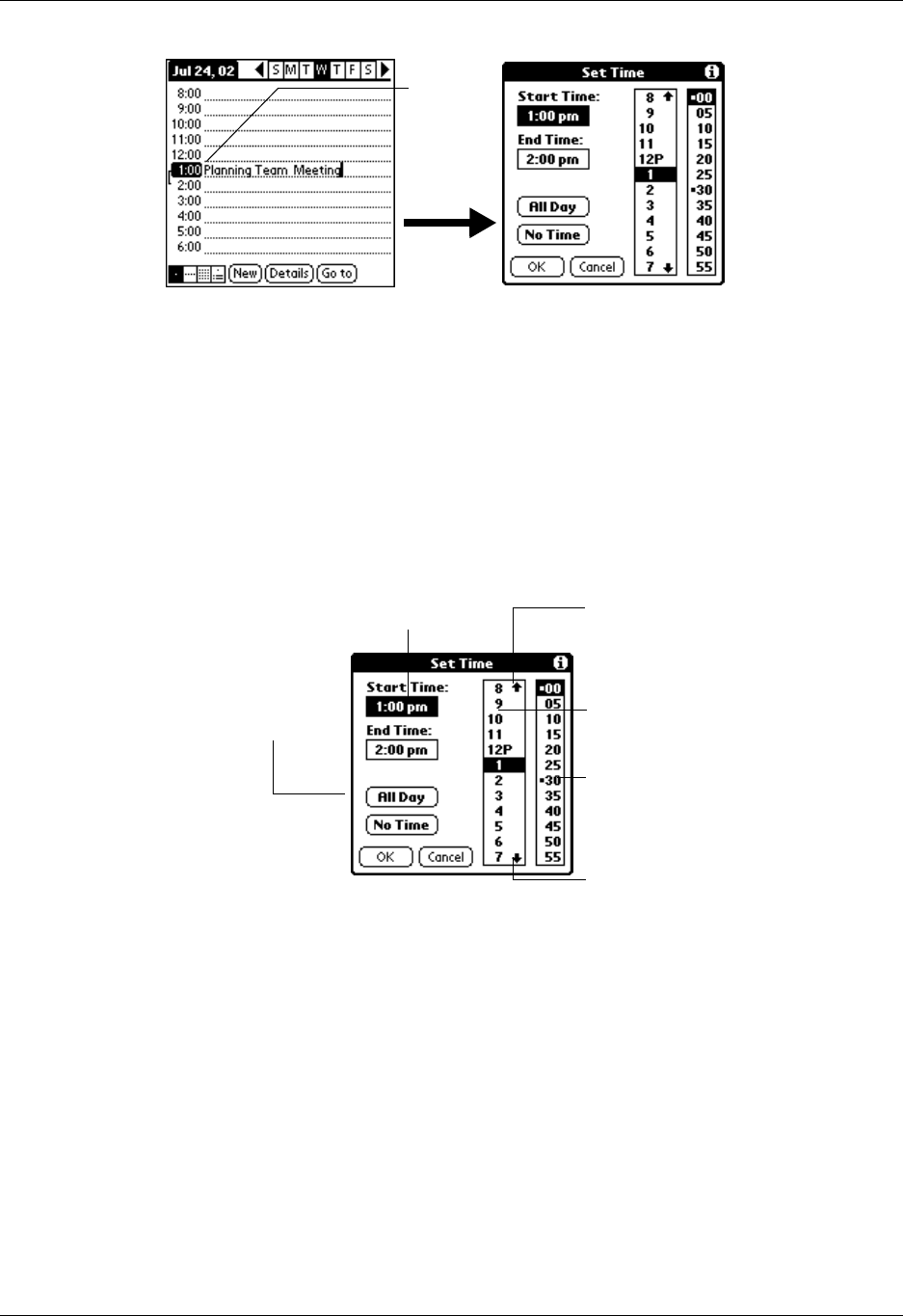
Scheduling An Event
91
TIP You can also open the Set Time dialog (to select a start time) by making
sure no event is selected, and then writing a number on the number side of the
Graffiti writing area.
4. Do one of the following:
Tap the time columns on the right side of the Set Time dialog to set the Start
Time, then tap the End Time box and tap the time columns to set the End Time.
Tap All Day to automatically insert the start and end time of the event as
defined in your Date Book preferences.
5. Tap OK.
6. Tap a blank area of the screen to deselect the event. A vertical line appears next
to the time, indicating the duration of the event.
If an event has the same start and end time, the time is only displayed once.
To schedule an event for another day:
1. Select the date you want for the event by doing one of the following:
– Tap the day of the week that you want in the date bar at the top of the screen.
If necessary, tap the Previous week or Next week scroll arrows to move to
another week.
Tap t h e
time of an
event
Start Time
highlighted
Tap to scroll to
earlier hours
Tap to scroll to
later hours
Tap to change
hours
Tap to change
minutes
Tap to automatically
fill the start and end
times
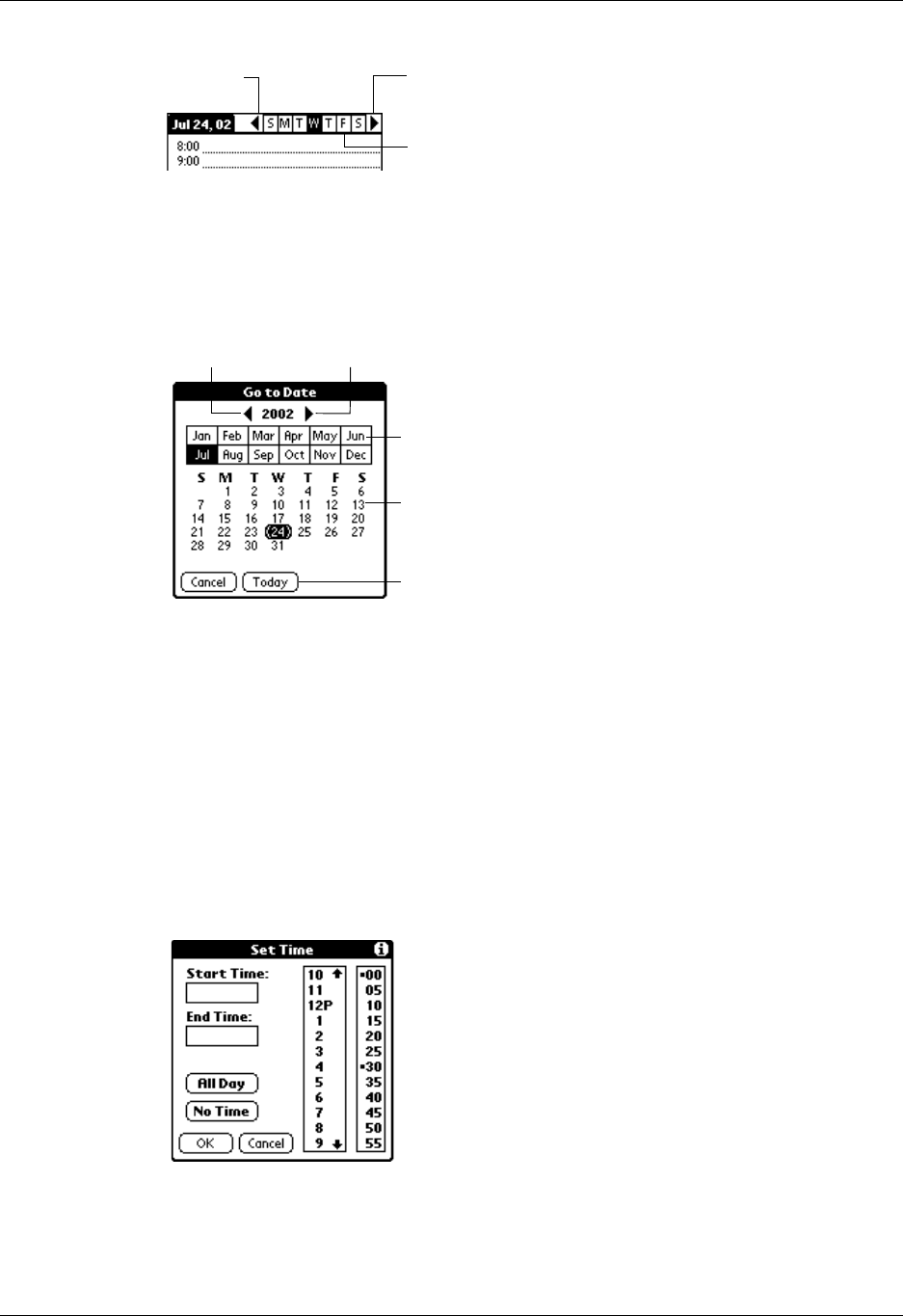
Using Date Book
92
TIP You can also use the scroll button on the front panel of your handheld to
move forward or backward one day at a time.
– Tap Go To at the bottom of the screen to open the Go to Date dialog box.
Select a date by tapping a year, month, and day in the calendar.
TIP In the Go to Date dialog box, you can also use the scroll button on the front
panel of the handheld to move forward or backward one month at a time.
2. After you locate the date, follow the steps for scheduling an event for the
current day.
To schedule an untimed event:
1. Select the date that you want for the event.
2. Tap N ew.
3. Tap No Time, so that no start or end times are defined for the new event.
TIP You can also create a new untimed event by making sure no event is
selected and then writing letters in the Graffiti writing area.
Previous
week
Next
week
Tap to select a day of
the current week
Previous year Next year
Tap to select
Tap to select a
month
Tap to select a
day
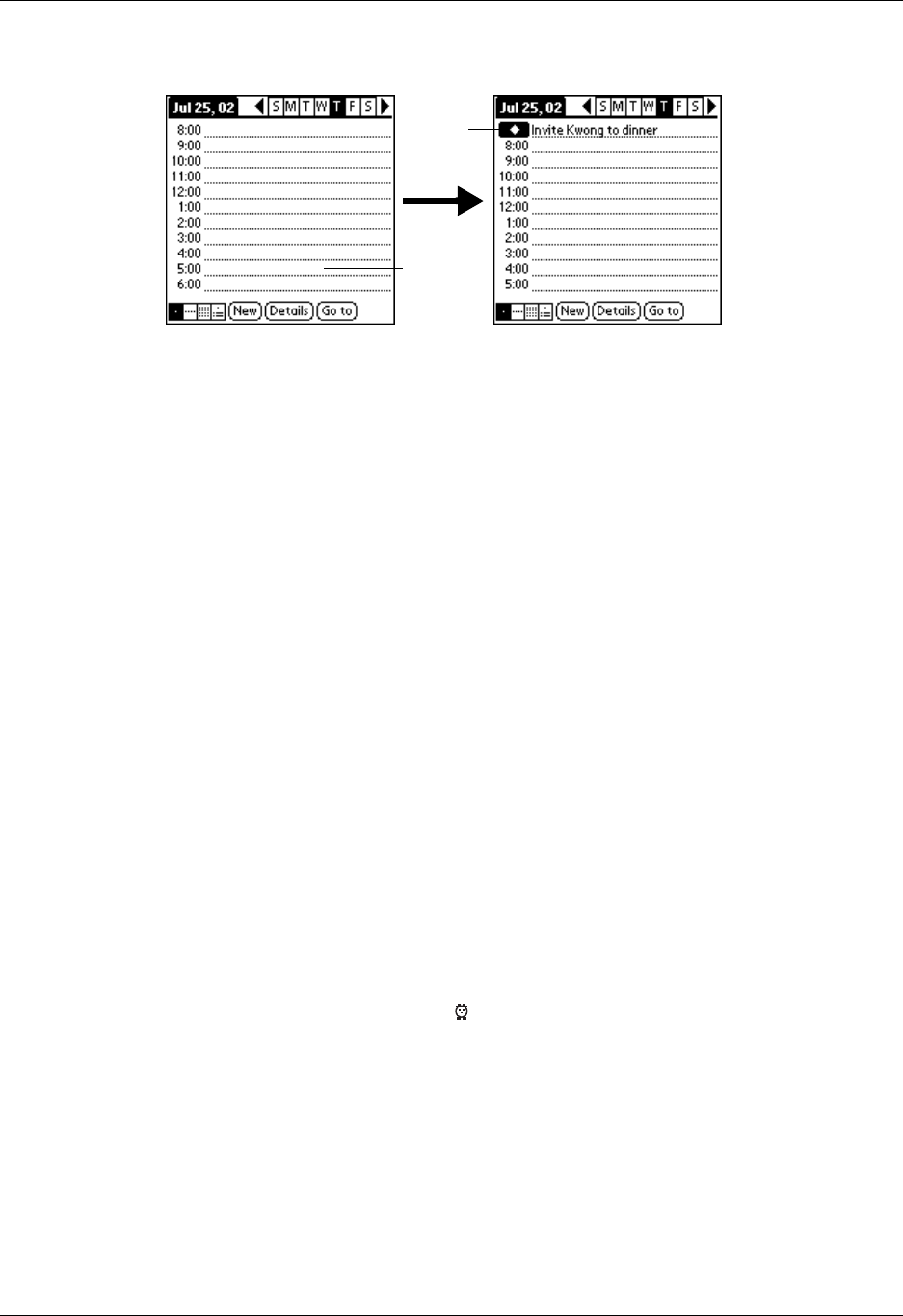
Rescheduling An Event
93
4. Enter a description of the event.
5. Tap a blank area on the screen to deselect the untimed event.
If you create an event and decide later that there is no particular start or end
time, you can easily change it to an untimed event. Tap the time of the event in
the Date Book screen, tap No Time, and then tap OK.
Rescheduling An Event
You can easily make changes to your schedule with your handheld.
To reschedule an event:
1. Tap the event you want to reschedule.
2. Tap Details.
3. To change the time, tap the Time box and select a new time.
4. To change the date, tap the Date box and select a new date.
5. Tap OK.
Setting An Alarm for an Event
The Alarm setting enables you to set an alarm for events in your Date Book. You
can set an alarm to notify you minutes, hours, or days before an event. The default
Alarm setting is 5 minutes before the time of the event, but you can change this to
any number of minutes, hours, or days.
When you set an alarm, this icon appears to the far right of the event with the
alarm. When the alarm occurs, a reminder message also appears onscreen.
To set an alarm for an event:
1. Tap the event to which you want to assign an alarm.
2. Tap Details.
3. Tap the Alarm check box to select it.
The default setting, 5 Minutes, appears.
No time
selected
New
untimed
event
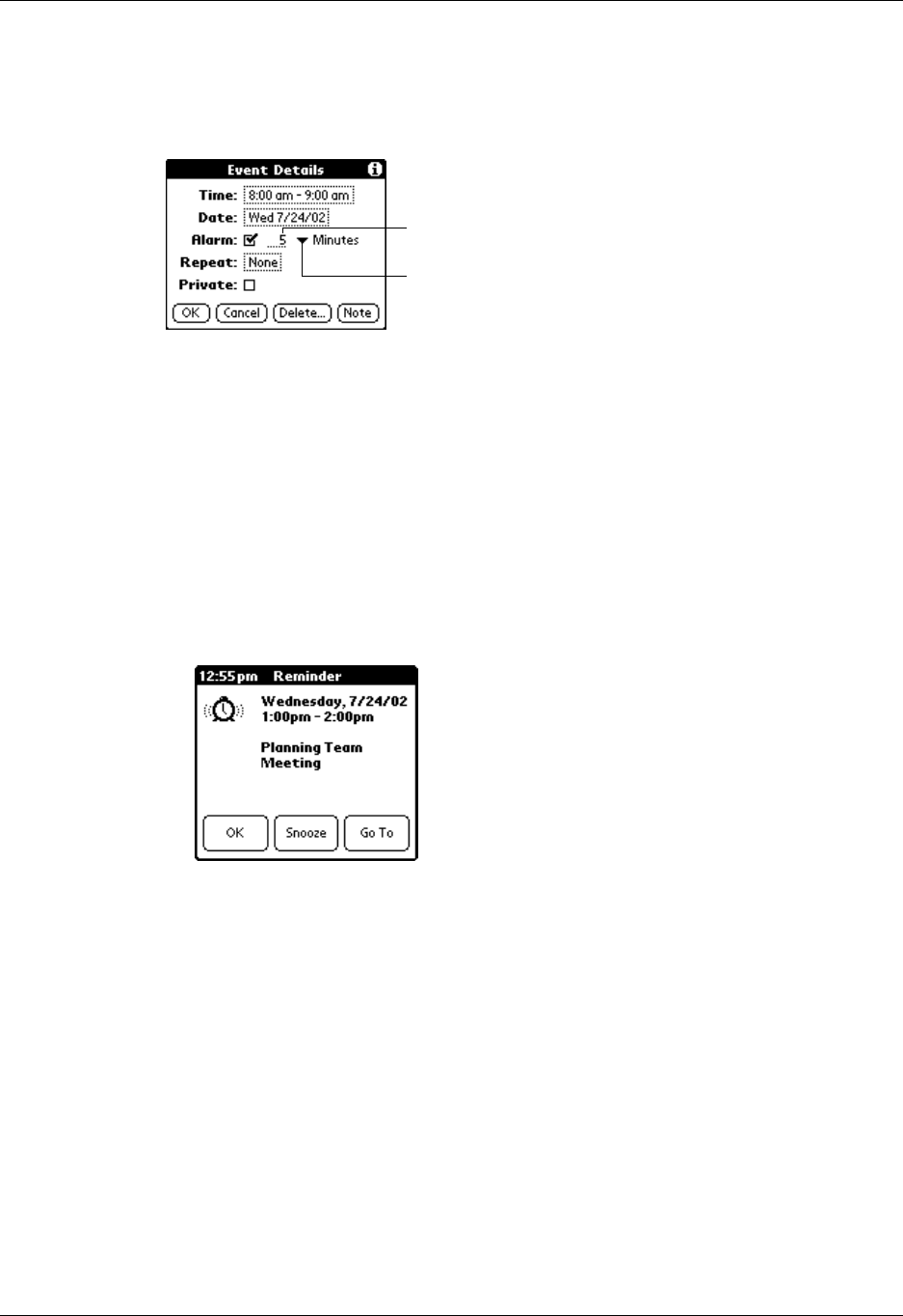
Using Date Book
94
4. Tap the pick list to select Minutes, Hours, or Days.
5. Select the 5 and enter any number from 0 to 99 (inclusive) as the number of time
units.
6. Tap OK.
7. When the reminder message appears on screen, do one of the following:
Tap OK to permanently dismiss the reminder and return to the current screen.
Tap Snooze to dismiss the reminder and return to the current screen. The
reminder message appears again five minutes after you tap Snooze, and an
attention indicator blinks in the upper-left corner of the screen to remind you of
the pending alarm.
Tap Go To to open Date Book. Date Book will open and display the event
associated with the alarm.
Alarm for untimed events: You can set a silent alarm for an untimed event. In this
case, the alarm triggers at the specified period of minutes, hours, or days before
midnight (beginning) of the day of the untimed event. When the alarm triggers, the
reminder list displays the alarm message until you clear it. See “Reviewing
Reminders” in Chapter 5 for details.
For example, you set an alarm for an untimed event that occurs on February 4th. If
the alarm is set for 5 minutes, the reminder message appears at 11:55 PM on the
night of February 3rd. The reminder remains in the reminder list until you turn on
your handheld and dismiss it.
Scheduling Repeating or Continuous Events
The Repeat function lets you schedule events that recur at regular intervals or
extend over a period of consecutive days.
Tap here to
select unit of time
Enter number of
time units here
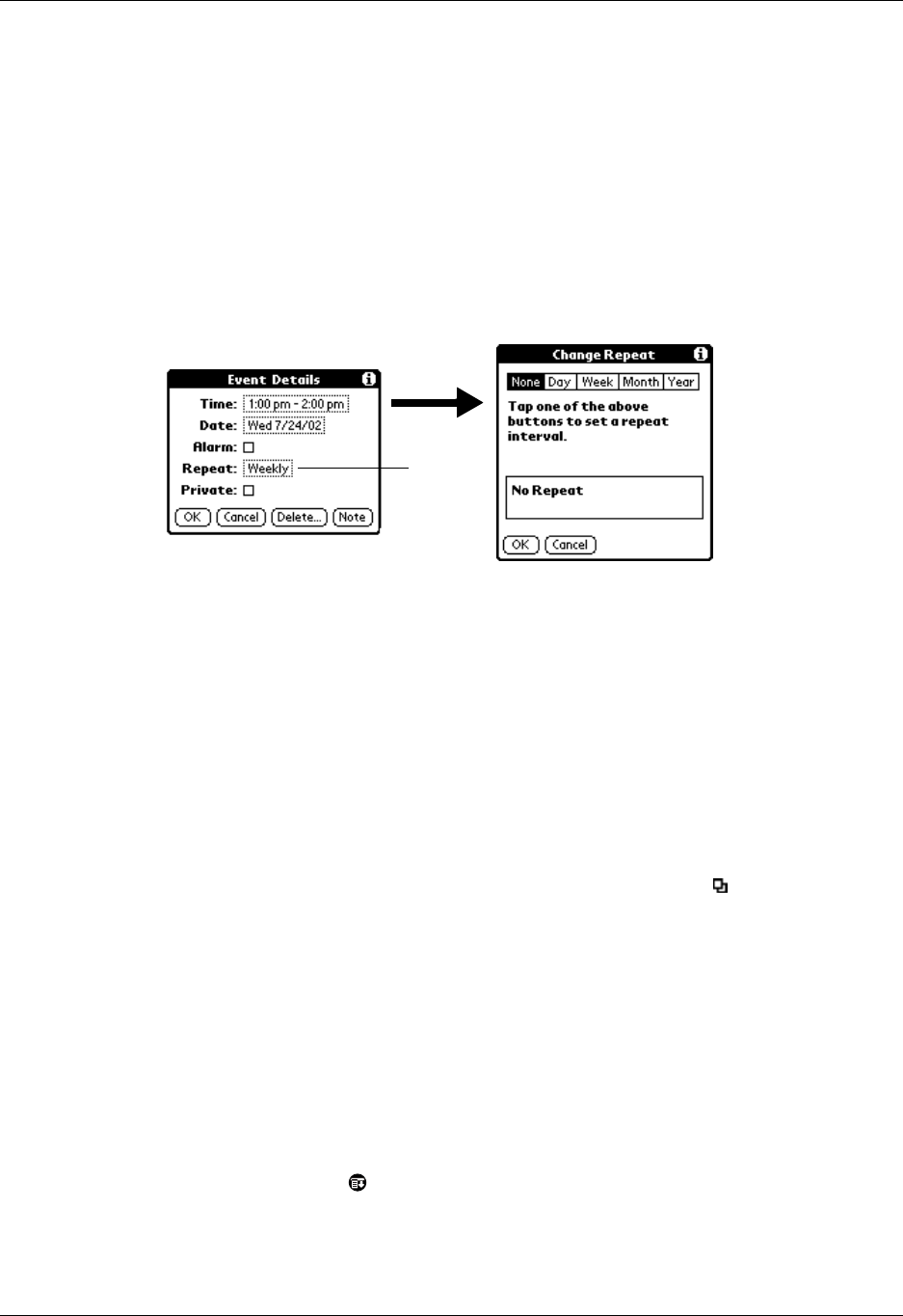
Scheduling Repeating or Continuous Events
95
A birthday is a good example of an event that repeats annually. Another example
is a weekly guitar lesson that falls on the same day of the week and the same time
of day.
A business trip or a vacation is an example of a continuous event.
To schedule a repeating or continuous event:
1. Tap the event.
2. Tap Details.
3. Tap the Repeat box to open the Change Repeat dialog box.
4. Tap Day, Week, Month, or Year to set how often event repeats.
For a continuous event, tap Day.
5. Enter a number that corresponds to how often you want the event to repeat on
the Every line.
For example, if you select Month and enter the number 2, the event repeats
every other month.
6. To specify an end date for the repeating or continuous event, tap the End on
pick list and tap Choose Date. Use the date picker to select an end date.
7. Tap OK.
After you schedule a repeating or continuous event, this icon appears to the far
right of the event.
Changing repeating or continuous events
When you make changes to a repeating or continuous event, such as deleting or
adding notes, or changing the time of an event, you can decide which of the events
you want to change; all events in the series, just the current event, or the current
and future events.
To delete repeating events:
1. Select the record you want to delete.
2. Tap the Menu icon .
3. Tap Record, and then tap Delete Event.
4. Do one of the following:
Ta p t h e
Repeat
box

Using Date Book
96
Tap Current to delete only the current event item.
Tap Future to delete the current and all future event items and reset the end date
of the repeating event to the last shown date.
Tap All to delete all occurrences of the repeating event.
5. Tap OK.
Considerations for repeating or continuous events
Keep the following points in mind:
■If you change the start date of a repeating event, your handheld calculates the
number of days you moved the event. Your handheld then automatically
changes the end date to maintain the duration of the repeating event.
■If you change the repeat interval (e.g., daily to weekly) of a repeating event, past
occurrences (prior to the day on which you change the setting) are not changed,
and your handheld creates a new repeating event.
■If you change the date of an occurrence of a repeating event (e.g., from January
14th to January 15th) and apply the change to all occurrences, the new date
becomes the start date of the repeating event. Your handheld adjusts the end
date to maintain the duration of the event. If you apply the change to current
and future occurrences, past occurrences are not changed.
■If you change other repeat settings (e.g., time, alarm, private) of a repeating
event and apply the change to all occurrences, your handheld creates a new
event. The start date of this new event is the day on which the setting is
changed.
■If you apply a change to a single occurrence of a repeating event (e.g., time), that
occurrence no longer shows the Repeat icon .
Changing the Date Book View
In addition to displaying the time list for a specific day, you can also display a
whole week, a month, or an agenda. You can also display the current time.
To cycle through Day, Week, Month, and Agenda views:
■Press the Date Book application button repeatedly to display the next view.
■Tap on the appropriate view icon in the lower-left corner of Date Book.
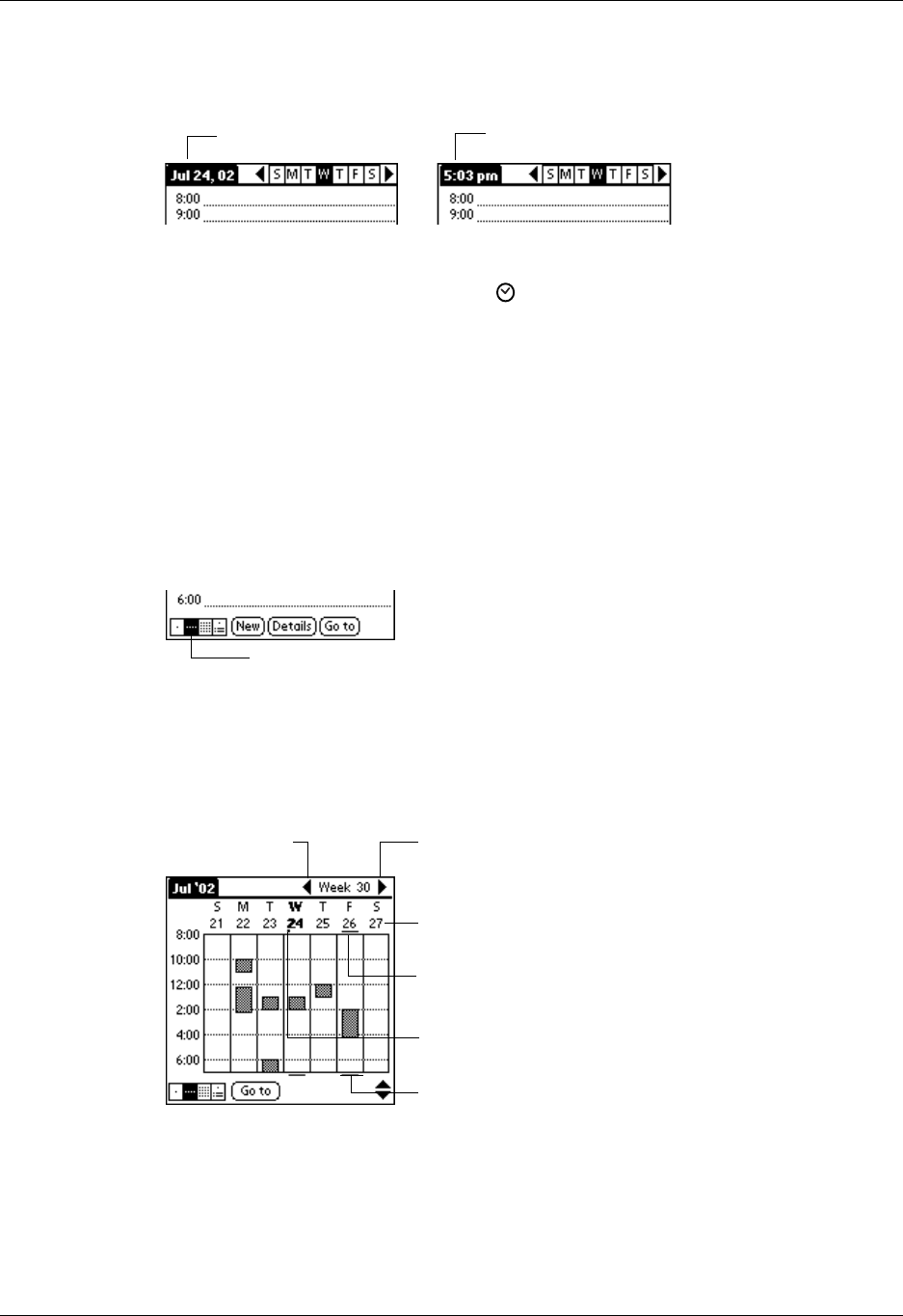
Changing the Date Book View
97
To display the current time:
1. Tap and hold the stylus on the date bar to display the current time.
2. Drag the stylus below the title area and then lift it to redisplay the date.
TIP You can also tap the Clock icon in the upper left corner of the Graffiti
writing area to display the time for a few seconds.
Working in Week View
Week View shows the calendar of your events for an entire week. This view lets
you quickly review your appointments and available time slots. In addition, the
graphical display helps you spot overlaps and conflicts in your schedule.
To display the Week View:
1. Tap the Week View button.
2. Tap the navigation controls to move forward or backward a week at a time, or
tap on a column to display details of an event.
The Week View also shows untimed events and events that are before and after
the range of times shown.
3. Tap an event to show a description of the event.
Tap and hold the date Current time displays
Week View
P
rev
i
ous
week
N
ext wee
k
Tap for that day
Bar indicates earlier event
Bar indicates later event
Dot indicates untimed event
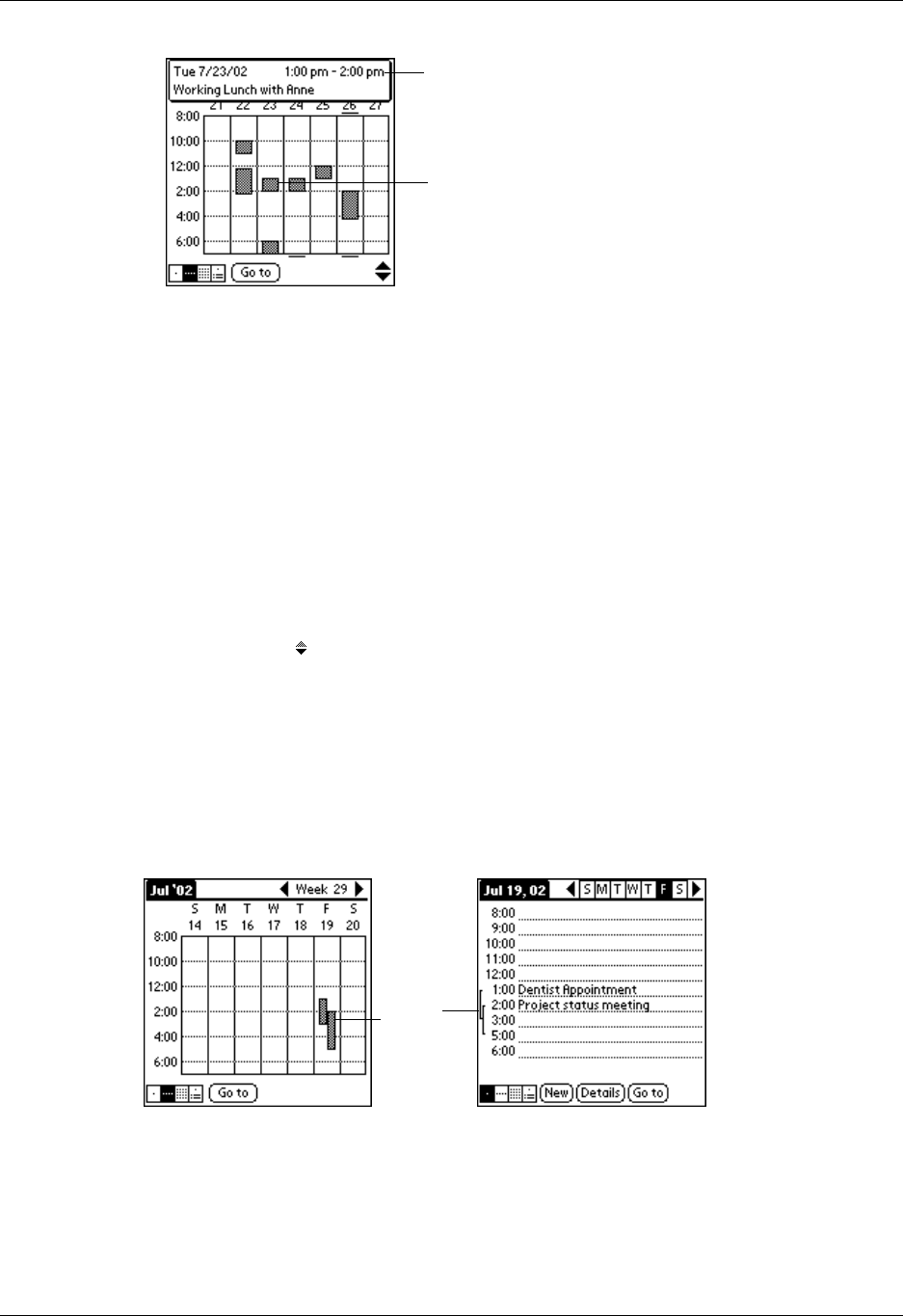
Using Date Book
98
Tips for using Week View
Keep the following points in mind:
■To reschedule an event, tap and drag the event to a different time or day.
■Tap a blank time on any day to move to that day and have the time selected for
a new event.
■Tap any day or date that appears at the top of the Week View to move directly
to that day without selecting an event.
■The Week View shows the time span defined by the Start Time and End Time in
the Date Book Preferences settings. If you have an event before or after this time
span, a bar appears at the top or bottom of that day's column. Use the onscreen
scroll arrows to scroll to the event.
Spotting event conflicts
With the ability to define specific start and end times for any event, it’s possible to
schedule events that overlap (an event that starts before a previous event finishes).
An event conflict (time overlap) appears in the Week View as overlapping bars.
The Day View displays overlapping brackets to the left of the conflicting times.
Working in Month View
The Month View screen shows which days have events scheduled. Dots and lines
in the Month View indicate events, repeating events, and untimed events.
Event details
Tap to show event details
Event
conflicts
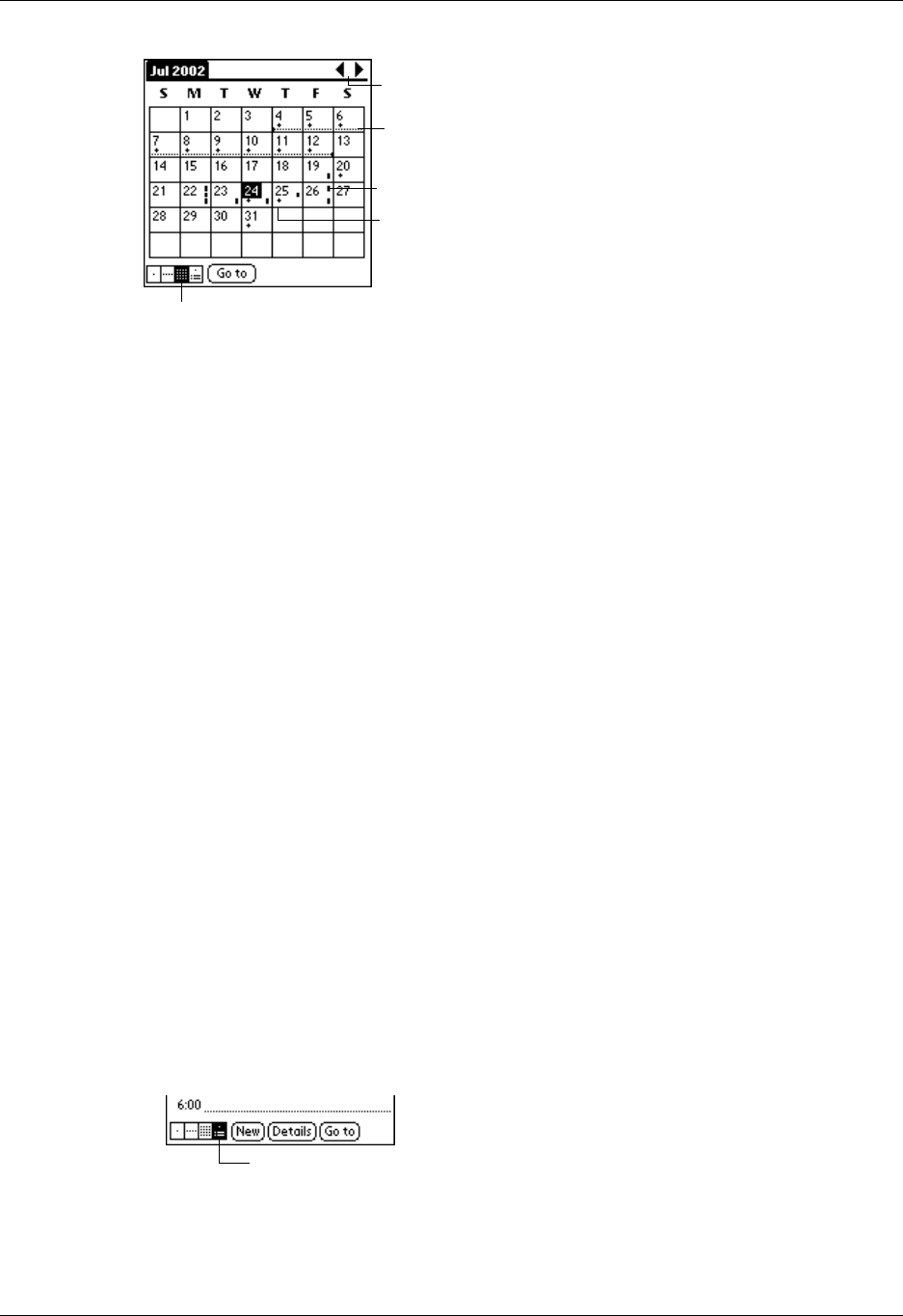
Changing the Date Book View
99
You can control the dots and lines that appear in the Month View. See “Options
menu” later in this chapter.
Tips for using Month View
Keep the following points in mind:
■Tap a day in the Month View to display that day in the Day View.
■Tap the scroll arrows in the upper-right corner to move forward or backward a
month.
■Tap Go to open the date selector and select a different month.
■Use the scroll button on the front panel of your handheld to move between
months. Press the upper half of the button to display the previous month, the
lower half to display the next month.
Working in Agenda View
The Agenda view shows you your untimed events, appointments, and To Do items
in one screen. When you tap on an untimed event or appointment in the Agenda
view, the Day view appears so you can see more detailed information about the
event. You can tap the check box next to a To Do item to mark it as completed.
When you tap on a To Do item, your To Do list appears.
NOTE The To Do items that appear and how you can change them depends on the
settings in your To Do preferences. See “To Do Show Options” in Chapter 14 for
more information.
To display the Agenda View:
1. Tap the Agenda View button.
2. Tap the navigation controls to move forward or backward a day at a time, or to
display more events and To Do items.
Previous/next month
Dashes on right side indicate events
Dashed line indicates continuous event
Crosses below date indicate untimed
Month View button
Agenda View
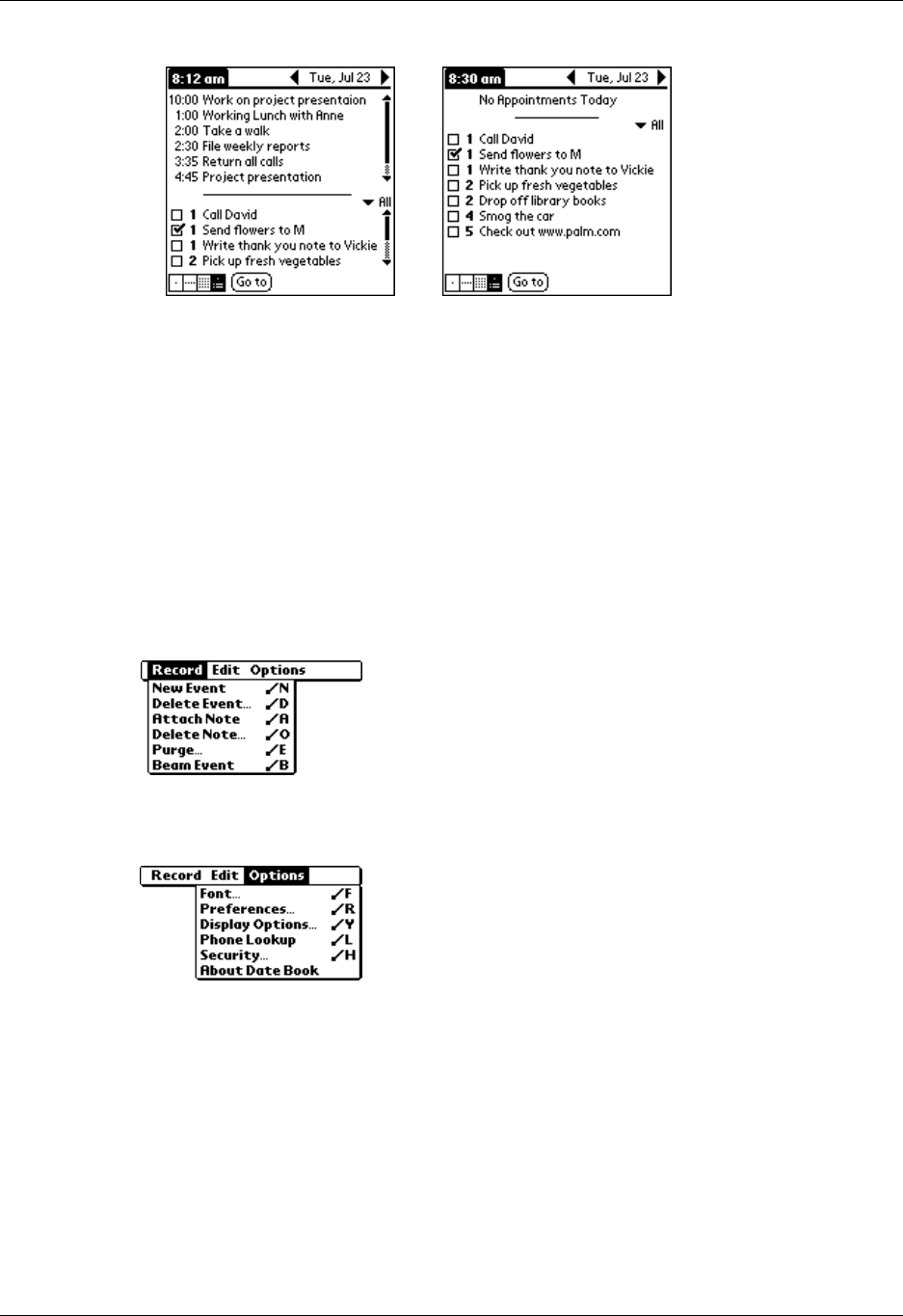
Using Date Book
100
NOTE You can also change the category of To Do items shown. Click on the
pick list to choose another category. See Chapter 14 for more information on
working with To Do items.
Date Book Menus, Preferences, and Display Options
Date Book menus are shown here for your reference, and Date Book features that
are not explained elsewhere in this book are described here.
see “Using menus” in Chapter 5 for information about choosing menu commands.
Record menu
Options menu
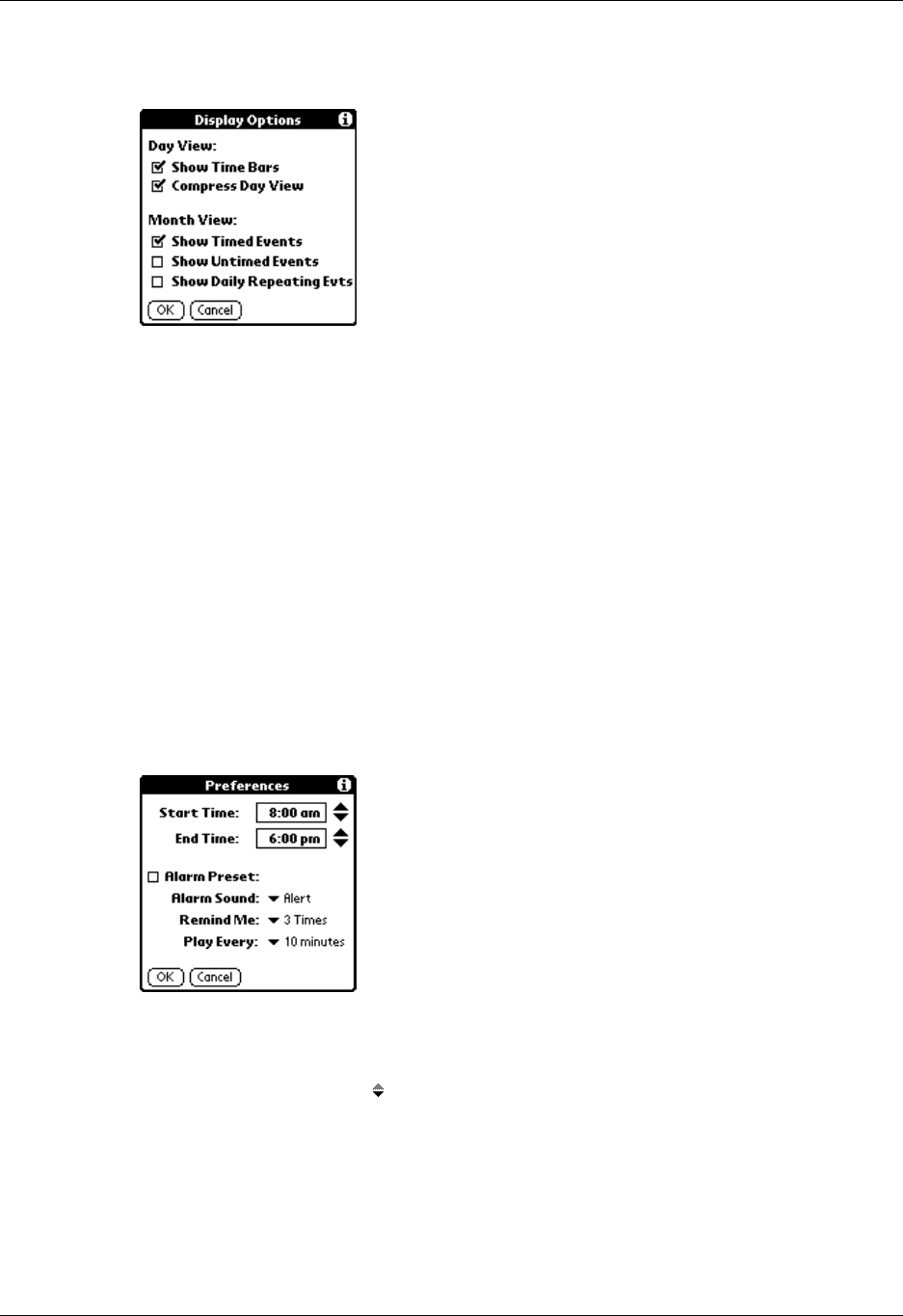
Date Book Menus, Preferences, and Display Options
101
Display Options
Allows you to change Date Book’s appearance and which events display.
Preferences
Show Time Bars Activates the time bars that appear in the Day View. The time
bars show the duration of an event and illustrate event
conflicts.
Compress Day View Controls how times appear in the Day View. When Compress
Day View is off, all time slots display. When it is on, start and
end times display for each event, but blank time slots toward
the bottom of the screen disappear to minimize scrolling.
Month View settings These check boxes apply to the Month View of the Date Book.
You can activate any or all of these settings to show that you
have Timed, Untimed, or Daily Repeating events in the
Month View only.
Start/End Time Defines the start and end times for Date Book screens. If the time
slots you select do not fit on one screen, you can tap the scroll
arrows to scroll up and down.
Alarm Preset Automatically sets an alarm for each new event. The silent alarm
for untimed events is defined by minutes, days, or hours before
midnight of the date of the event.
Alarm Sound Sets the tone of the alarm.

Using Date Book
102
About Date Book
Shows version information for Date Book.
Remind Me Defines how many times the alarm will occur after the initial
occurrence. The choices are Once, Twice, 3 Times, 5 Times, and
10 Times.
Play Every Defines how often the alarm sounds. The choices are Minute, 5
minutes, 10 minutes, and 30 minutes.

103
CHAPTER 11
Using Memo Pad
Memo Pad provides a place to take notes that are not associated with records
in Date Book, Address Book, or To Do List. The number of memos you can
store is dependent only on the memory available on your handheld. Use
Memo Pad to do the following:
■Use Graffiti® characters to store memos, lists, or any other text message on your
handheld.
■Drag and drop memos into popular computer applications like Microsoft Word
when you synchronize using Palm™ Desktop software and HotSync®
technology.
■Assign memos to categories so that you can organize and view them in logical
groups.
■Write down phone numbers and other types of information. Later, you can
copy and paste this information to other applications.
To open Memo Pad:
1. Tap the Applications icon .
2. Tap the Memo Pad icon .
Creating Memos
To create a new memo:
1. Tap the Applications icon .
2. Tap the Memo Pad icon to display the Memo list.
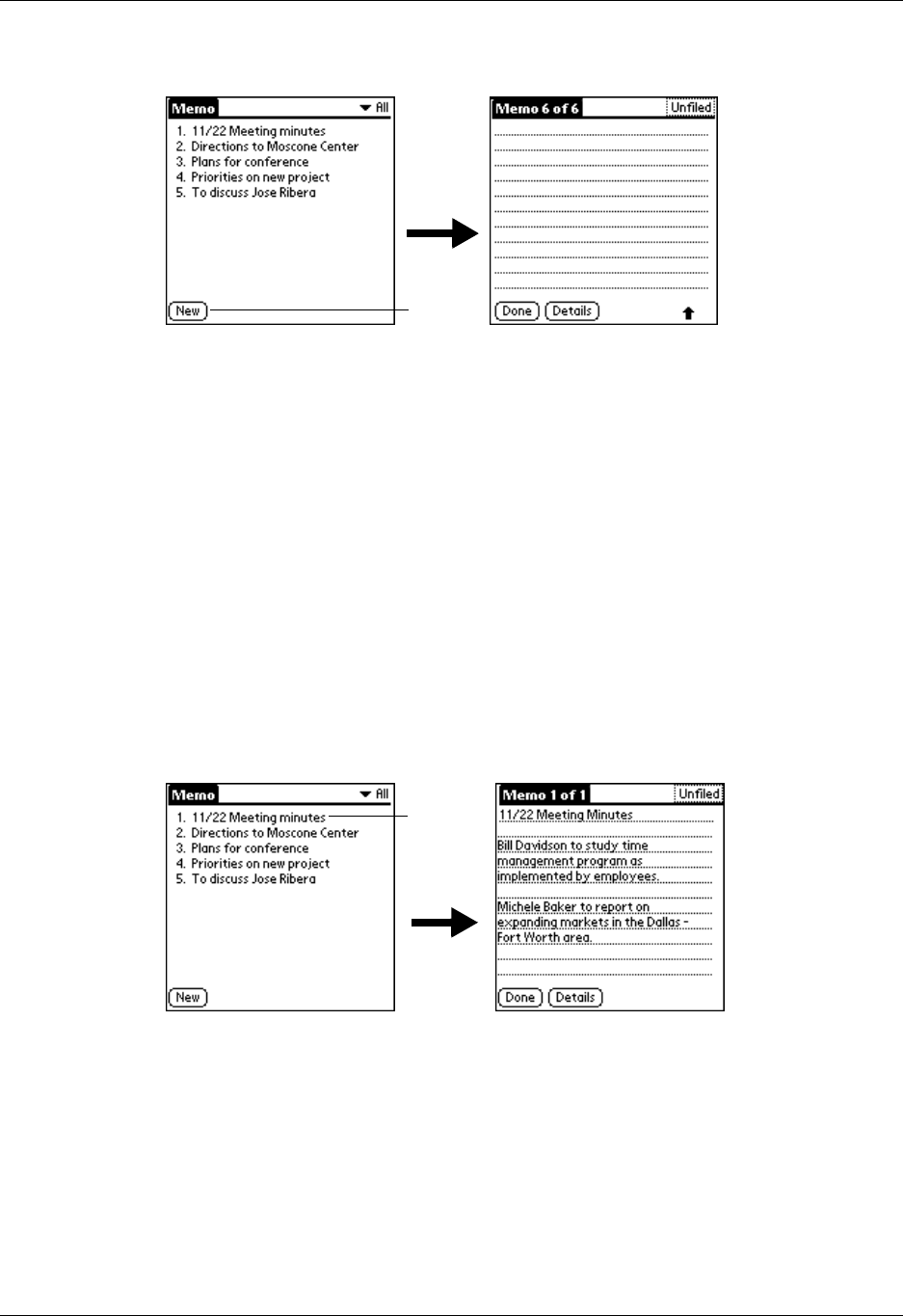
Using Memo Pad
104
3. Tap N ew.
TIP In the Memo list screen, you can also begin writing in the Graffiti writing
area to create a new memo. The first letter is automatically capitalized and
begins your new memo.
4. Enter the text you want to appear in the memo. Use the carriage return stroke
to move down to new lines in the memo.
5. Tap Done.
Reviewing Memos
The first line of a memo appears in the Memo list. This makes it easy to locate and
review your memos.
To rev iew a memo:
1. In the Memo list, tap the text of the memo.
2. Review or edit the text in the memo.
3. Tap Don e.
Memo Pad Menus
Memo Pad menus are shown here for your reference, and Memo Pad features that
are not explained elsewhere in this book are described here.
See “Using menus” in Chapter 5 for information about choosing menu commands.
Ta p
New
Ta p a
memo to
review its
contents
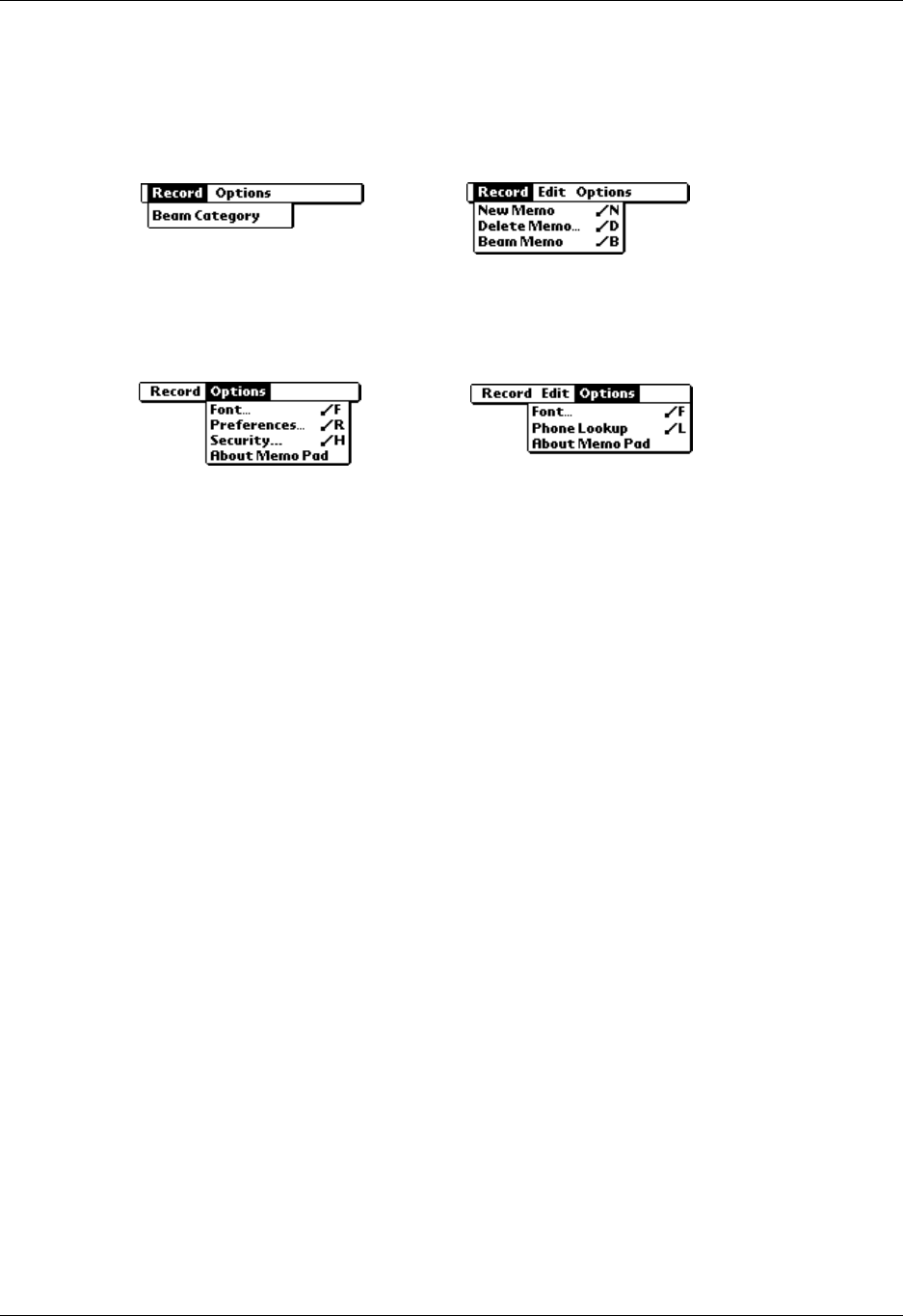
Memo Pad Menus
105
The Record and Options menus differ depending on whether you’re displaying
the Memo list or an individual memo.
Record menus
Options menus
Memo list
Memo screen
Preferences Displays the Memo Preferences dialog box, where you define the
sort order for memos.
About Memo Pad Shows version information for Memo Pad.
Memo list Memo screen

Using Memo Pad
106
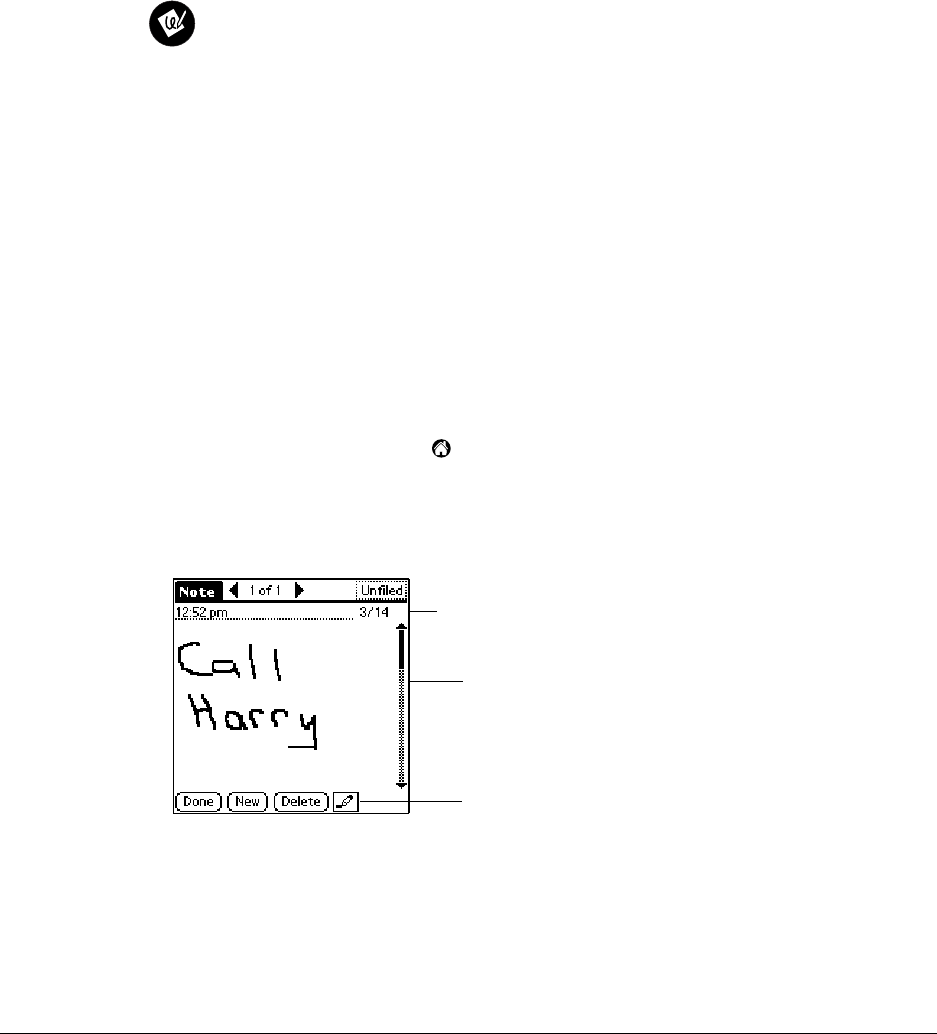
107
CHAPTER 12
Using Note Pad
Note Pad provides a place to take notes in your own handwriting. You can
use Note Pad to do everything you might do with a piece of paper and a
pencil. Use Note Pad to do the following:
■Take notes, draw a sketch, or write any kind of message directly on your
handheld screen. Later, you can enter this information into other applications.
■Set an alarm to use your notes as reminder messages.
■Assign notes to categories so that you can organize and view them in logical
groups.
■Copy and paste notes into popular computer applications like Microsoft Word
using Palm™ Desktop software and HotSync® technology.
Creating a Note
To create a new note:
1. Tap the Applications icon .
2. Tap the Note Pad icon .
■If Note Pad is already running, tap New.
3. Write the information directly on the handheld screen.
Tap the pen selector to choose a different pen width, or choose the eraser to remove
unwanted strokes.
4. (Optional) Select the time at the top of the screen and enter a title using Graffiti writing.
5. Tap Done.
Pen selector
Write
information
here
Enter title here
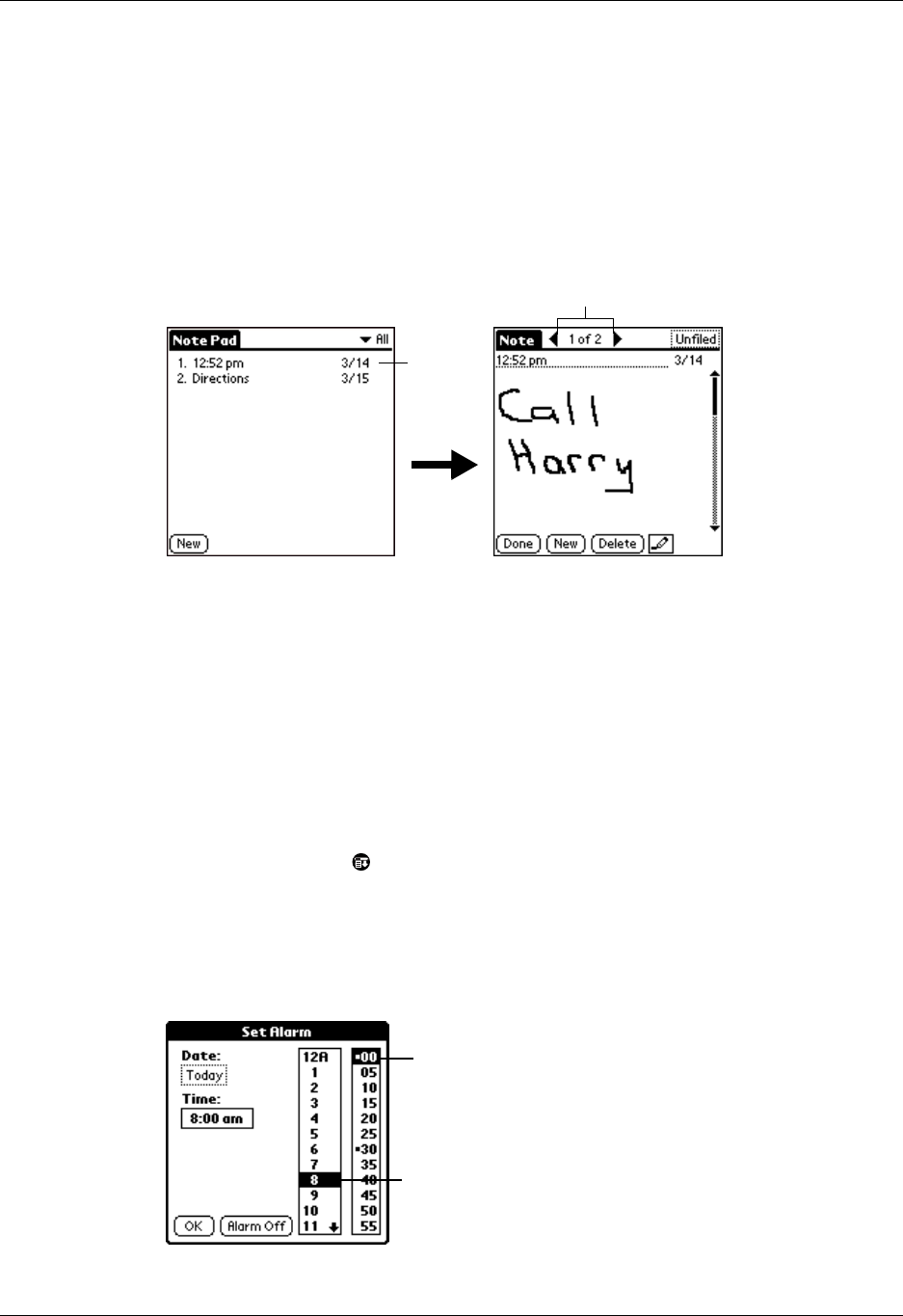
Using Note Pad
108
Reviewing Notes
The note title and the date you created the note appear in the Note Pad list. If you
did not assign a title to your note, the time you created the note appears as the note
title. This makes it easy to locate and review your notes.
To review a note:
1. In the Note Pad list, tap the note title.
2. Review or edit the contents of the note.
3. Tap Don e.
Setting an Alarm for a Note
You can set an alarm for a specific time and date to remind you to follow-up on a
note.
To set an alarm for a note:
1. Tap the note to which you want to assign an alarm.
2. Tap the Menu icon .
3. Tap Options, and then tap Alarm.
4. Tap the Time box.
5. Tap the hour and minute columns to select the time you want the alarm to occur.
6. Tap the Date box.
Tap a
note to
view its
contents
T
ap arrows to scro
ll
to
next and previous notes
Tap here to
select minutes
Tap here to
select hour
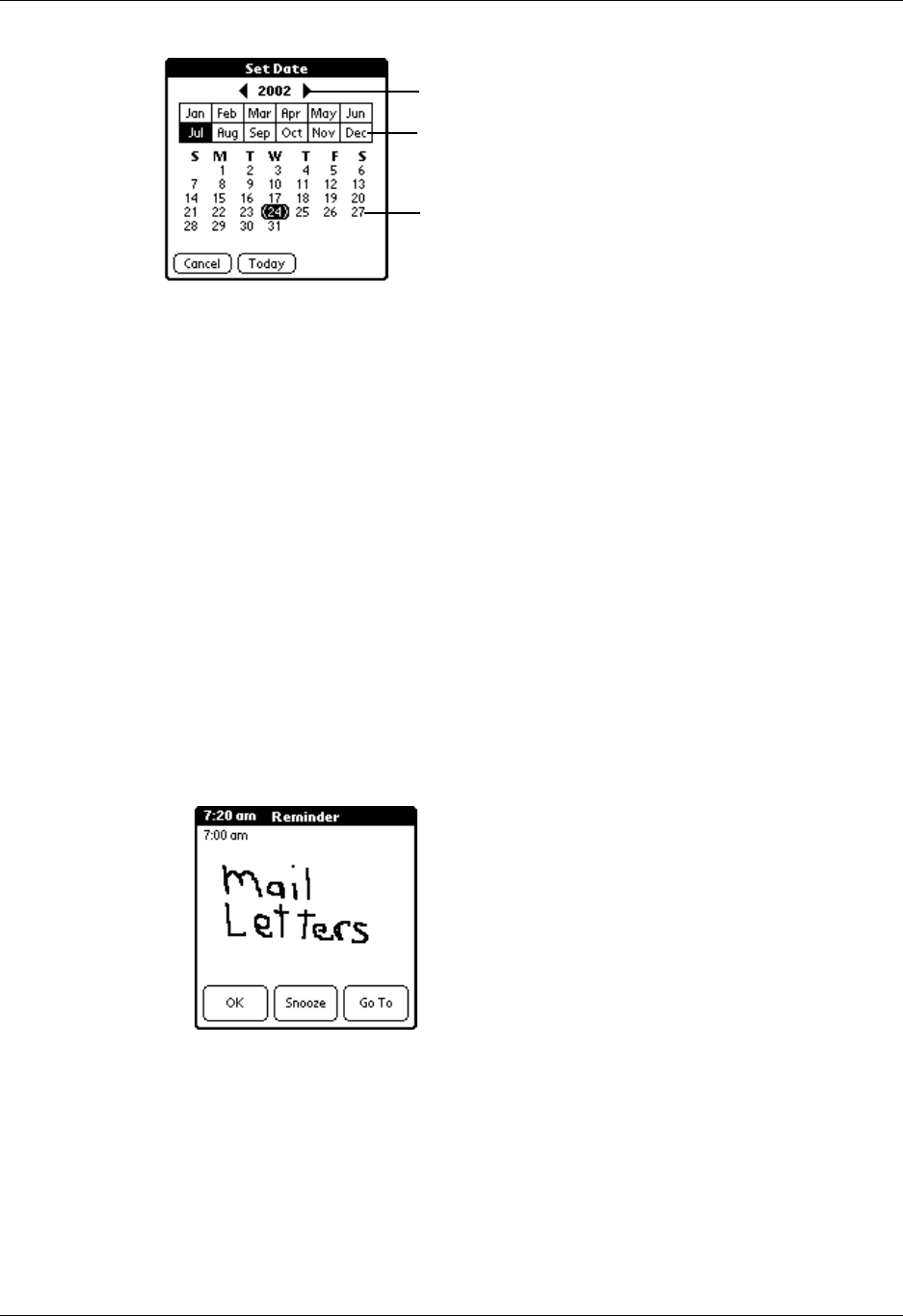
Note Pad Menus
109
7. Tap the year, month and date you want the alarm to sound.
After you tap the date, the Set Alarm dialog box reappears.
8. Tap OK.
9. When the alarm goes off and the reminder message appears on screen, do one
of the following:
– Tap OK to permanently dismiss the reminder and return to the current
screen.
– Tap Snooze to dismiss the reminder and return to the current screen. The
reminder message appears again in five minutes, and an attention indicator
blinks in the upper-left corner of the screen to remind you of the pending
alarm. When the reminder message reappears, the current time displays in
the Reminder bar and the note title displays on the screen.
– If you did not title the note, the time the note was created displays on the
screen.
– Tap Go To to open Note Pad. Note Pad will open and display the note
associated with the alarm.
Note Pad Menus
Note Pad menus are shown here for your reference, and Note Pad features that are
not explained elsewhere in this book are described here.
The Record and Options menus differ depending on whether you’re displaying the
Note Pad list or an individual note.
Tap here to select month
Tap here to select year
Tap here to select date

Using Note Pad
110
Record menus
Options menus
Note Pad list
Note screen
Preferences Displays the Note Pad Preferences dialog box, where you define
the sort order for notes and the alarm sound.
Security Displays the Change Security dialog box, where you set a
privacy option for all notes.
Details Displays the Note Details dialog box, where you assign a
category and privacy option for a note.
About Note Pad Shows version information for Note Pad.
Note Pad list Note screen

111
CHAPTER 13
Using Security
Your handheld comes with a Security application so that unauthorized users
cannot view the entries you wish to protect. Use the Security application to do the
following:
■Lock and turn off your handheld so that it does not operate until you enter the
correct password.
■Mask all records that you mark as private so the information appears greyed
out.
■Hide all records that you mark as private so they do not appear on any screen.
You can mask and hide private records with or without a password. Without a
password, private records are hidden or masked until you set the Security
application to show them. With a password, you must enter the password to view
the private entries.
Assigning A Password
You can assign a password to protect your private records and to lock your
handheld.
To assign a password:
1. Tap the Applications icon .
2. Tap the Security icon.
3. Tap the Password box.
4. Enter a password.
5. Enter a hint to help your remember your password if you forget it. This is
optional.
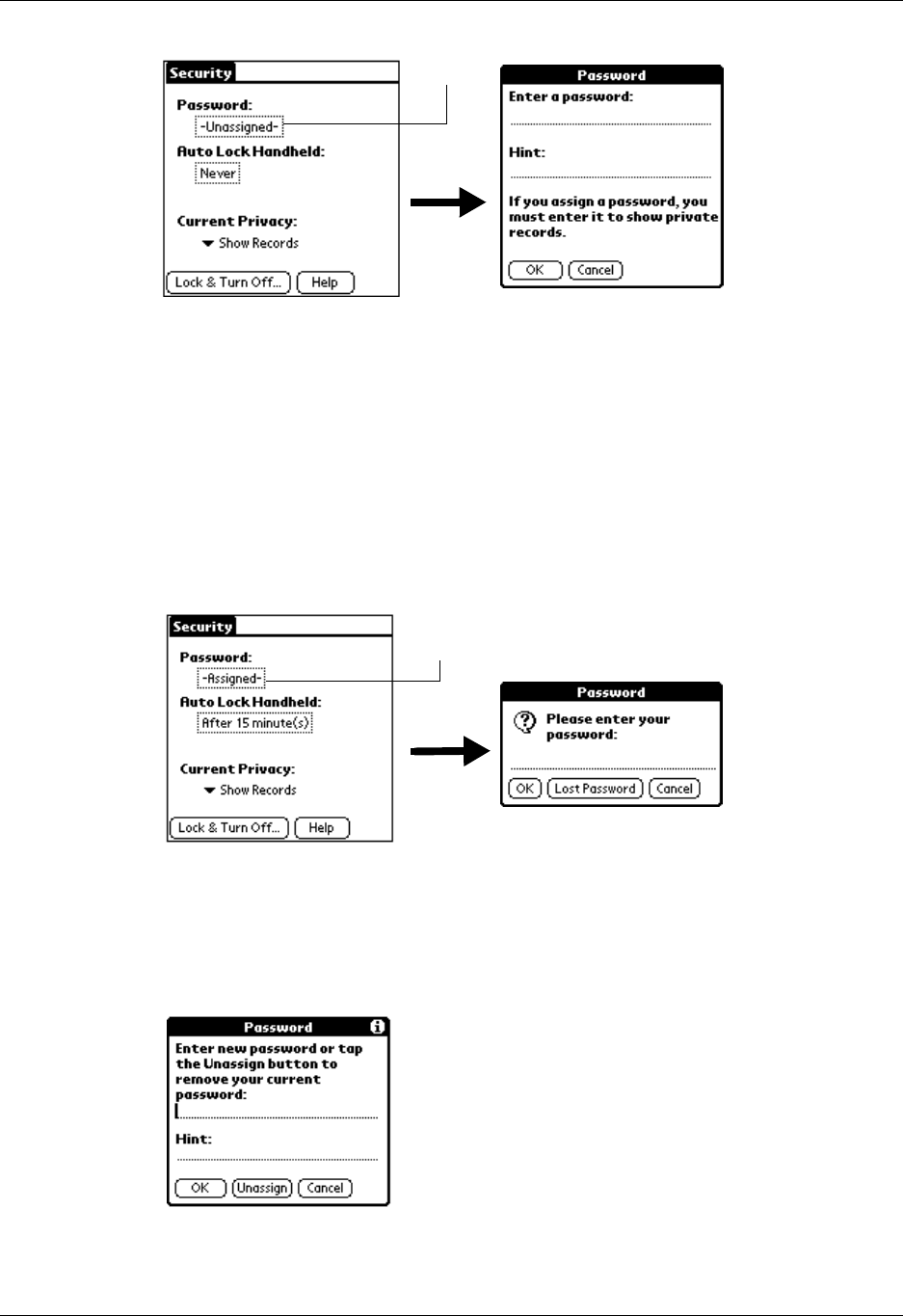
Using Security
112
6. Tap OK.
7. Enter the same password a second time, and tap OK.
Changing or deleting a password
Once you define a password for your handheld, you can change or delete it at any
time. You must enter the current password before you can change or delete it.
To change or delete your password:
1. Tap the Password box.
2. Enter the current password.
3. Tap OK.
4. Do one of the following:
To change the password and hint, enter the new password and hint, and tap OK.
To remove the password, tap Unassign.
Ta p h e r e
Tap here
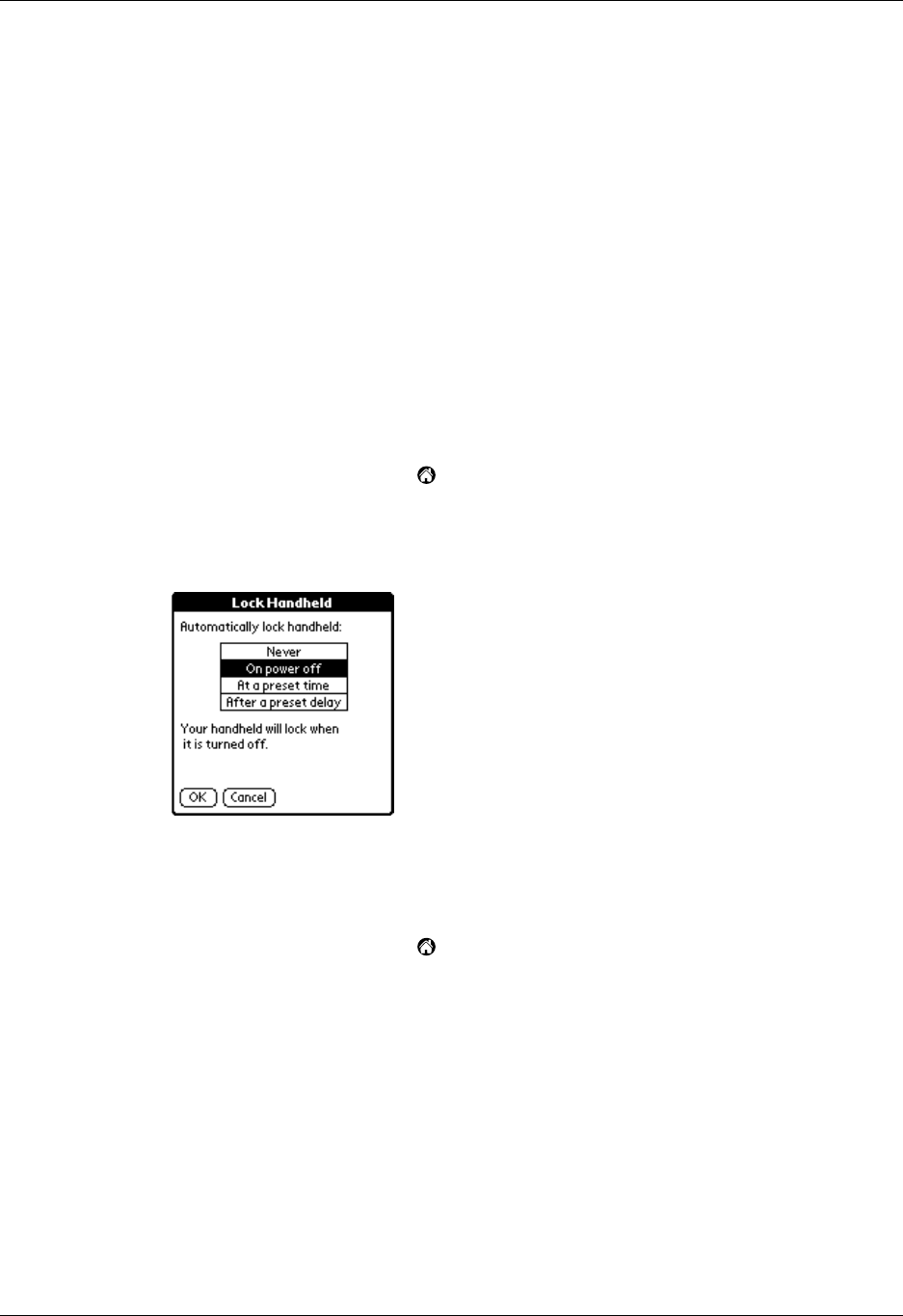
Assigning A Password
113
Locking your handheld
You can lock your handheld so that it cannot be operated until your password is
entered. In the event that your handheld is lost or stolen, this helps protect your
data from unauthorized use. You can set your handheld to lock automatically, or
you can lock it manually.
Locking your handheld automatically
You can set your handheld to lock automatically when any one of the following
occur:
■When you turn off the power
■At a time you specify
■After a period of inactivity you specify
To set your handheld to lock when you turn it off:
1. Tap the Applications icon .
2. Tap the Security icon.
3. Tap the Auto Lock Handheld box, and then enter your password.
4. Tap On power off.
5. Tap OK.
To set your handheld to lock at a preset time:
1. Tap the Applications icon .
2. Tap the Security icon.
3. Tap the Auto Lock Handheld box, and then enter your password.
4. Tap At a preset time, and then use the arrows to set the time.
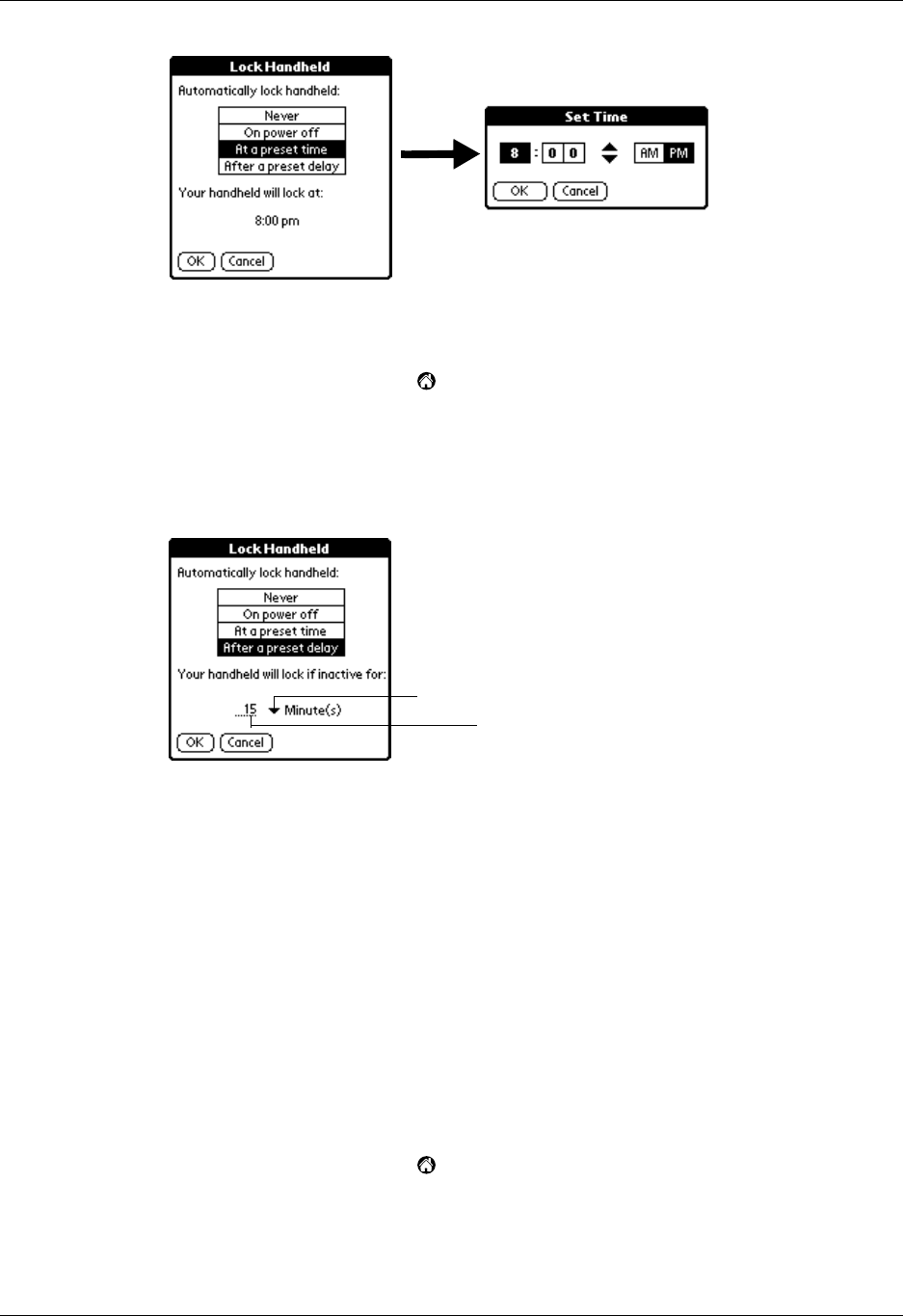
Using Security
114
5. Tap OK.
To set your handheld to lock after a period of inactivity:
1. Tap the Applications icon .
2. Tap the Security icon.
3. Tap the Auto Lock Handheld box, and then enter your password.
4. Tap After a preset delay.
5. Enter the inactive period, then select Minute(s) or Hour(s) from the pick list.
6. Tap OK.
CAUTION If you lock your handheld, you must enter the exact password to re-
activate your handheld. If you forget the password, your handheld will present
the hint you have entered to help you remember the password. If you still
cannot remember the password, you must perform a hard reset to resume
using your handheld. Performing a hard reset deletes all the records in your
handheld; however, you can restore all synchronized data at the next HotSync
operation. See “Performing a hard reset” in Appendix A for more information.
Locking your handheld manually
You can turn off and lock your handheld manually.
To lock and turn off your handheld:
1. Tap the Applications icon .
2. Tap the Security icon.
3. Tap Lock & Turn Off.
Tap to select Minutes or Hours
Enter the amount of time
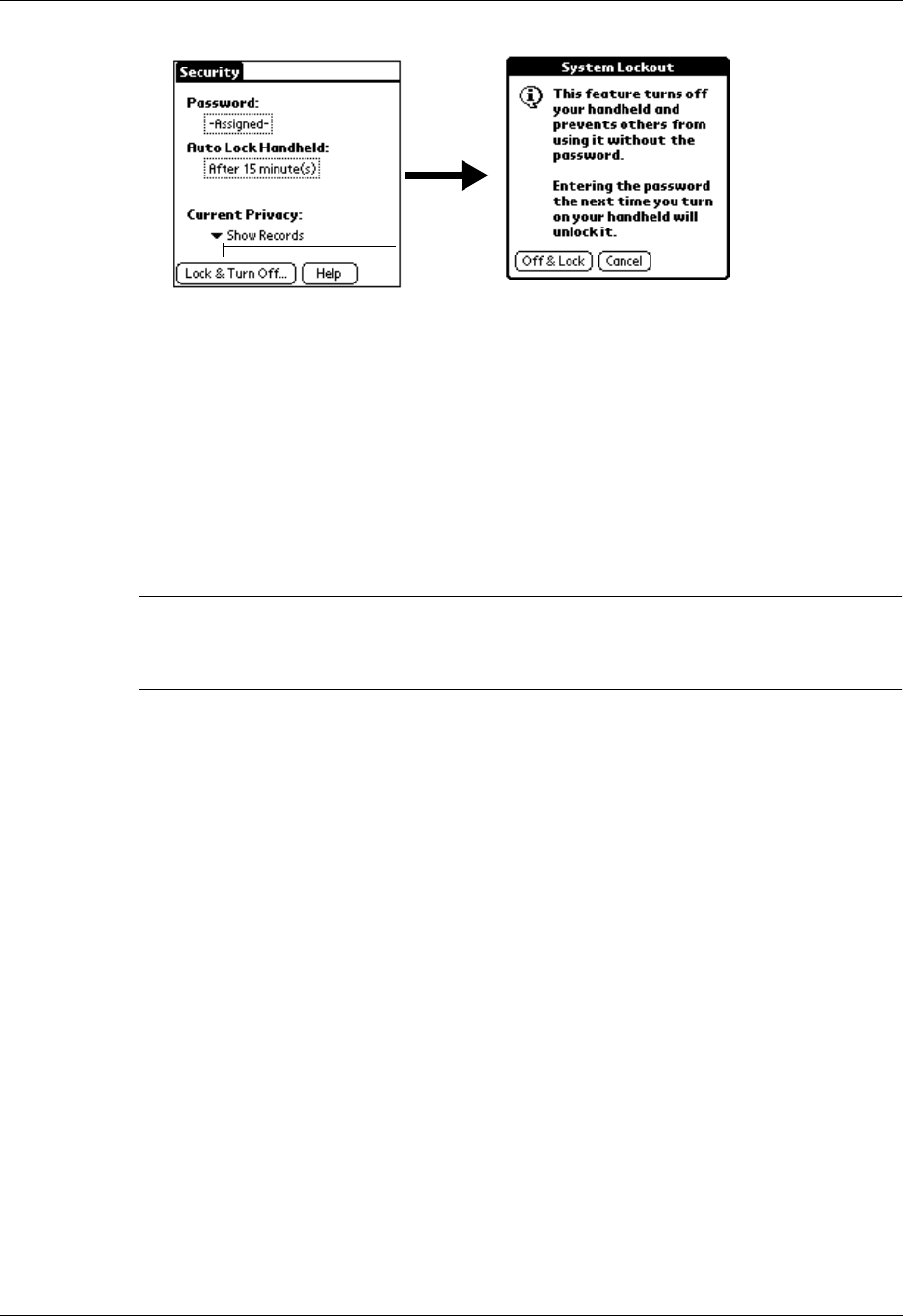
Assigning A Password
115
4. Tap Off & Lock .
5. To start your handheld, turn it on and then enter the password.
Recovering from a forgotten password
If you forget your password, your handheld will display the password hint, if you
entered one, to help you remember the password. If you are still unable to
remember the password, you can delete it from your handheld. Deleting a
forgotten password also deletes all entries and files marked as Private.
IMPORTANT If you synchronize with your computer before deleting a forgotten
password, your handheld restores your private entries the next time you perform a
HotSync operation, but it does not restore the password.
To delete a forgotten password:
1. Tap Lost Password.
2. Tap Yes.
Making records private
In many applications, you can make individual records private. Private records
remain visible and accessible, however, until you select the Security setting to hide
or mask all private records. Masked records appear as grey placeholders in the
same position they would appear if they were not masked, and are marked with a
Ta p L o ck
and Turn
Off
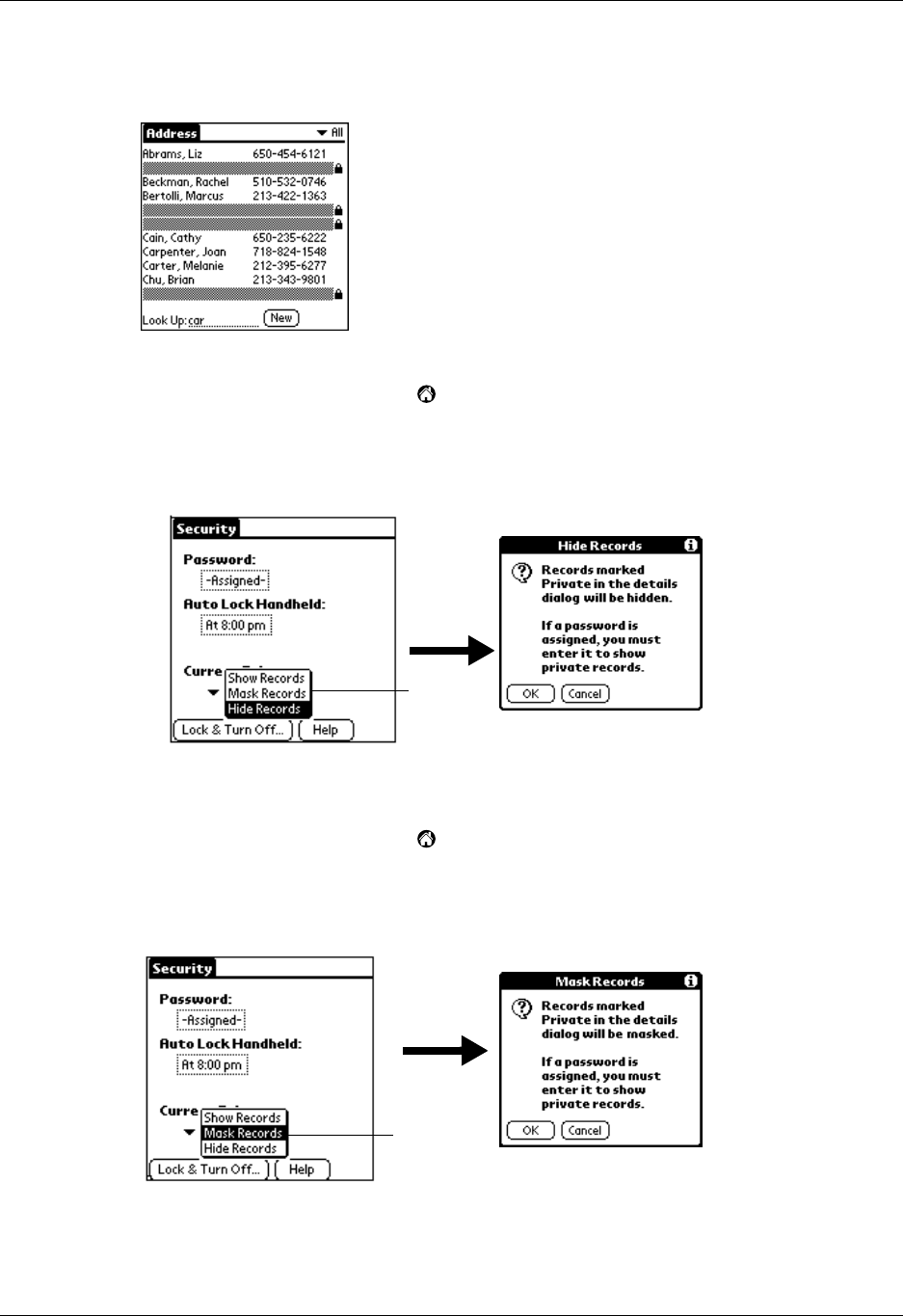
Using Security
116
lock icon. Hidden records disappear completely from the screen. If you define a
password for your handheld, you must enter it to display private records.
To hide all private records:
1. Tap the Applications icon .
2. Tap Security.
3. Tap the Current Privacy pick list and select Hide Record
.
4. Tap OK to confirm that you want to hide private records.
To mask all private records:
1. Tap the Applications icon .
2. Tap Security.
3. Tap the Current Privacy pick list and select Mask Records.
4. Tap OK to confirm that you want to mask private records.
Tap Hide
Records
Tap M a s k
Records
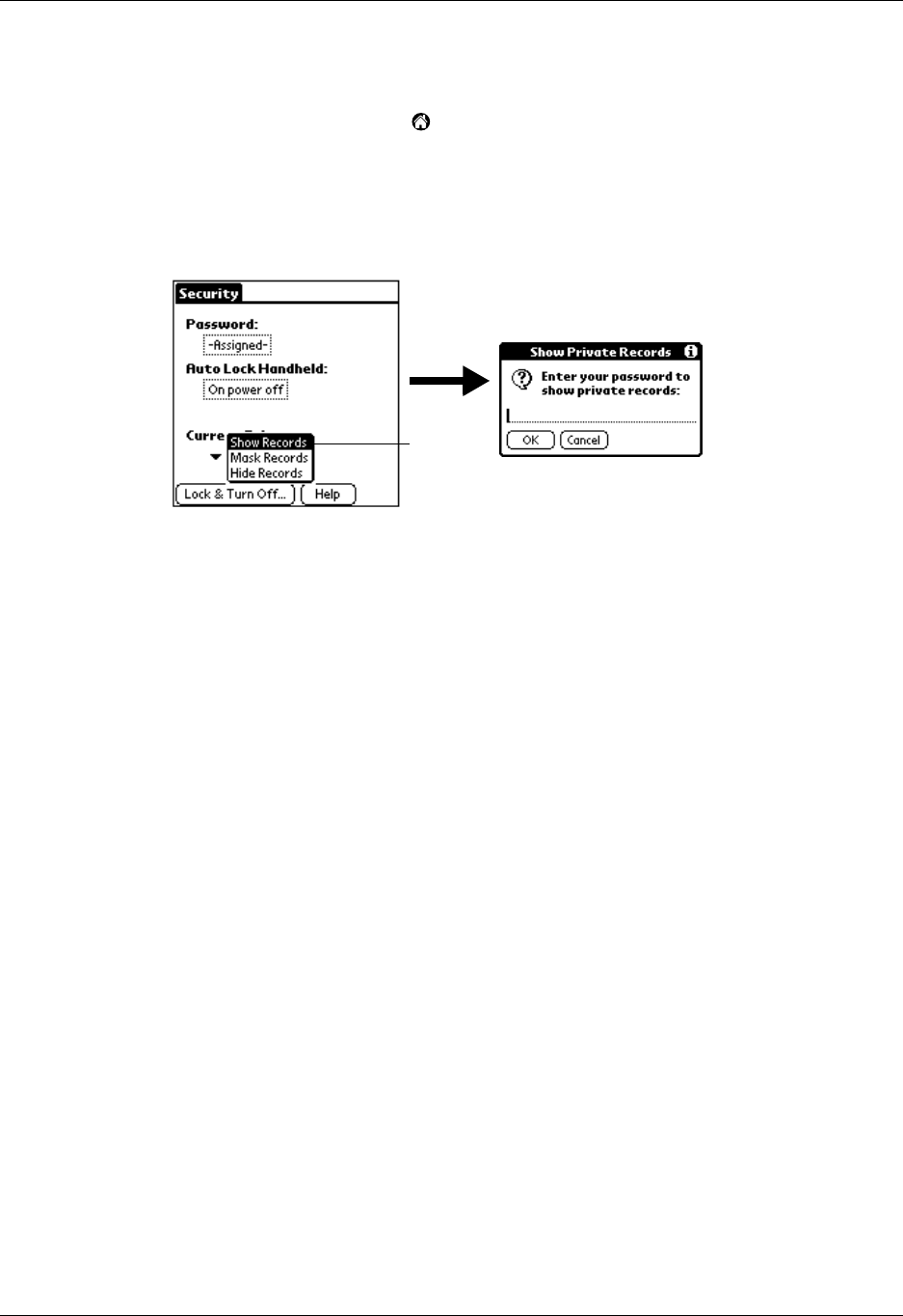
Assigning A Password
117
To display all private records:
1. Do one of the following:
Tap the Applications icon , tap Security, then tap the Current Privacy pick list
and select Show Records.
If you do not have a password, hidden and masked records become visible.
If you have a password, the Show Private Records dialog box appears. Go to
step 2.
2. Enter your password, and then tap OK.
To unmask individual records:
1. Tap a masked record.
2. Do one of the following:
If you do not have a password, a masked record becomes visible.
If you have a password, the Show Private Records dialog box appears. Go to
step 3.
3. Enter your password, and then tap OK.
To make a record private:
1. Display the entry that you want to make private.
2. Tap Details.
3. Tap the Private check box to select it.
4. Tap OK.
Ta p
Show
Records

Using Security
118
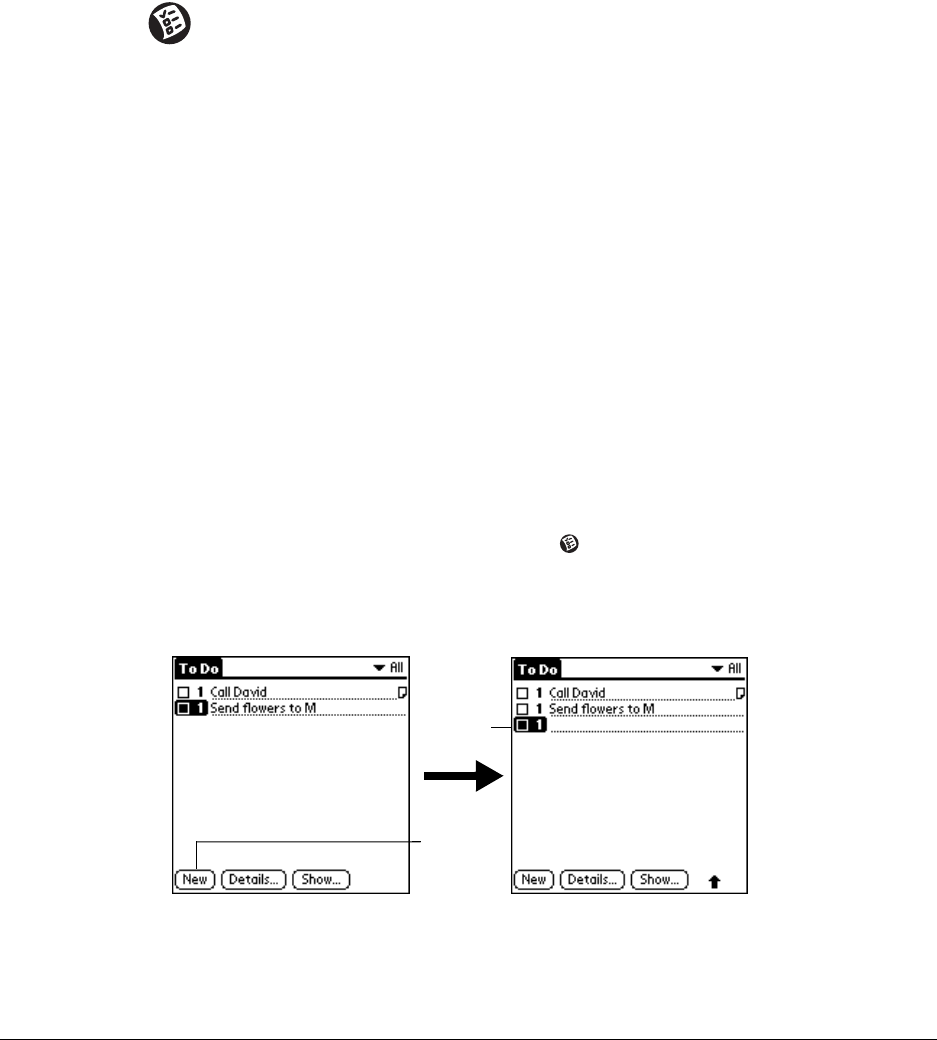
119
CHAPTER 14
Using To Do List
To Do List is a convenient place to create reminders and prioritize the things
that you have to do. Use To Do List for the following:
■Make a quick and convenient list of things to do.
■Assign a priority level to each task.
■Assign a due date for any or all of your To Do List items.
■Assign To Do List items to categories so that you can organize and view them
in logical groups.
■Sort your To Do List items either by due date, priority level, or category.
■Attach notes to individual To Do List items for a description or clarification of
the task.
Creating List Items
A To Do List item is a reminder of some task that you have to complete. A record
in To Do List is called an “item.”
To create a To Do List item:
1. Press the To Do List application button on the front of your handheld to
display the To Do List.
2. Tap N ew.
3. Enter the text of the To Do List item. The text can be longer than one line.
4. Tap anywhere onscreen to deselect the To Do List item.
Ta p N e w
New To
Do item
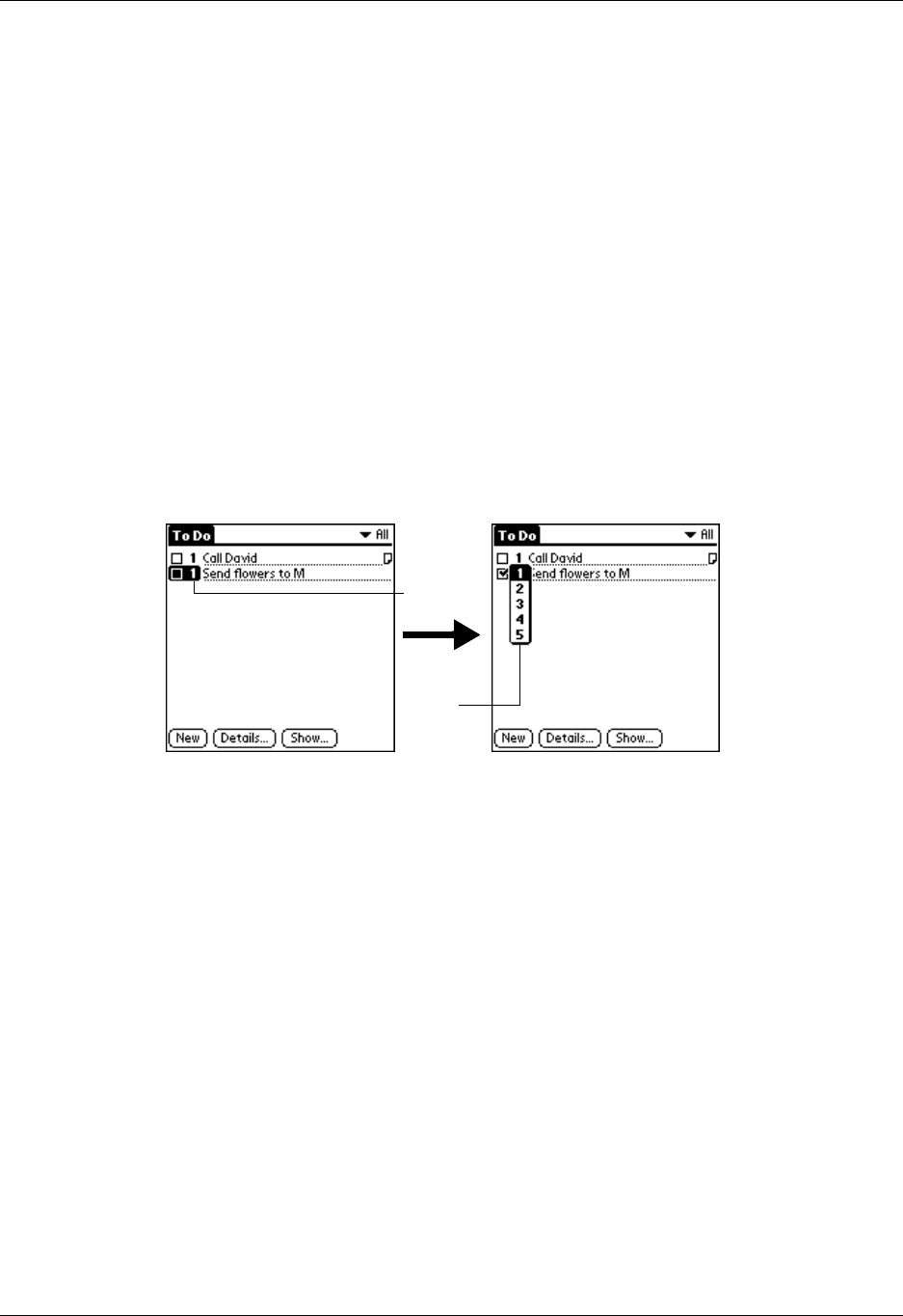
Using To Do List
120
TIP If no To Do List item is currently selected, writing in the Graffiti writing
area automatically creates a new item.
Setting Priority
The priority setting for items lets you arrange the tasks in your To Do List
according to their importance or urgency. The default setting for the To Do List is
to arrange items by priority and due date, with priority 1 items at the top. If you
have a number of items in your list, changing an item’s priority setting may move
its position in the list.
When you create a new To Do List item, its priority is automatically set to level 1,
the highest (most important) level. If you select another item first, however, the
item you create appears beneath the selected item and is given the same priority as
the selected item.
To set the priority of a To Do List item:
1. Tap the Priority number on the left side of the To Do List item.
2. Tap the Priority number that you want to set (1 is most important).
Checking Off a To Do List Item
You can check off a To Do List item to indicate that you’ve completed it. You can
set the To Do List to record the date that you complete the To Do item, and you can
choose to show or hide completed items. See “To Do Show Options” later in this
chapter.
To check off a To Do List item:
■Tap the check box on the left side of the item.
Tap to
select
priority
Tap here
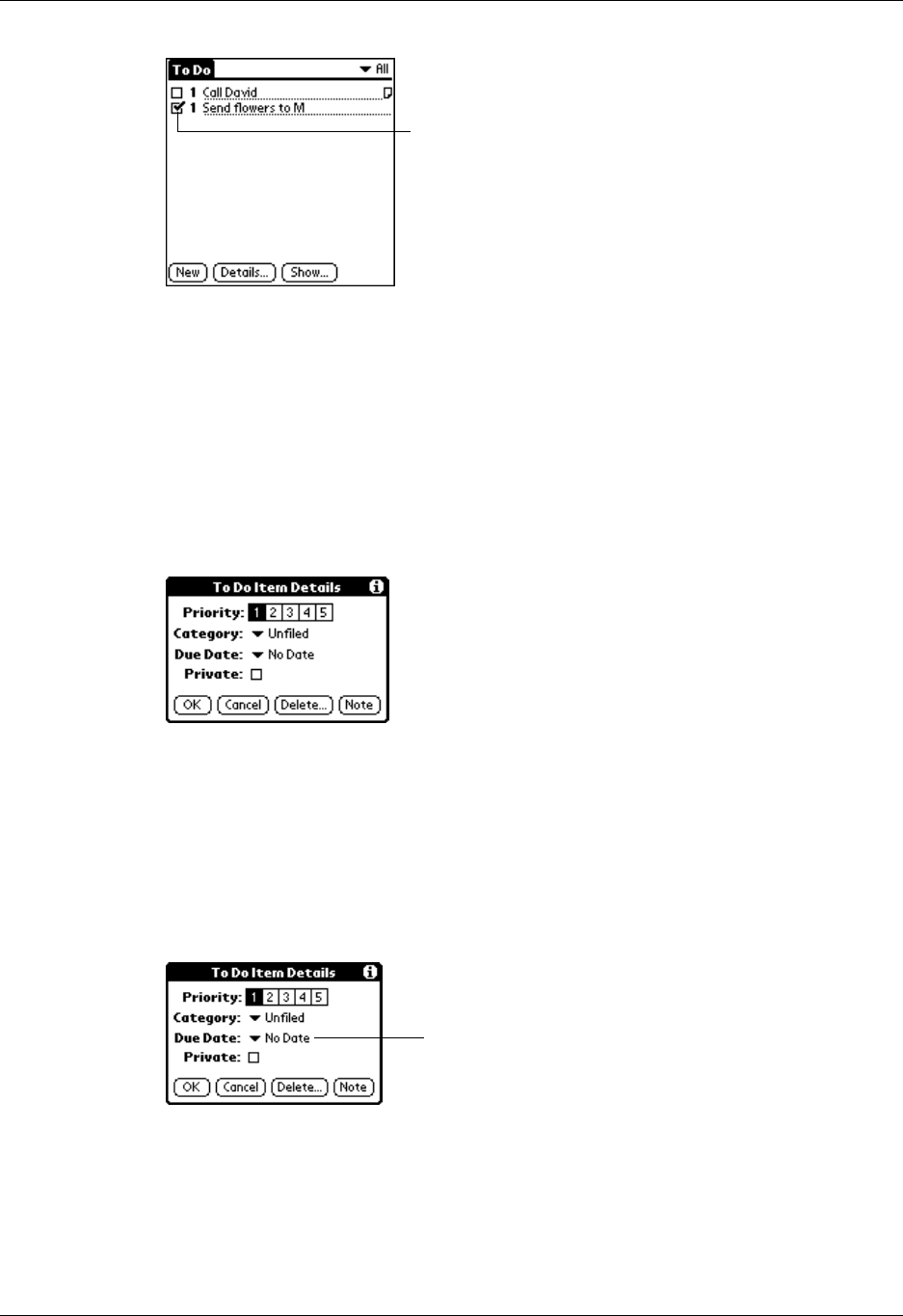
Changing To Do List Item Details
121
Changing To Do List Item Details
The To Do Item Details dialog box enables you to change settings for individual
items.
To display the To Do Item Details dialog box:
1. Tap the text of the item whose details you want to change.
2. Tap Details.
Setting a due date
You can associate a due date with any To Do List item. You can also sort the items
that appear in the list based on their due date.
To set a due date for a To Do List item:
1. In the Details dialog box, tap “No Date” to open the Due Date pick list.
2. Tap the date that you want to assign the item:
Completed
To Do item
Today Assigns the current date.
To m o r r o w Assigns tomorrow’s date.
Ta p h e r e
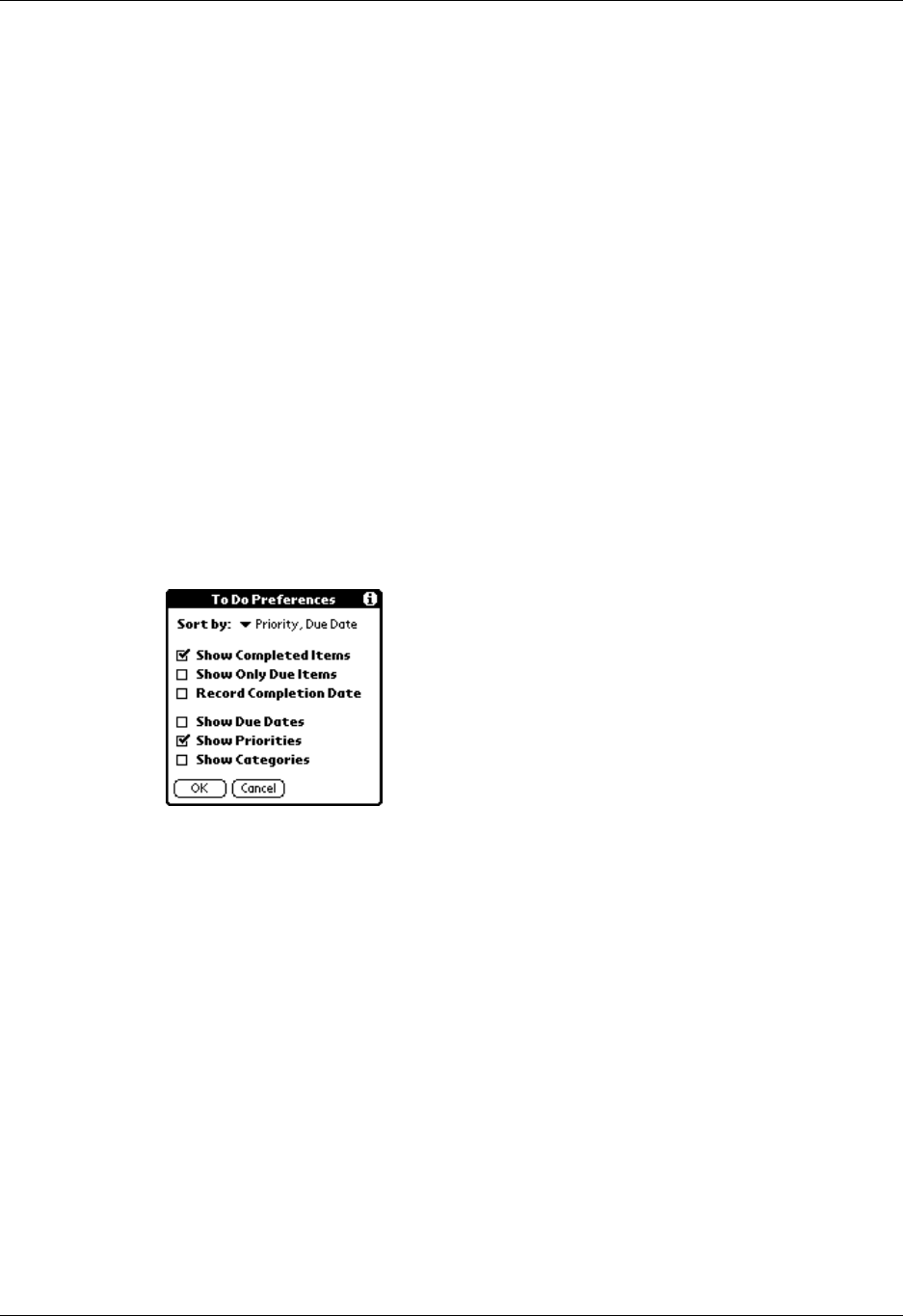
Using To Do List
122
3. Tap OK.
TIP If you turn on the Show Due Dates option in the To Do Show options
dialog, you can tap directly on the due date in the To Do List to open the pick
list shown in step 2.
To Do Show Options
The Show Options dialog box enables you to control the appearance of To Do List,
and To Do items in Date Book Agenda view.
To change the Show Options settings:
1. In To Do List, tap Show.
2. Select any of the following settings:
One week later Assigns the date exactly one week from the current
date.
No Date Removes the due date from the item.
Choose date Opens the date selector, where you can choose any
date that you want for the item.
Show Completed
Items Displays your completed items in the To Do List. If you turn off
this setting, your To Do items disappear from the list when you
complete (check) them.
Items that no longer appear on the list because you turn off
this setting have not been deleted. They are still in the
memory of your handheld. Purge completed items to remove
them from memory.
Show Only Due
Items Shows only the items that are currently due, past due, or have
no due date specified. When this setting is active, items that
are not yet due do not appear in the list until their due date.
Record
Completion Date Replaces the due date with the actual date when you complete
(check) the item. If you do not assign a due date to an item, the
completion date still records when you complete the item.
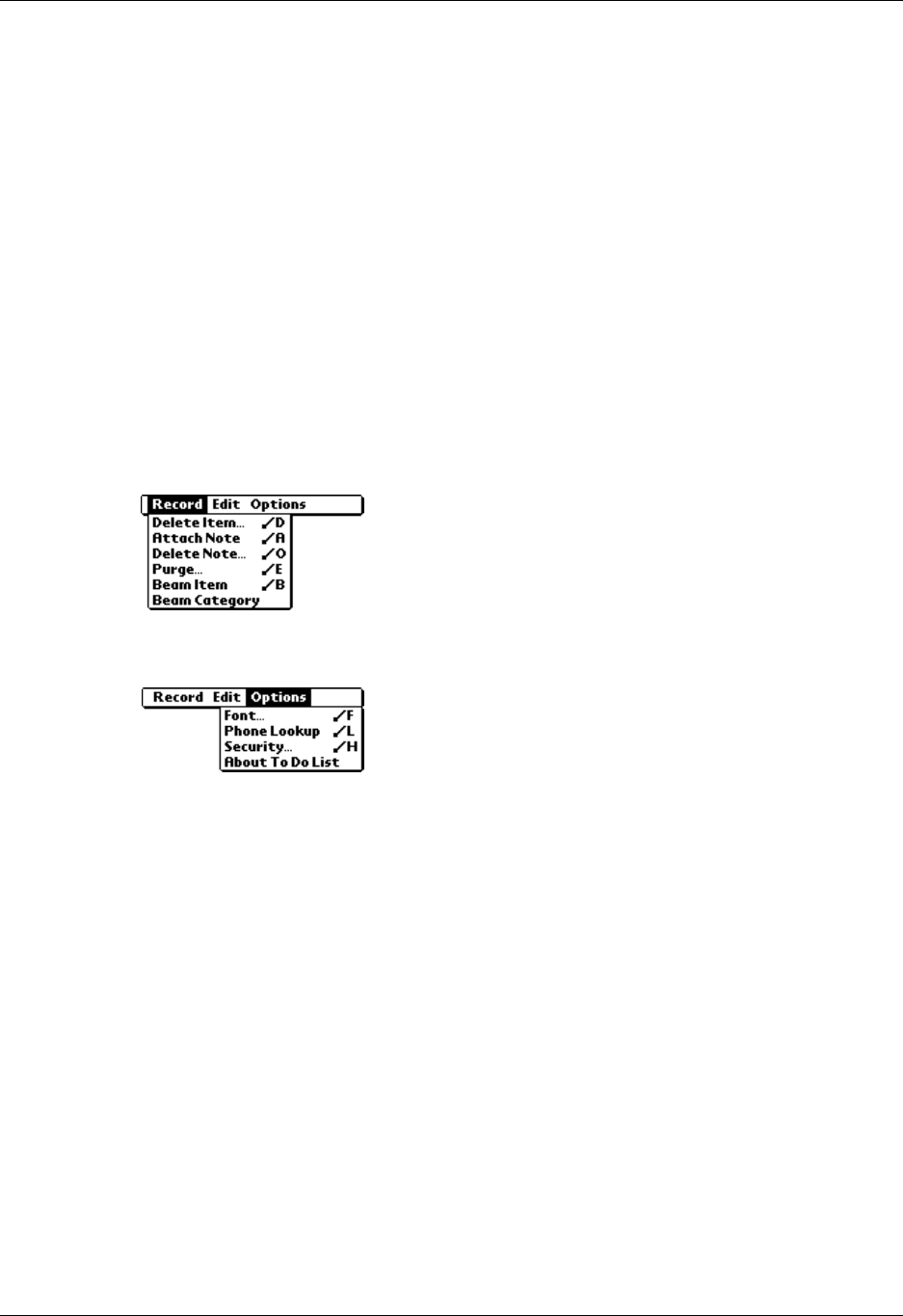
Changing To Do List Item Details
123
3. Tap OK.
To Do List menus
To Do List menus are shown here for your reference, and To Do List features that
are not explained elsewhere in this book are described here.
See “Using menus” in Chapter 5 for information about choosing menu commands.
Record menu
Options menu
Show Due Dates Displays the due dates associated with items in the To Do List
and displays an exclamation mark next to items that remain
incomplete after the due date passes.
Show Priorities Shows the priority setting for each item.
Show Categories Shows the category for each item.
About To Do List Shows version information for To Do List.

Using To Do List
124

125
CHAPTER 15
Using MultiMail® Deluxe
MultiMail® Deluxe allows you to send and receive e-mail directly from your
handheld. MultiMail Deluxe provides the following features:
■Send and receive e-mail using your Palm wireless account.
■Receive enterprise e-mail forwarded from your desktop, and reply to it.
■Notification of new e-mail messages from your Palm wireless account or your
desktop e-mail account.
■Filtering capabilities for e-mail notification, and for sorting and organizing your
e-mail based on rules you create.
■Support for SMTP, POP3, and IMAP4 protocols.
■Support for up to six e-mail accounts, in addition to your Palm wireless account
and desktop account.
■Support for blind carbon copies.
When you registered for your wireless account and activated your handheld, a
mailbox was configured to work with your Palm wireless account. If you installed
the desktop mail forwarder when you installed Palm™ Desktop software, a second
mailbox is configured on your handheld to receive your forwarded enterprise e-
mail. You can create mailboxes to access up to six additional e-mail services. See
“Configuring MultiMail Deluxe” later in this chapter for details.
To access MultiMail Deluxe:
Do one of the following:
■Press the MultiMail Deluxe button on your handheld .
Holding down the button for one second initiates message retrieval.
■Tap the Applications icon , and then tap the MultiMail Deluxe icon .
Receiving E-mail
1. Tap Get Mail.
If you have e-mail stored in your Outbox, you will see Get and Send.
2. In the Get Mail dialog box, select choices for downloading subjects only or
messages, and using filters (explained later in this chapter).
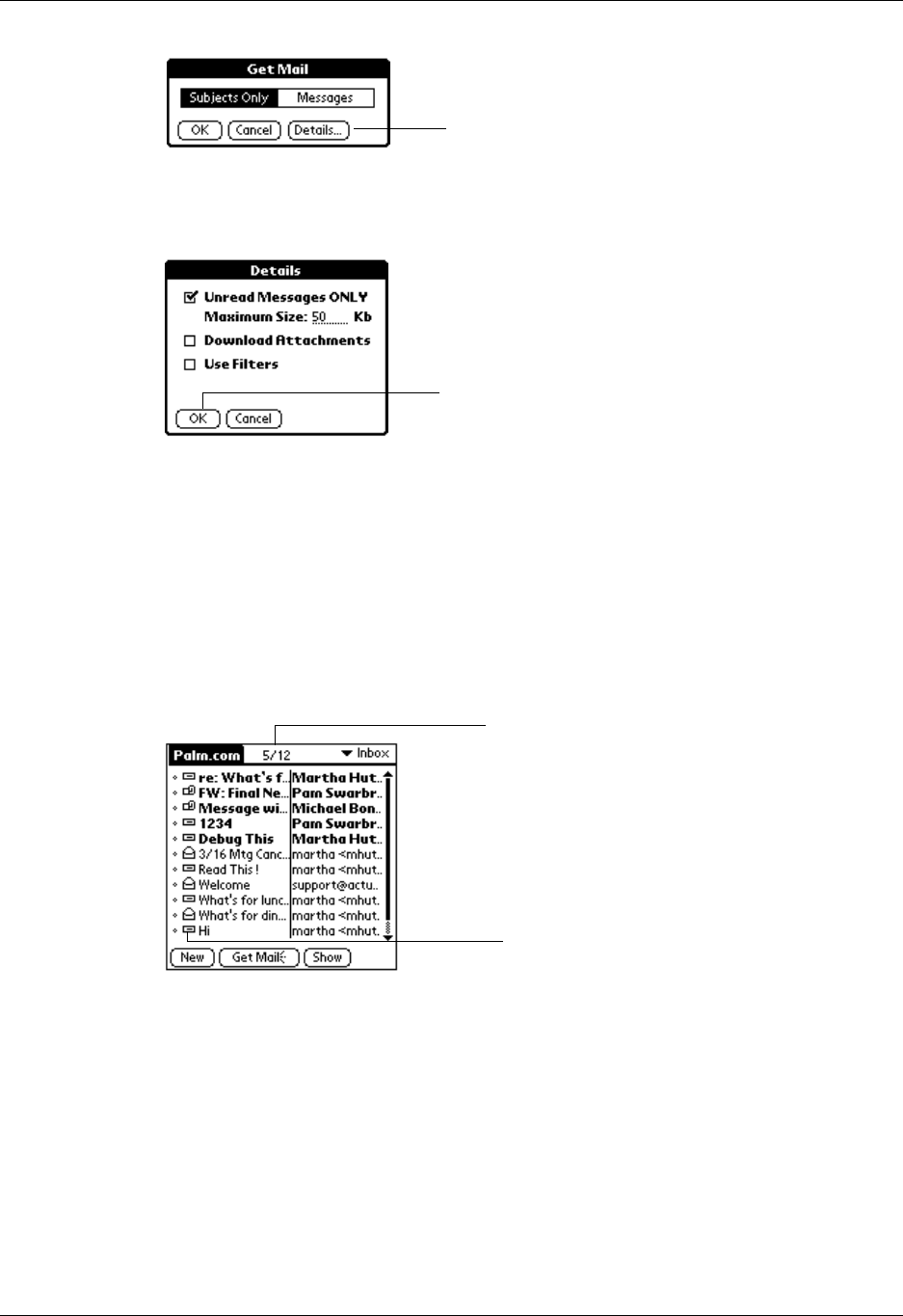
Chapter 15 Using MultiMail® Deluxe
126
3. Tap Details and select choices for maximum download size, attachments, and
filters.
4. Tap OK.
The Getting Messages dialog box appears and keeps you updated on
connection status as your e-mail is downloaded.
When the Getting Messages dialog box disappears, another dialog box appears
that tells you the number of new e-mail messages.
5. Tap OK.
A list of your e-mail appears in the Inbox.
Reading e-mail
To read e-mail, tap the item in the Inbox or another folder. The e-mail appears on
the screen.
Tap Details
Tap O K .
Shows unread/total
messages
Icons indicate
whether a message
is read, unread, has
attachments, or has
been replied to
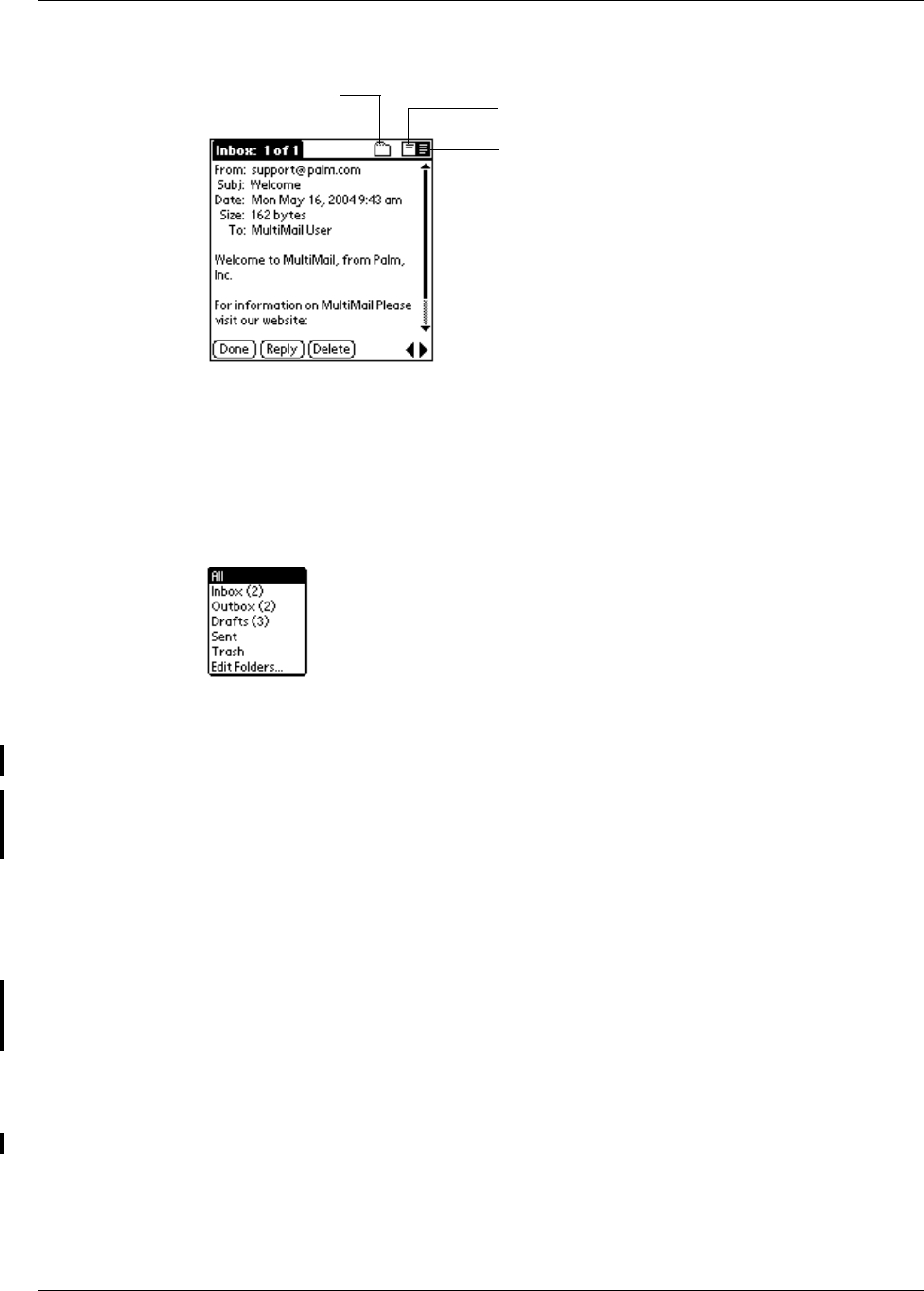
Receiving E-mail
127
Switching to other folders
When you receive e-mail, it appears in the Inbox folder. You can easily switch to
any other folder to view its contents.
1. Tap the folders pick list in the upper-right corner of the screen.
2. Tap the folder you want to view.
Moving e-mail between folders
You can move one or multiple e-mail messages between folders.
To move one e-mail:
1. Tap the folder that contains the e-mail message you want to move.
2. Tap the icon to the left of the message, and then tap Move To.
3. The folders pick list appears.
4. Tap the folder that you want to move the e-mail to.
To move multiple e-mail messages:
1. Tap the folder that contains the e-mail messages you want to move.
2. Select the messages to move by tapping to the left of each message icon.
A check mark appears next to selected messages.
3. Do one of the following:
Tap the account name, and then tap Move To on the Message menu.
View complete header
Tap to view shortened
header
Tap to move
message into a
different folder
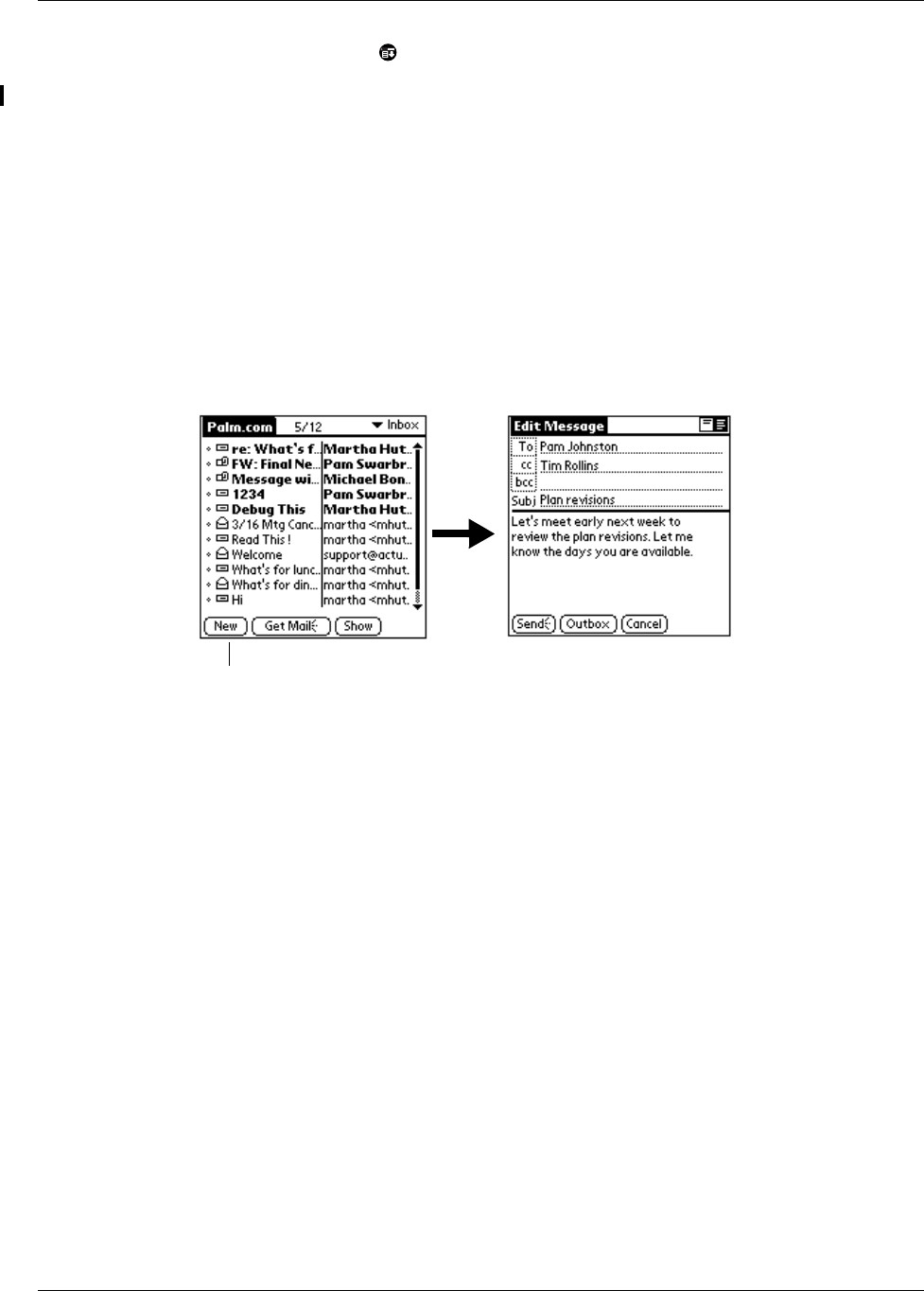
Chapter 15 Using MultiMail® Deluxe
128
Tap the Menu icon , and then tap Move To on the Message menu.
Tap a message icon next to a selected message, and then tap Move To on the pick
list.
The Folders pick list appears.
4. Tap the Folders pick list, and select a destination folder.
5. Tap OK.
Sending e-mail
To start a new e-mail:
1. Tap N ew.
2. Tap the Subject field and enter the subject of your e-mail.
Address your e-mail by entering the address until recognized or looking it up
in the Address Book.
To enter the address:
1. Tap the To field and enter the address.
If you want to edit an e-mail address that is longer than the line provided in the
New Message screen, you need to use the Graffiti® navigation strokes for
moving the cursor left and right.
If you add addresses to the same field, separate them with a comma and a space.
2. To send copies, tap cc: or bcc: and enter the address.
Copies (cc:) allow recipients see the addresses of the other recipients, but
addresses in the blind copies (bcc:) field are hidden from all other recipients.
To add an address from Address Book:
1. Tap the word To.
2. On the Recipient List screen, tap Lookup.
3. On the Email Lookup screen, tap the address you want, and then tap Add.
Ta p N e w
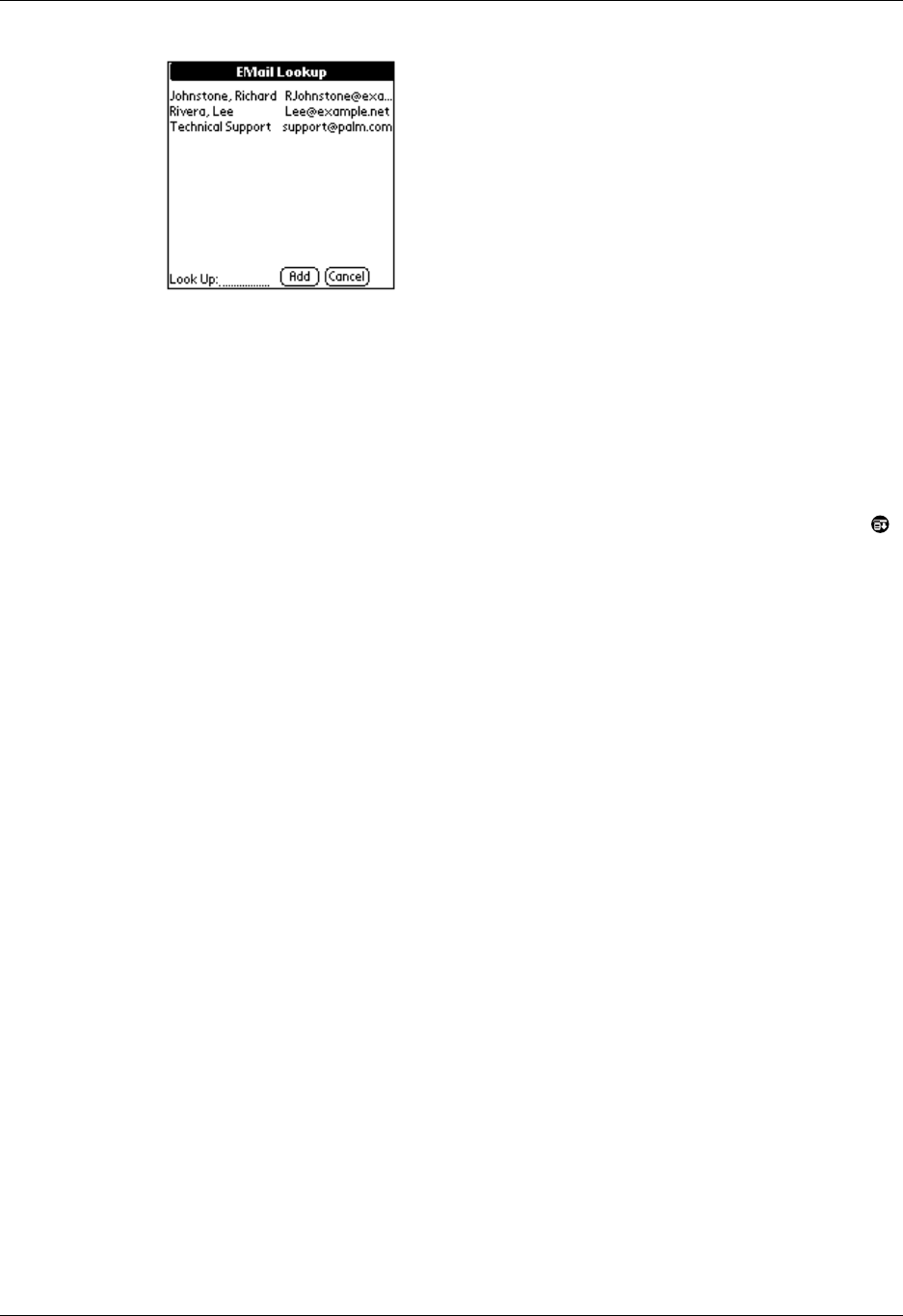
Receiving E-mail
129
4. Repeat steps 2 and 3 to add more addresses.
5. Tap Don e.
6. To enter an address in the cc: or the bcc: field, tap the field name twice, and
follow the steps given for the To field.
To compose and send an e-mail:
1. Tap the area below the Subject line and enter the text of your e-mail.
To access the editing features available on the Edit menu, tap the Menu icon .
2. Tap one of the following to send the e-mail:
Completing drafts
If you are composing an e-mail and exit MultiMail Deluxe before tapping Outbox,
Send, or Cancel, the draft e-mail is automatically moved to the Drafts folder. To
finish editing the e-mail, tap the folders pick list and select Drafts. Select the e-mail
you wish to complete or edit, and tap Edit. You can also delete the e-mail.
Replying to or forwarding e-mail
1. Tap the folders pick list and select the folder that contains the e-mail.
2. Tap the item in the list of e-mail.
3. In the View window, tap Reply.
Outbox Stores e-mail in the Outbox. This allows you to compose
e-mail offline and then send all e-mail during one connection
with the server. To send your e-mail later, go to the Outbox
and tap Send. MultiMail Deluxe initiates the connection to the
mail server and delivers all of the e-mail in the Outbox.
Send Sends the e-mail immediately. If you are not connected to the
mail server, MultiMail Deluxe initiates the connection and
sends your e-mail.
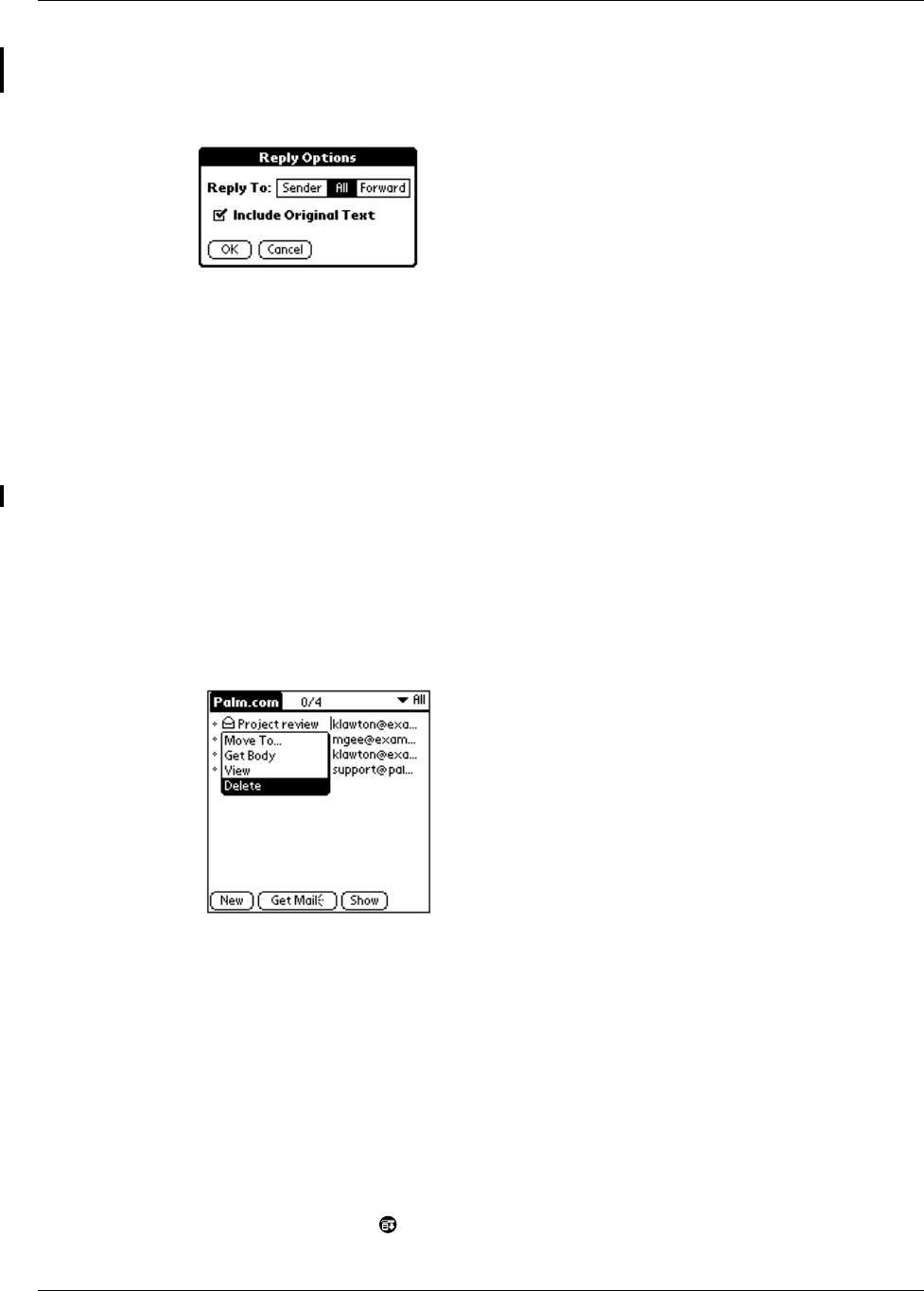
Chapter 15 Using MultiMail® Deluxe
130
4. In the Reply Options dialog box, select choices for replying to the sender, all e-
mail recipients, forwarding to new recipients, and including original message
text.
5. Tap OK.
6. The e-mail is addressed and you can enter your message.
7. Enter a reply.
8. Tap Outbox or Send to send the message.
Deleting e-mail
You can delete one or more e-mail messages at a time.
To delete one e-mail:
1. Tap the folders pick list and select the folder that contains the e-mail.
2. Tap the icon next to the message you want to delete.
3. Tap Delete.
4. Tap Yes in the Delete Confirmation dialog box.
To delete selected e-mail:
1. Tap the folders pick list and select the folder that contains the e-mail.
2. Select the e-mail that you want to delete.
3. Do one of the following
Tap the account name, and then tap Delete.
Tap the icon next to a selected e-mail message, and then tap Delete on the pick
list.
Tap the Menu icon , and then tap Delete.
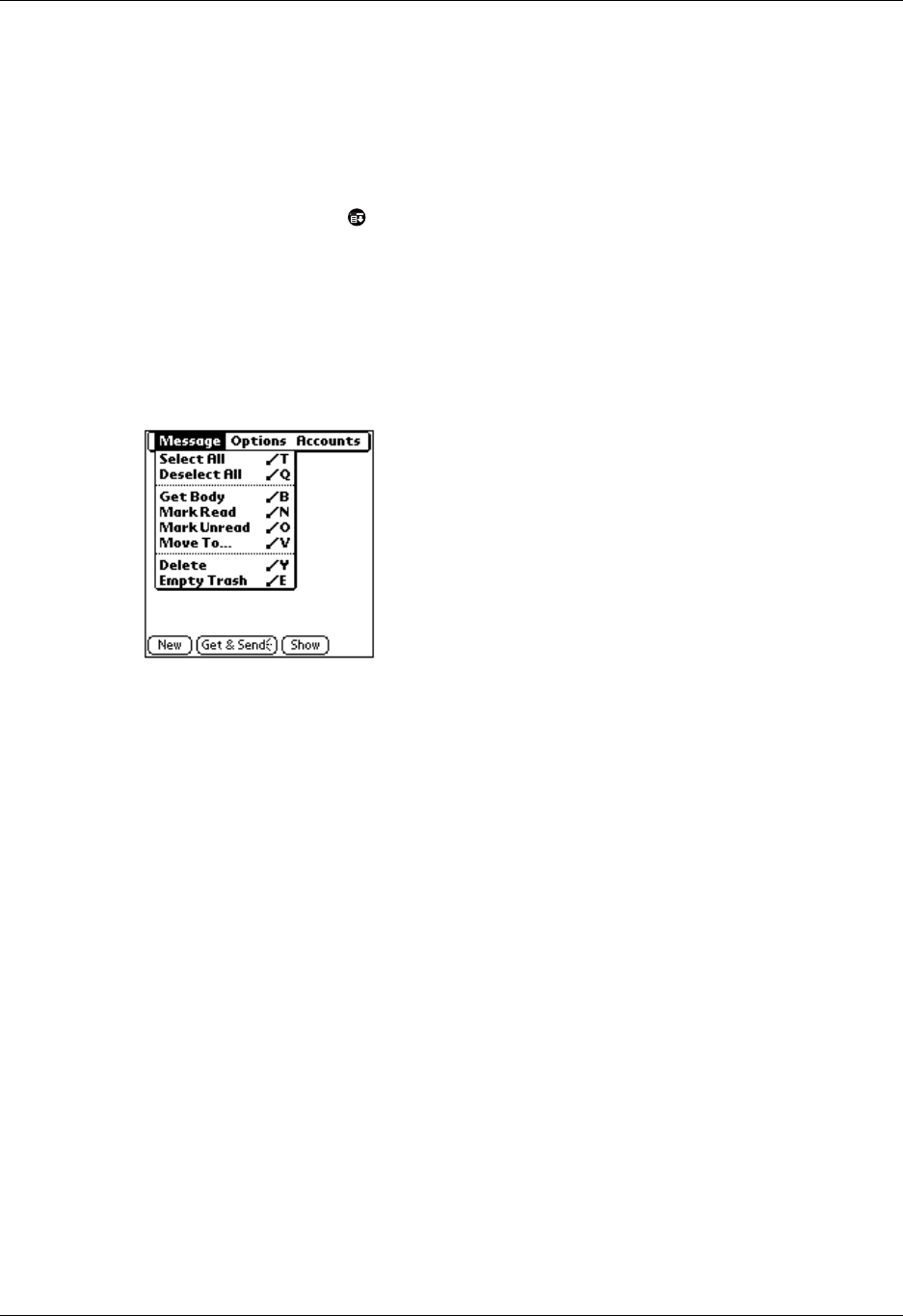
Configuring MultiMail Deluxe
131
4. Tap Yes in the Delete Confirmation dialog box.
Emptying trash
Deleted e-mail accumulates in the Trash folder and takes up space on your
handheld. To increase memory, do the following:
1. Tap the Menu icon .
2. Tap Message, and then tap Empty Trash.
Using the Message menu
You can use the Message menu to further manipulate your e-mail, and you can
select from the following options:
Configuring MultiMail Deluxe
If you have activated a Palm wireless account, a Palm wireless e-mail account is
already configured in MultiMail Deluxe. If you installed the desktop e-mail
forwarder when you installed Palm Desktop software
Select All Selects all e-mail in the current mail folder.
Deselect All Deselects all e-mail in the current mail folder.
Get Body Connects to the mail server if needed, and downloads all bodies for
selected e-mail that need to be downloaded.
Mark Read Marks all selected e-mail as “read.” An opened envelope icon
appear to the left of the message.
Mark Unread Marks all selected e-mail as unread. An unopened envelope icon
appears to the left of the message.
Move To Moves selected e-mail to the folder you specify. See “Moving e-
mail between folders” earlier in this chapter for details.
Delete Deletes all selected e-mail in the current folder.
Empty Trash Deletes all e-mail from the trash.

Chapter 15 Using MultiMail® Deluxe
132
Additional Enterprise mailbox configuration info TBD
You can configure up to six additional e-mail accounts. Each account can use one
of the following connection methods:
Before you begin
Before you configure new mailboxes, make sure you have the following
information, which is available from your mail server administrator:
■The protocol used for incoming mail
■The name of the incoming mail server
■The name of the outgoing mail (SMTP) server
■Your e-mail address
■The login script (if any) you need for connecting to your ISP or mail server
Using Account Setup
Account Setup guides you through the process of adding a mailbox.
To open account setup:
1. Tap the menu icon .
2. Tap Accounts .
3. Tap Account Setup.
To add a mailbox:
1. Tap N ex t.
2. Enter a name for the mailbox you are creating.
Palm Wireless E-mail is sent and received using your Palm wireless account.
Synchronization
Only E-mail is exchanged between your handheld and desktop
computer when you perform a HotSync operation.
Modem/Dialup E-mail is sent and received using a modem accessory or a data
enabled phone.
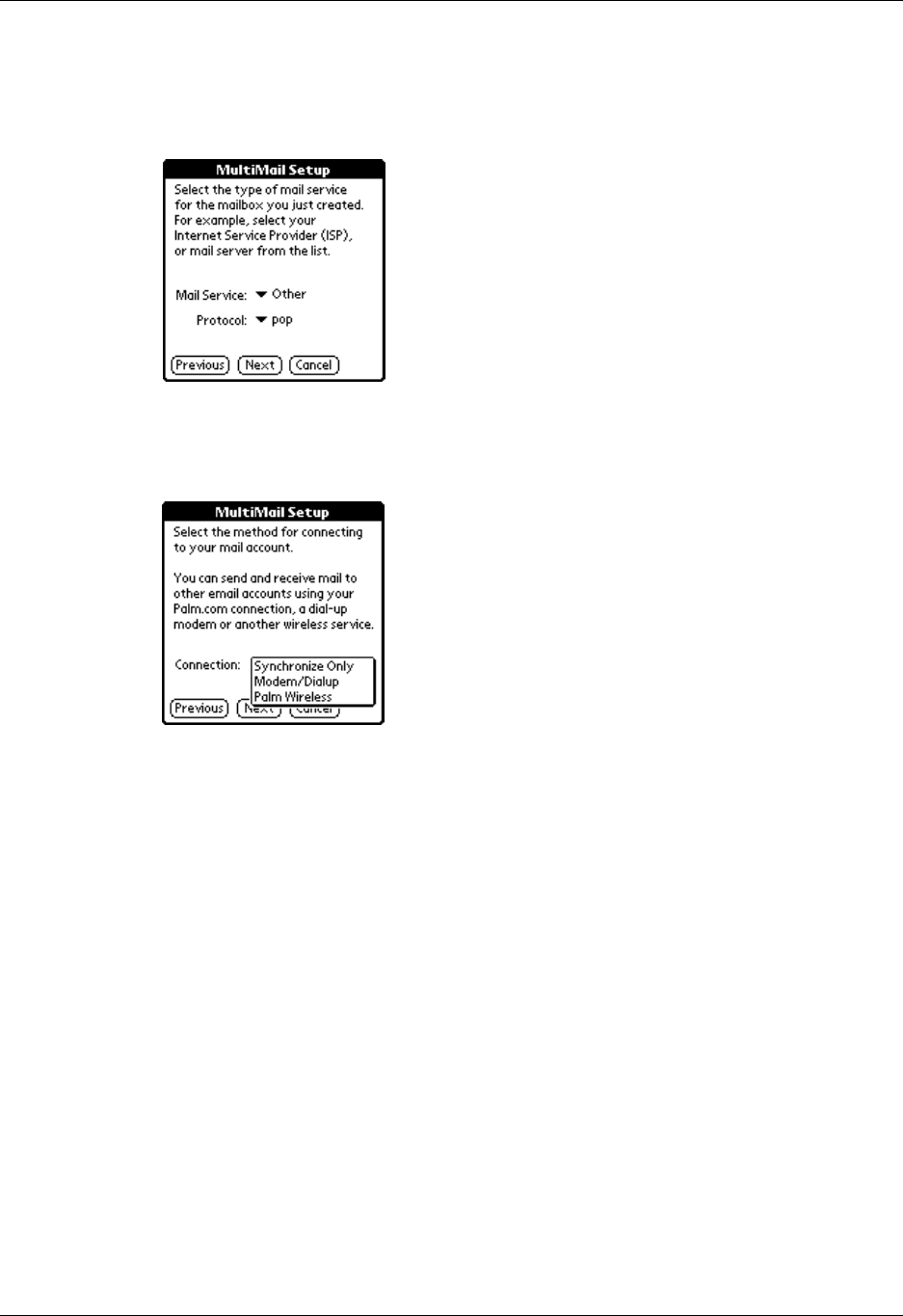
Configuring MultiMail Deluxe
133
3. Tap N ex t.
4. Tap the Mail Service pick list and select the service to which you are connecting.
Select Other if your ISP is not listed.
5. Tap the Protocol pick list and select the protocol used by this mail service, either
POP or IMAP.
6. Tap N ex t.
7. Tap the Connection pick list and select one of the following connection
methods:
The next screens in the setup process will differ based on the selected connection
method.
Synchronization
Only E-mail is exchanged between your handheld and desktop
computer when you perform a HotSync operation.
Modem/Dialup E-mail is sent and received using a modem accessory or a
data enabled phone.
Palm Wireless E-mail is sent and received using your Palm wireless
account.
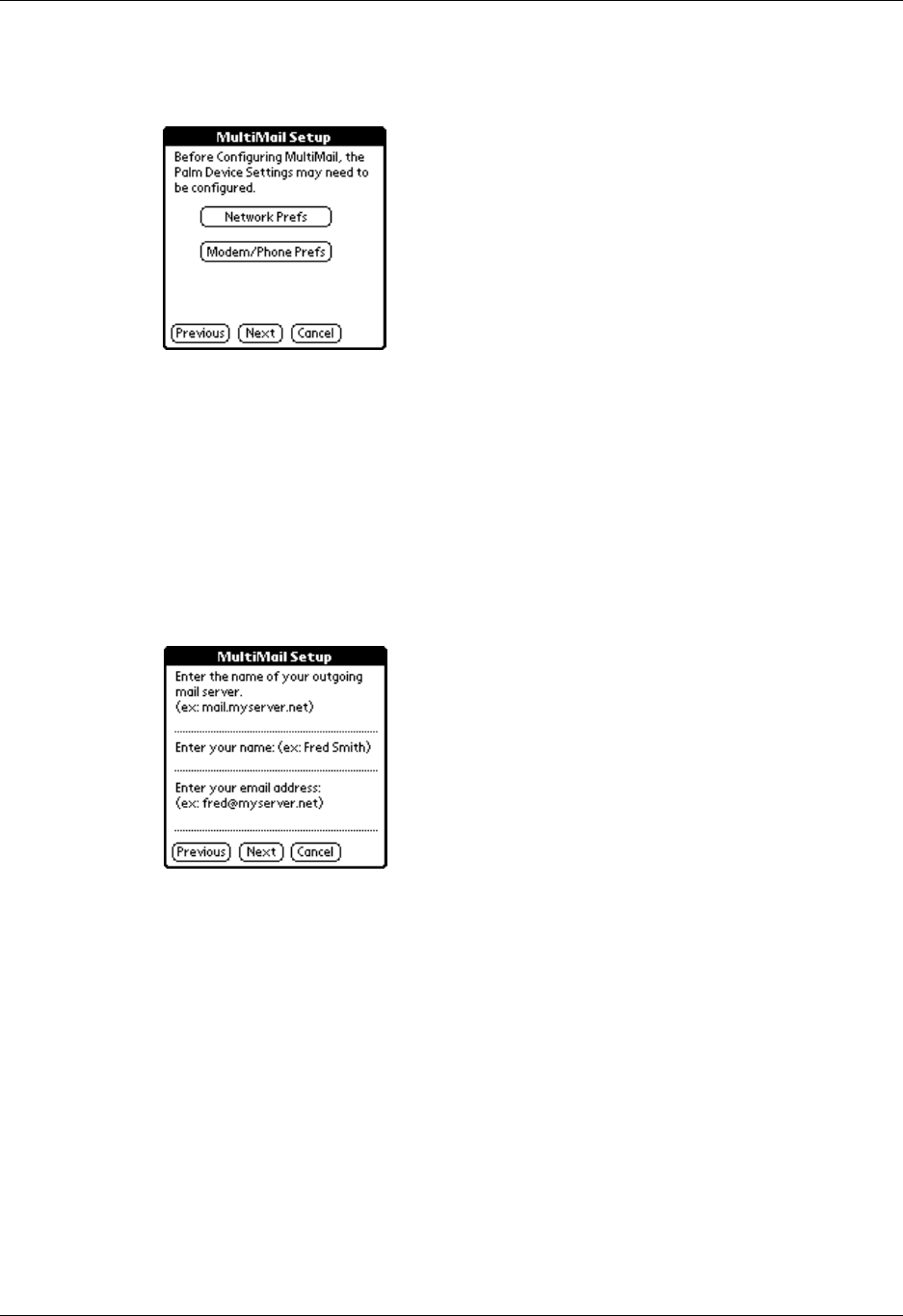
Chapter 15 Using MultiMail® Deluxe
134
To complete setup for a Modem/Dialup connection:
1. Tap Next.
2. Tap Network Prefs to adjust network settings. See “Network preferences and
TCP/IP software” in Chapter 17 for details about configuring network settings.
3. Tap Modem/Phone Prefs to adjust these settings. See “Connection preferences”
in Chapter 17 for details about configuring modem or phone settings.
When you finish adjusting these settings, tap Done to return to the Account
setup process where you will enter mail server settings.
To enter mail server settings:
1. Tap N ex t.
2. Enter the name of your outgoing mail server, and then enter your name and
your full e-mail address.
3. Tap Next and enter a signature to attach to your outgoing mail. This is optional.
4. Tap More to set options for receiving replies at a different e-mail address and
sending blind (bcc:) copies to other recipients. This is optional.
5. Tap OK.
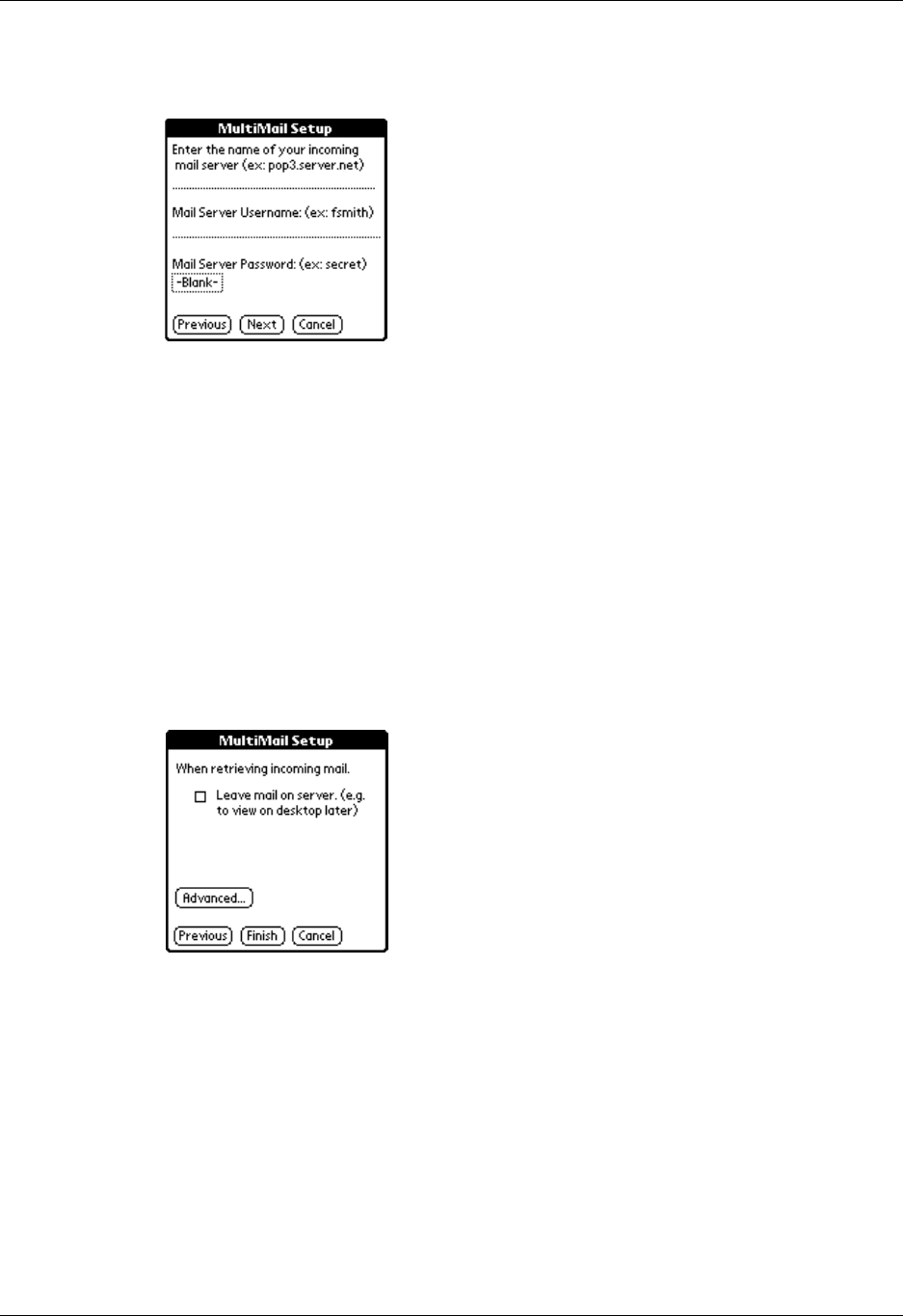
Configuring MultiMail Deluxe
135
6. Enter the name of your incoming mail server and your username (not your
entire e-mail address).
7. Tap the Mail Server Password box and enter a password.
8. Tap OK.
The next screen in the account set up process differs based on the protocol used
by the mail service.
NOTE If you are creating a POP account that connects to your desktop using
Synchronization only, you will see the same screen used for IMAP accounts.
To set mail retrieval server options for a POP account:
1. Tap N ex t.
2. If you want to view incoming mail later on your desktop, tap Leave mail on
server.
3. Tap Advanced.
4. If you want to change the maximum size of an incoming e-mail message, tap the
maximum size field and enter the size in kilobytes, as much as a maximum of ?
5. Tap the check box to delete messages on the server when they are deleted in
MultiMail Deluxe.
6. Tap OK.
7. Tap Finish.
8. Tap Don e.
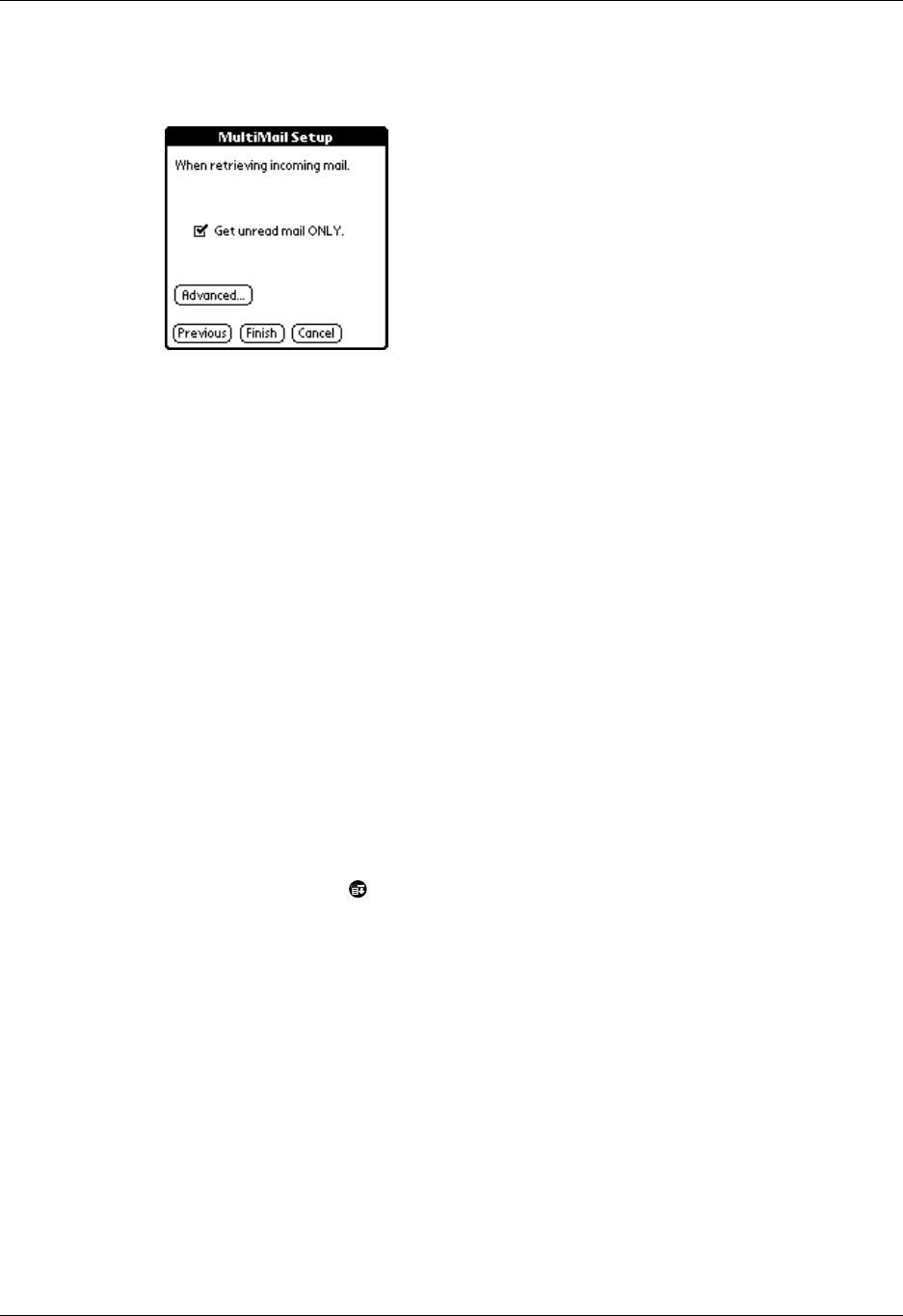
Chapter 15 Using MultiMail® Deluxe
136
To set mail retrieval server options for an IMAP account:
1. Tap N ex t.
2. If you want only unread mail to be downloaded to your handheld, tap Get
unread mail ONLY.
3. Tap Advanced.
4. If you want to change the maximum size of an incoming e-mail message, tap the
maximum size field and enter the size in kilobytes, as much as a maximum of
What is the maximum size?
5. Tap the check box to delete messages on the server when they are deleted in
MultiMail Deluxe.
6. Tap OK.
7. Tap Finish.
8. Tap Don e.
Editing e-mail accounts
From time to time, you may need to alter information about an e-mail account.
To select an account to edit:
1. Tap the menu icon .
2. Tap Options.
3. Tap Servers.
4. Tap the Account pick list, and then tap Edit Accounts.
All configured e-mail accounts appear in a list.
5. Tap the name of the account you want to change, and then tap OK.
To change your username or password:
1. Tap the username field and enter a new username.
Your username is typically the first part of your e-mail, which appears before
the @ symbol.
2. Tap the Password box and enter your password.
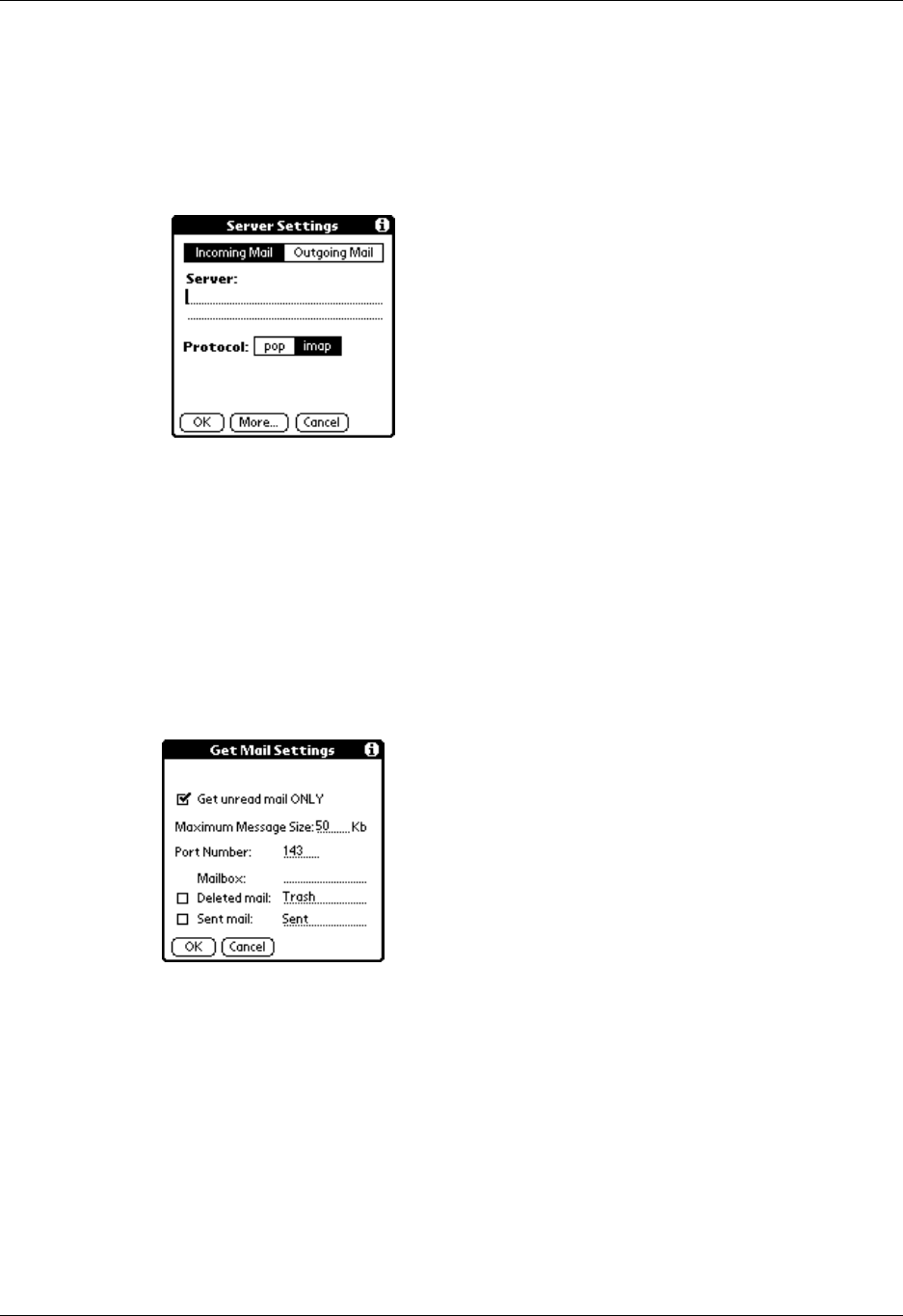
Configuring MultiMail Deluxe
137
3. Tap OK.
To change incoming mail server settings:
1. Tap Ser ver.
2. Tap Incoming Mail.
3. In the Server field, enter the name of your incoming mail (POP or IMAP) server.
4. Tap the appropriate protocol for this server: POP or IMAP.
To set additional incoming mail options:
1. Tap More .
2. Set options for getting unread mail, maximum message size, and the default
folders for storing deleted and sent mail.
What do the Port Number and Mailbox fields do here? Under what circumstances
would a user select these and what would be the expected results?
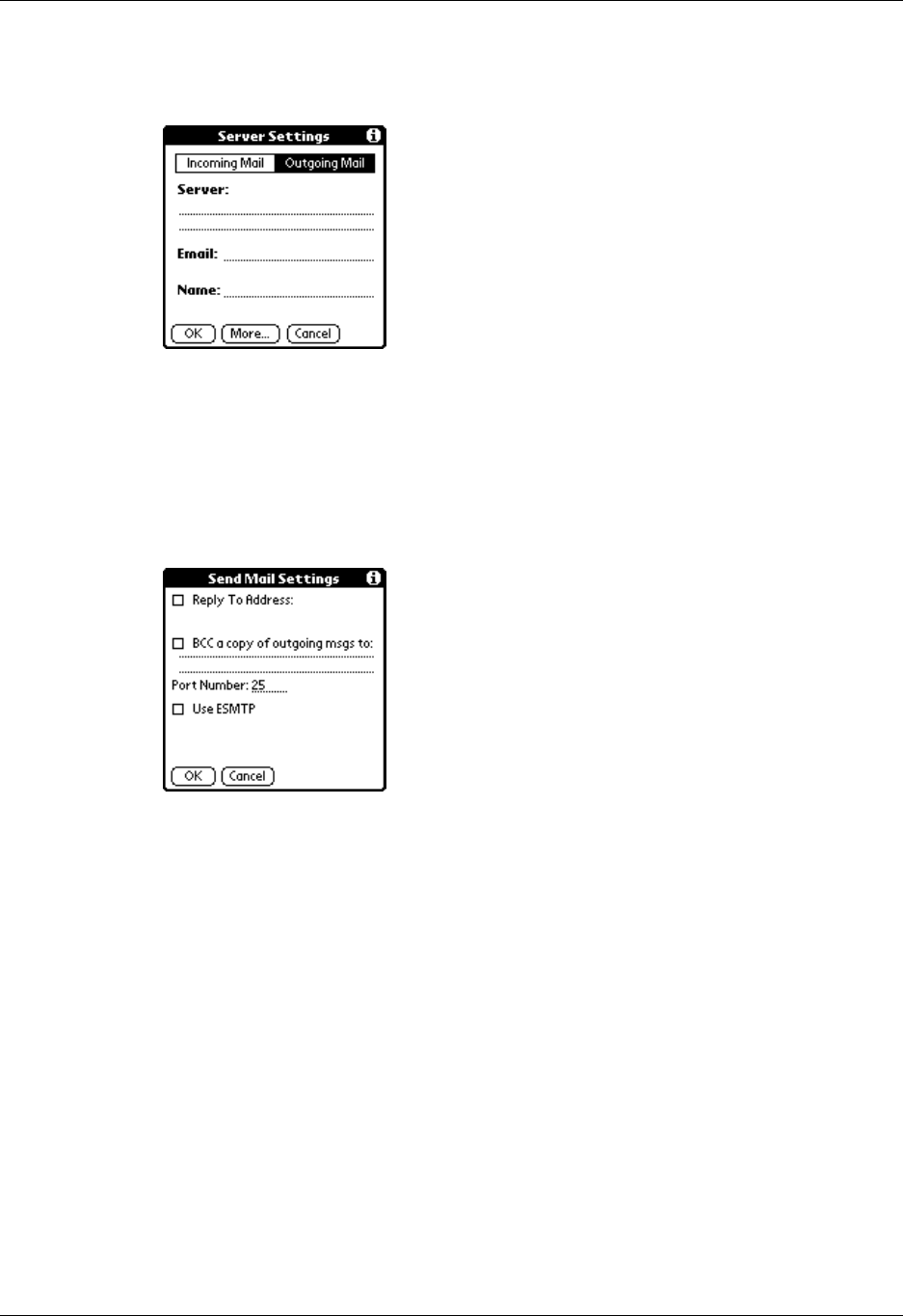
Chapter 15 Using MultiMail® Deluxe
138
To set outgoing mail server settings:
1. Tap Outgoing Mail in the Server Settings dialog box.
2. In the Server field, enter the name of your outgoing (STMP) mail server.
3. Enter your e-mail address.
4. Enter your name.
To set additional outgoing mail options:
1. Tap More and set additional options for outgoing mail.
2. Set additional options for outgoing mail:
What is ESTMP? When should a user select it? How would they know to select it?
3. Tap OK.
Reply To Address If you want replies sent to an a different e-mail address, tap the
check box and enter an alternative address.
BCC Tap the check box and enter an e-mail address to which a blind
carbon copy will be sent
Port Number If your SMTP server uses a port number other than 25, change
the Port number.
Use ESTMP
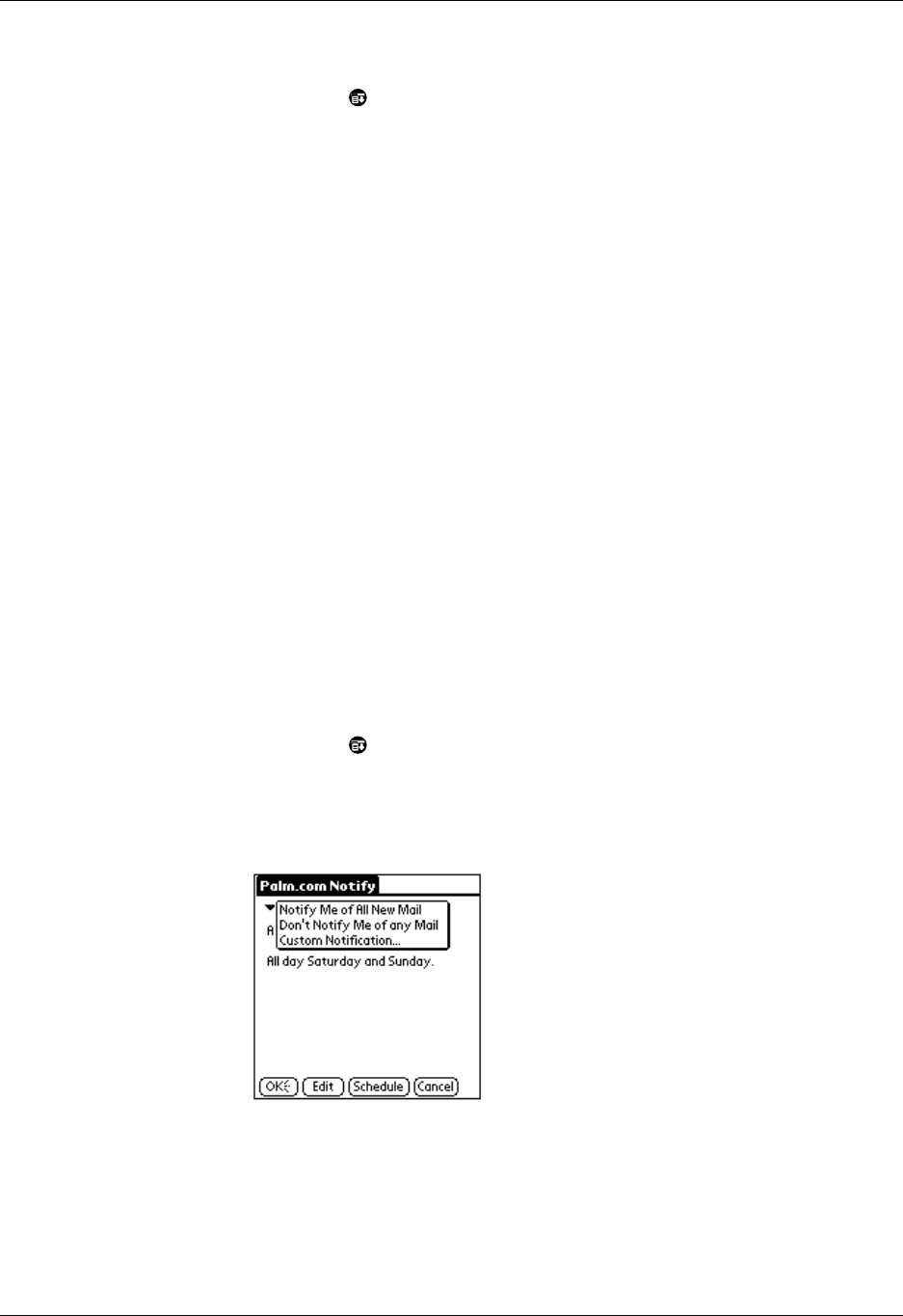
Setting Notification Options
139
Deleting an account
1. Tap the menu icon .
2. Tap Options.
3. Tap Servers.
4. Tap the Account pick list, and then tap Edit Accounts.
All configured e-mail accounts appear in a list.
5. Tap the name of the account you want to delete, and then tap Delete.
6. Tap Yes in the Delete Confirmation dialog box to delete the account and all
associated e-mail messages.
7. Tap OK.
Plugins: This appears on the Options menu. Does this menu provide attachment options?
Setting Notification Options
Notification options can be set by criteria or schedule for your Palm wireless e-mail
account and your forwarded enterprise e-mail. Notification options allow you to
select which e-mail messages prompt your handheld to notify you of their arrival.
To set notification options:
1. Tap the menu icon .
2. Tap Options.
3. Tap Notification.
4. Tap the pick list in the upper-left corner and select one of the following:
Notify me of
all new mail You are notified of all new mail whenever wireless coverage is
enabled.
Don’t Notify You receive no notifications.
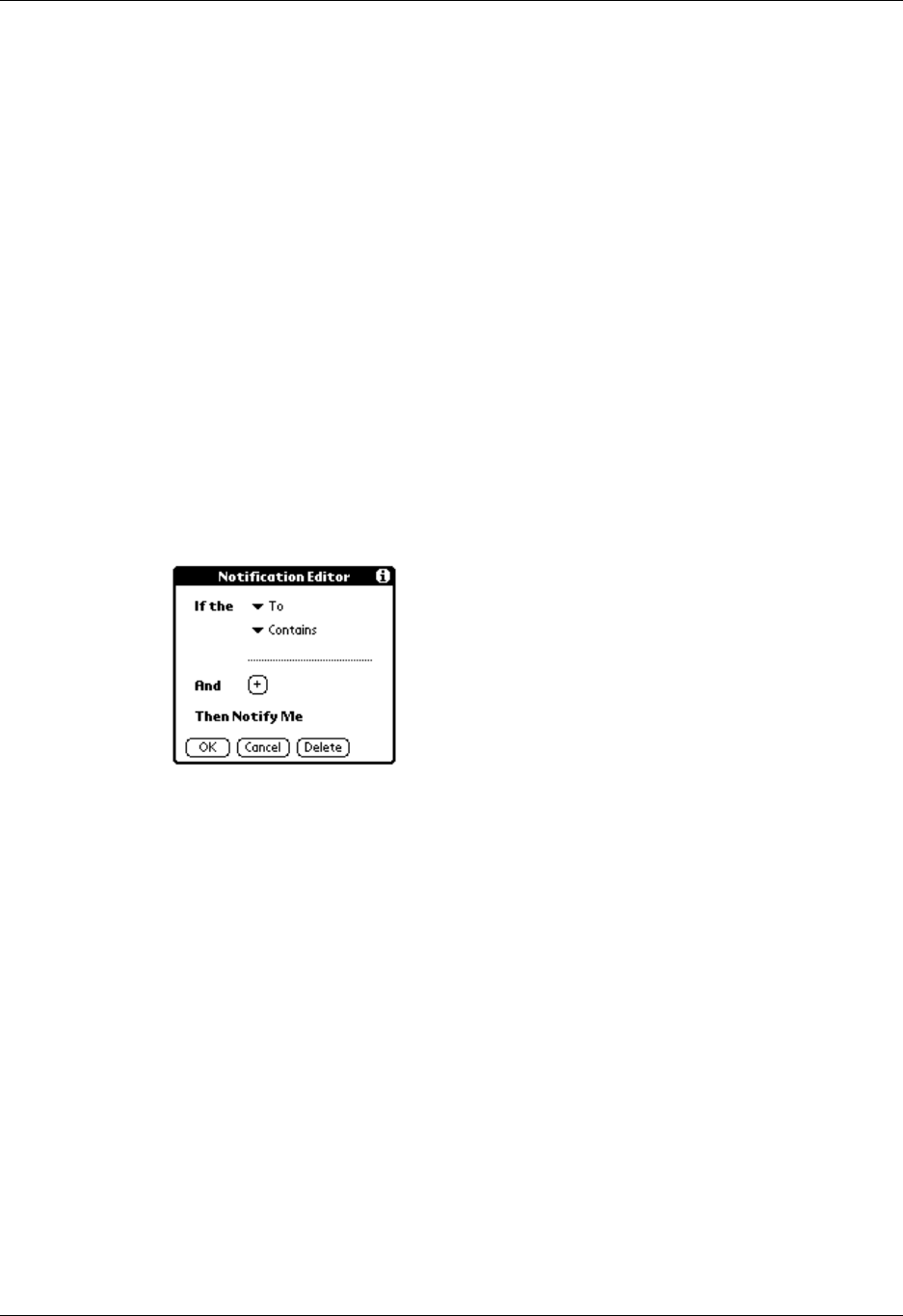
Chapter 15 Using MultiMail® Deluxe
140
Does the “Don’t Notify” setting override the wireless radio setting? Why does the
user have click twice to get to the Notification editor? Can’t the editor open when
they click Custom Notofication?
Using custom notification
The custom notification filter allows you identify the type of e-mail that prompts
an alert from your handheld.
For example, when you travel, you may want to be alerted only to e-mail sent by
your manager regarding a particular project. You can create a filter that permits
notification only when e-mail meets these conditions.
To create a custom notification filter:
1. Tap Custom Notification.
2. Tap Edit.
3. Use the If the pick lists to create criteria for the notification filter.
The two pick lists and the edit line combine to create a statement that identifies
the type of e-mail that triggers notification. For example, a filter might read, “If
the [From] [Contains] mweston@example.com, Then Notify Me.”
You can also use the And button to create a more complex statement, such as “If
the [From] [Contains] mweston@example.com, And if the [Subject] [Starts with]
Apollo Project, Then Notify Me.”
When you use this notification filter, only e-mail matching these conditions
prompts a notification alert on your handheld.
Custom Allows you to set conditions that e-mail must meet in order to
trigger an alert.
To pick list Select the header field with the information contained in the
edit line: To, From, Subject.
Contains pick
list
Select a filter action: Contains, Starts with, Does NOT Contain.
Edit line Enter the text that must be found in the header field. For
example, if you want to be notified of only e-mail whose
Subject is the Apollo Project, enter “Apollo Project.”
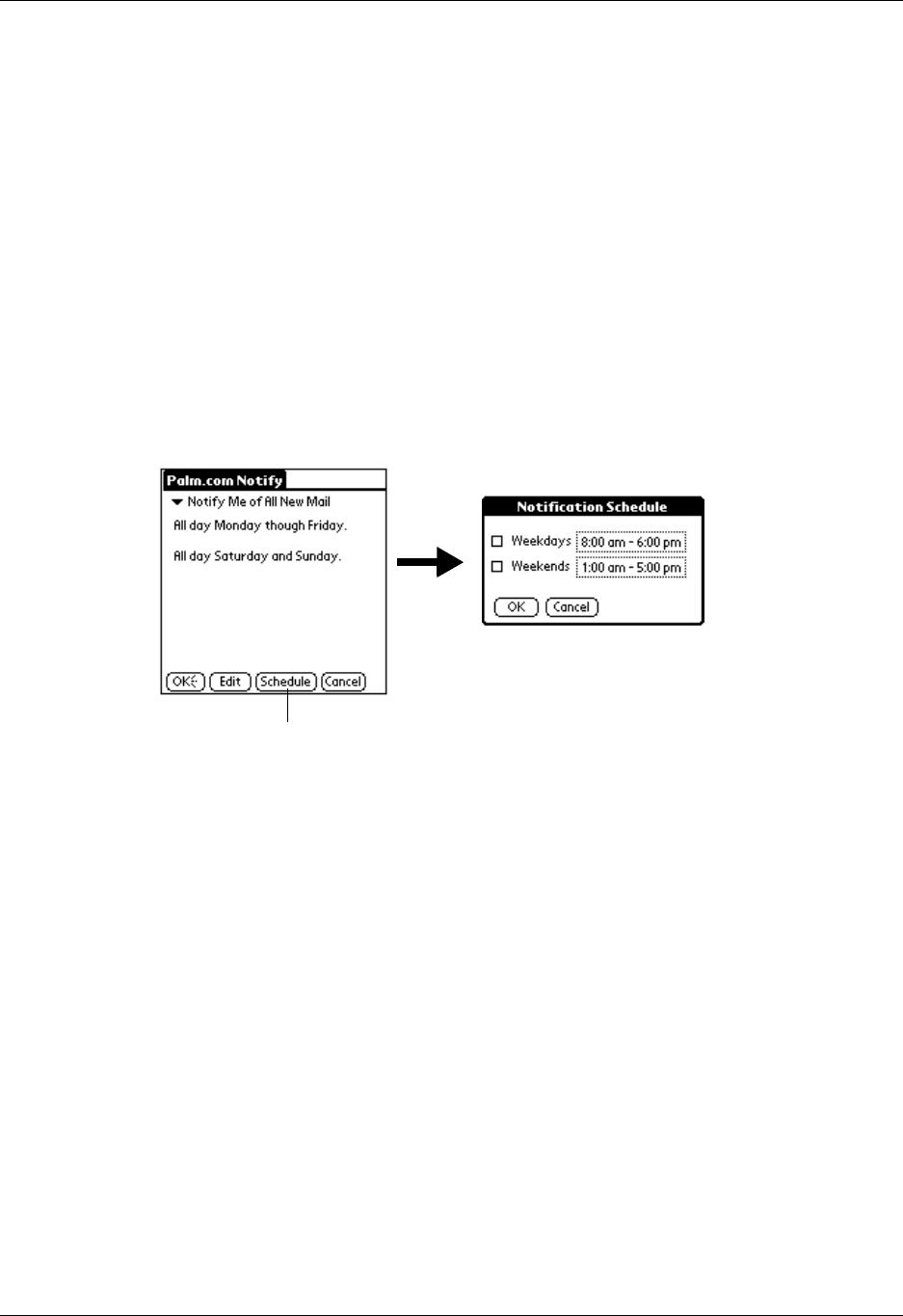
Setting Notification Options
141
4. Tap OK.
5. Tap OK.
Scheduling notification
Your handheld alerts you to e-mail received by your Palm wireless account and
your forwarded enterprise account whenever wireless coverage is enabled. Use the
notification schedule if you want to limit e-mail alerts to certain hours.
To schedule notification:
1. Tap schedule.
2. Tap the Weekdays time box.
The Set Notification Times dialog box appears.
3. Tap Start Time, and then tap to adjust the hour and minutes.
4. Tap End Time, and then tap to adjust the hour and minutes.
5. Tap OK.
6. Tap the Weekdays check box.
7. Tap the Weekends time box.
The Set Notification Times dialog box appears.
8. Repeat steps 3 through 5.
9. Tap the Weekends check box.
10. Tap O K .
11. Ta p OK.
And button Use to further refine the notification criteria by linking two
conditions together.
Tap Schedule
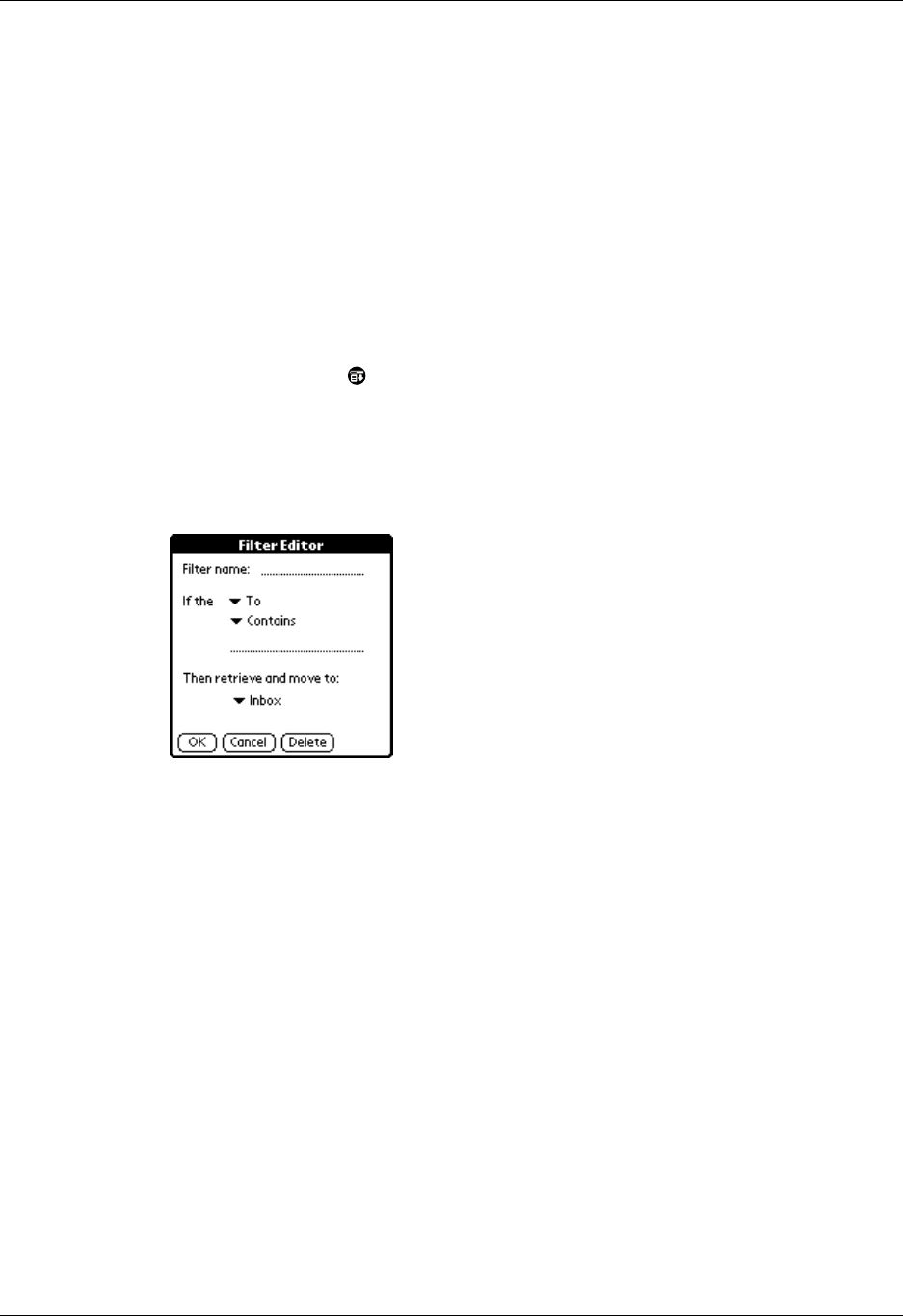
Chapter 15 Using MultiMail® Deluxe
142
Creating Filters
The FRD seems to indicate that filters only affect sorting of incoming e-mail. Yet some of
the UI indicates it affects e-mail retrieval. Which is correct? How does this work with
notifications and email being pushed to the device?
Filters allow you to sort any incoming e-mail into a folder or mailbox you identify,
to make reading them faster and easier.
For example, you may want to file e-mail about sales meetings into a specific
folder. You can create a filter that automates this action, so that whenever you
receive an e-mail about sales meetings, it is immediately sent to the sales folder.
To create a filter:
1. Tap the Menu icon .
2. Tap Options, and then tap Filters.
3. Tap Add.
4. Tap the Filter name field and enter a short description of the filter.
5. Use the If the pick lists to create criteria for the filter.
The three pick lists and the edit line combine to create a statement that identifies
the type of e-mail and what you want to do with the e-mail. For example, a filter
might read, “If the [Subject] [Contains] sales meeting, Then retrieve and move
to [Sales].” When you use this filter to sort incoming e-mail, any e-mail
containing sales in the subject line is filed in the Sales folder.
To pick list Select the header field with the information contained in the
edit line: To, From, Subject, cc, Date, Size.
Contains pick
list
Select a filter action: Contains, Starts with, Does NOT Contain.
Edit line Enter the text that must be found in the header field. For
example, if you want to sort e-mail whose Subject is Sales,
enter “Sales.” If you enter more than one address, separate
them with a comma.
Inbox pick list Select the folder or mailbox into which you want your
filtered e-mail to go.
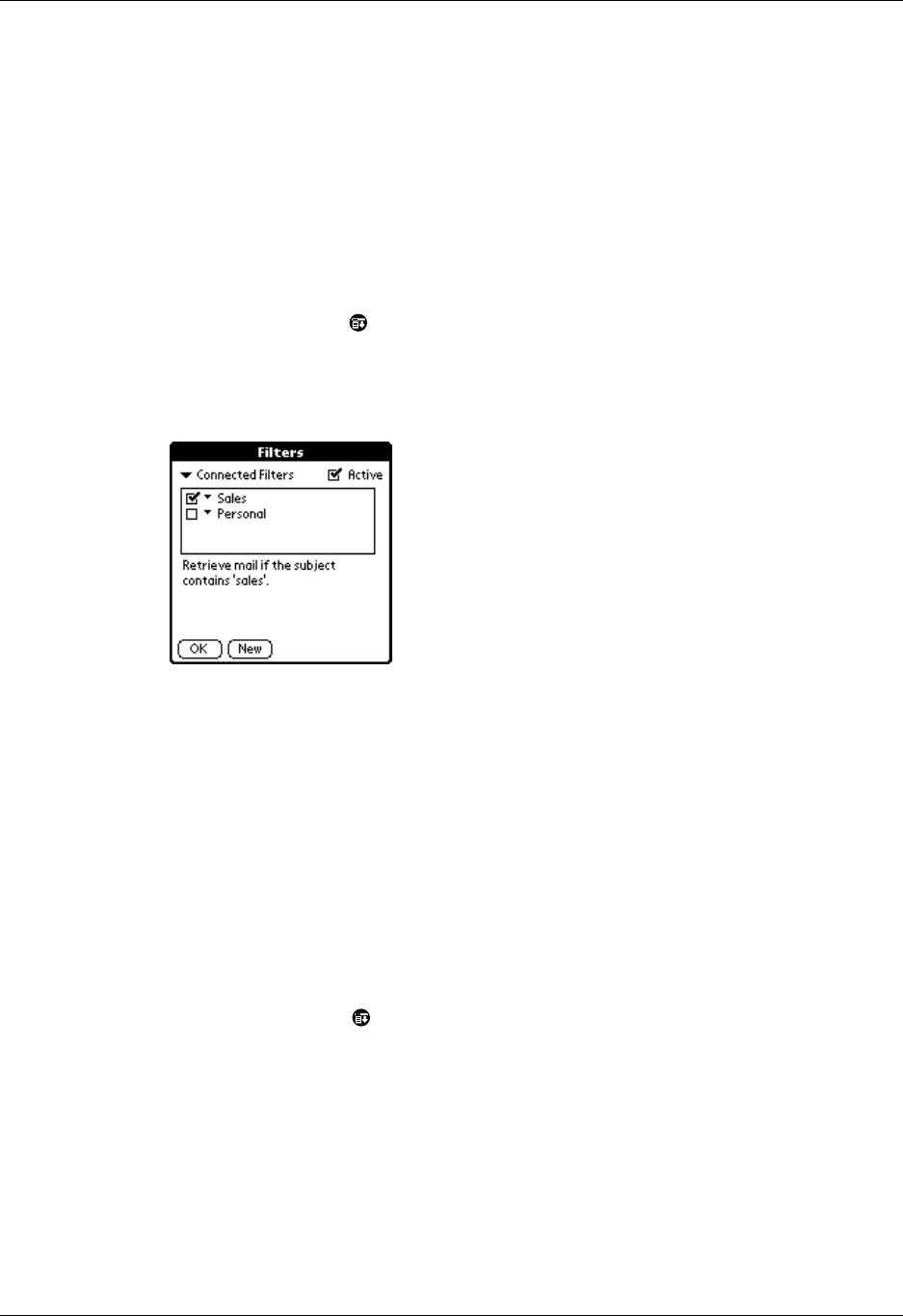
Creating Filters
143
6. Tap OK.
The filter appears in the Filters list.
7. Tap OK.
By default, a filter is selected for use and affects all subsequent downloads of e-
mail until you deselect it. More than one filter can be in effect at once. Before you
download e-mail, be sure the filters you want are turned on and the ones you don’t
want are turned off.
To turn a filter on or off:
1. Tap the Menu icon .
2. Tap Options, and then tap Filters.
The Filters dialog box appears, listing the filters you created.
3. Tap the filter check boxes to select those filters you want to work for a
subsequent e-mail download.
A check mark next to a filter means that it is selected. To remove a check mark,
tap the check box. To add a check mark, tap an empty check box.
4. Tap the Active check box to apply the selected filters.
5. Tap OK.
What is the function of "Connected Filters" and "Synchronize Filters" choices on the
pick list in the upper left corner of this screen? Under what conditions should a
user choose each of these, and what will the results be?
To edit or delete a filter:
1. Tap the Menu icon .
2. Tap Options, and then tap Filters.
The Filters dialog box appears, listing the filters you created.
3. Tap the name of the filter.
The Filter Editor dialog box appears.
4. Do one of the following:
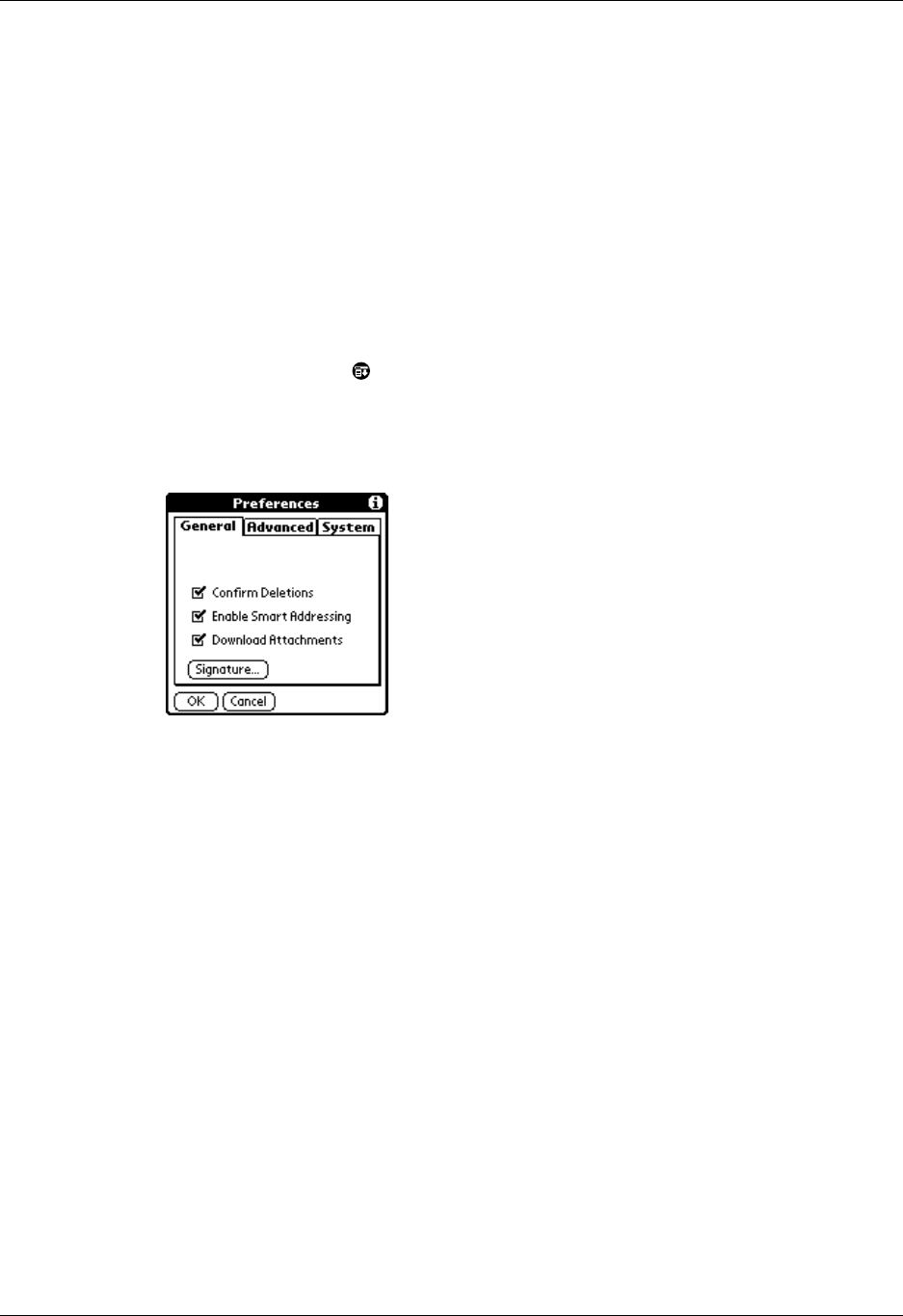
Chapter 15 Using MultiMail® Deluxe
144
To edit the filter, revise your selections in the pick lists and revise the text in the
edit line. Tap OK.
To delete the filter, tap Delete, and then tap Yes to confirm deletion.
5. Tap OK.
Setting MultiMail Deluxe Preferences
Preferences allow you to set preferences for how MultiMail Deluxe handles your
e-mail.
To set General preferences:
1. Tap the Menu icon .
2. Tap Options.
3. Tap Preferences.
4. Select preferences:
Confirm
Deletions
Displays a confirmation dialog before executing e-mail
deletions.
Enable Smart
Addressing
Allows MultiMail Deluxe to type ahead and complete an e-mail
address when recognized.
Download
Attachments
Enables files attached to e-mail to be downloaded to your
handheld.
Signature Allows you to attach a default signature to all your outgoing
messages. Tap Signature, and then enter information in the
signature dialog box.

Setting MultiMail Deluxe Preferences
145
To set Advanced Preferences:
1. Tap Advanced.
2. Select preferences:
The rest of the settings only appear for accounts that use a modem/dialup
connection:
Delete Mssgs on
Server
Deletes messages on the server that you have deleted on your
handheld. This option is not available for POP accounts that
use a modem/dialup connection.
Timeout Sets the number of seconds that Mail tries to connect before
timing out. If you are using a wireless modem or an adapter
with a cellular phone, this value should be greater than 45
seconds.
To change, tap the Timeout field and enter a new value.
Auto-
Disconnect
Automatically disconnects your remote connections after each
command. This feature is especially useful for wireless
modems.
Disconnect on
Exit
Disconnects from the modem only after you leave the E-mail
application. This feature is an alternative to AutoDisconnect.
Modem Wait If you have a wireless modem and want to give the modem a
few seconds to initialize itself, tap and enter a number of
seconds for the wait. The typical setting for a wireless modem
is 3, and the typical setting for most normal modems is 0.

Chapter 15 Using MultiMail® Deluxe
146
To set System Preferences:
1. Tap System.
2. Select a preference:
3. Tap OK.
Backup ALL
Databases
Enables backing up the e-mail database. Deselecting this
option allows you to increase the speed of HotSync®
operations by not backing up the mail database. Because in
most cases your mail is on your server, you do not need to
back up your e-mail database from your handheld.

147
CHAPTER 16
Performing HotSync® Operations
HotSync® technology enables you to synchronize data between one or more Palm
OS® handhelds and Palm™ Desktop software or another PIM such as Microsoft
Outlook. To synchronize data, you must connect your handheld and Palm
Desktop software. You can synchronize your data either directly or indirectly.
Direct methods include placing your handheld in the cradle attached to your
computer, or using infrared communications. Indirect methods include using a
modem, or using network HotSync technology.
Selecting HotSync Setup Options
You can choose when you want HotSync Manager to run. If necessary, you can
adjust the local and modem HotSync settings as well.
To set the HotSync options on a Windows computer:
1. Click the HotSync Manager icon in the Windows system tray.
2. Choose Setup.
3. Click the General tab and select one of the following options:
Always available Adds HotSync Manager to the Startup folder and
constantly monitors the communication port for
synchronization requests from your handheld. With this
option, the HotSync Manager synchronizes data even
when Palm Desktop software is not running.
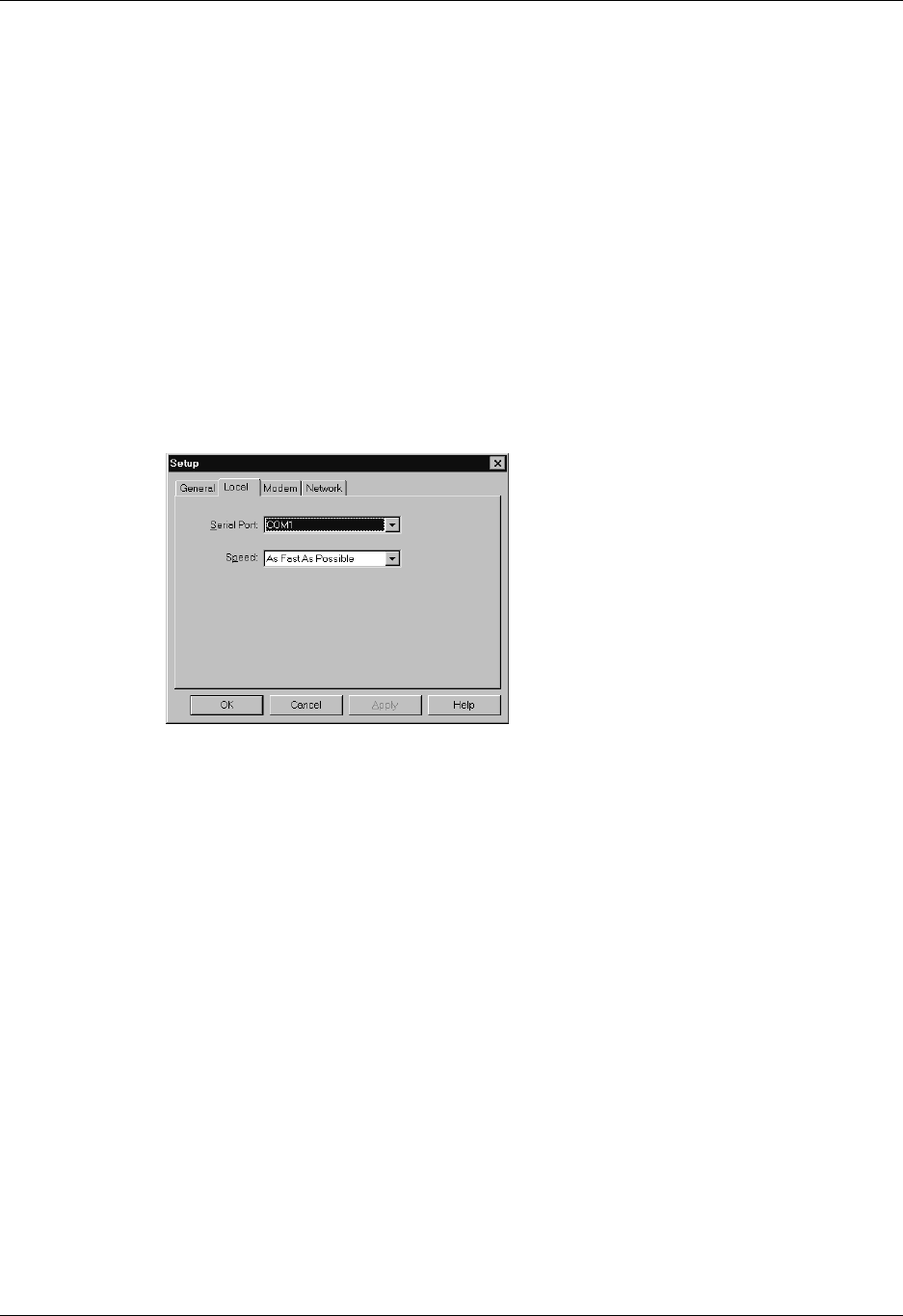
Performing HotSync® Operations
148
If you’re not sure which option to use, keep the default setting: Always
available.
4. If you are using a serial cradle, click Local tab to display the settings for the
connection between your computer and the handheld cradle, and adjust the
following options as needed.
If you are using the USB cradle, you do not need to use the settings on the Local
tab for a direct HotSync operation.
5. Click the Modem tab to display the modem settings and adjust the options as
needed. See “Conducting a HotSync Operation Via Modem” later in this
chapter for more information.
6. If you are attached to a network, click the Network tab to display the network
settings and adjust the options as needed. See “Conducting a HotSync
Operation via a Network” later in this chapter for more information.
7. Click OK.
Available only
when Palm
Desktop software is
running
Starts HotSync Manager and monitors requests
automatically when you open Palm Desktop software.
Manual Monitors requests only when you select HotSync Manager
from the Start menu.
Serial Port Identifies the port that HotSync Manager uses to communicate
with the cradle. The Palm Desktop installation software
automatically detects the port to which you connected the
cradle. If necessary, you can change the port selection.
Your handheld cannot share this port with an internal modem
or other device.
Speed Determines the speed at which data is transferred between
your handheld and Palm Desktop software. Try the As Fast As
Possible rate first, and adjust downward if you experience
problems. This setting allows Palm Desktop software and your
handheld to find and use the fastest speed.

Selecting HotSync Setup Options
149
To set the HotSync options on a Macintosh:
1. Double-click the HotSync Manager icon in the Palm folder.
2. Click the HotSync Controls tab and select any of the following options:
3. If you are using the USB cradle, you do not need to adjust the settings on the
Serial Port Settings tab for a direct HotSync operation; they are automatically
set when you perform the first HotSync operation.
HotSync
Enabled/
Disabled
Activates the serial port monitor and prepares your Macintosh
to synchronize with your handheld. By default, the serial port
monitor is enabled whenever you start your Macintosh. Keep
this default if your HotSync cradle is always connected to a
specific port (USB, serial, or modem). If, however, you use the
same port for other devices besides the HotSync cradle,
disable the serial port monitor and then enable it manually only
when you connect the cradle to perform a HotSync operation.
Enable HotSync
software at
system startup
Activates the serial port monitor automatically each time you
start your computer. If this option is not checked, you must
open HotSync Manager and select the Enabled option before
you can perform a HotSync operation.
Show more
detail in HotSync
Log
Includes more troubleshooting information in the log that is
generated when you perform a HotSync operation.

Performing HotSync® Operations
150
If you are using the optional serial cradle, click the Serial Port Settings tab and
select any of the following options:
.
Check for a handheld
connection using Select the method you use to synchronize your handheld
and your desktop applications:
Local Setup. Synchronizes while your handheld and
HotSync cradle are connected to this Macintosh.
Modem Setup. Synchronizes while your handheld
communicates to this Macintosh across a telephone line.
Both Setups. Synchronizes using the HotSync cradle, or
through the modem; HotSync Manager monitors both
connections for communication from a handheld.
Choosing Both Setups prevents you from using either
port for other operations such as printing, faxing, or
AppleTalk networking.
Local Setup Enables you to perform HotSync operations using the
HotSync cradle that is connected to your Macintosh. If
you are using the USB cradle for a direct HotSync
operation, you do not need to set these options; set them
if you are using the optional serial cradle:
Speed. Determines the speed at which data is transferred
between your handheld and Palm Desktop software. Try
the As Fast As Possible rate first, and adjust downward if
you experience problems. This setting allows Palm
Desktop software and your handheld to find and use the
fastest speed.
Port. Identifies the port that Palm Desktop software uses
to communicate with the HotSync cradle. Select the port
where you connected the HotSync cradle. If you perform
IR HotSync operations, select Infrared port.

Customizing HotSync Application Settings
151
You can set both Local and Modem settings and prepare your Macintosh to
synchronize using the HotSync cradle or a modem. However, choosing both
setups prevents you from using either port for other operations such as
printing, faxing, or AppleTalk networking.
4. Close the HotSync Software Setup window.
Customizing HotSync Application Settings
For each application, you can define a set of options that determines how records
are handled during synchronization. These options are called a “conduit.” By
default, a HotSync operation synchronizes all files between the handheld and
Palm Desktop software.
In general, you should leave the settings to synchronize all files. The only reason
you might want to change these settings is to overwrite data on either your
handheld or Palm Desktop software, or to avoid synchronizing a particular type of
file because you don’t use it.
In addition to the conduits for Date Book, Address Book, To Do List, Memo Pad,
and Note Pad, Palm Desktop software includes System and Install conduits, as
well as conduits for MutliMail® Deluxe and for updating the MyPalm®
application. The System conduit backs up the system information stored on your
handheld, including Graffiti® ShortCuts. The Install conduit installs add-on
applications on your handheld. The conduit for MutliMail Deluxe enables you to
select e-mail accounts to synchronize, and the update conduit for the MyPalm
application allows you to receive newer versions of the MyPalm application.
Additional doc for MultiMail conduit to be developed
Modem Setup Enables you to perform HotSync operations across a
telephone line. To do this you must purchase an optional
add-on modem accessory for your handheld, have a
modem connected to your Macintosh, and set the
following options:
Modem. Identifies the type of modem connected to your
Macintosh. If your modem does not appear on the list,
use the Hayes setting, or choose Custom to enter a
command string. Refer to the manual that came with
your modem to find the appropriate command string.
Port. Identifies the port that Palm Desktop software uses
to communicate with the modem. Select the USB,
modem or printer port where you connected the modem
cable.
Modem Speaker. Activates the modem’s speaker. If you
are having trouble connecting, turn on this option to
make sure the modem connected to your Macintosh is
responding to incoming calls.
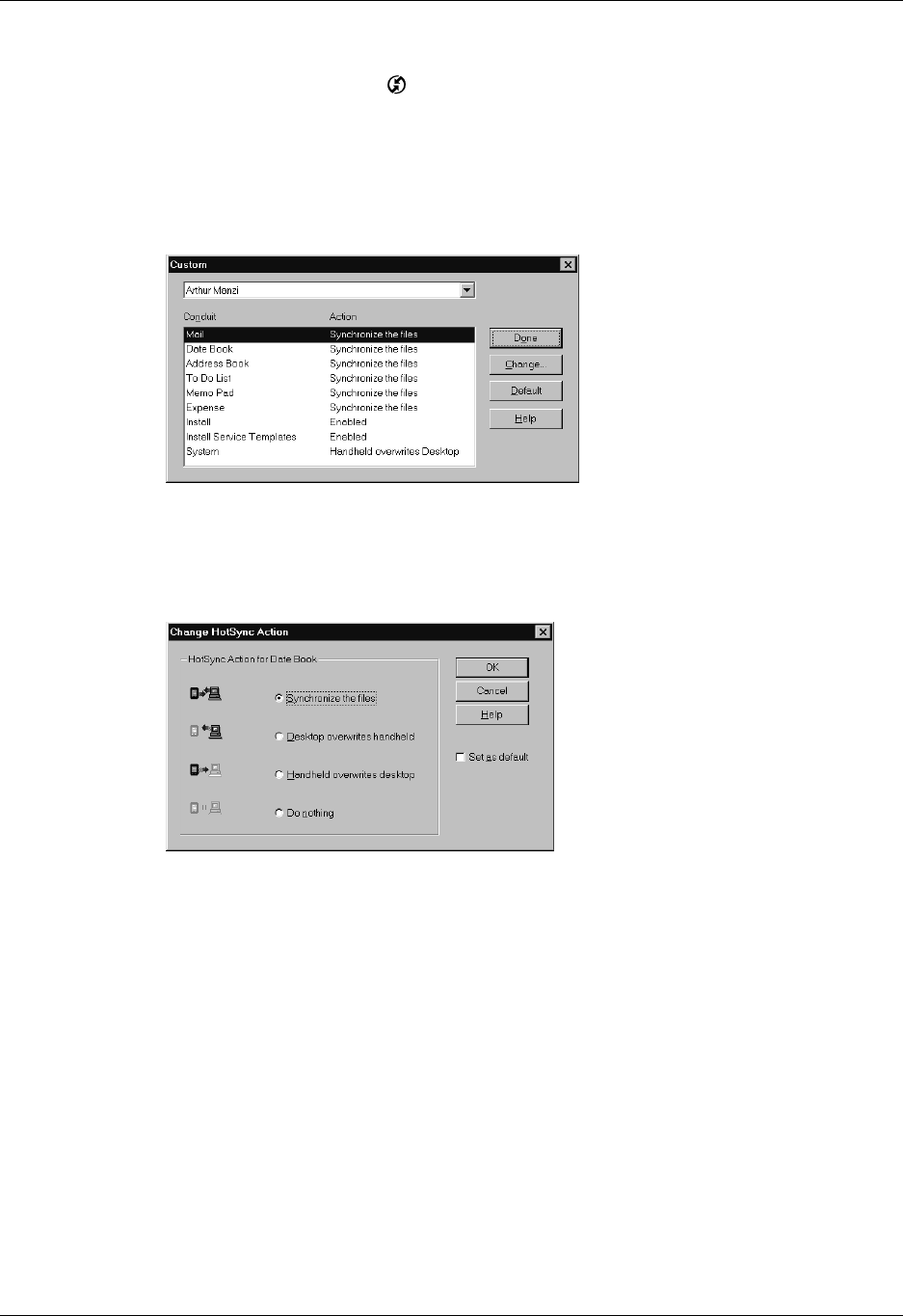
Performing HotSync® Operations
152
To customize HotSync application settings on a Windows computer:
1. Click the HotSync icon ™ in the Windows system tray (bottom-right corner of
the taskbar).
You can also click the HotSync command on the Palm Desktop software menu
bar.
2. From the HotSync Manager menu, choose Custom.
3. Select the appropriate user name from the list.
4. Select an application in the Conduit list.
5. Click Change.
6. Click the direction in which you want to write data, or click Do Nothing to skip
data transfer for an application.
Changing the HotSync setting from the default affects only the next HotSync
operation. Thereafter, the HotSync Actions revert to their default settings. To
use a new setting on an ongoing basis, select the Set As Default box. Thereafter,
whatever you selected as the default setting is used when you click the Default
button in the Custom dialog.
7. Click OK.
8. Repeat steps 4 through 7 to change conduit settings for other applications.
9. Click Done to activate your settings.
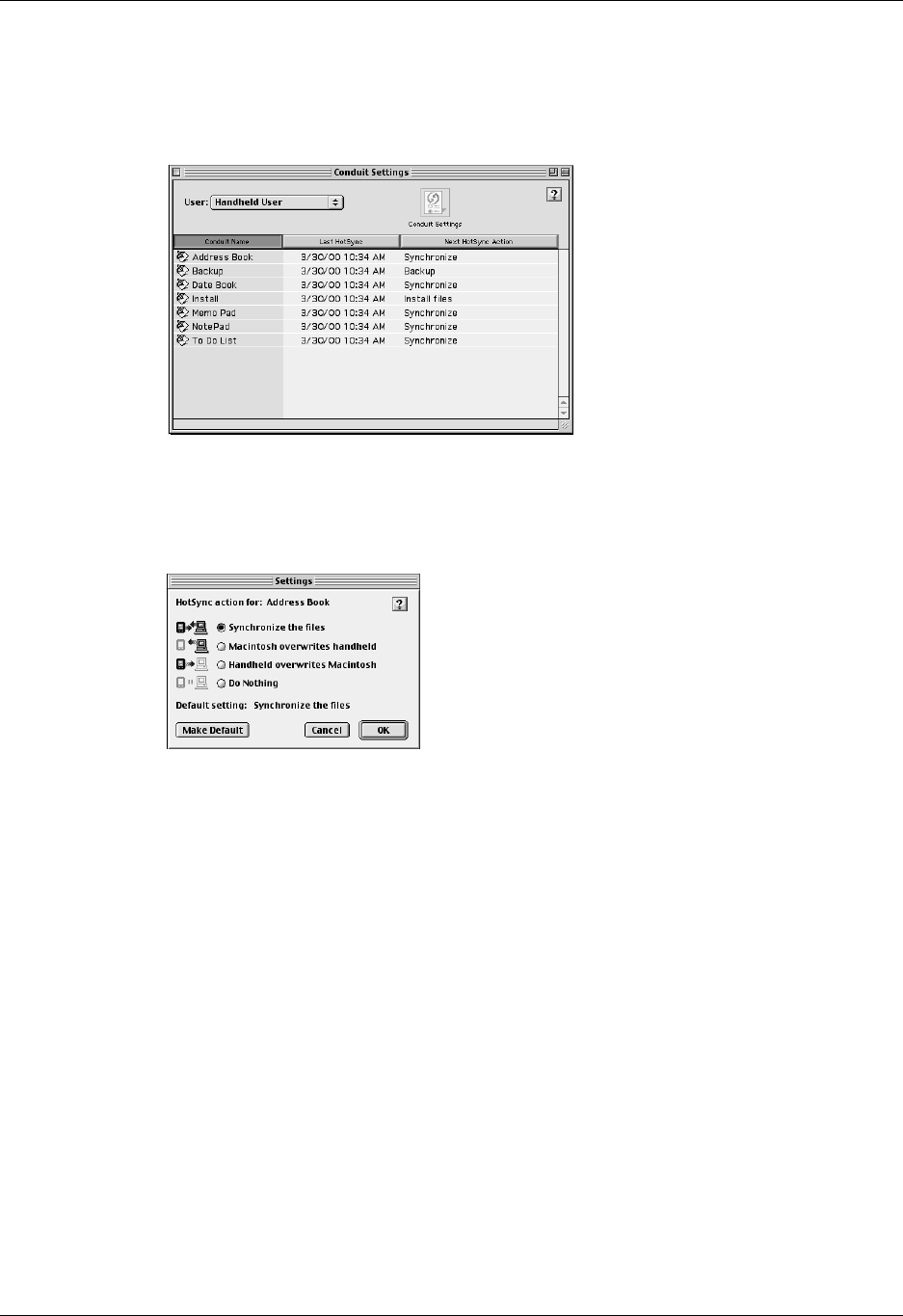
Performing Cradle HotSync Operations
153
To customize HotSync application settings on a Macintosh:
1. Double-click the Palm Desktop icon in the Palm folder.
2. From the HotSync menu, choose Conduit Settings.
3. From the User pop-up menu, select the appropriate user name.
4. Select an application in the Conduit list.
5. Click Conduit Settings.
6. Click the direction in which you want to write data, or click Do Nothing to skip
data transfer for an application.
Changing the HotSync setting from the default affects only the next HotSync
operation. Thereafter, the HotSync Actions revert to their default settings. To
use a new setting on an ongoing basis, click Make Default. Thereafter, whatever
you selected as the default setting is used for HotSync operations.
7. Click OK.
8. Repeat steps 4 through 7 to change conduit settings for other applications.
9. Close the Conduit Settings window.
Performing Cradle HotSync Operations
The simplest way to synchronize data is to perform a direct HotSync operation by
seating your handheld in the cradle and pressing the HotSync button.
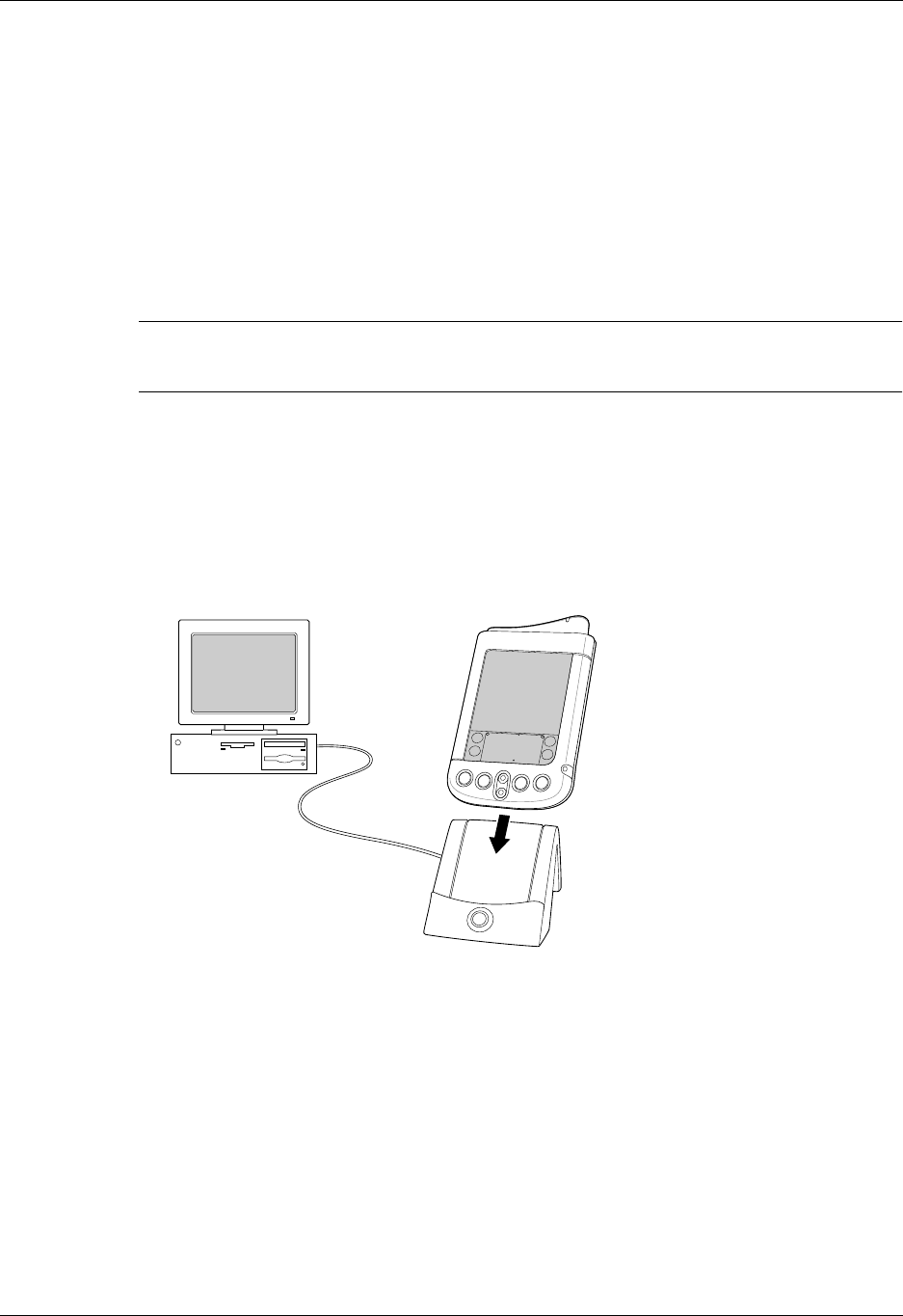
Performing HotSync® Operations
154
Performing a cradle HotSync operation: Windows
The first time you synchronize your data, you need to enter user information on
Palm Desktop software. After you enter this information and synchronize, the
HotSync Manager recognizes your handheld and doesn’t ask for this information
again.
If you are a System Administrator preparing several handhelds for a group of
users, you may want to create a user profile. See“Creating a User Profile” later in
this chapter before performing the following steps.
IMPORTANT You must perform your first HotSync operation with a local, direct
connection, or with infrared communication, rather than using a modem.
The following steps assume that you have already installed Palm Desktop
software. If you have not installed this software, seeSee “Step 3: Install Software”
in Chapter 1 for instructions.
To perform a local HotSync operation on a Windows computer:
1. Place your handheld on the cradle.
2. If the HotSync Manager is not running, start it: On the Windows desktop, click
Start, and then choose Programs. Navigate to the Palm Desktop software
program group and choose HotSync Manager. Alternatively, you can start the
Palm Desktop software which automatically opens the HotSync Manager.
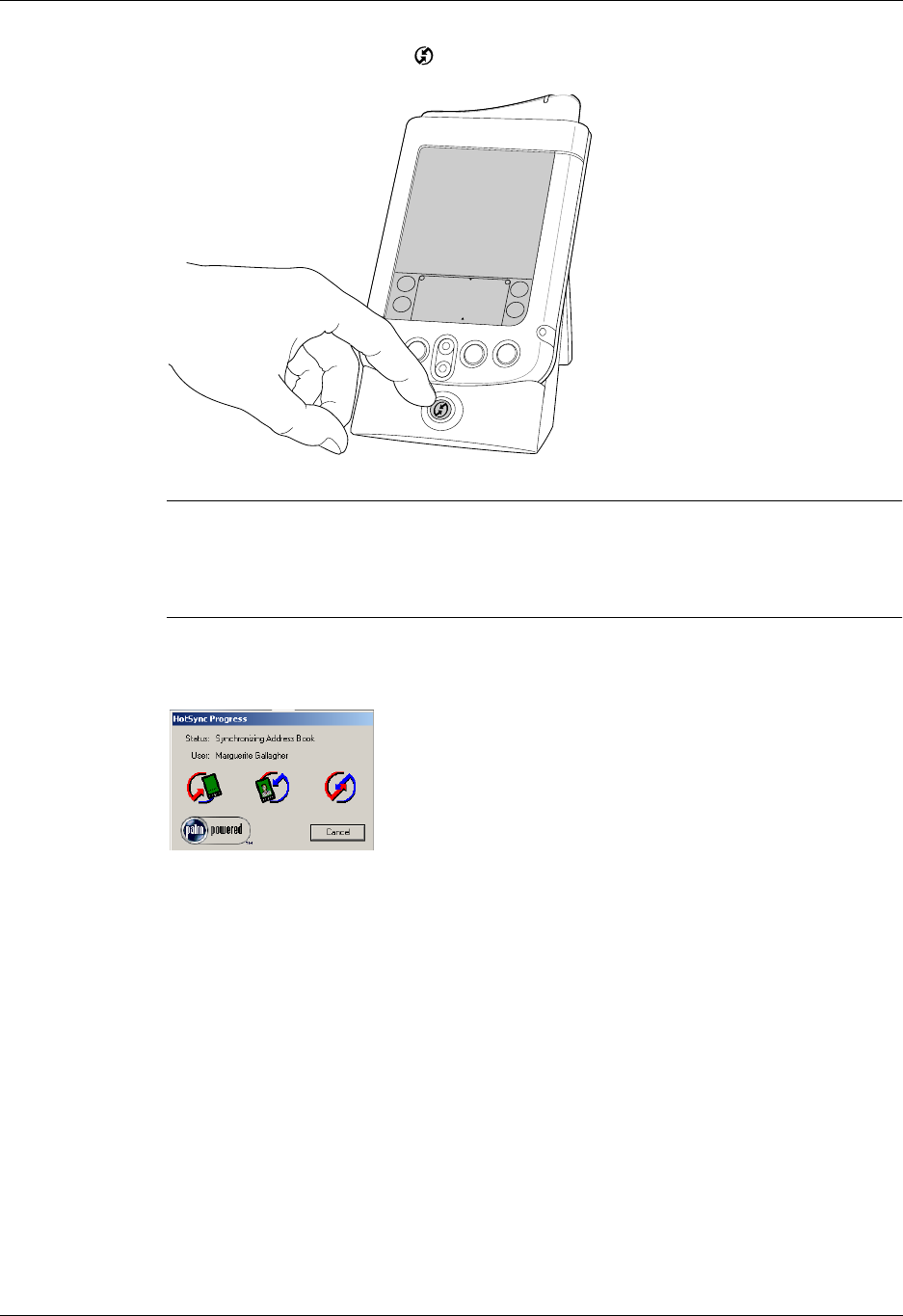
Performing Cradle HotSync Operations
155
3. Press the HotSync button ™ on the cradle.
IMPORTANT The first time you perform a HotSync operation, you must enter a
user name in the New User dialog box and click OK. Every handheld should have
a unique name. To prevent loss of a user’s records, never try to synchronize more
than one handheld to the same user name.
The HotSync Progress dialog box appears and synchronization begins.
4. Wait for a message on your handheld indicating that the process is complete.
After the HotSync process is complete, you can remove your handheld from the
cradle. Gently rock your handheld forward in the cradle and then lift it to
remove.
Performing a direct HotSync operation: Macintosh
When you installed Palm Desktop software, you entered a user name. This user
name is the connection between your handheld and your Macintosh.
The first time you perform a HotSync operation the Palm Desktop software:
■Adds a user name to your handheld.
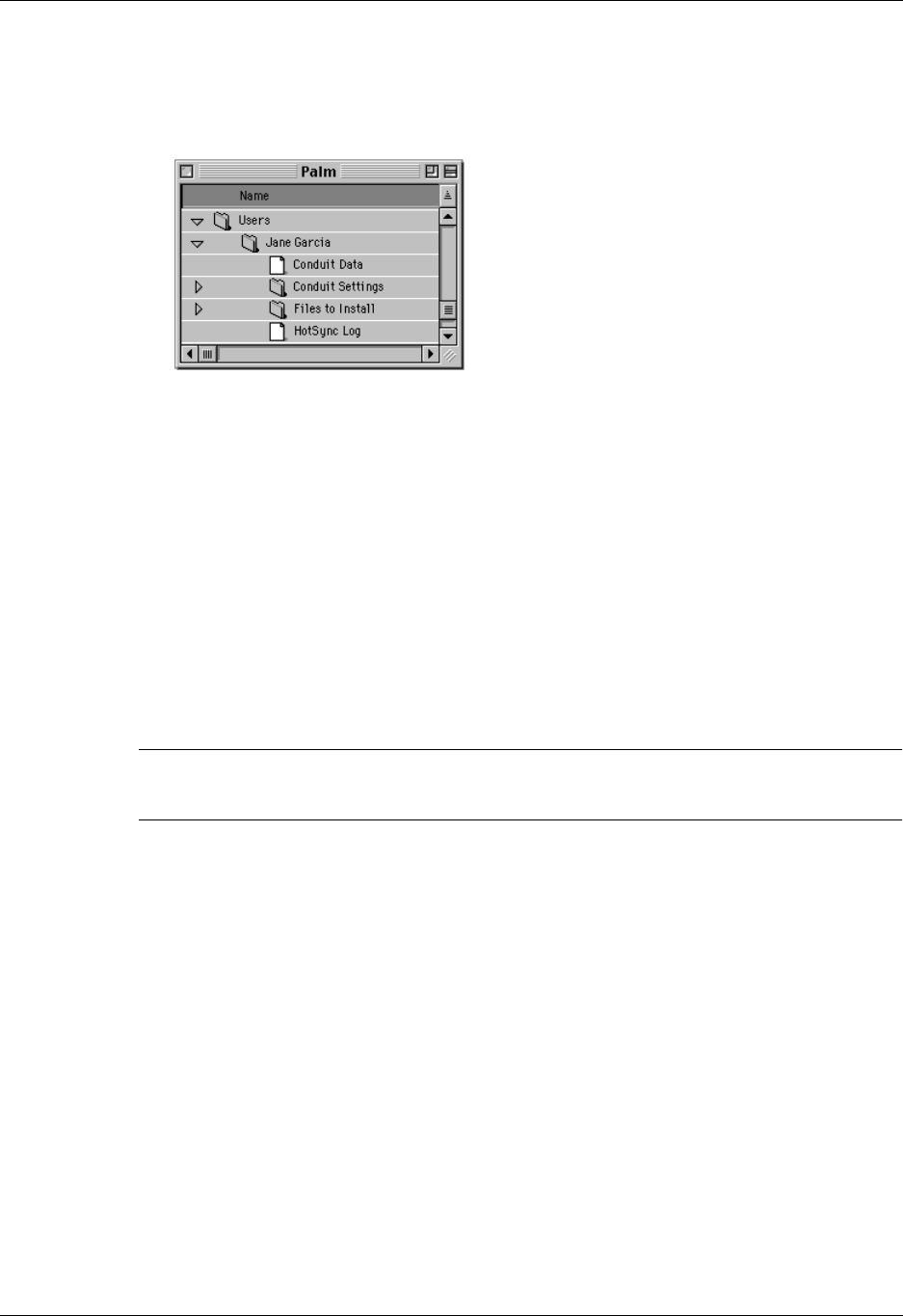
Performing HotSync® Operations
156
■Creates a folder for the user name in the Users folder inside the Palm folder. For
example, if you entered Jane Garcia as your user name, a folder called Jane
Garcia is created in the Users folder.
■Creates a file named User Data in your user name folder.
User names appear in the User pop-up on the right side of the toolbar. You can
change users by selecting a new name in the pop-up menu.
Each subsequent time you perform a HotSync operation, HotSync Manager reads
the user name from your handheld and synchronizes the data in the folder of the
same name.
Be sure you select the correct user name from the User pop-up before entering
data on Palm Desktop or performing a HotSync operation.
If you are a System Administrator preparing several handhelds for a group of
users, you may want to create a user profile. See“Creating a User Profile” later in
this chapter before performing the following steps.
IMPORTANT You must perform your first HotSync operation with a local, direct
connection, or with infrared communication.
The following steps assume that you have already installed Palm Desktop
software. See “Step 3: Install Software” in Chapter 1 if you have not installed this
software.
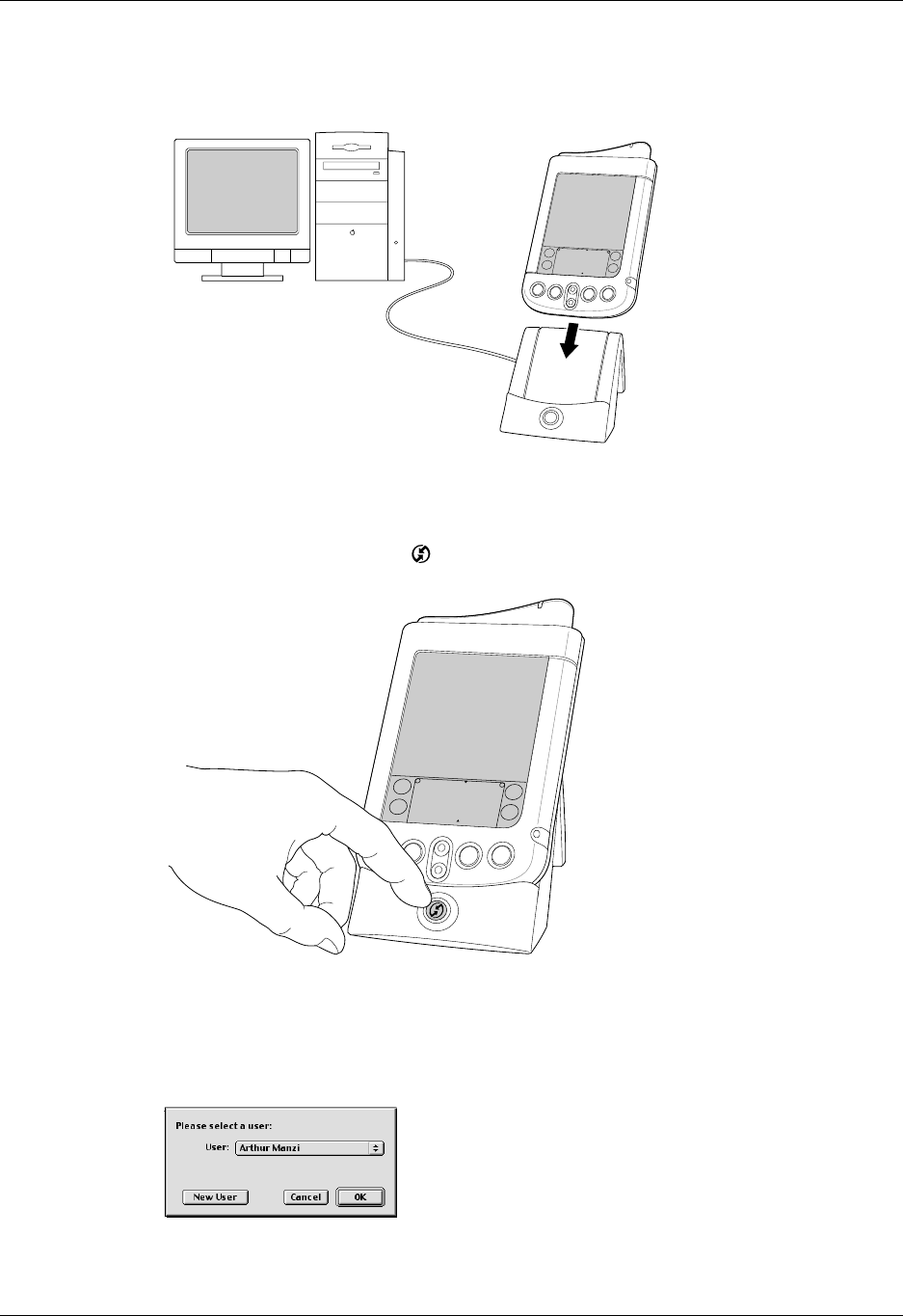
Performing Cradle HotSync Operations
157
To perform a local HotSync operation on a Macintosh:
1. Place your handheld on the HotSync cradle.
2. Make sure HotSync Manager is enabled: Double-click the HotSync Manager
icon in the Palm folder. Click the HotSync Controls tab and make sure the
Enabled option is selected.
3. Press the HotSync button on the cradle.
The HotSync Progress dialog box appears followed by the Select User dialog
box.
4. In the Select User dialog box, select the user name you entered when you
installed the Palm Desktop software, and click OK.
The HotSync Progress dialog box reappears and synchronization begins.

Performing HotSync® Operations
158
5. Wait for a message on your handheld indicating that the process is complete.
After the HotSync process is complete, you can remove your handheld from the
cradle. Gently rock your handheld forward in the cradle and then lift it to
remove.
IR HotSync Operations
Your handheld is equipped with an infrared (IR) port that supports the IrCOMM
implementation of the standards for infrared communication established by the
Infrared Data Association (IrDA). This means that not only can you beam data to
another Palm OS handheld that’s equipped with an IR port, but you can also beam
data to a mobile phone and any other device that supports the IrCOMM
implementation of the IrDA standards.
Most importantly, you can use the IR port to perform HotSync operations; you
don’t need your cradle. This is especially useful if you travel with an infrared-
enabled laptop. You simply enable infrared communication on your laptop and
handheld and follow the steps in “Performing an IR HotSync operation” later in
this section.
Preparing your computer for infrared communication
Before you can perform a HotSync operation using the IR port, the computer with
which you want to synchronize must fulfill these requirements:
■Your computer must support the IrCOMM implementation of the IrDA
standards.
■Your computer must have an enabled infrared port that’s built into the
computer, or an enabled infrared device attached to the computer.
■Some desktop computers may require an infrared device attached to a physical
COM port. Laptops are likely to have a built-in IR port, so no external device is
necessary.
■Your computer must have an installed infrared driver.
■If you have an external infrared device attached to your computer, a driver is
probably included with the device. Consult the documentation included with
the device for information on installing the required driver.
Check your computer’s documentation to learn if the computer supports infrared
communication.
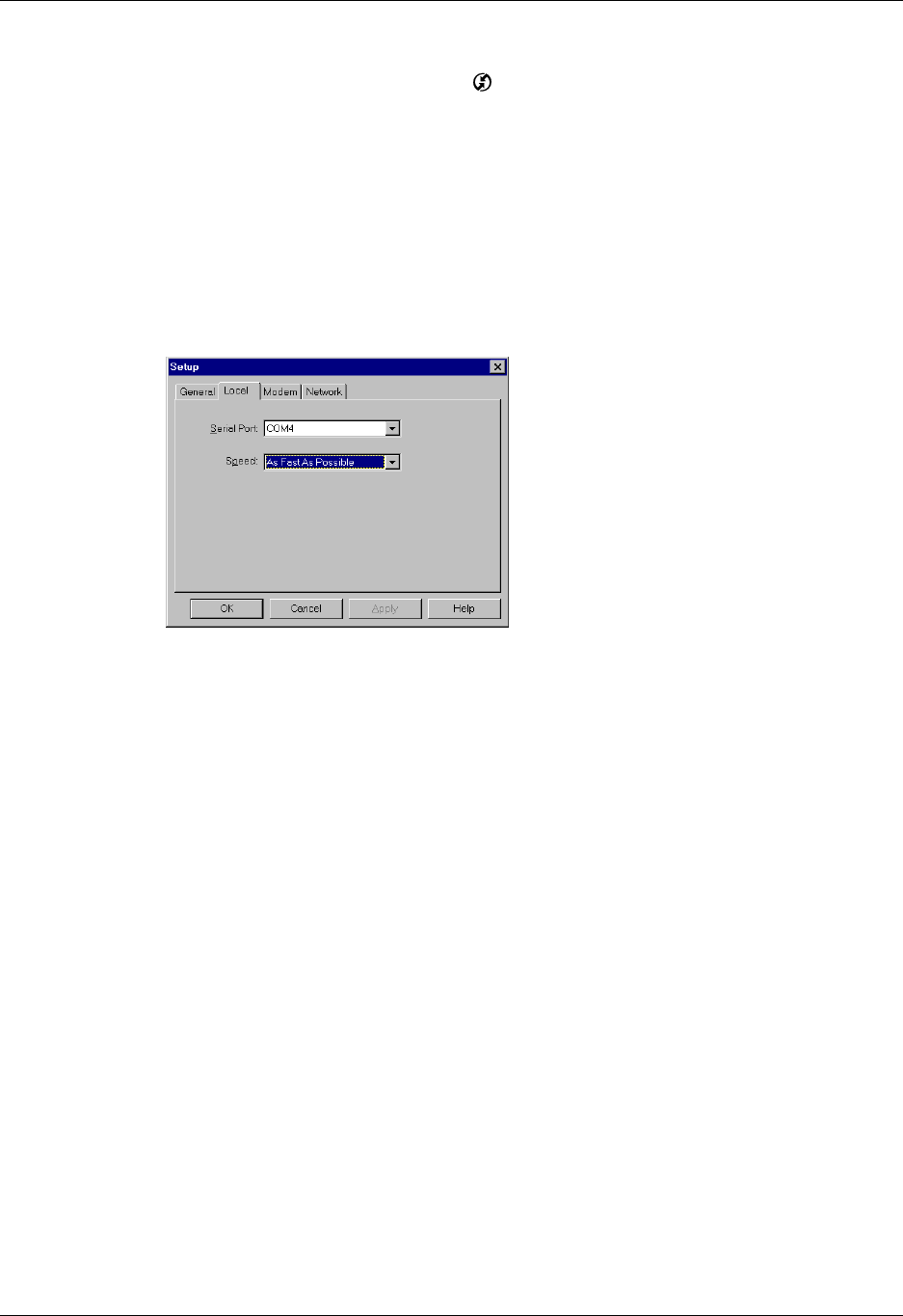
IR HotSync Operations
159
To configure HotSync Manager for infrared communication on a Windows computer:
1. Click the HotSync Manager icon in the Windows system tray, and make sure
Infrared is checked. If you do not have an Infrared option on the HotSync
Manager menu, complete the following steps.
2. Make sure Local Serial is checked on the menu.
3. Choose Setup.
4. Click the Local tab.
5. In the Serial Port drop-down box, select the simulated port that your computer
uses for infrared communication.
See the documentation for your operating system for instructions on finding the
simulated port. This information is usually located in the Control Panel.
6. Click OK.
NOTE If your cradle is connected to a USB port, you can continue using it
while HotSync Manager is configured for infrared communication. If your
cradle is connected to a serial port, you cannot use your HotSync cradle again
until you reconfigure the HotSync Manager to communicate with the port
defined for cradle synchronization.
To configure HotSync Manager for infrared communication on a Macintosh:
1. Double-click the HotSync Manager icon in the Palm folder.
2. In the HotSync Controls tab, select Enabled.
3. Click the Serial Port Settings tab.
4. Under Check for handheld connection using, select Local Setup.
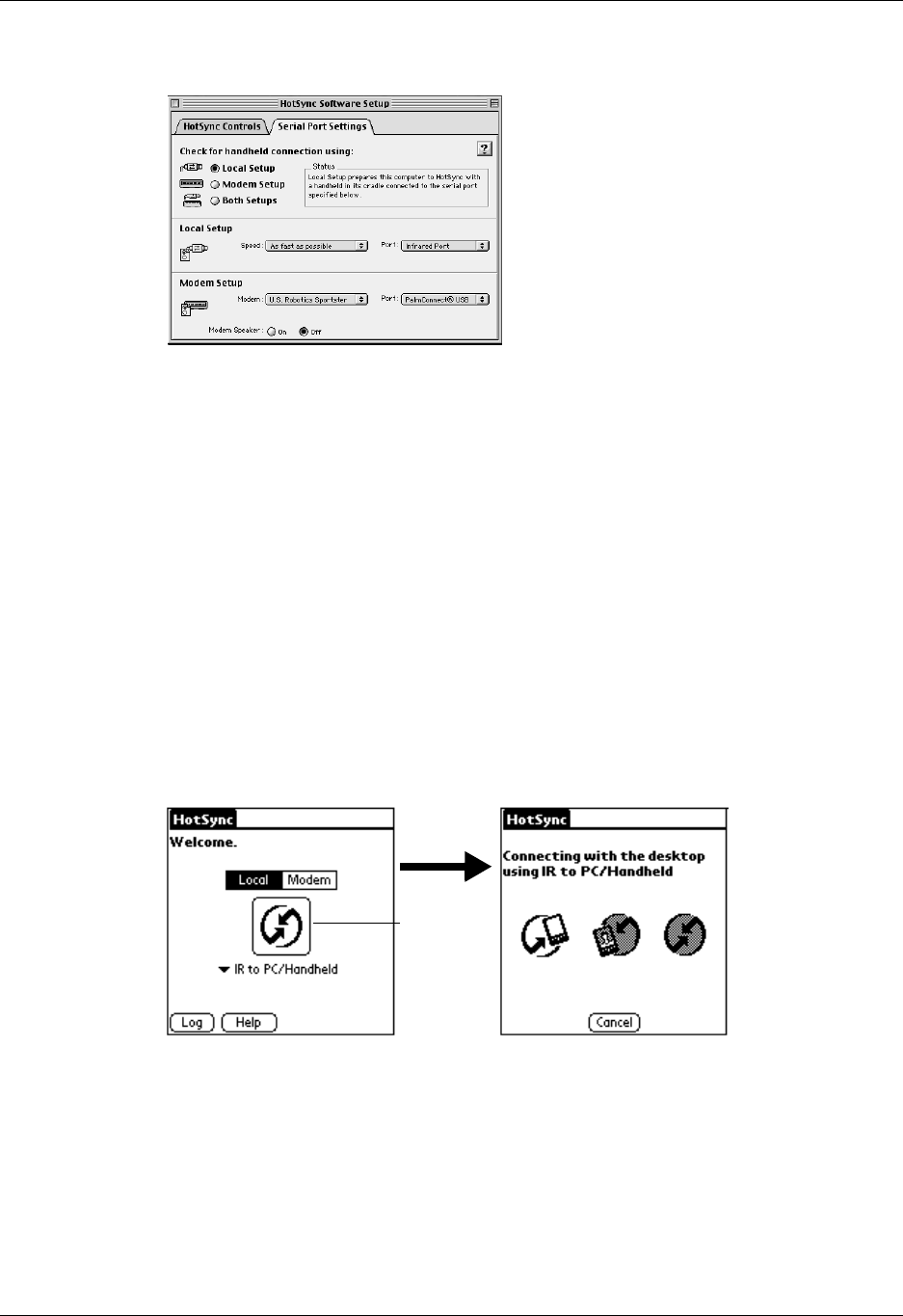
Performing HotSync® Operations
160
5. Under Local Setup, select Infrared Port from the Port pop-up menu.
6. Close the HotSync Software Setup window.
Performing an IR HotSync operation
After you complete the steps to prepare for performing an IR HotSync operation, it is easy
to perform the actual operation.
To perform an IR HotSync operation:
1. In the Applications Launcher, tap the HotSync icon.
2. Tap Local.
3. Tap the pick list below the HotSync icon and select IR to a
PC/Handheld.
4. Position the IR port of your handheld within a couple of inches of the infrared
port of your computer.
5. Tap the HotSync icon to start the IR HotSync operation.
Returning to cradle HotSync operations
It’s easy to return to using the cradle for HotSync operations.
If your cradle is connected to a USB port, you can continue using it while HotSync
Manager is configured for infrared communication. Use the following instructions
to return to Local USB cradle HotSync operations only when needed, such as when
you have disconnected the cradle from the USB port.
Tap here to
start IR
HotSync
operation

Conducting a HotSync Operation Via Modem
161
To return to local USB cradle HotSync operations on a Windows computer:
1. If needed, connect the cradle to the USB port of your computer you use for
HotSync operations.
2. Click the HotSync Manager icon in the Windows system tray, and select
Local USB if it is not already checked.
To return to local Serial cradle HotSync operations on a Windows computer:
1. If needed, connect the cradle to the port of your computer you use for HotSync
operations.
2. Click the HotSync Manager icon in the Windows system tray.
3. Choose Setup, and then click Local.
4. Select the COM port where your cradle is connected.
5. Click OK.
To return to local serial cradle HotSync operations on a Macintosh:
1. If needed, connect the cradle to a serial port on your Macintosh.
2. Double-click the HotSync Manager icon in the Palm folder.
3. In the HotSync Controls tab, select Enabled.
4. Click the Serial Port Settings tab.
5. Under Check for handheld connection using, select Local Setup.
6. Under Local Setup, select the port where your cradle is connected from the Port
pop-up menu.
7. Close the HotSync Software Setup window.
Now, the next time you want to perform a HotSync operation, just press the
HotSync button on the cradle, as you always did in the past.
Conducting a HotSync Operation Via Modem
You can use a modem to synchronize your handheld when you are away from your
computer.
NOTE The first HotSync operation must be local, using the cradle. After that, you can
perform a modem HotSync operation.
To perform a HotSync operation via modem you need the following:
■A modem connected to your computer.
■Palm Desktop software configured for use with the modem.
■A modem connected to your handheld.
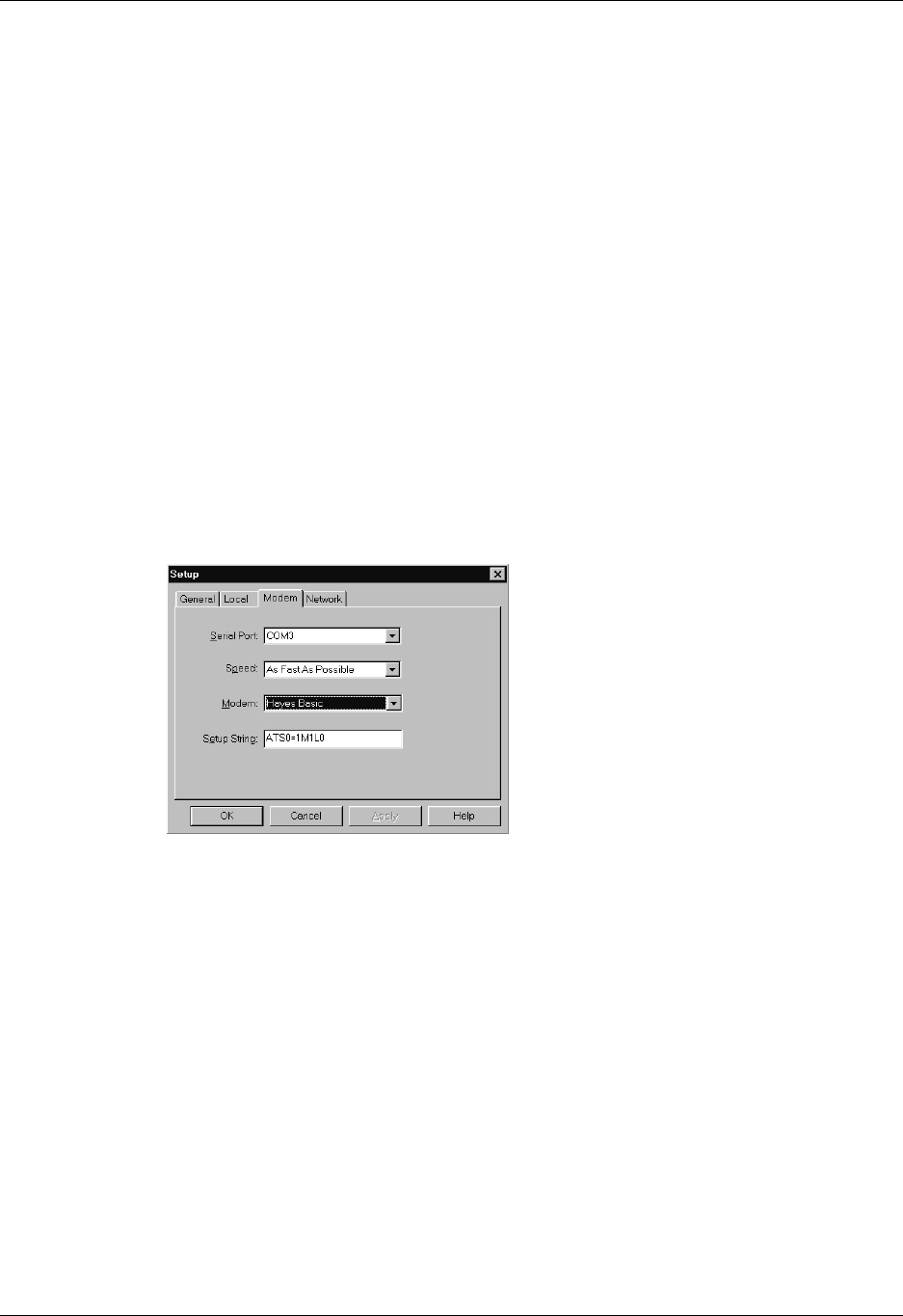
Performing HotSync® Operations
162
■A configuration for the kind of modem connection you want to make. See
“Connection preferences” in Chapter 17 for more information.
Preparing your computer
There are a few steps you must perform to prepare your computer for a modem
HotSync operation. Be sure to perform these steps before you leave your office so
that your computer is ready to receive a call from your handheld.
To prepare your Windows computer for a modem HotSync operation:
1. Confirm that the computer modem is connected and turned on, and that no
communications applications, such as fax or telephony software, are running on
a COM port.
Make sure the computer is disconnected from all online services, such as
America Online (AOL). This helps to avoid conflicts with the COM port.
2. Start HotSync Manager if it is not already running, and from the HotSync
Manager menu, choose Modem.
3. Adjust the following options as needed.
Serial Port Identifies the port for the modem. If you are unsure of the port
assignment, look at the Modem Properties in the Windows
Control Panel.
Speed Determines the speed at which data is transferred. Try the As
Fast As Possible rate first, and adjust downward if you
experience problems. This setting allows Palm Desktop
software and your handheld to find and use the fastest speed.
Modem Identifies the modem type or manufacturer. Refer to your
modem manual or face plate for its type or settings. If you’re
not sure of your modem type or your modem doesn’t match
any that appear in the list, select Hayes Basic.
Setup String Identifies the setup string for your particular modem. Not all
modems require a setup string. Refer to your modem manual
and enter the setup string if recommended by the
manufacturer.
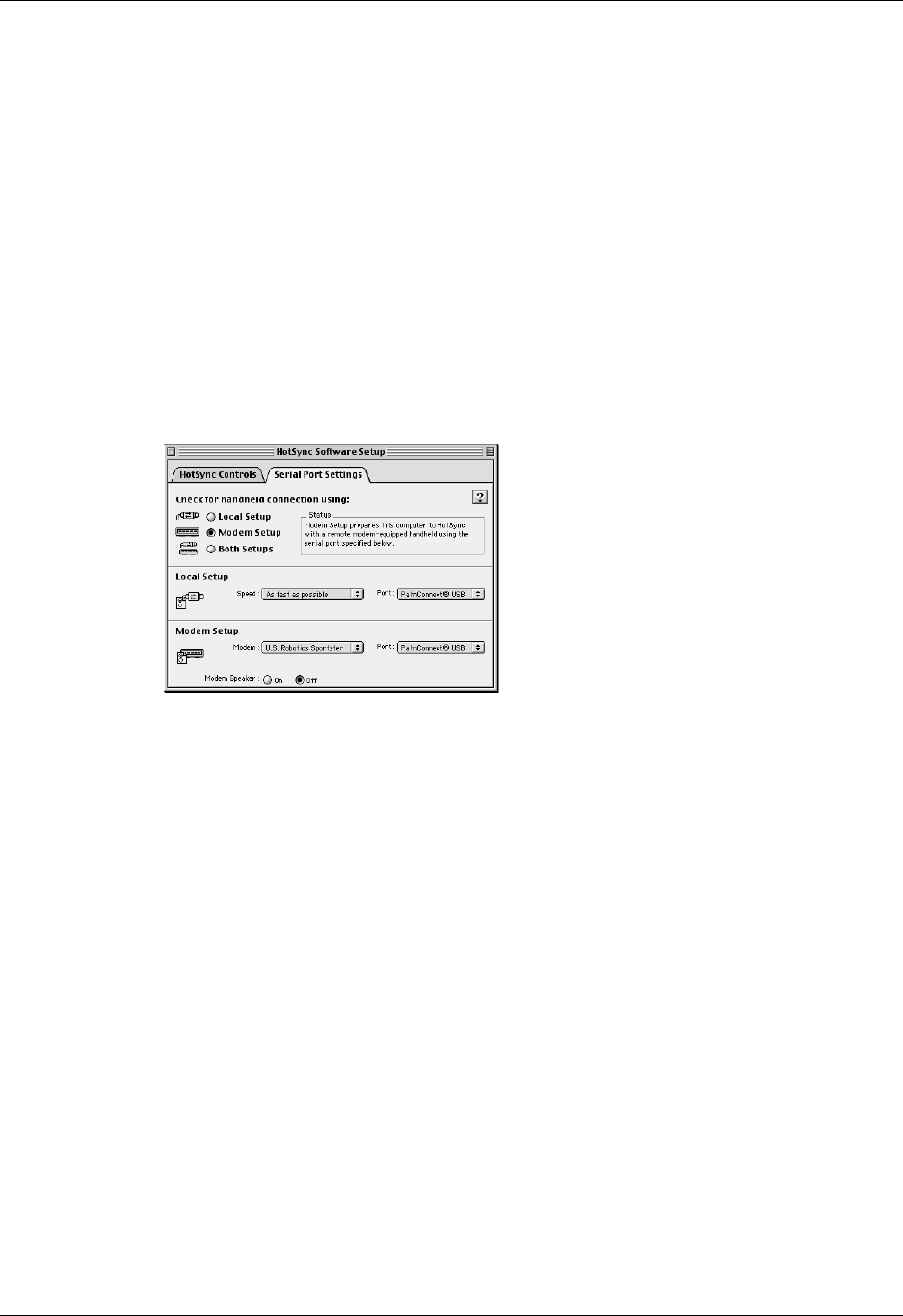
Conducting a HotSync Operation Via Modem
163
4. Click OK.
To prepare a Macintosh for a modem HotSync operation:
1. Confirm that the Macintosh modem is connected and turned on, and that no
communications applications, such as fax or telephony software, or AppleTalk
networking are running on that serial port.
Make sure the Macintosh is disconnected from all online services, such as
America Online (AOL). This helps to avoid conflicts with the serial port.
2. Double-click the HotSync Manager icon in the Palm folder.
3. Click the Serial Port Settings tab.
4. Under Check for handheld connection using, click Modem Setup.
5. Adjust the following options as needed.
6. Close the HotSync Software Setup window.
Preparing your handheld
There are a few steps you must perform to prepare your handheld for a modem
HotSync operation.
Modem Identifies the type of modem connected to your Macintosh. If
your modem does not appear on the list, use the Hayes Basic
setting, or choose Custom to enter a command string. Refer to
the manual that came with your modem to find the appropriate
command string.
Port Identifies the port that Palm Desktop software uses to
communicate with the modem. Select the modem or printer
port where you connected the modem cable.
Modem Speaker Activates the modem’s speaker. If you are having trouble
connecting, turn on this option to make sure the modem
connected to your Macintosh is responding to incoming calls.
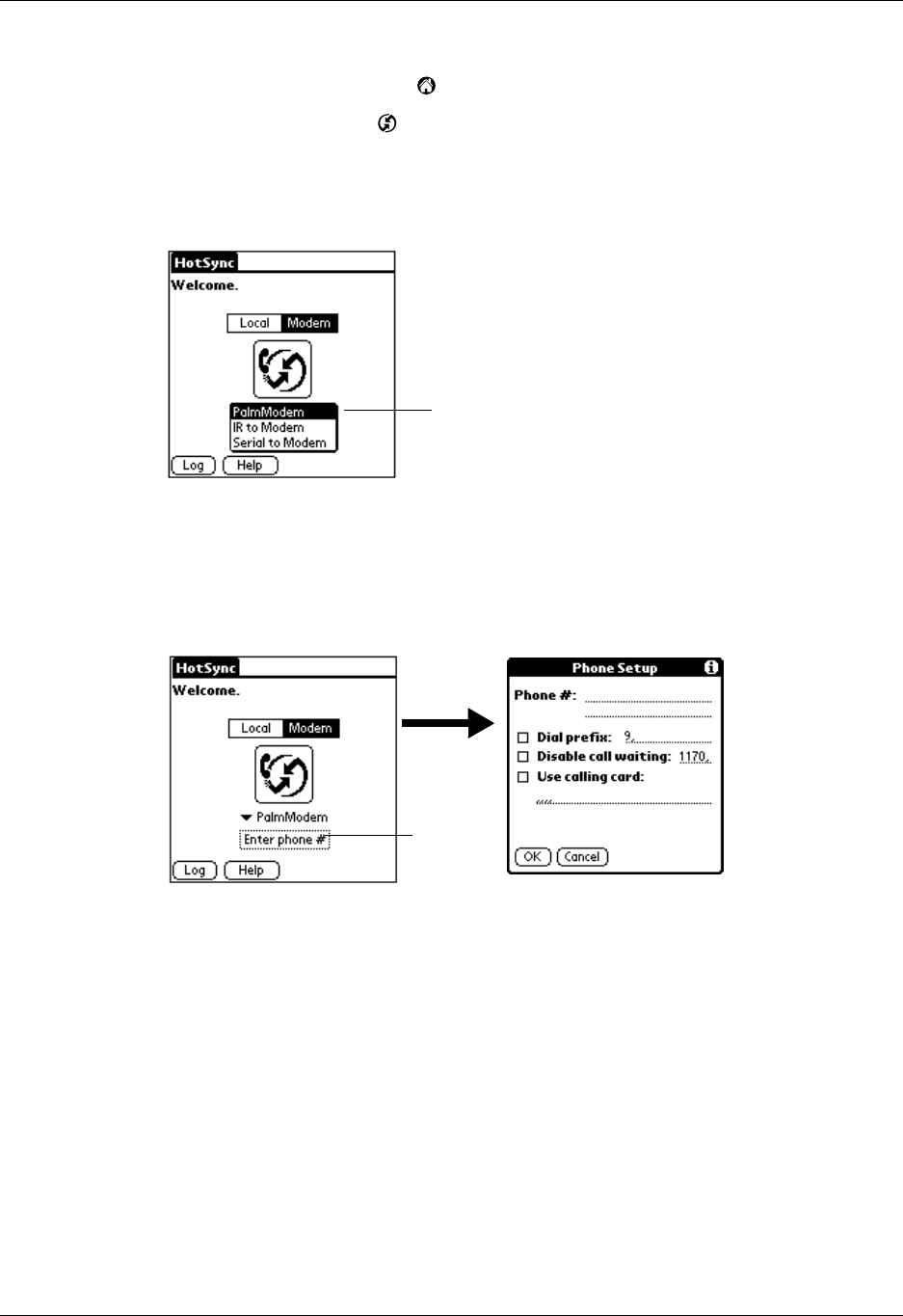
Performing HotSync® Operations
164
To prepare your handheld for a modem HotSync operation:
1. Tap the Applications icon .
2. Tap the HotSync icon .
3. Tap Mode m .
4. Tap the pick list below the icon and select a modem configuration.
If you need to create a configuration, tap the Menu icon and then select Options
and Connection Setup. See “Connection preferences” in Chapter 17 for more
information.
5. Tap the Enter phone # field.
If you plan to connect to your company’s dial-in server (network modem)
instead of connecting to a computer modem, see “Conducting a HotSync
Operation via a Network” later in this chapter.
6. Enter the telephone number to access the modem connected to your computer.
7. If needed, enter a dial prefix (such as “9”) to access an outside line, and then tap
the Dial Prefix check box.
TIP You can enter a comma in the field to introduce a “pause” in the dialing
sequence. Each comma equals a two second pause.
8. If the phone line you’re using for the handheld has Call Waiting, select the
Disable call waiting check box to avoid an interruption during the modem
HotSync operation.
Select a modem
configuration
Ta p h e r e
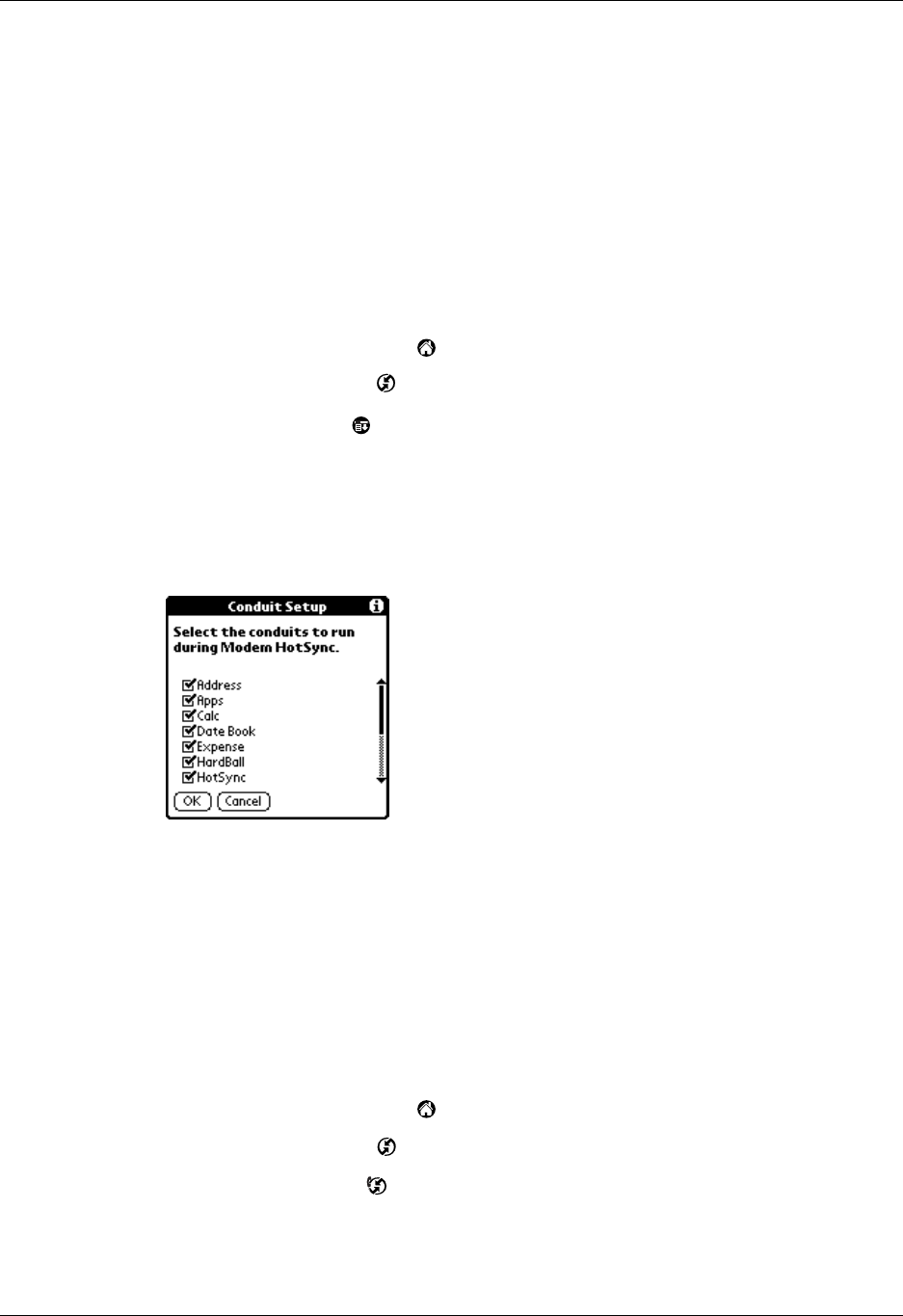
Conducting a HotSync Operation Via Modem
165
9. If you want to use a calling card to place the call, select the check box and enter
the calling card number.
10. Tap O K .
Selecting the conduits for a modem HotSync operation
The Conduit Setup dialog box on your handheld enables you to define which files
and/or applications synchronize during a modem HotSync operation. You can use
these settings to minimize the time required to synchronize data with a modem.
To change the Conduit Setup for a modem HotSync operation:
1. Tap the Applications icon .
2. Tap the HotSync icon .
3. Tap the Menu icon .
4. Tap Options, and then tap Conduit Setup.
5. Tap the check boxes to deselect the files and applications that you do not want
to synchronize during a modem HotSync operation. The default setting is to
synchronize all files.
Applications that do not have a database (such as games) do not synchronize —
even if you select the item in the Conduit Setup dialog box.
6. Tap OK.
Performing a HotSync operation via a modem
After you prepare your computer and your handheld, and select your Conduit
Setup options, you are ready to perform a modem HotSync operation.
To perform a modem HotSync operation:
1. Tap the Applications icon .
2. Tap the HotSync icon .
3. Tap the Modem icon to dial the Palm Desktop modem and synchronize the
applications.

Performing HotSync® Operations
166
4. Wait for the HotSync operation to complete. If you have any problems
conducting a successful HotSync operation, see See “HotSync problems” in
Appendix B.
Conducting a HotSync Operation via a Network
Is this still in product? Marketing, please advise.
When you use the network HotSync technology, you can take advantage of the
LAN and WAN connectivity available in many office environments. Network
HotSync technology enables you to perform a HotSync operation by dialing in to
a network or by using a cradle that is connected to any computer on your LAN or
WAN (provided that the computer connected to the cradle also has the network
HotSync technology installed, your computer is on, and the HotSync Manager is
running).
Connecting to your company’s dial-in server
A network HotSync operation requires the following (consult your System
Administrator for assistance):
■Your computer has TCP/IP support installed.
■Both your company’s network system and its remote access server support
TCP/IP.
■You have a remote access account.
Everything you need to connect to your company’s dial-in server (network
modem) is included with Palm Desktop software and handheld software. You
need to activate the feature, however, on both Palm Desktop software and your
handheld.
To prepare your computer for a network HotSync operation:
1. Click the HotSync Manager icon in the Windows system tray.
2. From the HotSync Manager menu, choose Network.
3. From the HotSync Manager menu, choose Setup.
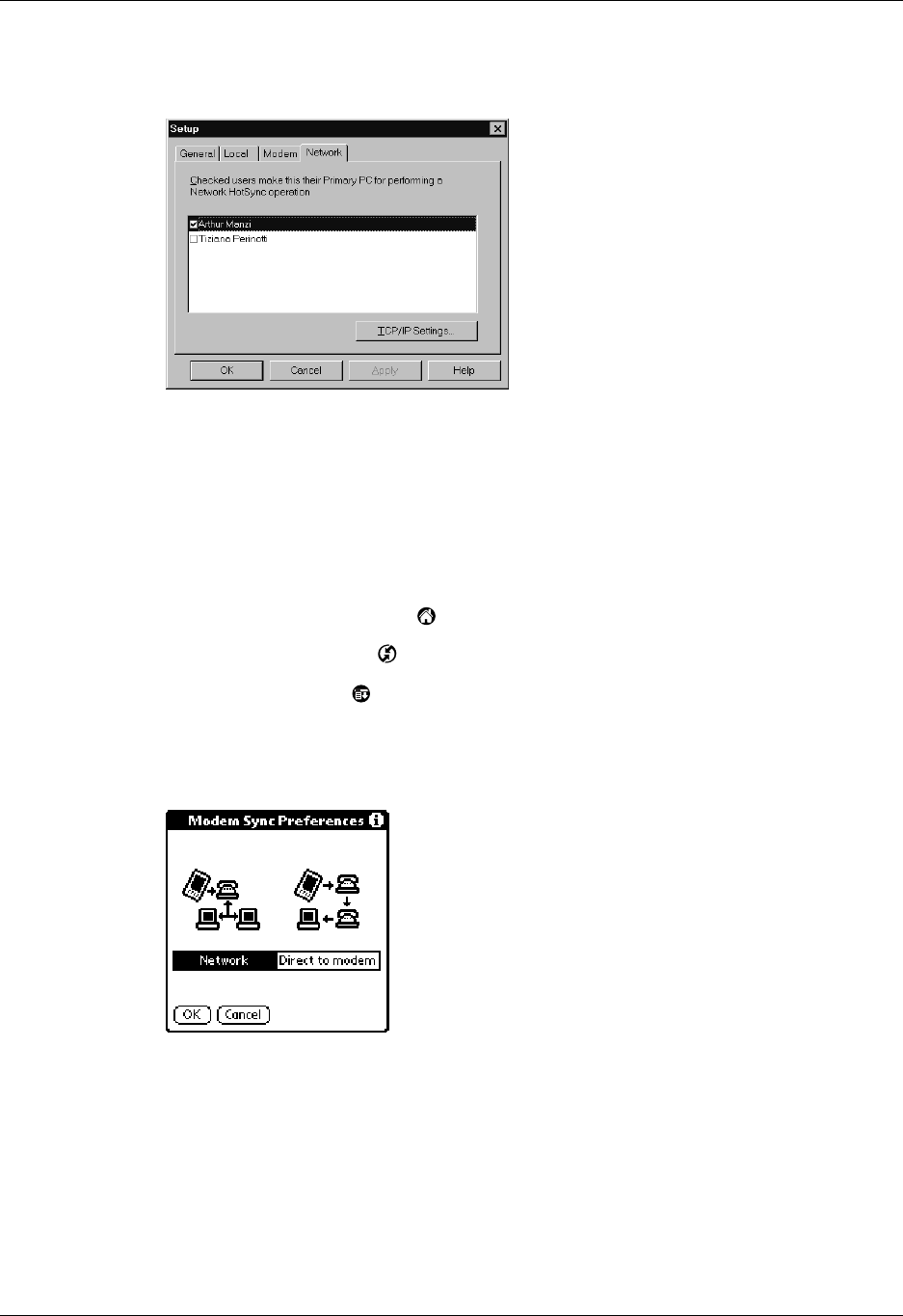
Conducting a HotSync Operation via a Network
167
4. Click the Network tab and make sure your user name has a check mark next to
it. If the check mark is not there, click the check box next to your user name.
5. Click OK.
6. Put your handheld in the cradle and perform a HotSync operation.
The HotSync operation records network information about your computer on
your handheld. With this information, your handheld can locate your computer
when you perform a HotSync operation over the network.
To prepare your handheld for a network HotSync operation:
1. Tap the Applications icon .
2. Tap the HotSync icon .
3. Tap the Menu icon .
4. Tap Options, then tap Modem Sync Prefs.
5. Tap Network.
6. Tap OK.
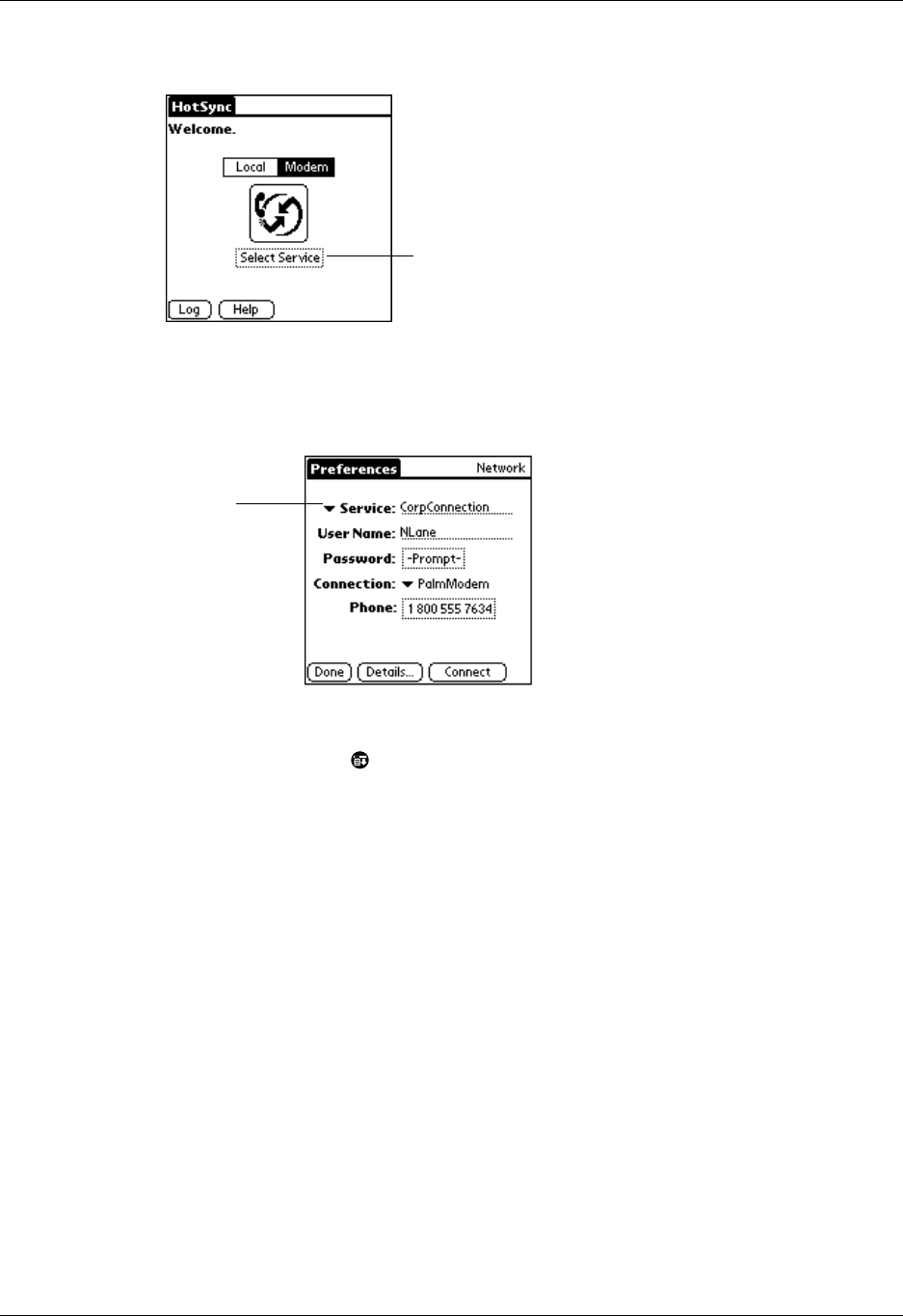
Performing HotSync® Operations
168
7. Tap Select Service.
See “Network preferences and TCP/IP software” in Chapter 17 for information
on creating a network connection.
8. Tap Service and select a service.
9. Tap Don e.
10. Tap the Menu icon .
11. Tap Options, then tap Conduit Setup.
Follow the instructions in “Selecting the conduits for a modem HotSync
operation” earlier in this chapter.
Performing a network HotSync operation
After you prepare your computer and your handheld, and select your Conduit
Setup options, you are ready to perform a network HotSync operation.
Ta p h e r e
Ta p h e r e
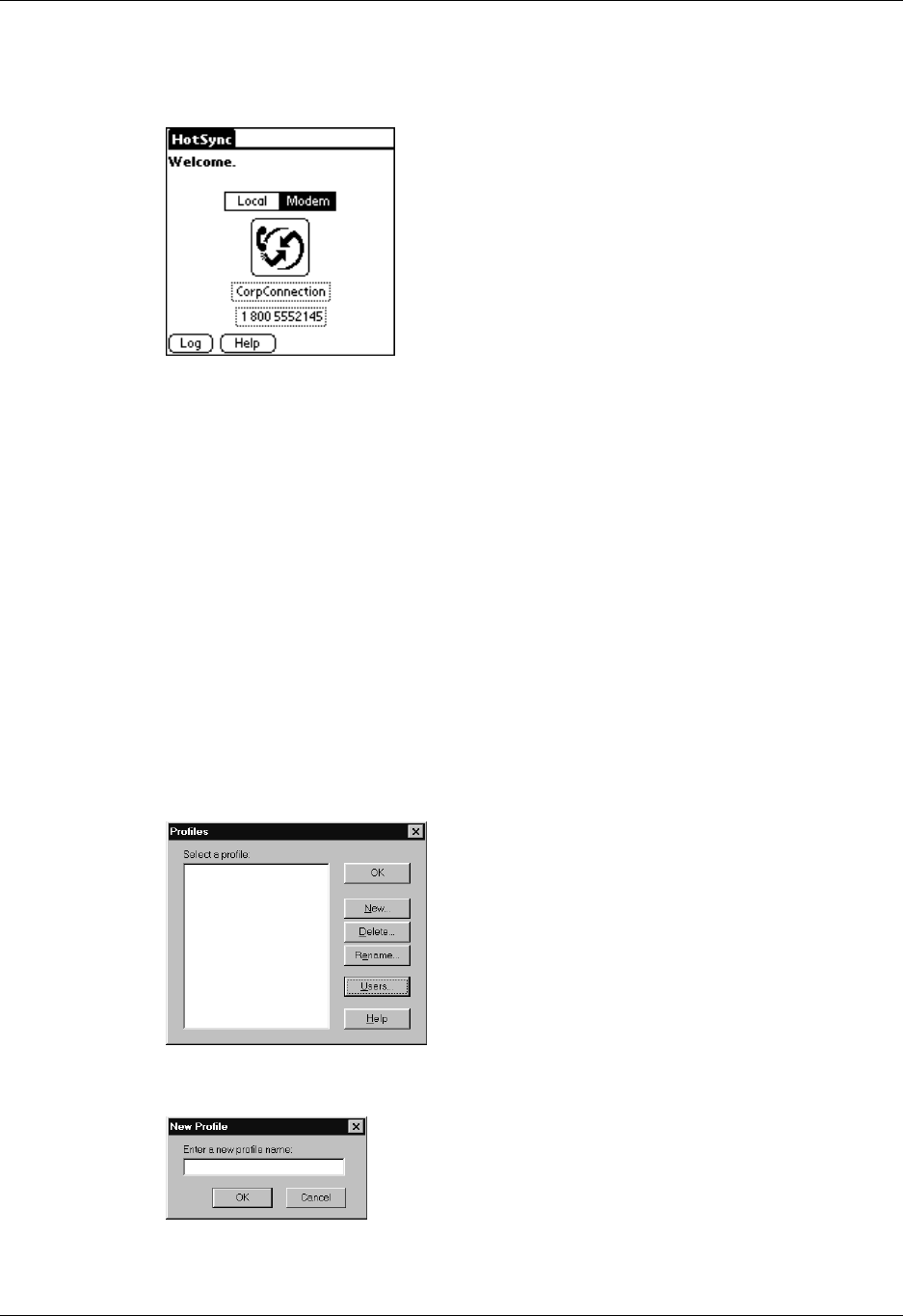
Creating a User Profile
169
To perform a network Hotsync operation:
■Tap the modem HotSync icon to begin the operation.
Creating a User Profile
If you use the File Link feature to configure several Palm OS handhelds with
specific information (such as a company phone list) before distributing them to
their actual users, you can create a user profile to load the data into a handheld
without associating that data with a user name. The User Profile feature is
designed only for the first-time HotSync operation, before you assign a User ID to
a particular handheld.
To create a user profile on a Windows computer:
1. Open Palm Desktop software.
2. From the Tools menu, choose Users.
3. Click Profiles.
4. Click New.
5. Enter a unique name for the profile and click OK.
6. Repeat steps 3 and 4 for each profile that you want to create, and then click OK
to return to Palm Desktop software.
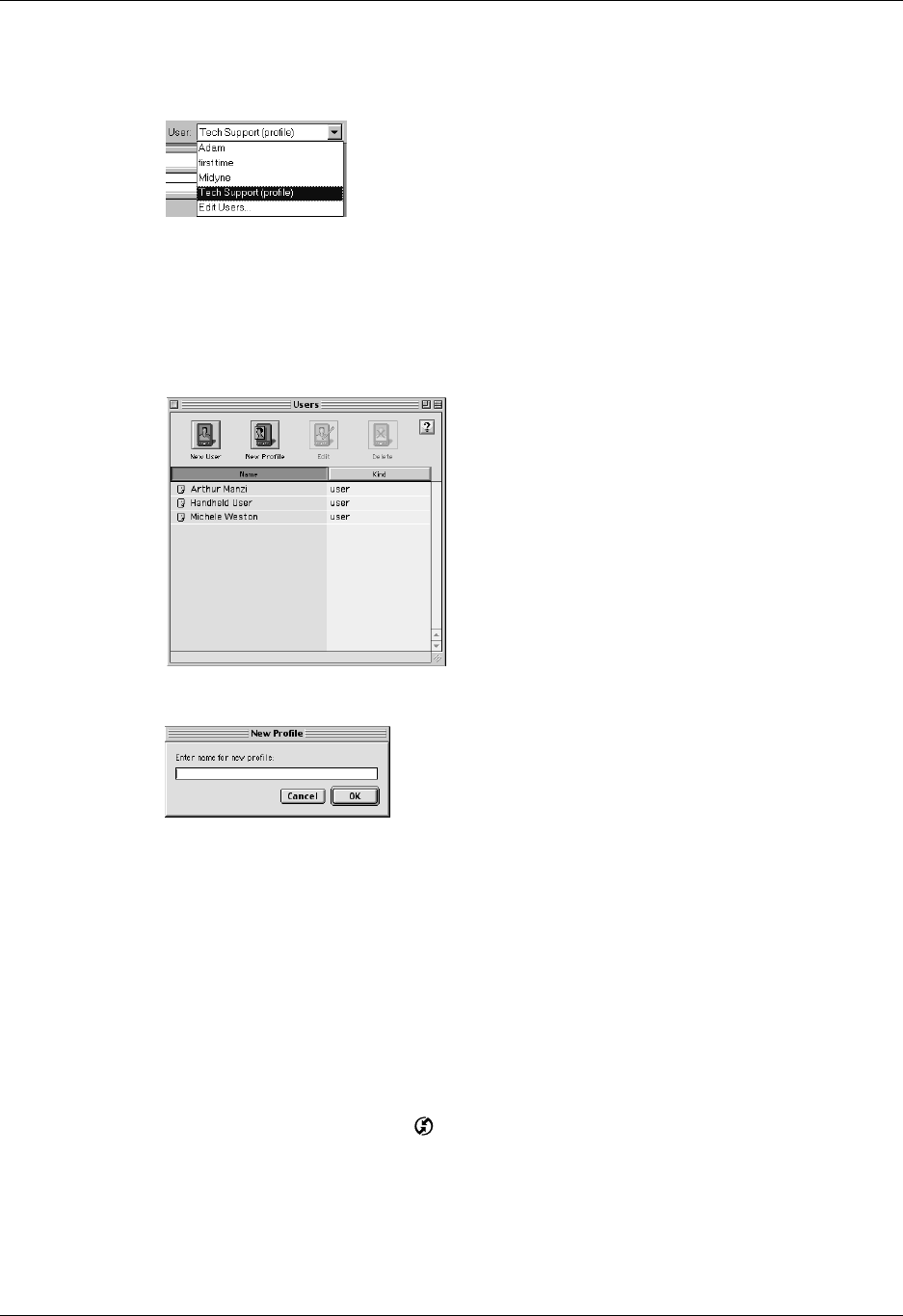
Performing HotSync® Operations
170
7. Select the profile from the User list and create the data for the profile (e.g.,
company phone list, etc.).
To create a user profile on a Macintosh:
1. Open Palm Desktop software.
2. From the User pop-up menu, choose Edit Users.
3. Click New Profile.
4. Enter a unique name for the profile and click OK.
5. Close the Users window.
6. From the User pop-up menu, choose the new profile.
7. Create the data for the profile (such as a company phone list).
8. From the HotSync menu, choose Conduit Settings.
9. Select the conduit settings for the profile. See “Customizing HotSync
Application Settings” earlier in this chapter for details.
To use a profile for the first-time HotSync operation on a Windows computer:
1. Place the new handheld in the cradle.
2. Press the HotSync button on the cradle.
3. Click Profiles.
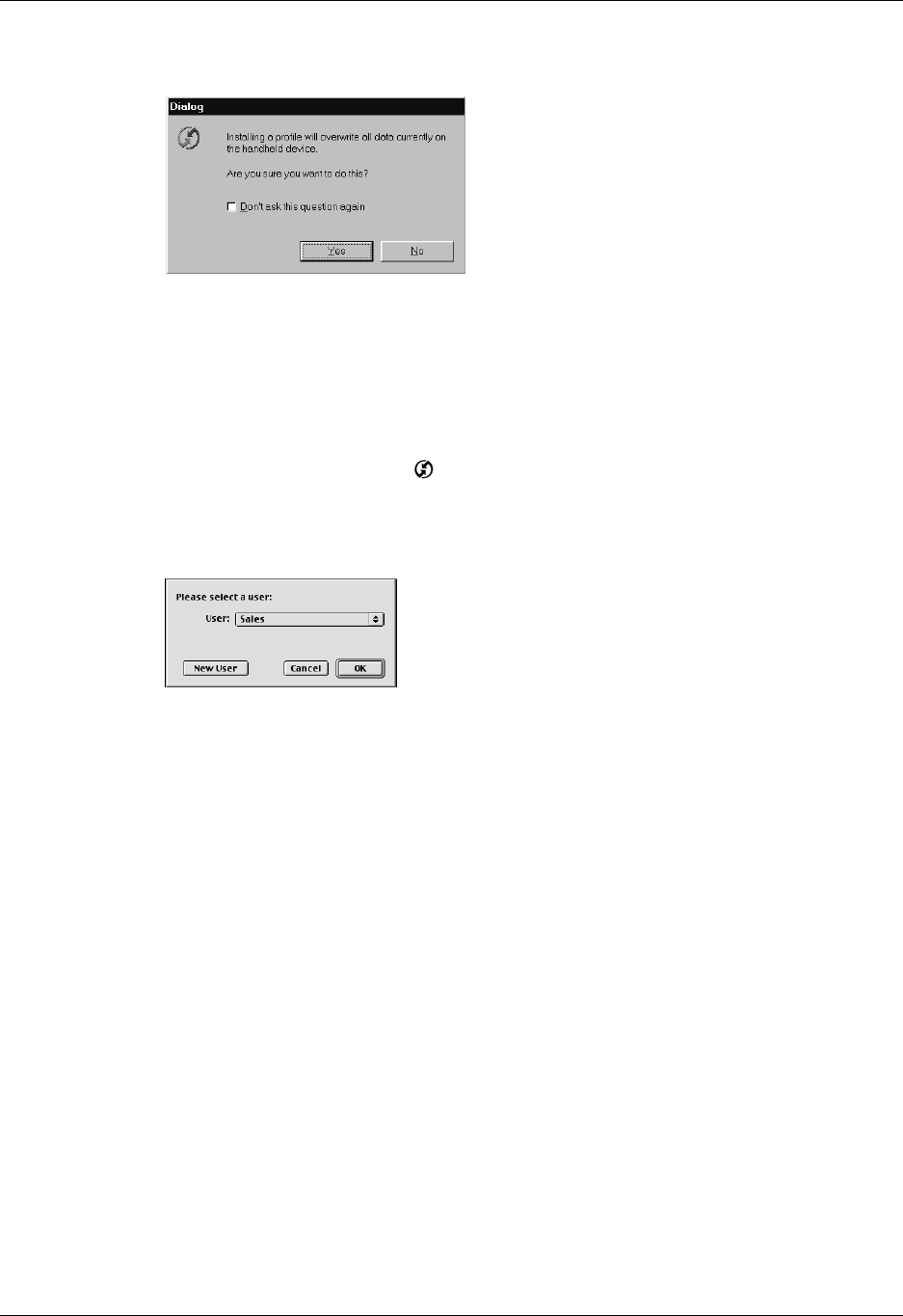
Creating a User Profile
171
4. Select the profile you want to load on the handheld, and click OK.
5. Click Yes to transfer all the profile data to the handheld.
The next time you perform a HotSync operation, Palm Desktop software prompts
you to assign a user name to the handheld.
To use a profile for the first-time HotSync operation on a Macintosh:
1. Connect the new handheld to the HotSync cradle.
2. Press the HotSync button on the cradle.
3. Select the profile you want to load on the handheld, and click OK to transfer all
the profile data to the handheld.
The next time you perform a HotSync operation, Palm Desktop software prompts
you to assign a user name to the handheld.

Performing HotSync® Operations
172

173
CHAPTER 17
Setting Preferences for Your Handheld
The Preferences screens enable you to customize the configuration options on your
handheld, including the following:
Viewing Preferences
To open the Preferences screens:
1. Tap the Applications icon .
2. Tap the Preferences icon .
3. Tap the pick list in the upper-right corner of the screen.
4. Select the Preferences screen you want to view.
Buttons Reassign the following: an application to the Favorite icon,
different applications to the buttons on the front panel of your
handheld and the HotSync® button on the cradle, and the full-
screen pen stroke command.
Connection Configure cradle, modem, and infrared communication settings.
Date and Time Set the date, time, time zone, and Daylight Saving switch.
Digitizer Calibrate the screen on your handheld.
Formats Set the country default and the formats for dates, times,
calendar, and numbers.
General Set these features: auto shutoff interval, Stay on in cradle,
sounds, indicator light, and Beam Receive.
Network Configure your handheld for use with a network.
Owner Assign your name, phone number, and other owner information
to your handheld.
ShortCuts Define a list of Graffiti® abbreviations.
Web Clipping Configure your handheld to make an Internet web connection
using clipping applications either wirelessly (using the internal
radio) or using a modem/dialup connection. See “Web Clipping
Preferences” in Chapter 4 for details.
Wireless Enable wireless coverage by scheduling the radio, or turning it
on or off. Check the signal strength. See “Turning on the radio”
in Chapter 4 for details.
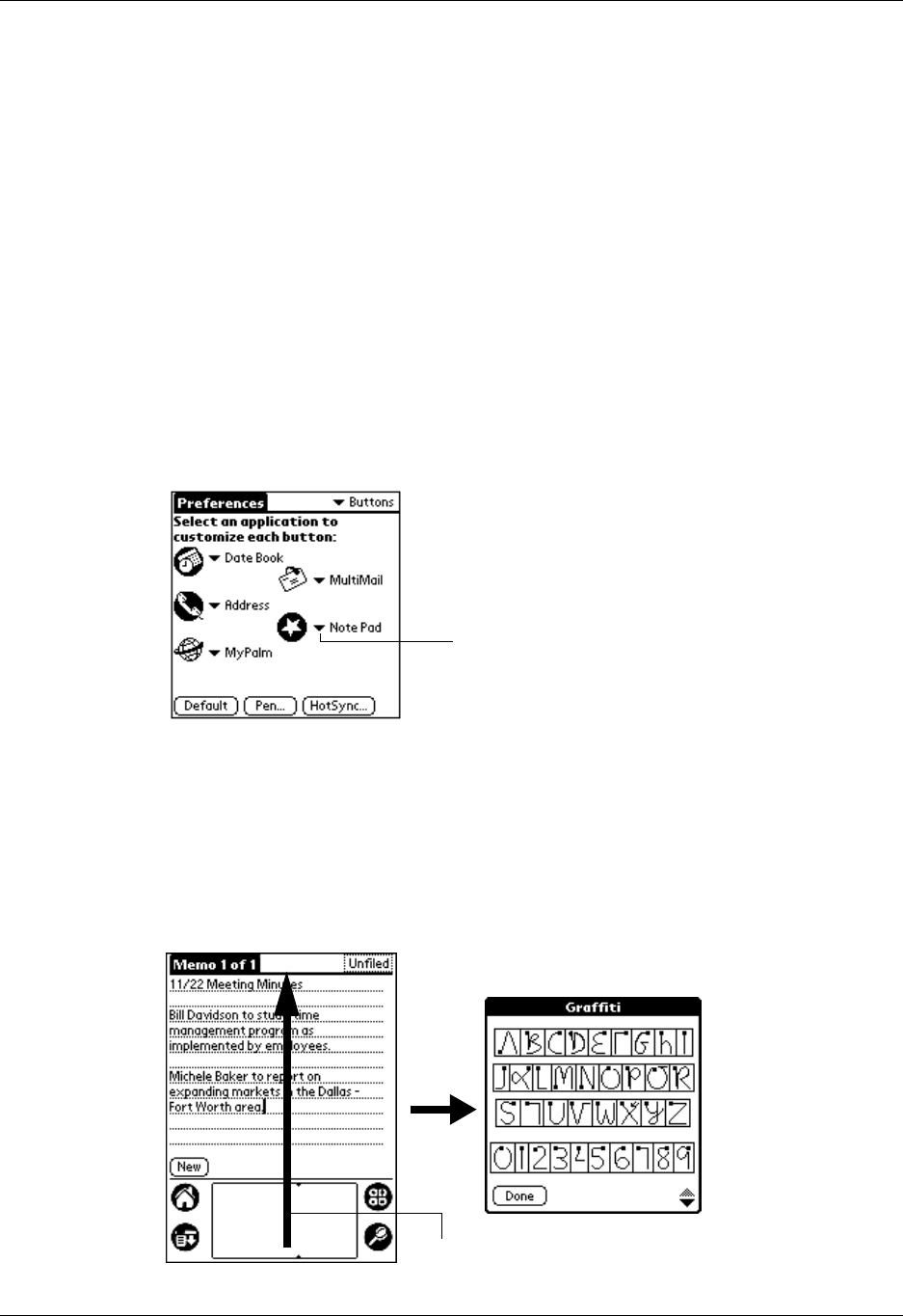
Setting Preferences for Your Handheld
174
Buttons preferences
The Buttons Preferences screen enables you to assign a frequently used application
to the Favorite icon, and to associate different applications with the buttons on the
front of the handheld.
Note Pad is assigned to the Favorite icon the by default. But if you use Memo Pad
more frequently, you can assign Memo Pad to the icon so that you don’t have to
scroll through the Applications Launcher whenever you want to use Memo Pad.
Any changes you make in the Buttons Preferences screen become effective
immediately; you do not have to change to a different screen or application.
If you assign a different application to a button, you can still access the original
application using the Applications Launcher.
To change the Buttons preferences:
1. Tap the pick list next to the button you want to re-assign.
2. Tap the application that you want to assign to the button.
To restore all of the buttons to their factory settings, tap Default.
Pen preferences
The Buttons Preferences screen enables you to change the assignment of the full-
screen pen stroke. By default, the full-screen pen stroke activates Graffiti Help.
Tap arrow to
show pick list
Drag to top of screen
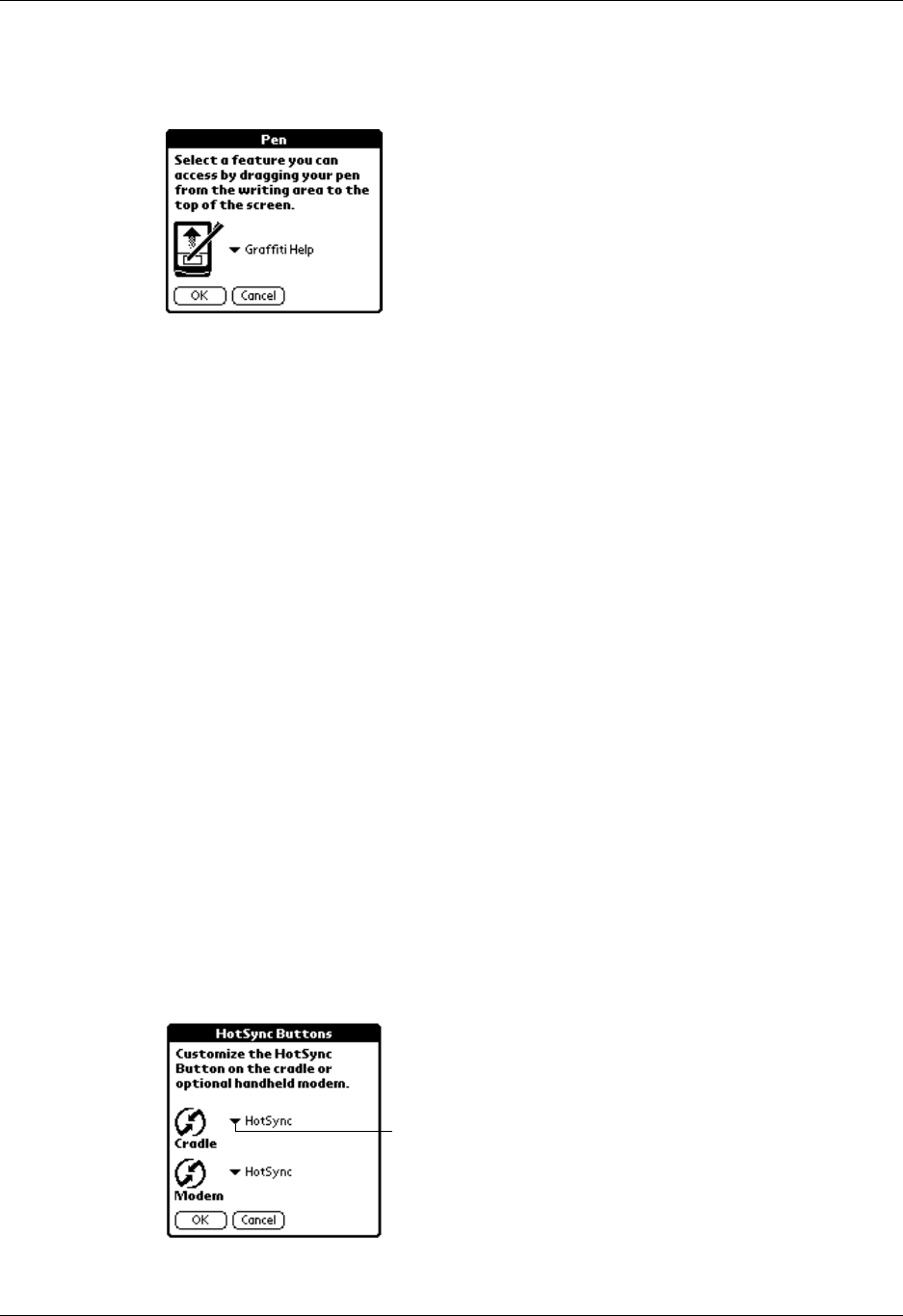
Viewing Preferences
175
To change the Pen preferences:
1. Tap Pen.
2. Tap the pick list and select one of the following settings for the full-screen pen stroke:
3. Tap OK.
HotSync buttons preferences
The Buttons Preferences screen also enables you to associate different applications
with the HotSync button on the cradle and the HotSync button on the optional
PalmModem® accessory. Any changes that you make in the HotSync Buttons
dialog box become effective immediately; you do not have to change to a different
screen or application.
To change the HotSync buttons preferences:
1. Tap HotSync.
2. Tap the pick list next to the button you want to assign.
3. Tap the application that you want to assign to each button.
Backlight Turns on the backlight of your handheld.
Keyboard Opens the onscreen keyboard for entering text characters.
Graffiti Help Opens a series of screens that show the complete Graffiti
character set.
Turn Off & Lock Turns off and locks the handheld. You must assign a
password to lock the handheld. When locked, you need to
enter the password to use your handheld.
Beam Data Beams the current record to another Palm OS® handheld.
Tap a rr o w
to show
pick list
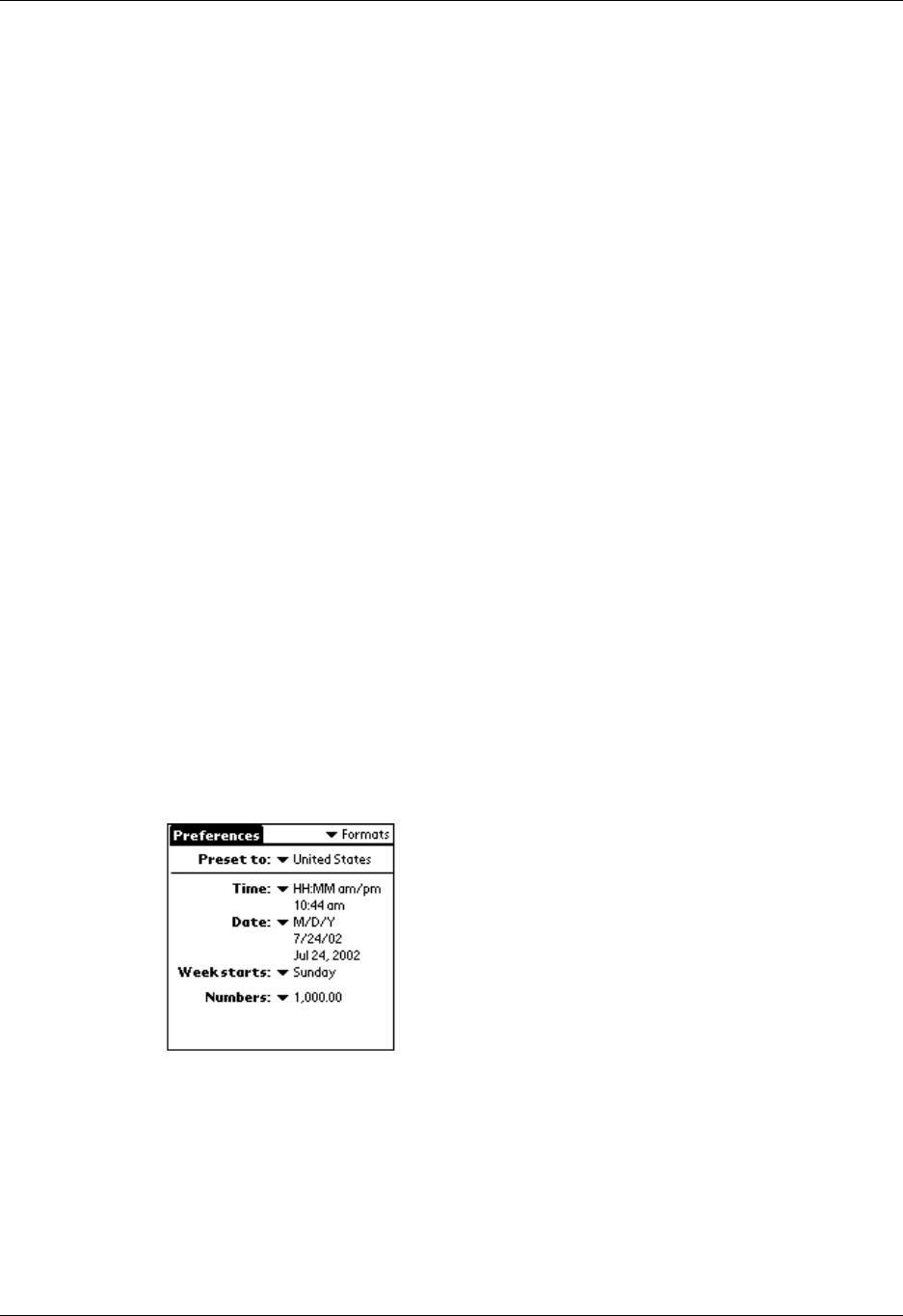
Setting Preferences for Your Handheld
176
The default setting for each button is the HotSync setting, which means the
cradle and optional PalmModem accessories perform their normal HotSync
functions.
4. Tap OK.
Digitizer preferences
The Digitizer Preferences screen opens the digitizer calibration screen. This is the
same screen that appears when you start your handheld for the first time.
You can recalibrate your screen after a hard reset, or if your digitizer drifts.
Formats preferences
Use the Formats Preferences screen to set the country default and the display
format of the dates, times, and numbers on your handheld.
Country default
The country default sets date, time, week start day, and number conventions based
on geographic regions where you might use your handheld. For example, in the
United Kingdom, time often is expressed using a 24-hour clock. In the United
States, on the other hand, time is expressed using a 12-hour clock with an AM or
PM suffix.
All your handheld applications use the Country default settings. You can,
however, customize your own preferences as described in “Time, date, week start,
and numbers formats” later in this chapter.
To set the country default:
1. Tap the country name pick list.
2. Tap the setting you want to use.
Time, date, week start, and numbers formats
The Time setting defines the format for the time of day. The time format that you
select appears in all applications on your handheld.

Viewing Preferences
177
To select the time, date, week start, and numbers format:
1. Tap the Time pick list and select a format.
2. Tap the Date pick list and select a format.
3. Tap the Week starts pick list, and select whether you want the first day of the
week to be Sunday or Monday.
This setting controls the Day, Week, and Month views in Date Book and all other
aspects of your handheld that display a calendar.
4. Tap the Numbers pick list, and select formats for the decimal point and
thousands separator.
General preferences
The General Preferences screen enables you to set the auto shutoff interval, alarm options,
sounds for your handheld, and the Beam Receive feature.
Auto-off delay
Your handheld has an automatic shutoff feature that turns off the power and
backlight after a period of inactivity. This feature helps conserve battery power in
case you forget to turn off your handheld.
If you find that your handheld shuts itself off before you finish reviewing the
information on the screen, you should increase the time setting of the automatic
shutoff feature.
To set the Auto-off delay:
1. Tap the Auto-off pick list.
2. Tap the setting you want to use for the automatic shutoff feature: 30 seconds, 1
minute, 2 minutes, or 3 minutes.
Cradle settings
You can choose to leave your handheld on when it is in the cradle during a
HotSync operation, or when you are recharging the battery, so you can continue to
view your data.
To change the cradle setting:
■Tap the Stay on in Cradle check box to leave your handheld on when it is in the
cradle.
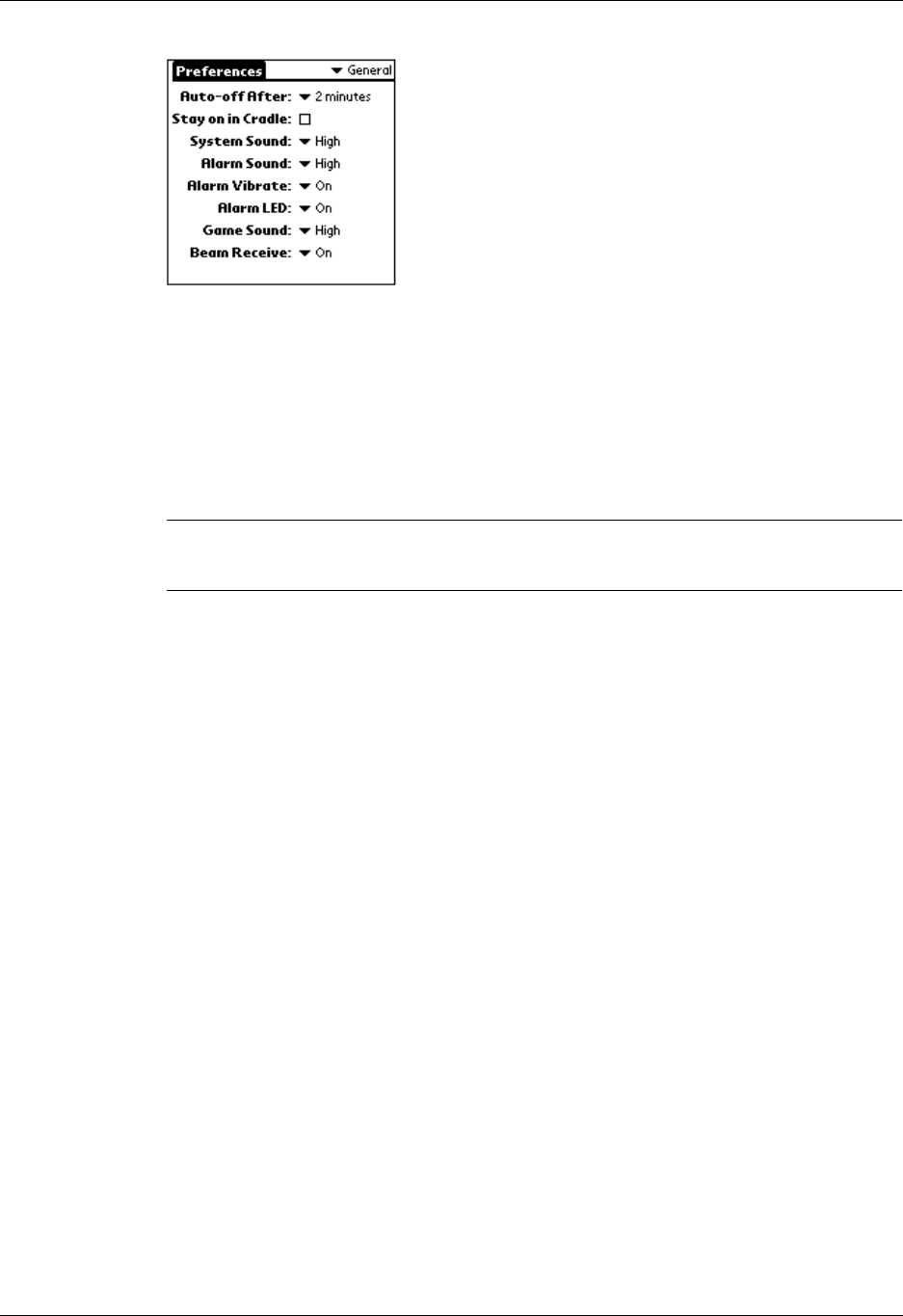
Setting Preferences for Your Handheld
178
System, alarm, and game sounds
Your handheld uses a variety of sounds. The System, Alarm, and Game Sound
settings enable you to turn the sounds on or off, and to adjust the volume level.
To set the system and alarm sounds:
1. Tap the System Sound pick list and select the sound level.
IMPORTANT When you turn off the System Sounds, you also turn off the “chime”
tones associated with the HotSync operation.
2. Tap the Alarm Sound pick list and select the sound level.
Tap the Game Sound pick list and select the sound level.
The Game Sound setting works only with games that are programmed to
respond to this setting. Older games typically do not respond to this setting.
Alarm vibrate and indicator light settings
You can set alarms in Date Book, Clock, and Note Pad to remind yourself of
important meetings or notes. When you enable the Alarm Vibrate and indicator
light settings, your handheld vibrates and the indicator light blinks to notify you
of alarms. This is useful for situations where you want to turn the Alarm Sound off,
but still be notified of alarms.
To set the Alarm Vibrate and indicator light settings:
1. Tap the Alarm Vibrate pick list and select On or Off.
2. Tap the Alarm LED pick list and select On or Off.
Beam Receive
You can choose to turn off the Beam Receive feature. This prohibits anyone from
beaming information to your handheld. It also results in a slight saving of battery
power.
To change the Beam Receive setting:
■Tap the Beam Receive pick list and select On or Off.
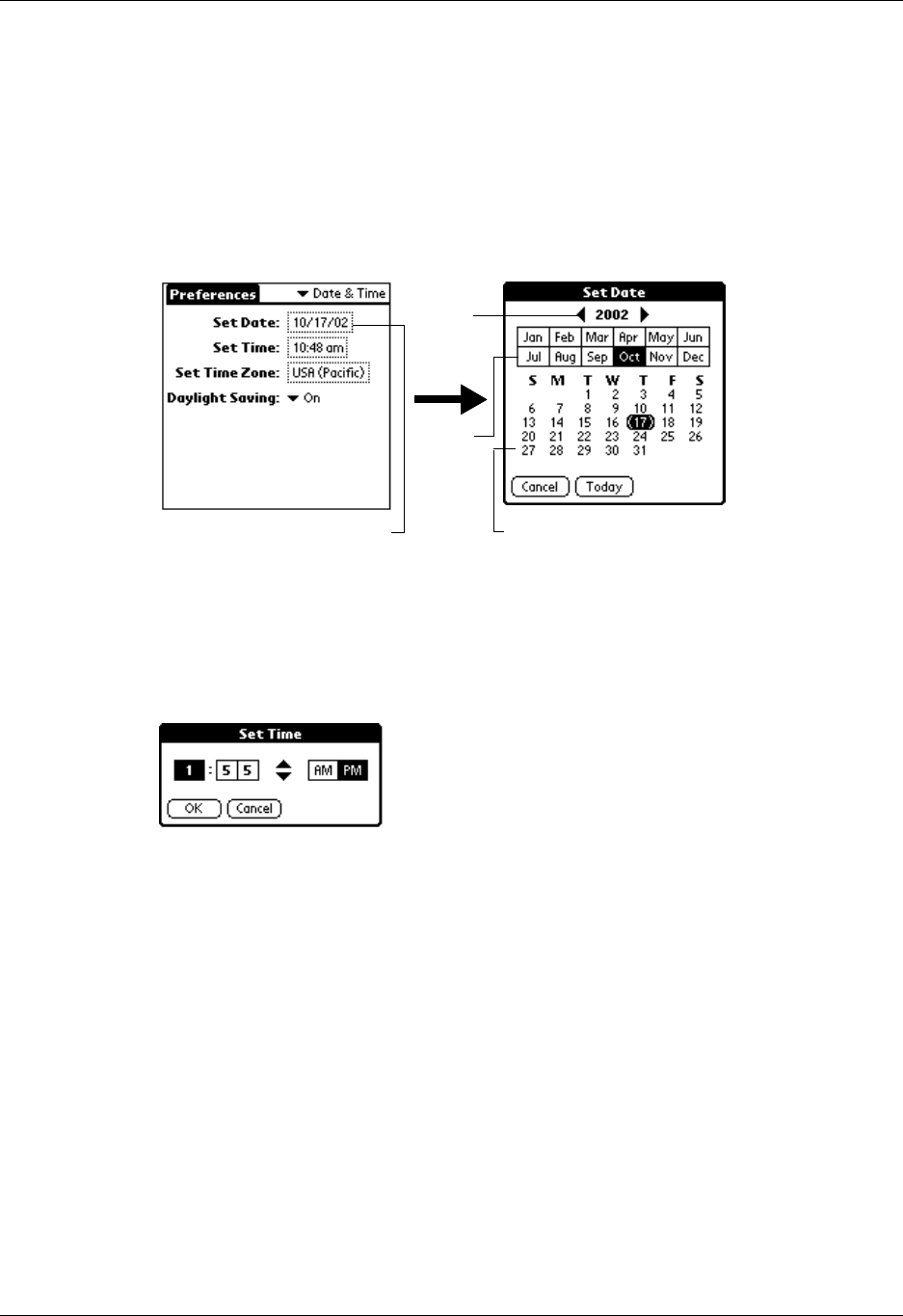
Viewing Preferences
179
Date and Time preferences
The Date and Time Preferences screen enables you to set the date, time, time zone,
and Daylight Saving option on your handheld.
To set the date:
1. Tap the Set Date box.
2. Tap the arrows to select the current year.
3. Tap a month.
4. Tap the current date.
To set the time:
1. Tap the Set Time box.
2. Tap the up or down arrows to change the hour.
3. Tap each number of the minute, and then tap the arrows to change them.
4. Tap OK.
Tap to set date
Ta p
arrows
to
select
Tap to
select
Tap to select date
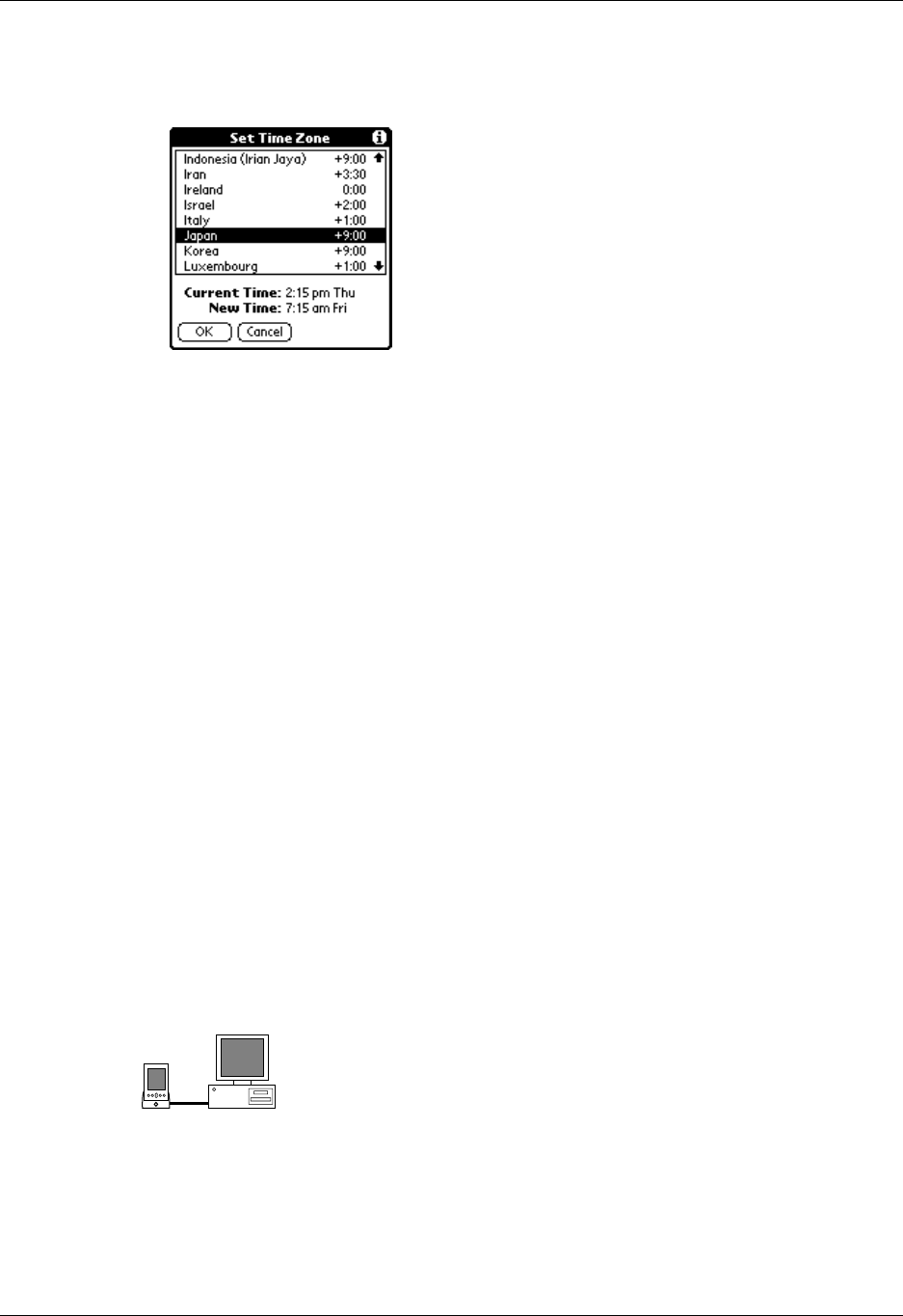
Setting Preferences for Your Handheld
180
To set the time zone:
1. Tap the Set Time Zone box.
2. Tap a time zone.
When you travel, changing the time zone setting to a new time zone
automatically resets the date and time on your handheld, but it does not change
the time of appointments set in Date Book.
3. Tap OK.
To set the daylight saving switch:
■Tap the Daylight Saving pick list, and then tap Off or On.
Connection preferences
The Connection Preferences screen enables you to define the settings used to
connect your handheld to other devices. The screen displays a list of available
configurations that are ready to be further defined; the list varies depending on the
kind of software you’ve added to your handheld.
For example, a modem connection appears on the list. If you have this modem, you
only need to specify the phone setup (and network connection — if required) to
complete the configuration.
NOTE You can purchase a PalmModem accessory for use with your handheld. See
www.palm.com.
You can also create custom configurations, which include the following:
PC via Cradle/Cable: A local HotSync connection: the direct
connection between your handheld and your desktop computer.
Your handheld is connected by its universal connector to the cradle,
and the cradle is attached by its cable to a USB port of your desktop
computer. (If you are using the optional serial cradle, the cradle
attaches by its cable to a serial (COM) port of your computer.)
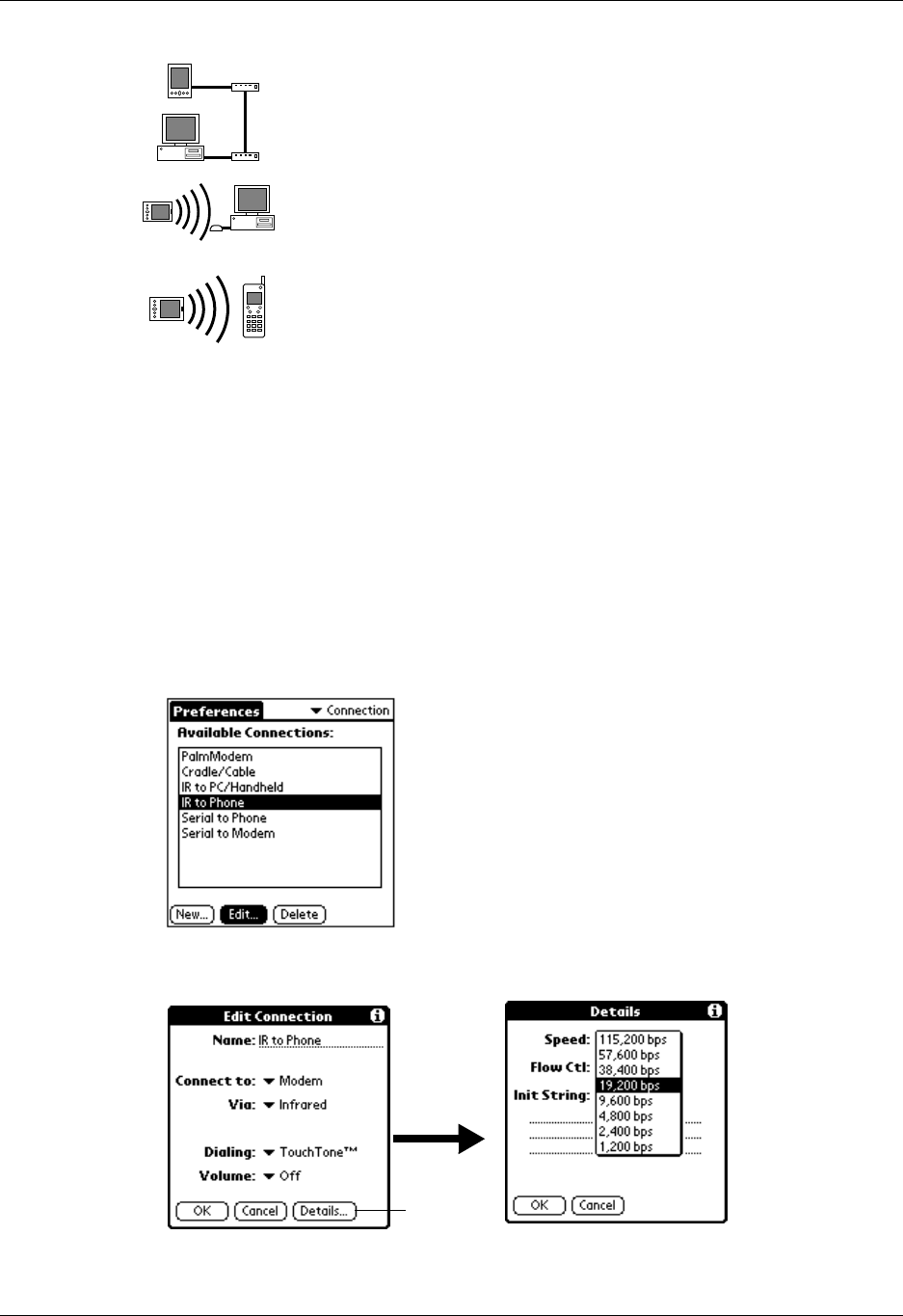
Viewing Preferences
181
Editing connections
The following example shows you how to edit the IR to Phone connection to adjust
the communication speed; you can similarly edit other connections or settings. You
can use the IR to Phone connection to perform a remote IR HotSync operation. To
accomplish the HotSync operation, your handheld sends data through its IR port
to a modem attached to or within a mobile phone, which then dials a modem
attached to or within your desktop computer, to synchronize with your Desktop
application.
To edit the IR to Phone connection:
1. Select the IR to Phone connection and tap Edit.
2. Tap Details.
3. Tap the Speed pick list and select the appropriate speed.
Modem via Cradle/Cable: A cable connection between your
handheld’s universal connector and a modem for dialing in to a
modem that is part of your computer or laptop.
PC via Infrared: A connection between the IR port of your handheld
and the infrared device of your computer or laptop.
Modem via Infrared: A connection between the IR port of your
handheld and a modem. The modem can be attached to or within a
mobile phone or some other device containing an IR port. (Some IR
phones contain modems.)
Ta p h e r e

Setting Preferences for Your Handheld
182
4. Enter the initialization string supplied by the documentation for the modem
attached to your mobile phone, if necessary.
5. Tap OK, and then tap OK again to save the configuration.
After you create the configuration, you need to set up the HotSync Manager of
your Desktop application and the HotSync application of your handheld to
perform a modem HotSync operation.
Network preferences and TCP/IP software
Although your handheld is wirelessly enabled, you can also use TCP/IP software
that is included in the handheld operating system to connect with Internet Service
Providers (ISPs) or dial-in (remote access) servers. The Network Preferences
settings enable you to do this.
To use TCP/IP, you must create a configuration in Connection Preferences and
then create Network Preferences settings.
The Connection Preferences screen enables you to define several ways that your
handheld can use the a modem to communicate with remote devices. For example,
you can communicate with your ISP server, or with your computer if you are away
on travel. See “Connection preferences” earlier in this chapter for a complete
explanation on how to create modem configurations.
After you configure both the Connection and Network Preferences, you can
establish a PPP (Point-to-Point Protocol), SLIP (Serial Line Internet Protocol), or
CSLIP (Compressed Serial Line Internet Protocol) connection with your ISP or
dial-in server. You can do this either by using menu commands from the Network
Preferences screen or by using a third-party application.
NOTE TCP/IP provides the ability to connect to your ISP or dial-in server with
applications that allow you to view the transmitted data. Visit the web site
www.palm.com for information on third-party applications that take advantage of
TCP/IP.
Disabling the internal radio
When wireless coverage is enabled and the internal radio is turned on, you must
first disable the radio before you can use a modem accessory.
To disable the radio:
1. Open Network Preferences. When the radio is enabled, the Service pick list will
show Palm Wireless Service.
2. Tap Disconnect.
The Radio Off dialog appears. It closes when the radio has turned off.
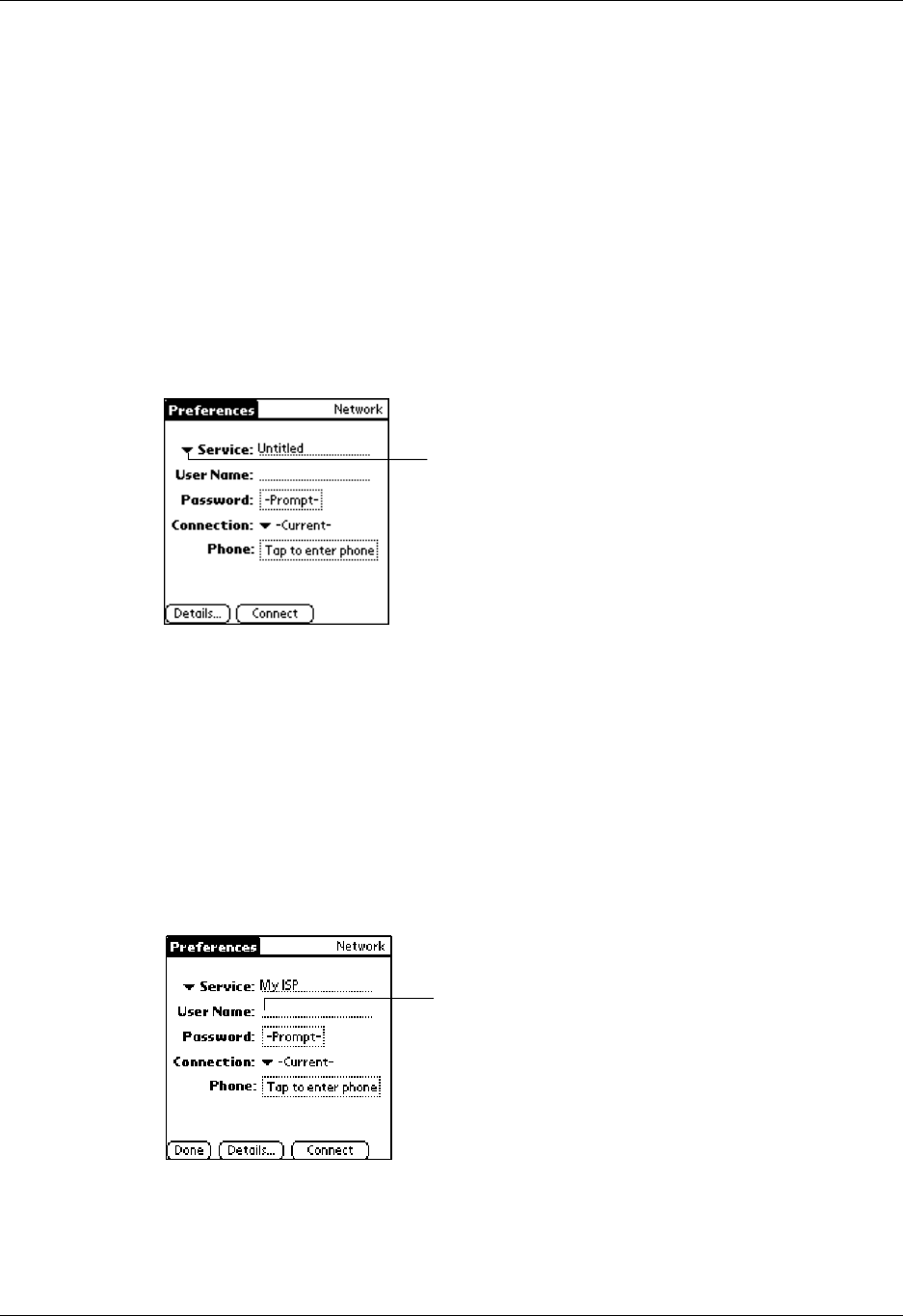
Viewing Preferences
183
NOTE When you finish using a modem accessory and want to resume
wireless coverage, you must turn the radio on again in the Wireless
Preferences screen. See “Turning on the radio” in Chapter 4 for details. Once
you enable the radio, Network Preferences and Web Clipping Preferences are
updated to Palm Wireless Service.
Selecting a service
Use the Service setting to select the service template for your Internet Service
Provider or a dial-in server. Service templates are a set of ISP and dial-in server
configuration settings that you can create, save, and reuse.
To select a service:
1. Tap the Service pick list.
2. Tap the predefined service template you want to use.
Entering a user name
The User Name setting identifies the name you use when you log into your
Internet Service Provider or your dial-in server. Although this field can contain
multiple lines of text, only two lines appear onscreen.
To enter a user name:
1. Tap the User Name field.
1. Enter your user name.
NOTE Most dial-in servers do not accept spaces in the user name.
Tap here to display a
list of service
templates
Enter your user
name here
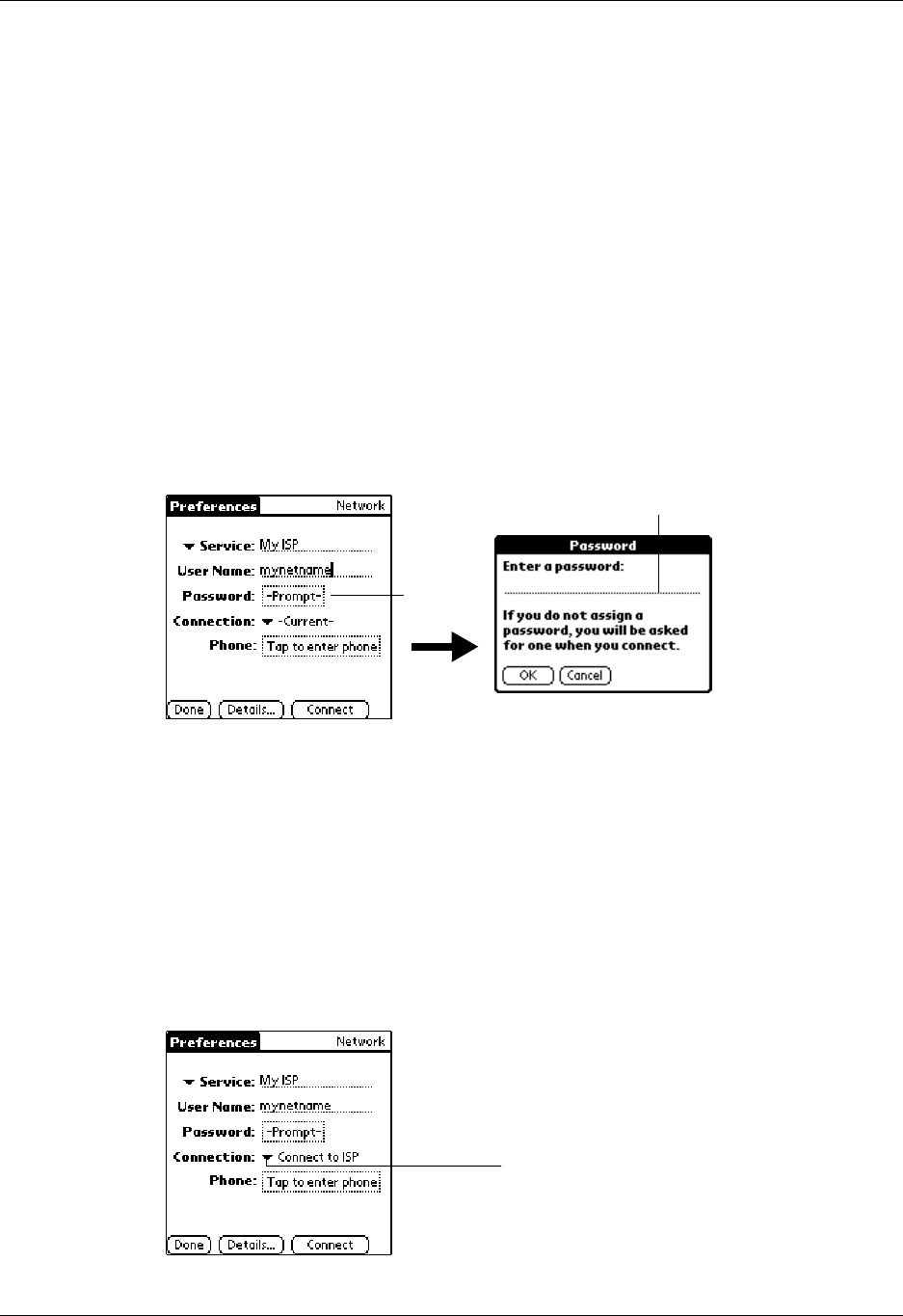
Setting Preferences for Your Handheld
184
Entering a password
The Password box identifies the password you use to log into your server or ISP.
Your entry in this field determines whether your handheld prompts you to enter a
password each time you log into your network:
■If you do not enter a password, your handheld displays the word “Prompt” in
this field and asks you to enter a password during the login procedure.
■If you enter a password, your handheld displays the word “Assigned” in this
field and does not prompt you to enter a password during the login procedure.
If you are concerned about security, select the Prompt option and do not enter a
password.
To enter a password:
1. Tap the Password field.
2. Enter the password you use to log into your server.
.
3. Tap OK.
The Password field updates to display the word “Assigned.”
Selecting a connection
Use the Connection setting to select the method you want to use to connect to your
Internet Service Provider or a dial-in server. See “Connection preferences” earlier
in this chapter for information about creating and configuring connection settings.
To select a connection:
1. Tap the Connection pick list.
Enter password here
Ta p h e r e
Tap here to display a
list of available
connections
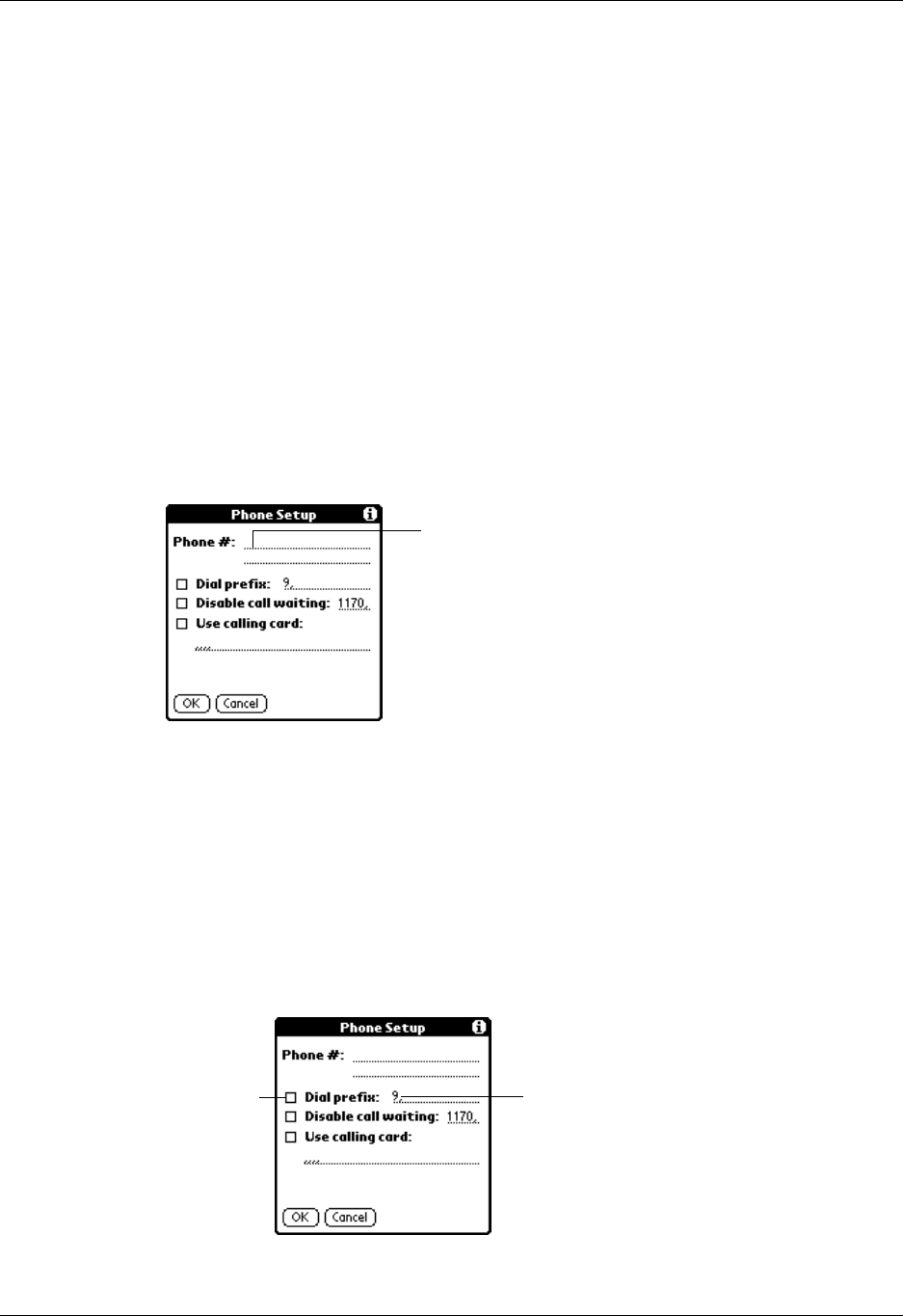
Viewing Preferences
185
2. Tap the connection you want to use.
Adding telephone settings
When you select the Phone field, your handheld opens a dialog box in which you
define the telephone number you use to connect with your ISP or dial-in server. In
addition, you can also define a prefix, disable Call Waiting, and give special
instructions for using a calling card.
NOTE The Phone Setup dialog box works correctly for AT&T and Sprint long-
distance services. However, because MCI works differently, MCI customers need to
put the calling card number in the Phone # field and the phone number in the Use
calling card field.
To enter your server phone number:
1. Tap the Phone field.
2. Enter the phone number for your ISP or dial-in server.
3. If you need to enter a prefix or disable Call Waiting, skip to those procedures.
Otherwise, tap OK.
Entering a prefix
A prefix is a number that you dial before the telephone number to access an outside
line. For example, many offices require that you dial “9” to dial a number outside
the building.
To enter a prefix:
1. Tap the Dial Prefix check box to select it.
2. Enter the prefix.
Enter your ISP phone
number here
Enter your
prefix here
Select this
box if you
need to use a
prefix
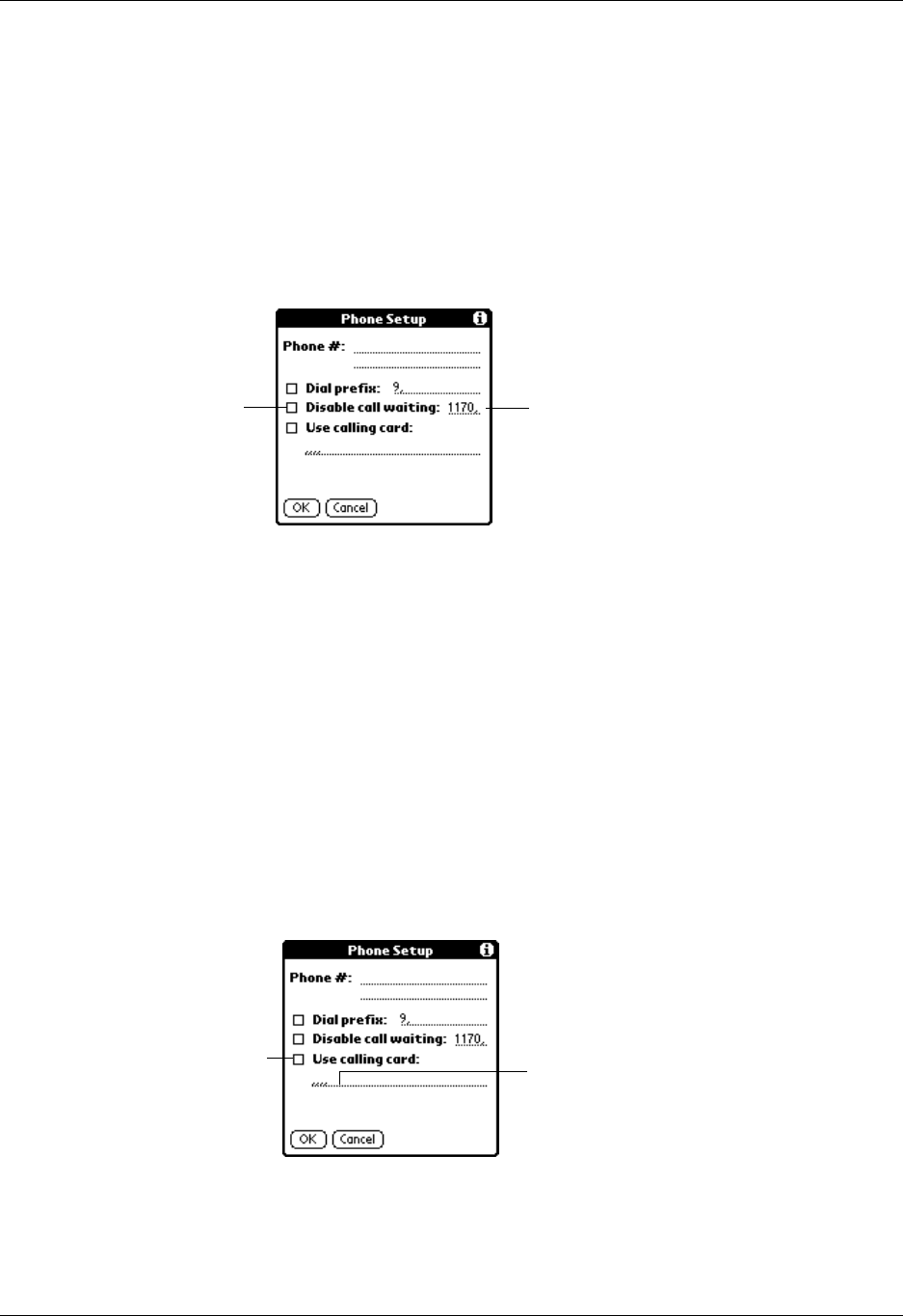
Setting Preferences for Your Handheld
186
3. Tap OK.
Disabling Call Waiting
Call Waiting can cause your session to terminate if you receive a call while you are
connected. If your telephone has Call Waiting, you need to disable this feature
before logging into your ISP or dial-in server.
To disable Call Waiting:
1. Tap the Disable call waiting check box to select it.
2. Enter the code to disable Call Waiting on the Disable call waiting line.
Each telephone company assigns a code to disable Call Waiting. Contact your
local telephone company for the code that is appropriate for you.
3. Tap OK.
Using a calling card
The Use calling card field enables you to use your calling card when dialing your
ISP or Intranet server. Keep in mind that there is usually a delay before you enter
your calling card number. When you define your calling card number, you need to
add commas at the beginning to compensate for this delay. Each comma delays
transmission of your calling card number for two seconds.
To use a calling card:
1. Tap the Use calling card check box to select it.
2. Enter your calling card number on the Use calling card line.
TIP It’s a good idea to add at least three commas before your calling card
number to compensate for the cue delay.
Enter your disable
code here
Select this
box if you
need to
disable Call
Waiting
Enter your
calling card
number here
Select this
box to use a
calling card

Viewing Preferences
187
3. Tap OK.
Connecting to your service
After you set your Connection and Network Preferences, establishing a connection
to your Internet Service Provider (ISP) or your company’s network (dial-in server)
is easy.
NOTE If you are connecting to an ISP, you need a third-party application, such as a
web browser or news reader, to take advantage of this connection. For information
about third-party applications that support TCP/IP, check the web site
www.palm.com.
To establish a connection:
■Tap Connect to dial the current service and display the Service Connection
Progress messages.
To see expanded Service Connection Progress messages, press the lower half of
the Scroll button.
To close a connection:
■Tap Disconnect to terminate the connection between your handheld and your
service.
Creating additional service templates
You can create additional service templates from scratch or by duplicating existing
templates and editing information. After you create a new or duplicate template,
you can add and edit settings.
To add a new service template:
1. Tap the Menu icon .
2. Tap Service, and then tap New.
An Untitled service template is added to the Service pick list.
To duplicate an existing service template:
1. Tap the Service pick list.
2. Tap the predefined service template you want to duplicate.
3. Tap the Menu icon .
4. Tap Service, and then tap Duplicate.
A copy of the service template is added to the Service pick list.
Adding detailed information to a service template
If you are using one of the predefined service templates, you probably only need
to enter your user name and telephone number. If you are creating a new service
template, you may need to provide additional information to your ISP or dial-in
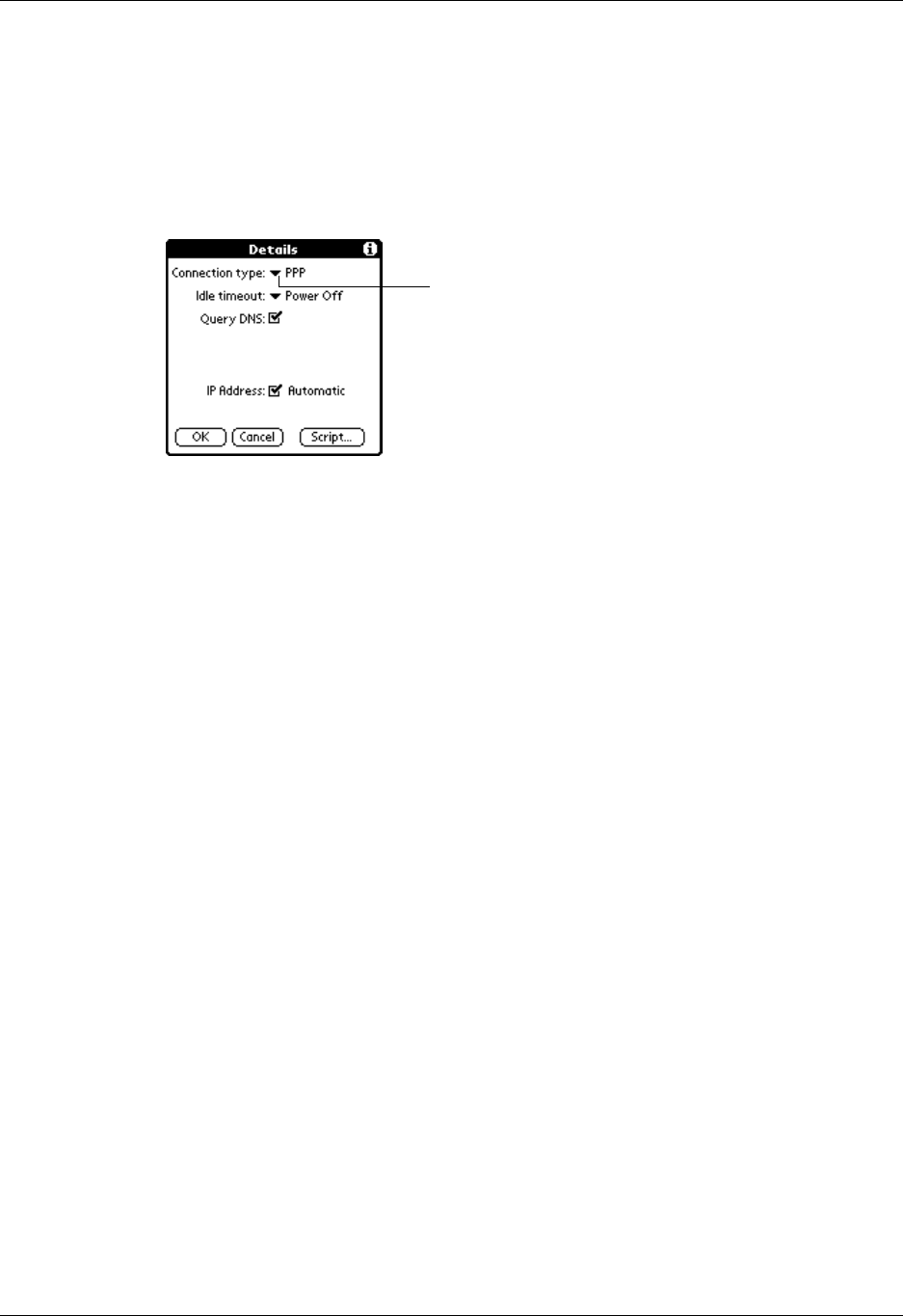
Setting Preferences for Your Handheld
188
server. You use the Details dialog box to add additional information to a selected
service template.
To select a connection type:
1. Tap the service field.
2. Tap Details.
3. Tap the Connection type pick list and select one of the following connection
types:
If you are not sure, try PPP; if that doesn’t work, ask your Internet Service
Provider or your System Administrator for the correct connection type.
Note to Seattle engineers: Is the connection type pick list (above) gone? Can’t tell
from Poser, but I believe this is no longer an editable field. Please confirm/correct.
Idle timeout
The Idle timeout setting defines how long your handheld waits before dropping
the connection with your ISP or dial-in server when you switch out of a TCP/IP
application.
PPP Point-to-Point protocol
SLIP Serial Line Internet Protocol
CSLIP Compressed Serial Line Internet Protocol
Select connection type

Viewing Preferences
189
To set the Idle timeout:
1. Tap the Idle timeout pick list and select one of the following options:
2. Tap OK.
Defining primary and secondary DNS
The Domain Naming System (DNS) is a mechanism in the Internet for translating the
names of host computers into IP addresses. When you enter a DNS number (or IP address),
you are identifying a specific server that handles the translation services.
Each IP address has four sections, separated by periods. In the Details dialog box,
you enter each section separately. Each section of an IP address is made up of a
number from 0 to 255; numbers are the only allowable characters in this field.
Ask your Internet Service Provider or System Administrator for the correct
Primary or Secondary DNS IP numbers.
Many systems do not require that you enter a DNS. If you are not sure, leave the
DNS field blank.
To enter a primary and secondary DNS:
1. Tap the Query DNS check box to deselect it.
2. Tap the space to the left of the first period in the Primary DNS field, and then
enter the first section of the IP address.
Each section must be a number from 0 to 255.
3. Repeat step 2 for the second, third, and last sections of the Primary DNS field.
4. Repeat steps 2 and 3 for the Secondary DNS number.
5. Tap OK.
IP address
Everyone who logs on to the Internet needs to have a unique identifier (an IP
address), whether permanent or temporary. Some networks dynamically assign a
temporary IP address when clients log in. The IP Address field lets you identify
whether your network provides automatic (dynamic) temporary IP addressing.
If your IP address is permanently assigned, you need to get that information from
your System Administrator. If you are not sure, select Automatic.
1 minute Waits one minute for you to open another application before it
drops the connection.
2 minutes Waits two minutes.
3 minutes Waits three minutes.
Never Keeps your PPP or SLIP connection until you turn off your
handheld (or until it times out). This option works best with the
PalmModem accessory.

Setting Preferences for Your Handheld
190
To identify dynamic IP addressing:
■Tap the IP Address check box to select it.
To enter a permanent IP address:
1. Tap the IP Address check box to deselect it and display a permanent IP address
field below the check box.
2. Tap the space to the left of the first period then enter the first section of the IP
address.
Each section must be a number from 0 to 255.
3. Tap and enter the remaining sections of the IP address.
4. Tap OK.
Login scripts
A login script is a series of commands that automates logging in to a network
server, for example, your corporate network or your Internet Service Provider
(ISP). A login script is associated with a specific service template created in
Network Preferences.
A login script is something that you are likely to receive from your IS System
Administrator if your company has a system in which you log in to the corporate
servers from your handheld using a modem or network connection. The script is
generally prepared by the System Administrator and distributed to users who
need it. It automates the events that must take place in order to establish a
connection between your handheld and the corporate servers.
You can create login scripts in two ways:
■In a text editor on your desktop computer, in which you create a file with the
extension PNC, which you then install on your handheld using the Install Tool
(this method is not available to Macintosh users)
■In the Login Script dialog box on your handheld, accessed from the Details
dialog box in Network Preferences
Tap to select automatic IP
address
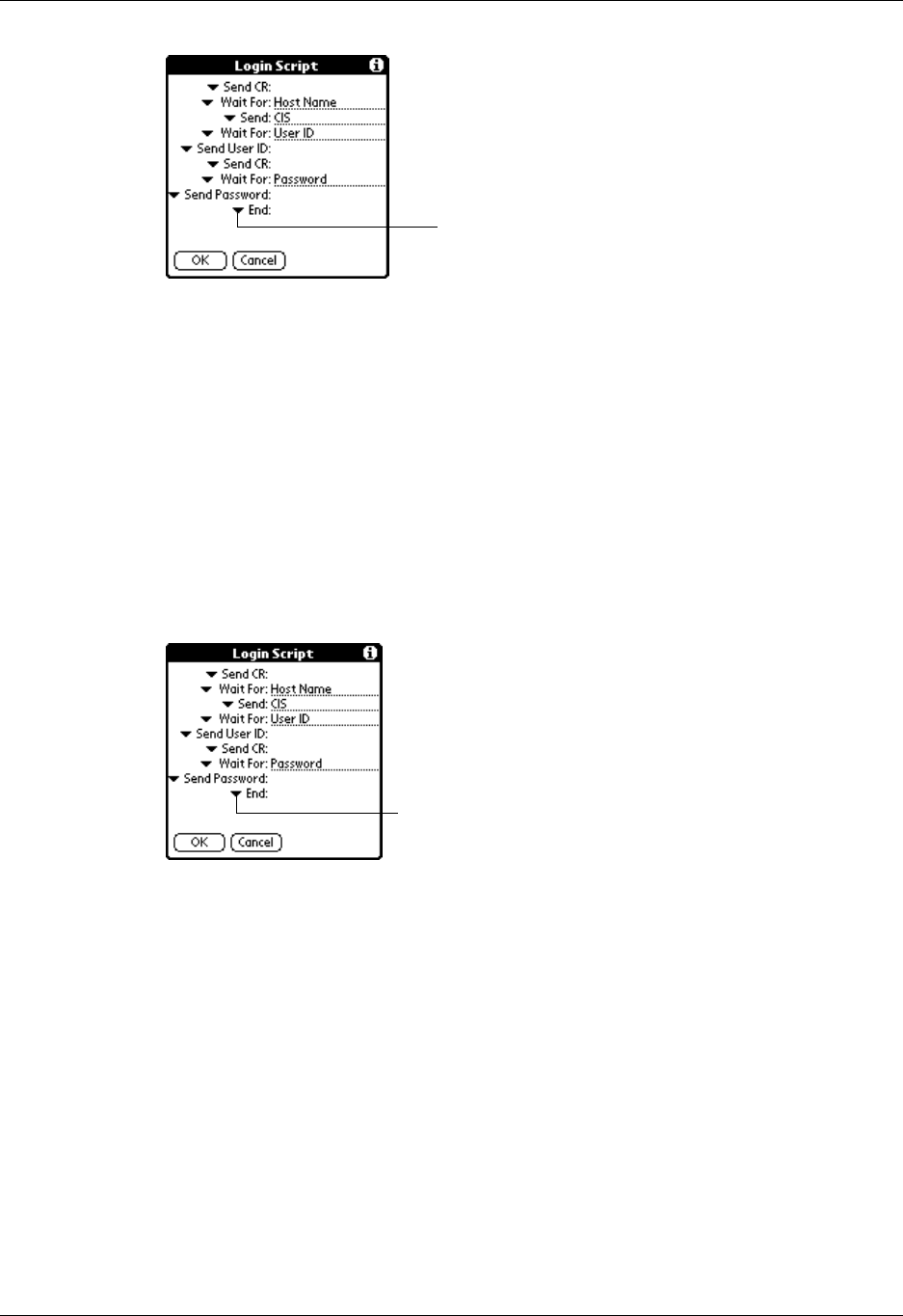
Viewing Preferences
191
NOTE You can also use non-ASCII and literal characters in your login script.
Creating a login script on your handheld
You can create login scripts by selecting commands from the Command pick list in
the Login Script dialog. Some commands, such as Send, require you to supply
additional information. Those commands have a parameter field so that you can
add the necessary data.
To create a login script:
1. Tap Script.
2. Tap the End pick list.
3. Tap the command you want from the Command list. If the command requires
additional information, a field appears to the right of it for you to enter the
information. The following commands are available:
Wait For Tells your handheld to wait for specific characters from the TCP/
IP server before executing the next command.
Wait For
Prompt Detects a challenge-response prompt coming from the server
and then displays the dynamically generated challenge value.
You then enter the challenge value into your token card, which in
turn generates a response value for you to enter on your
handheld. This command takes two arguments, separated by a
vertical bar (|) on the input line.
Send Transmits specific characters to the TCP/IP server to which you
are connecting.
Tap here to see the list of
available commands
Ta p h e r e

Setting Preferences for Your Handheld
192
4. Repeat steps 2 and 3 until the login script is complete.
5. Tap OK.
Plug-in applications
You can create plug-in applications containing script commands that extend the
functionality of the built-in script commands. A plug-in application is a standard
PRC application that you install on your handheld just like any other application.
After you install the plug-in application, you can use the new script commands in
a login script.
Plug-in applications have the following characteristics:
■Written in C language
■Compiled into a device executable
■Called properly from a login script
■Able to return control to a login script after it terminates
■Created using a development environment that supports Palm OS® software,
such as Metrowerks CodeWarrior for Palm Platform.
For additional information on creating plug-in applications, send
e-mail to Palm Developer Support at devsupp@palm.com.
Deleting a service template
There is only one way to delete a service template: use the Delete command from
the Service menu.
Send CR Transmits a carriage return or LF character to the TCP/IP server to
which you are connecting.
Send User ID Transmits the User ID information entered in the User ID field of
the Network Preferences screen.
Send
Password Transmits the password entered in the Password field of the
Network Preferences screen. If you did not enter a password, this
command prompts you to enter one. The Password command is
usually followed by a Send CR command.
Delay Tells your handheld to wait a specific number of seconds before
executing the next command in the login script.
Get IP Reads an IP address and uses it as the IP address for your
handheld. This command is used with SLIP connections.
Prompt Opens a dialog box and prompts you to enter text of some kind
(for example, a password or a security code).
End Identifies the last line in the login script.
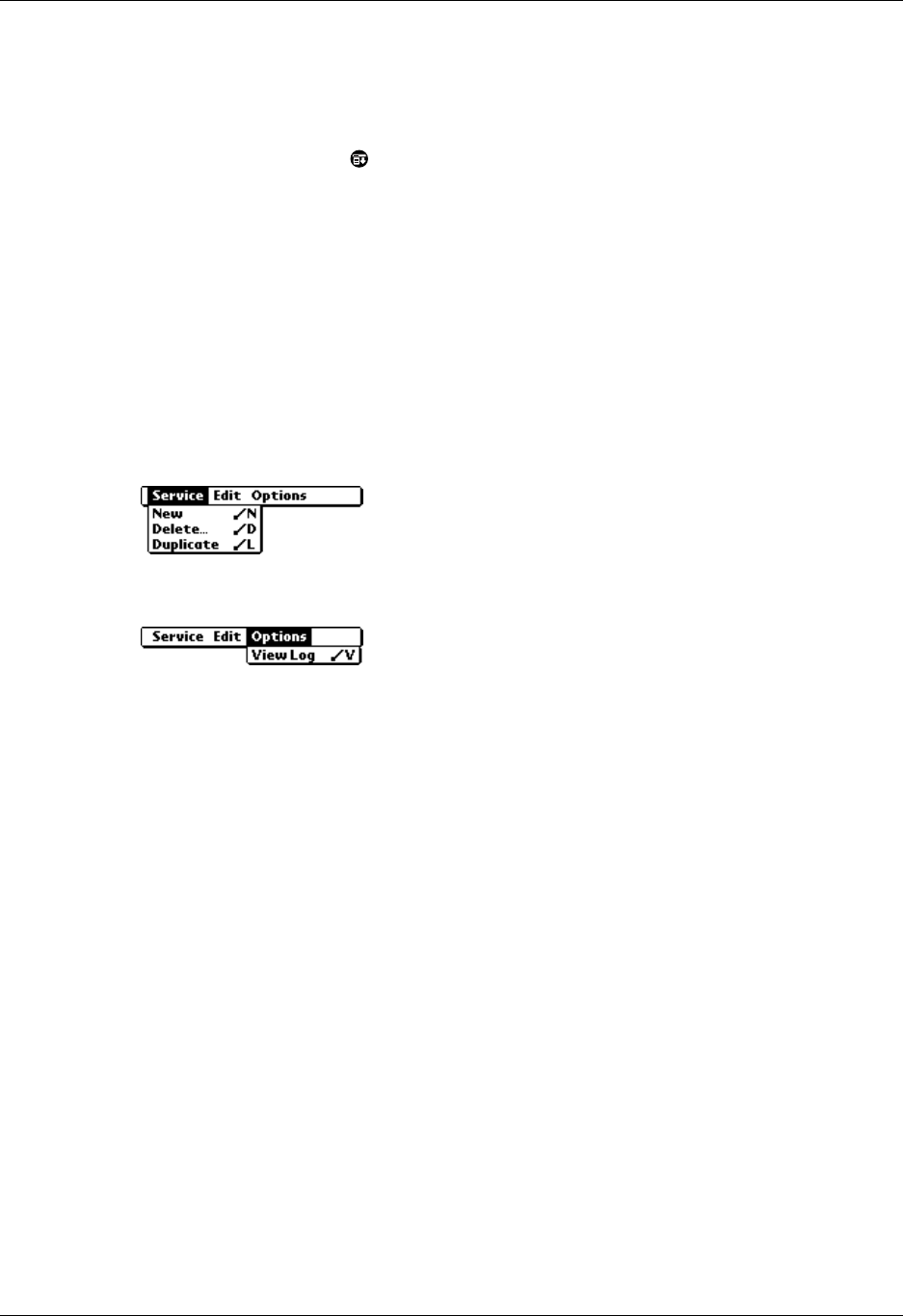
Viewing Preferences
193
To delete a service template:
1. Tap the Service pick list.
2. Tap the service template you want to delete.
3. Tap the Menu icon .
4. Tap Service, and then tap Delete.
5. Tap OK.
Network preferences menu commands
The Network Preferences screen includes menu commands to make it fast and easy
to create and edit service templates. TCP/IP application menus are shown here for
your reference. See “Using menus” in Chapter 5 for more information about
choosing menu commands.
Service menu
Options menu
TCP/IP troubleshooting
If you are having a problem establishing a network connection using TCP/IP,
check this section and try the suggestions listed.
Displaying expanded Service Connection Progress messages
It’s helpful to identify at what point in the login procedure the connection fails. An
easy way to do this is to display the expanded Service Connection Progress
messages. Expanded Service Connection Progress messages describe the current
stage of the login procedure. Press the lower half of the scroll button at any point
during login to display these messages.
Viewing the Network Log
If viewing the expanded Service Connection Progress messages does not give you
enough information to find out why you cannot connect to your ISP or dial-in
server, take a look at the Network Log. The Network Log lists all of the
communication that occurs between your modem and your dial-in server during
the login procedure. The information in the Network Log can help your ISP or your
System Administrator pinpoint where the login procedure communication fails
and why.
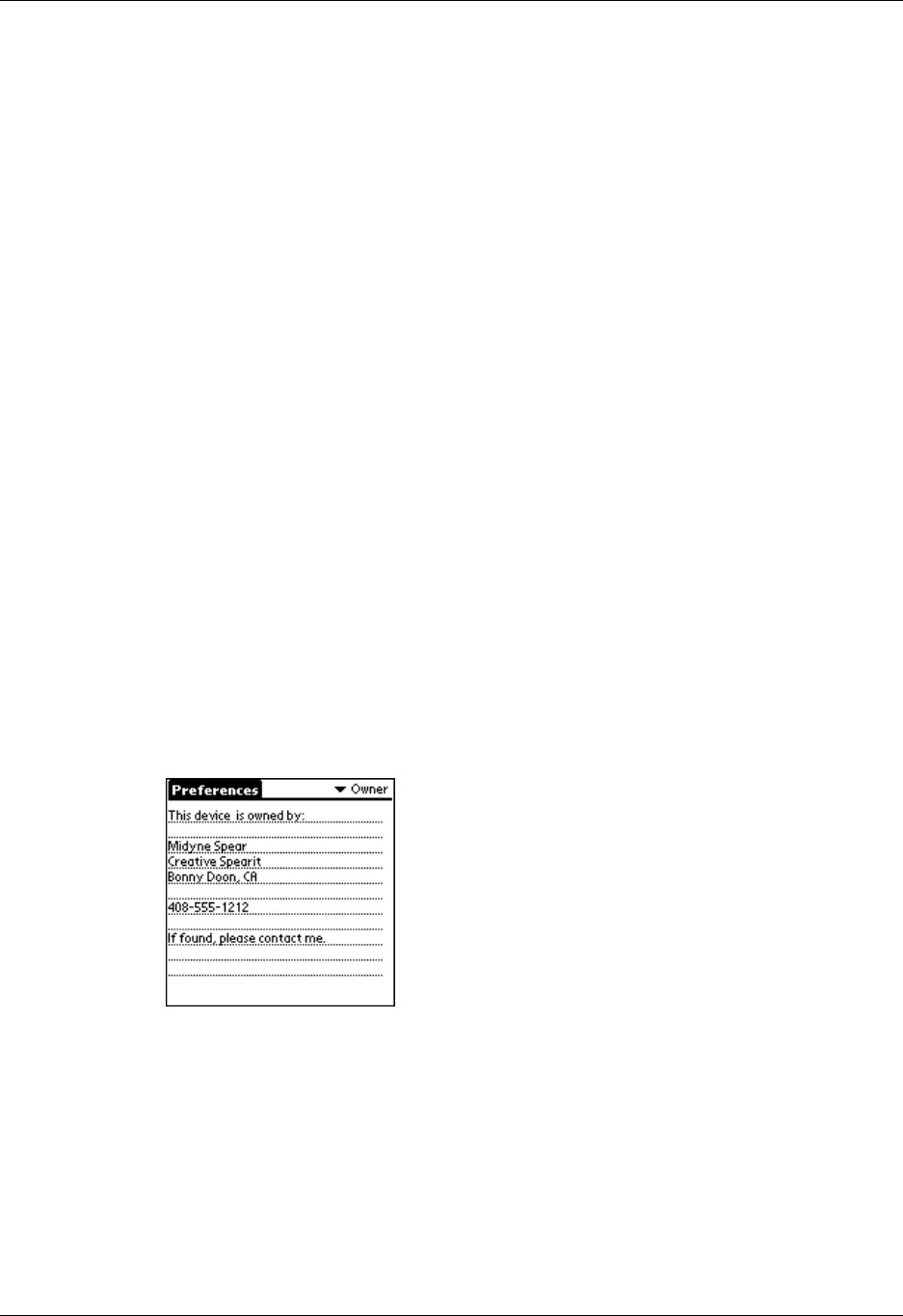
Setting Preferences for Your Handheld
194
To view the Network Log:
1. Tap Options, and then tap View Log.
2. Tap the up and down arrows of the scroll bar to see the entire Network Log.
3. Tap Don e.
Adding a DNS number
If your ISP or dial-in server requires a DNS number and you did not enter that
information in the Network Preferences screen, it will appear that you successfully
logged into your network. When you try to use an application or look up
information, however, the connection fails. If this occurs, try adding a DNS
number. Ask your ISP or your System Administrator for the correct Primary and
Secondary DNS IP numbers.
Owner preferences
The Owner Preferences screen enables you to record a name, company name,
phone number, or any other information that you want to associate with your
handheld.
If you use the Security application to turn off and lock your handheld with a
password, information that you put in the Owner Preferences displays the next
time you turn on your handheld. See Chapter 13 for information about security.
To enter the Owner preferences:
■Enter the text that you want to associate with your handheld in the Owner
Preferences screen. If you enter more text than can fit on one screen, a scroll bar
automatically appears on the right side of the screen.
If you assign a password with the Security application, the information in the
Owner Preferences screen cannot be changed. In this case, an Unlock button
appears at the bottom of the screen.
To unlock the Owner Preferences screen:
1. Tap Unl o ck.
2. Enter the password that you defined in the Security application.
3. Tap OK.
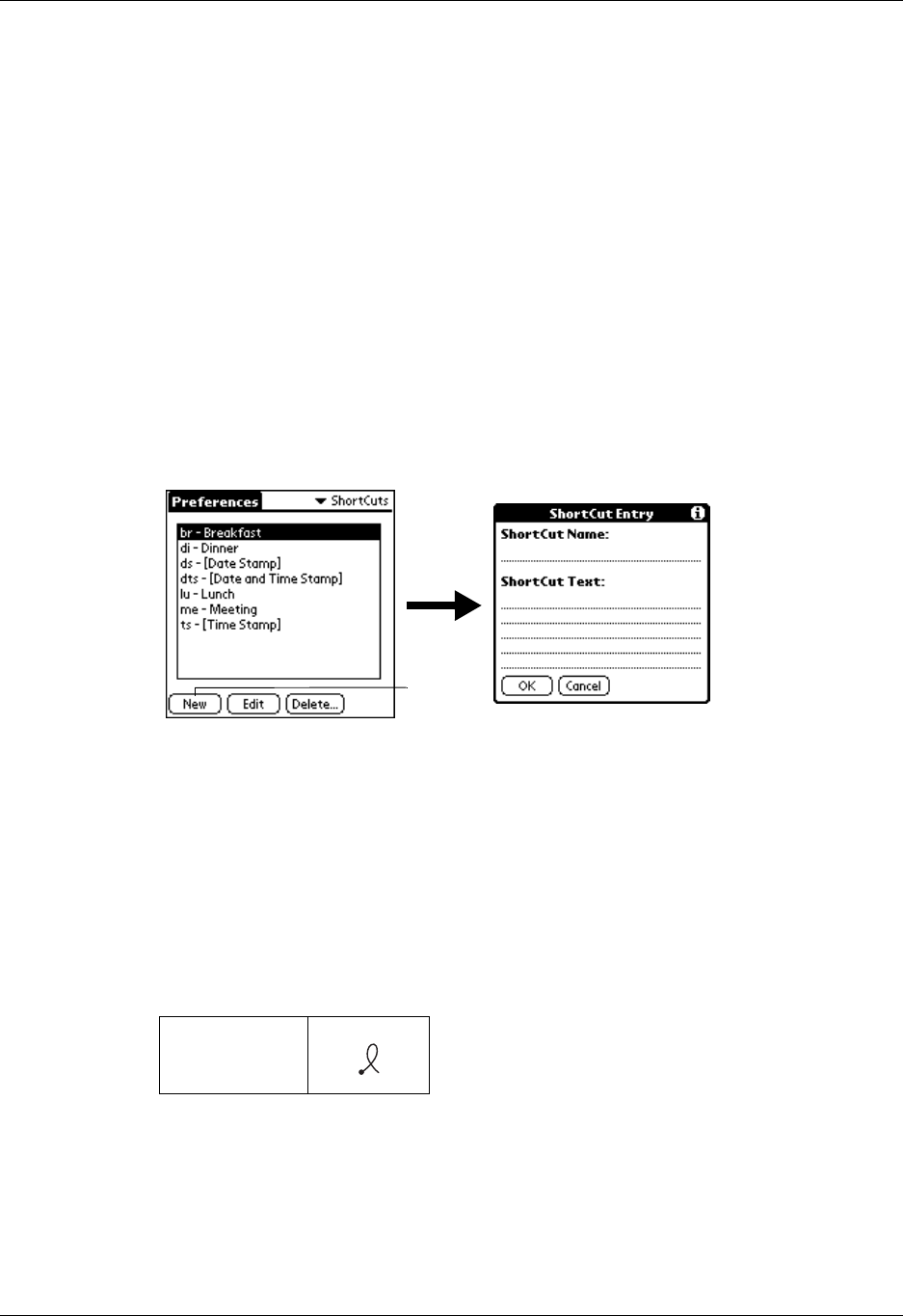
Viewing Preferences
195
ShortCuts preferences
The ShortCuts Preferences screen enables you to define abbreviations for entering
text with Graffiti strokes. This section describes how to create, edit, and delete a
ShortCut.
Creating a ShortCut
You can create a ShortCut for any words, letters, or numbers. All ShortCuts you
create appear on the list in the ShortCut Preferences screen. All the ShortCuts are
available in any of your handheld applications and are backed up on your
computer when you perform a HotSync® operation.
To create a ShortCut:
1. Tap N ew.
2. On the ShortCut name line, enter the letters you want to use to activate the
ShortCut.
3. Tap the ShortCut Text area and enter the text that you want to appear when you
write the ShortCut characters.
TIP You may want to add a space (space character) after the last word in your
ShortCut text. This way, a space automatically follows the ShortCut text.
4. Tap OK.
To use a ShortCut, draw the ShortCut stroke followed by the ShortCut
characters. When you draw the ShortCut stroke, the ShortCut symbol appears
at the insertion point to show that you are in ShortCut mode.
Editing a ShortCut
After you create a ShortCut, you can modify it at any time.
ShortCut
Ta p N e w

Setting Preferences for Your Handheld
196
To edit a ShortCut:
1. Tap the ShortCut you want to edit.
2. Tap Edit.
3. Make the changes you want and tap OK.
Deleting a ShortCut
If you no longer need a ShortCut, you can delete it from the list of ShortCuts.
To delete a ShortCut:
1. Tap the ShortCut you want to delete.
2. Tap Delete.
3. Tap Yes.

197
APPENDIX A
Maintaining Your Handheld
This chapter provides information on the following:
■Proper care of your handheld
■Prolonging battery life
■Resetting your handheld
Caring for Your Handheld
Your handheld is designed to be rugged and reliable and to provide years of
trouble-free service. Please observe the following general tips when using your
handheld:
■Take care not to scratch the screen of your handheld. Keep the screen clean.
When working with your handheld, use the supplied stylus or plastic-tipped
pens intended for use with a touch-sensitive screen. Never use an actual pen or
pencil or other sharp object on the surface of the handheld screen.
■Your handheld is not waterproof and should not be exposed to rain or moisture.
Under extreme conditions, water may enter the circuitry through the front
panel buttons. In general, treat your handheld as you would a pocket calculator
or other small electronic instrument.
■Take care not to drop your handheld or subject it to any strong impact. Do not
carry your handheld in your back pocket: if you sit on it, you may damage it.
■Protect your handheld from temperature extremes. For example, do not leave
your organizer on the dashboard of a car on a hot day or on a day when
temperatures are below freezing, and keep it away from heaters and other heat
sources.
■Do not store or use your handheld in any location that is extremely dusty, damp,
or wet.
■Use a soft, damp cloth to clean your handheld. If the surface of the handheld
screen becomes soiled, clean it with a soft cloth moistened with a diluted
window-cleaning solution.
Battery Considerations
Please note the following considerations for the battery in your handheld:

Maintaining Your Handheld
198
■Under normal conditions, your handheld battery should remain charged by
placing it in the cradle for just a few minutes each day. You can conserve battery
life by minimizing the use of the backlight feature, and changing the Auto-off
setting that automatically turns the handheld off after a period of inactivity. See
“Auto-off delay” in Chapter 17 for more information.
■If the battery becomes low in the course of normal use, an alert appears on the
handheld screen describing the low battery condition. If this alert appears,
perform a HotSync® operation to back up your data; then leave your handheld
in the cradle to recharge the unit. This helps prevent accidental data loss.
■ If the battery drains to the point where your handheld does not operate, it
stores your data safely for about a week. In this case, there is enough residual
energy in the battery to store the data, but not enough to turn on your handheld.
If your handheld does not turn on when you press the power button, you
should recharge the unit immediately.
■If your battery drains and you have the unit in an uncharged state for an
extended period of time, you can lose all of the stored data.
■There are no serviceable parts inside your handheld, so do not attempt to open
the unit.
■If you ever dispose of your handheld, please dispose of it without damaging the
environment. Take your handheld to your nearest environmental recycling
center.
Resetting Your Handheld
Under normal circumstances, you will not have to use the reset button. On rare
occasions, however, your handheld may no longer respond to buttons or the
screen. In this case, you need to perform a reset to get your handheld running
again.
Performing a soft reset
A soft reset tells your handheld to stop what it’s doing and start over again. All
records and entries stored in your handheld are retained with a soft reset. After a
soft reset, the Welcome screen appears, followed by the Date and Time Preferences
screen (to set date and time).
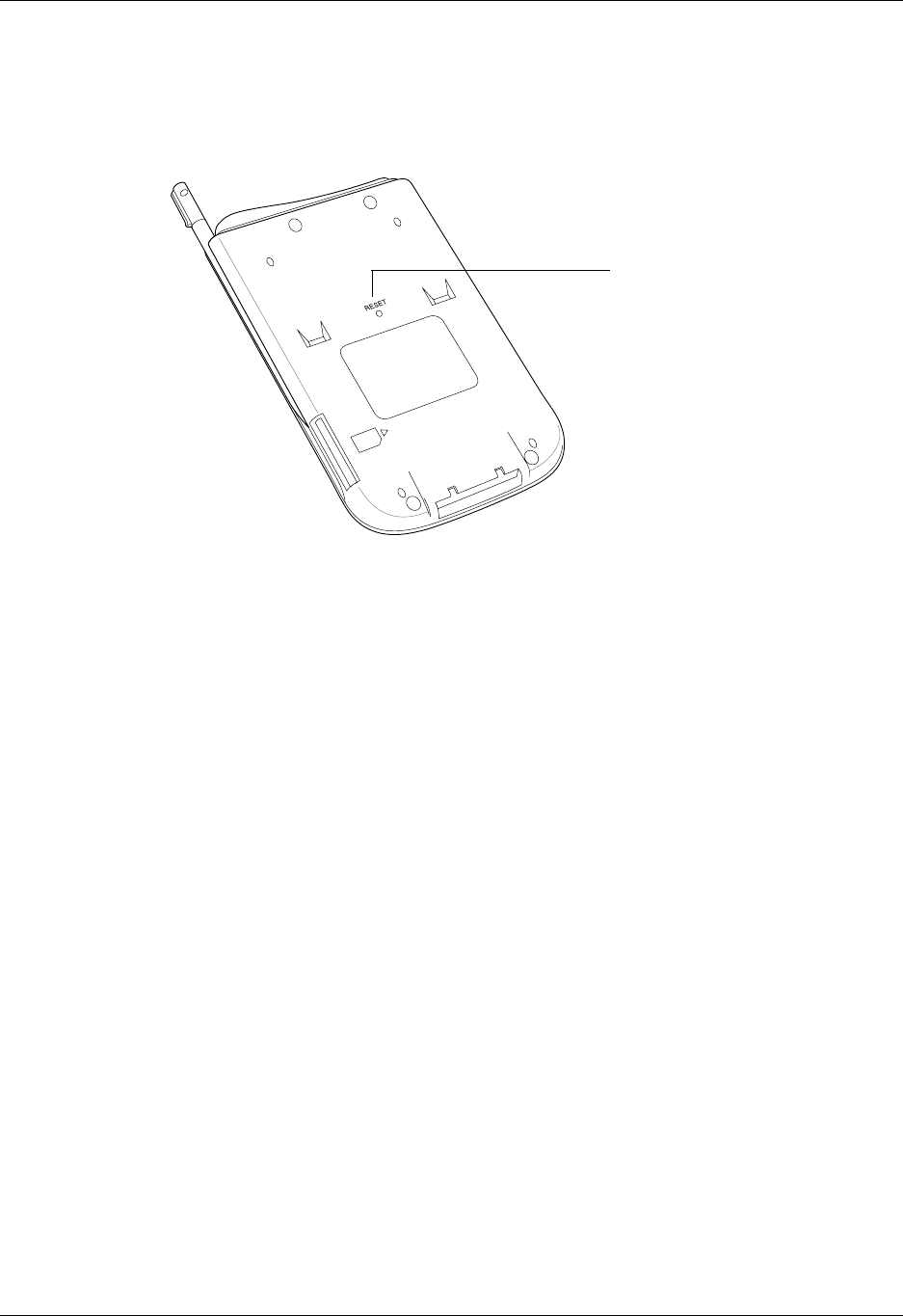
Resetting Your Handheld
199
To perform a soft reset:
■Use the reset tip tool, or the tip of an unfolded paper clip (or similar object
without a sharp tip), to gently press the reset button inside the hole on the back
panel of your handheld.
TIP The metal and plastic stylus that comes with your handheld has a reset tip
inside. To use it, unscrew the metal barrel from the stylus quill.
Performing a hard reset
With a hard reset, all records and entries stored in your handheld are erased. Never
perform a hard reset unless a soft reset does not solve your problem.
NOTE You can restore any data previously synchronized with your computer during
the next HotSync operation.
To perform a hard reset:
1. Hold down the power button on the front panel of the handheld.
2. While holding down the power button, use the reset tip tool, or the tip of an
unfolded paper clip (or similar object without a sharp tip) to gently press and
release the reset button.
3. Wait for t h e Palm™ logo to appear; then release the power button.
4. When a message appears on the handheld screen warning that you are about to
erase all the data stored on your handheld, do one of the following:
Press the upper half of the scroll button on the front panel of the handheld to
complete the hard reset and display the Digitizer screen.
Press any other button to perform a soft reset.
Reset button
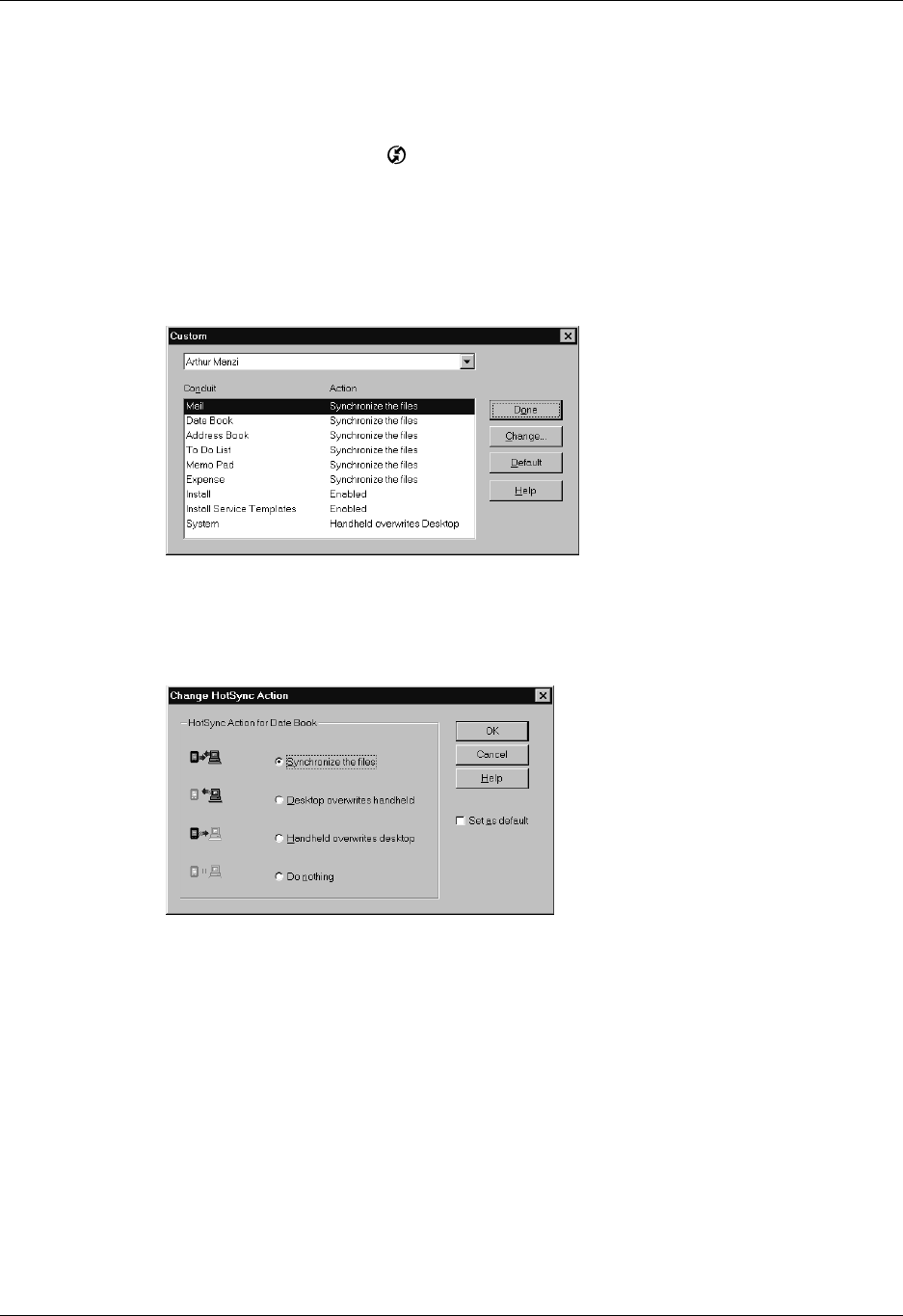
Maintaining Your Handheld
200
NOTE With a hard reset, the current date and time are retained. Formats
Preferences and other settings are restored to their factory default settings.
To restore your data from a Windows computer after a hard reset:
1. Click the HotSync icon ™ in the Windows system tray (bottom-right corner of
the taskbar).
You can also click the HotSync command on the Palm Desktop software menu
bar.
2. From the HotSync Manager menu, choose Custom.
3. Select the appropriate user name from the list.
4. Select an application in the Conduit list.
5. Click Change.
6. Select Desktop overwrites handheld.
NOTE Changing the HotSync setting from the default affects only the next
HotSync operation. Thereafter, the HotSync Actions revert to their default
settings. To use a new setting on an ongoing basis, select the Set As Default
box. Thereafter, whatever you selected as the default setting is used when you
click the Default button in the Custom dialog.
7. Click OK.
8. Repeat steps 4 through 7 to change conduit settings for other applications.
9. Click Done to activate your settings.
10. Perform a HotSync operation.
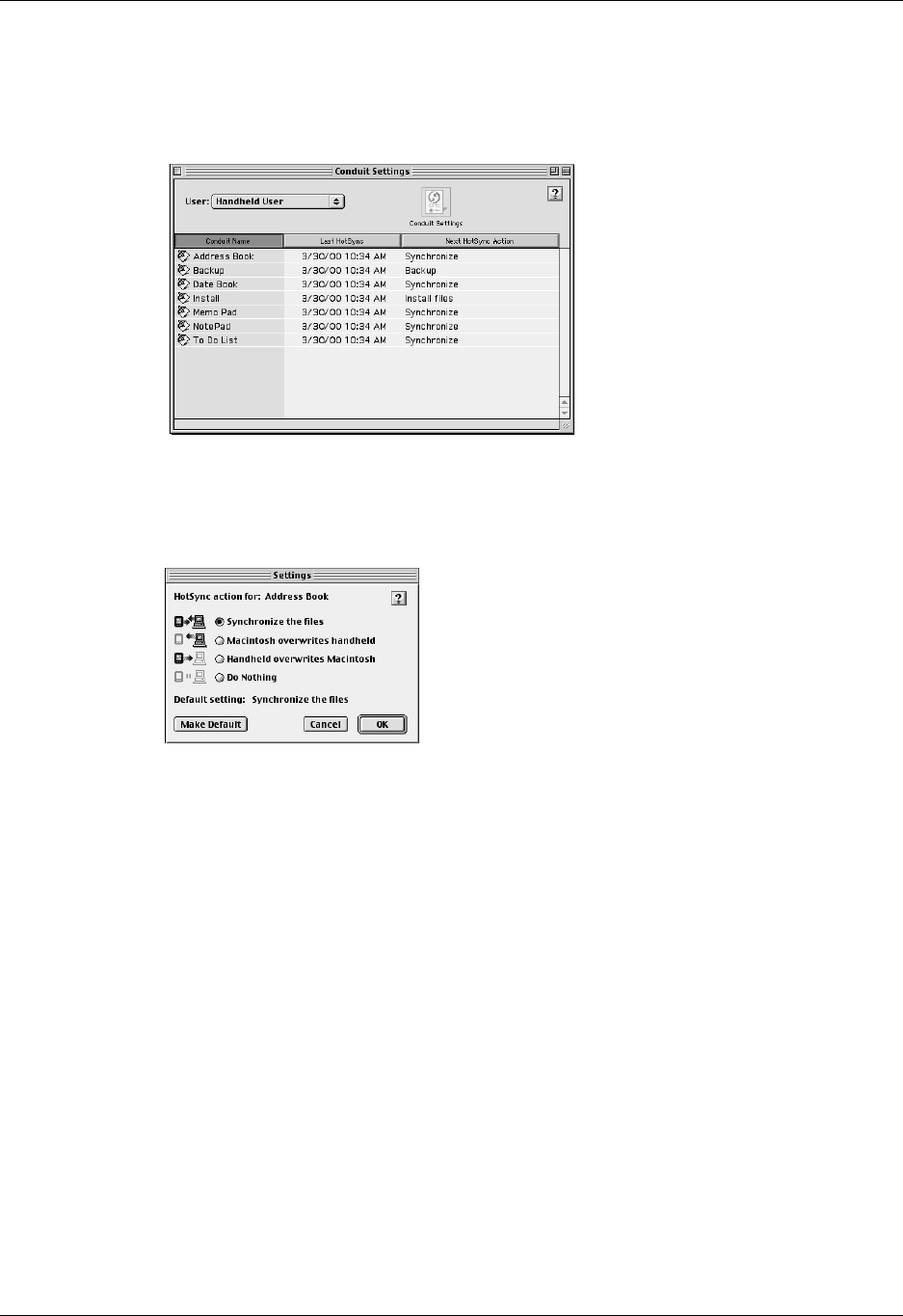
Resetting Your Handheld
201
To restore your data from a Macintosh after a hard reset:
1. Double-click the HotSync Manager in the Palm folder.
2. From the HotSync menu, choose Conduit Settings.
3. From the Users pop-up menu, select the appropriate user name.
4. Select an application from the list.
5. Click Conduit Settings.
6. Click Macintosh overwrites handheld.
NOTE Changing the HotSync setting from the default affects only the next
HotSync operation. Thereafter, the HotSync Actions revert to their default
settings. To use a new setting on an ongoing basis, click Make Default.
Thereafter, whatever you selected as the default setting is used for HotSync
operations.
7. Click OK.
8. Repeat steps 4 through 7 to change conduit settings for other applications.
9. Close the Conduit Settings window.
10. Perform a HotSync operation.

Maintaining Your Handheld
202

203
APPENDIX B
Frequently Asked Questions
If you encounter a problem with your handheld, do not call Technical Support
until you have reviewed the following list of frequently asked questions, and you
have also reviewed the following:
■The README file located in the folder where you installed the Palm™ Desktop
software on Windows your computer or on your installation CD for Macintosh
users
■The Palm Desktop online Help
■The Palm Desktop software for the Macintosh User’s Guide located in the
Documentation folder on your installation CD
■The “Palm Support Assistant” knowledgebase, accessible at www.palm.com
under the Support section
■The most recent Palm™ i705 handheld HelpNotes on your regional web site
If you are still having problems, contact Technical Support. See the Customer
Support card that comes with your handheld, or go to www.palm.com.
NOTE Thousands of third-party add-on applications have been written for the Palm
OS® handhelds. Unfortunately, we are not able to support such a large number of
third-party applications. If you are having a problem with a third-party application,
please contact the developer or publisher of that software.

Appendix B Frequently Asked Questions
204
Software Installation Problems
The Palm Desktop Installer Menu
did not appear when I inserted
the CD-ROM into my Windows
computer.
1. Click the Start button.
2. Choose Run from the Start menu.
3. Click Browse.
4. Locate your CD-ROM drive and select the Setup.exe file.
5. Click Open.
6. Click OK.
I cannot install Palm Desktop
software on my Windows
computer.
Try the following:
1. Disable any virus scanning software on your computer.
2. Press CTRL-ALT-DELETE and end all tasks except Systray and
Explorer.
If a dialog with buttons appears instead of a list of tasks,
click the Task List button and then end all tasks except
Systray and Explorer.
3. Make sure your computer has at least 30 MB of disk space
available.
4. Delete all temporary files.
5. Run ScanDisk on your computer.
6. Reinstall Palm Desktop software.
I cannot install Palm Desktop
software on a Macintosh.
Try the following:
1. Disable any virus scanning software on your Macintosh.
2. Quit any open applications.
3. Make sure your computer has at least 25 MB of disk space
available.
4. Reinstall Palm Desktop software.

Operating Problems
205
Operating Problems
don’t see anything on my
handheld’s screen. Try each of these in turn:
■Press an application button to ensure your handheld is
turned on.
■Tap the Contrast icon in the upper-right corner of the
Graffiti® writing area, if your handheld supports contrast
adjustment (available on some models). If the Contrast
dialog box appears, adjust the contrast by holding down the
up scroll button for a few seconds. If this doesn’t work, hold
the down scroll button for a few seconds.
■If your handheld was exposed to cold, make sure it is at
room temperature.
■Recharge the unit.
■Perform a soft reset. If your handheld still doesn’t turn on,
perform a hard reset. See “Resetting Your Handheld” in
Appendix A.
IMPORTANT With a hard reset, all records and entries stored
in your handheld are erased. Never perform a hard reset
unless a soft reset does not solve your problem. You can
restore any data previously synchronized with your computer
during the next HotSync® operation. See the online Handbook
for instructions on restoring your data.
I get a warning message telling me
my handheld memory is full.
■Purge records from Date Book and To Do List. This deletes
To Do List items and past Date Book events from the
memory of your handheld. See “Purging records” in
Chapter 5. You may need to perform a HotSync operation to
recover the memory.
■Delete unused memos and records. If necessary, you can
save these records. See “Deleting records” in Chapter 5.
■If you have installed additional applications on your handheld,
remove them to recover memory. See “Removing applications” in
Chapter 5.
My handheld keeps turning itself off. Your handheld is designed to turn itself off after a period of
inactivity. This period can be set at one, two, or three minutes.
Check the Auto-off setting. See “Auto-off delay” in Chapter 17.
My handheld is not making any
sounds. Check the System, Alarm and Game Sound settings. See
“System, alarm, and game sounds” in Chapter 17.

Appendix B Frequently Asked Questions
206
Tapping and Writing Problems
My handheld’s indicator light is not
blinking when alarms occur. Check the Alarm indicator light setting.See “Alarm vibrate and
indicator light settings” in Chapter 17.
My handheld does not vibrate when
alarms occur. Check the Alarm Vibrate setting. See “Alarm vibrate and
indicator light settings” in Chapter 17.
My handheld has frozen. Perform a soft reset. See “Resetting Your Handheld” in
Appendix A.
When I tap the buttons or screen
icons, my handheld activates the
wrong feature.
Calibrate the screen. See “Digitizer preferences” in Chapter 17.
When I tap the Menu icon ,
nothing happens. Not all applications or screens have menus. Try changing to a
different application.
I can’t get my handheld to recognize
my handwriting.
■For your handheld to recognize handwriting input with the
stylus, you need to use Graffiti writing. See “Using Graffiti
Writing to Enter Data” in Chapter 3.
■Make the Graffiti character strokes in the Graffiti writing
area, not on the display part of the screen.
■Write Graffiti strokes for letters in the left-hand side, and the
strokes for numbers in the right-hand side of the Graffiti
writing area.
■Make sure that Graffiti is not shifted into extended or
punctuation modes. See “Using Graffiti Writing to Enter
Data” in Chapter 3.
■See “Graffiti tips” in Chapter 3 for tips on increasing your
accuracy when you write Graffiti characters.

Wireless Problems
207
Wireless Problems
The signal strength is weak. You can monitor the transmission signal strength using the
Signal Strength bar graph and text message on the Wireless
Preferences screen. See “Monitoring the transmission signal”
in Chapter 4 for more information. Monitor the signal strength
while you try the following solutions:
■Move away from your original location, five to ten feet in
any direction.
■If you’re indoors, stand near a window, or move outdoors.
■Open metal blinds on windows.
■If you’re in an underground parking lot or other space
below street level, move to a location above ground.
■If you’re in a crowd, move to a less crowded area.
■If you’re in a vehicle, keep your handheld level with the
windshield. The metal frame of the vehicle shields radio
signals. Mountains and buildings may also block signals.
If you’re outdoors, move away from overhead electrical wires.
Move from under trees.
I can’t access the network. ■Check the battery icon to verify the battery is charged. See
“Step 2: Charge your Handheld” in Chapter 1.
■Make sure the radio is on and within range by verifying the
indicator light is flashing green. See “Using the indicator
light” in Chapter 4.
■Verify that the signal strength indicator on the radio panel
shows a strong signal. See “Monitoring the transmission
signal” in Chapter 4.
■The network may be down. Try again later.
I can’t access a web clipping
application.
■Make sure the radio is on and within range by verifying the
indicator light is flashing green. See “Using the indicator
light” in Chapter 4.
■Try to access the MyPalm by pressing the Wireless button.
– If you can access the MyPalm application, network
service is available. It may be that the web clipping
server currently is not accessible. Try again later.
– If you cannot access the MyPalm application, network
service may be down. Try again later.
■For questions and support for third-party web clipping
applications, please contact the software developer directly.

Appendix B Frequently Asked Questions
208
Application Problems
HotSync problems
I tapped the Today button, but it
does not show the correct date. Your handheld is not set to the current date. Make sure the Set
Date box in the Date and Time Preferences screen displays the
current date. See “Date and Time preferences” in Chapter 17
for more information.
I know I entered some records, but
they do not appear in the
application.
■Check the Categories pick list (upper-right corner). Choose
All to display all of the records for the application.
■Check Security and confirm that Private Records is set to
Show private records.
■In To Do List, tap Show and see if Show Only Due Items is
selected.
I am having problems listing memos
the way I want to see them.
■If you cannot manually arrange the order of the memos in
the list screen, check the Memo Preferences setting. Make
sure that Sort by is set to Manual.
■If you choose to view your memos alphabetically on Palm
Desktop software and then perform a HotSync operation,
the memos on your handheld still appear in the order
defined in the Memo Preferences setting. In other words, the
sort settings you use with Palm Desktop software are not
transferred to your handheld.
I created an event in Date Book, but
it doesn’t appear in the Week View. In the Week View, you cannot select overlapping events that
have the same start time. If you have two or more events with
the same start time, choose the Day View to see the overlapping
events.

HotSync problems
209
I cannot do a HotSync operation;
what should I check to make sure I
am doing it correctly?
■Make sure the HotSync cradle is connected securely.
On a Windows computer try these steps:
■Check the Windows system tray to make sure the HotSync
Manager is running. If it is not, open Palm Desktop
software.
■Make sure you selected Local USB or Local Serial, as
appropriate, from the HotSync Manager menu.
■If you are using the serial cradle, make sure you selected the
correct serial port on the Local tab in the Setup dialog. It
should be set to the port where you connected the HotSync
cradle.
On a Macintosh try these steps:
■Make sure HotSync Manager is enabled. If it is not, double-
click the HotSync Manager icon in the Palm folder and
enable HotSync Manager on the HotSync Controls tab.
If you are using the optional serial cradle, double-click the
HotSync Manager icon in the Palm folder and then click the
Serial Port Settings tab. Make sure Local is selected and that the
port selection matches the port where your HotSync cradle is
attached.
I did a HotSync operation, but one of
my applications did not
synchronize.
■On a Windows computer, click the HotSync Manager and
choose Custom. Check that the correct conduit is active.
■On a Macintosh, double-click the HotSync Manager icon.
From the HotSync menu, choose Conduit Settings. Select
your user name from the User pop-up menu, and check that
the correct conduit is active.
I am using Outlook as my PIM, but I
cannot do a HotSync operation.
■Click the HotSync Manager and choose Custom. Check that
the correct conduit is active.
■Check that the correct conduit is installed. Reinstall the HotSync
Manager and make sure the correct conduit is selected.
I cannot launch the HotSync
Manager.
■If you are using the optional serial cradle, or if you are
performing a HotSync operation using a modem, make sure
you are not running another program, such as America
Online, that uses the serial port you selected in the Setup
dialog box.
■Backup the Palm Desktop software, uninstall it, then
reinstall it.

Appendix B Frequently Asked Questions
210
I tried to do a local HotSync
operation, but it did not complete
successfully.
■Make sure your handheld is seated in the cradle correctly.
■Check the connection between the HotSync cradle and the
USB or serial port on your computer.
■Make sure the user name you selected in Palm Desktop
software matches the user name assigned to your handheld.
■Make sure the date on your computer matches the date on
your handheld.
■Read the HotSync Log for the user account for which you
are performing a HotSync operation
On a Windows computer, try each step in turn:
■Make sure HotSync Manager is running. If it is running,
close it, and restart it.
■Make sure you selected Local USB or Local Serial, as
appropriate, from the HotSync Manager menu.
■If you are using the serial cradle, make sure you selected the
correct serial port on the Local tab in the Setup dialog. It
should be set to the port where you connected the HotSync
cradle.
■If you are using the serial cradle, try a lower baud rate
setting on the Local tab in the Setup dialog.
■If you are using the serial cradle, make sure you aren’t
running a program, such as America Online, that uses the
serial port you selected in the Setup dialog box.
On a Macintosh, try each step in turn:
■Make sure HotSync Manager is enabled on the HotSync
Controls tab in the HotSync Software Setup window.
■If you are using the optional serial cradle, make sure you
selected Local on the Serial Port Settings tab in the HotSync
software settings window, and that the Local Setup port
matches the port where your HotSync cradle is connected.
■If you are using the optional serial cradle, try a lower Speed
setting on the Serial Port Settings tab
■If you are using the optional serial cradle, make sure you aren’t
running a program, such as America Online, fax or telephony
software, or AppleTalk networking that uses the serial port you
selected in the Serial Port Settings tab

HotSync problems
211
I tried to do a modem HotSync
operation, but it did not complete
successfully.
Check the following on your computer:
■Make sure your computer is turned on and that it does not
shut down automatically as part of an energy-saving
feature.
■Make sure the modem connected to your computer is
turned on and is connected to the outgoing phone line.
■Make sure the modem you are using with your handheld
has an on-off switch. Your handheld cannot “wake up” a
modem that has an auto-off feature.
■Make sure the modem is connected properly to your
computer and is connected to the incoming phone line.
On a Windows computer, check the following:
■Make sure Modem is checked in the HotSync Manager menu.
■Confirm that the Setup String in the Setup dialog box
configures your modem correctly. You may need to select a
different Modem Type or enter a custom Setup String. Most
modems have a Setup String that causes them to send initial
connection sounds to a speaker. You can use these sounds to
check the modem connection.
■Confirm that the Speed setting in the Setup dialog box
works for your modem. If you have problems using the As
Fast As Possible option or a specific speed, try using a
slower speed.
■Make sure you are not running another program, such as
WinFax, CompuServe, or America Online that uses the
serial port you selected in the Setup dialog box.
■Make sure your modem resets before you try again. (Turn
off your modem, wait a minute, then turn it back on.)
On a Macintosh, check the following:
■Make sure Modem is selected on the Serial Port Settings tab in the
HotSync Software Setup window.
■You may need to select a different Modem type or enter a
Custom setup string on the Serial Port Settings tab. Most
modems have a setup string that causes them to send initial
connection sounds to a speaker. You can turn on the Modem
Speaker option and use these sounds to check the modem
connection.
■Make sure you are not running another program, such as
America Online, fax or telephony software, or AppleTalk
networking that uses the serial port you selected in the
Serial Port Settings tab

Appendix B Frequently Asked Questions
212
I tried to do a modem HotSync
operation, but it did not complete
successfully.
(continued)
■Make sure your modem resets before you try again. (Turn
off your modem, wait a minute, then turn it back on.)
Check the following on your handheld:
■Confirm that the telephone cable is securely attached to
your modem.
■Make sure the dialing instruction dials the correct phone
number.
■If you need to dial an outside line prefix, make sure you selected
the Dial Prefix option on your handheld and entered the correct
code.
■If the telephone line you are using has Call Waiting, make
sure you selected the Disable call waiting option under
Modem Sync Phone Setup on your handheld and entered
the correct code.
■Make sure the telephone line you are using is not noisy,
which can interrupt communications.
■Check the batteries in your modem and replace them if
necessary.
I can’t perform an IR HotSync
operation.
■On a Windows computer, be sure the HotSync Manager is
running and the Serial Port for local operations is set to the
simulated port for infrared communication. See “IR
HotSync Operations” in Chapter 16 for details.
■On a Macintosh, make sure the infrared communications
extensions have been installed in the Extensions folder
inside the System Folder. Next, open the HotSync Software
Setup window and be sure HotSync Manager is enabled
and that the Local Setup Port is set to Infrared Port. See “IR
HotSync Operations” in Chapter 16 for more information.
■On your handheld, be sure the HotSync application is set to
Local, with the option IR to PC/Handheld.
■Be sure the IR port of your handheld is aligned directly
opposite to, and within a few inches of, the infrared device
of your computer.
■IR HotSync operations do not work after you receive a low
battery warning. Check the battery power of your
handheld. Recharge the internal battery.
My handheld appears to freeze
when I place it near my computer. Move your handheld away from the computer’s infrared port.

HotSync problems
213
When I press the HotSync button on
the cradle, nothing happens on
Palm Desktop software and my
handheld times out
■Make a copy of your Palm folder. Uninstall, then reinstall
Palm Desktop software.
■Turn on your handheld and tap the Applications icon. Tap
the HotSync icon, then tap Local.
When I perform a HotSync
operation, my information does not
transfer to Palm Desktop software.
■If you have performed a HotSync operation successfully,
but you cannot find the data from your handheld on Palm
Desktop software, check to see you have the correct user
name selected for viewing data.
■On a Windows computer, click the HotSync Manager and
choose Custom. Check that all conduits are set to
synchronize files.
■On a Macintosh, double-click the HotSync Manager icon.
From the HotSync menu, choose Conduit Settings. Select
your user name from the User pop-up menu, and check that
the correct conduit is active.
My handheld displays the message
“Waiting for sender” when it’s near
my computer’s infrared port.
■Your computer’s infrared port may be set to search
automatically for the presence of other infrared devices.
Consult the documentation for your operating system for
information about turning off this option.
■In some cases, simply moving your handheld away from the
computer’s infrared port solves the problem.
I want to synchronize my computer
with more than one handheld.
■If the computer running Palm Desktop software
synchronizes with more than one handheld, each handheld
must have a unique name. Assign a user name to your
handheld the first time you perform a HotSync operation.
■Please be aware that synchronizing more than one
handheld with the same user name causes unpredictable
results and, potentially, loss of your personal information.

Appendix B Frequently Asked Questions
214
Beaming Problems
Recharging Problems
I cannot beam data to another Palm
OS handheld.
■Confirm that your handheld and the other Palm OS
handheld are between ten centimeters (approximately 4")
and one meter (approximately 39") apart, and that the path
between the two handhelds is clear of obstacles. Beaming
distance to other Palm OS handhelds may be different.
■ Move your handheld closer to the receiving handheld.
When someone beams data to my
handheld, I get a message telling me
it is out of memory.
■Your handheld requires at least twice the amount of
memory available as the data you are receiving. For
example, if you are receiving a 30K application, you must
have at least 60K free.
■Perform a soft reset. See “Performing a soft reset” in Appendix
A for more information.
When I place my handheld in the
cradle, the indicator light does not
go on.
■Confirm that your handheld is well seated in the cradle.
■Confirm that your recharger cable is properly connected to
the back of the cradle’s USB or serial port connector that
plugs into your computer.
■Confirm that your recharger is plugged into an AC outlet
that has power.
■If you have not used your handheld for a long period, such
as an extended vacation, the battery may not contain
enough charge to power the indicator light. After your
handheld has recharged, the indicator light will function
normally.

Password Problems
215
Password Problems
Technical Support
If, after reviewing the sources listed at the beginning of this appendix, you cannot
solve your problem, contact your regional technical support office by e-mail,
phone, or fax.
Before requesting support, please experiment a bit to reproduce and isolate the
problem. When you do contact support, please be ready to provide the following
information:
■The name and version of the operating system you are using
■The actual error message or state you are experiencing
■The steps you take to reproduce the problem
■The version of handheld software you are using and available memory
To find version and memory information:
1. Tap the Applications icon .
2. Tap the Menu icon .
3. Tap App, and then tap Info.
I forgot the password, and my
handheld is not locked.
■First, use the password hint to try and remember the
password. If this does not help, or if you do not have a
password hint, you can use Security to delete the password,
but your handheld deletes all entries marked as private.
However, if you perform a HotSync operation before you
delete the password: the HotSync process backs up all
entries, whether or not they are marked private. Then, you
can follow these steps to restore your private entries:
– Use the Palm Desktop software and the cradle or infrared
communication to synchronize your data.
– Tap Forgotten Password in Security to remove the
password and delete all private records.
–Perform a HotSync operation to synchronize your data and
restore the private records by transferring them from your
computer to your handheld.
I forgot the password and my
handheld is locked.
■First, use the password hint to try and remember the
password. If this does not help, or if you do not have a
password hint, you must perform a hard reset to continue
using your handheld. See “Performing a hard reset” in
Appendix A for more information.

Appendix B Frequently Asked Questions
216
NOTE Thousands of third-party add-on applications have been written for the
Palm OS handhelds. Unfortunately, we are not able to support such a large
number of third-party applications. If you are having a problem with a third-
party application, please contact the developer or publisher of that software.
4. Tap Version to see version numbers, and tap Size to see the amount of free
memory in kilobytes.

217
Product Regulatory Information
FCC Statement
This device complies with part 15 of the FCC rules. Operation is subject to the following two
conditions: (1) This device may not cause harmful interference, and (2) this device must accept any
interference received, including interference that may cause undesired operation.
NOTE This equipment has been tested and found to comply with the limits for a Class B digital device,
pursuant to Part 15 of the FCC rules. These limits are designed to provide reasonable protection against
harmful interference in a residential installation. This equipment generates, uses, and can radiate radio
frequency energy and, if not installed and used in accordance with the instructions, may cause harmful
interference to radio communications. However, there is no guarantee that interference will not occur in a
particular installation. If this equipment does cause harmful interference to radio or television reception,
which can be determined by turning the equipment off and on, the user is encouraged to try to correct the
interference by one or more of the following measures:
■Reorient or relocate the receiving antenna.
■Increase the separation between the equipment and receiver.
■Connect the equipment into an outlet on a circuit different from that to which the receiver is connected.
■Consult the dealer or an experienced radio/TV technician for help.
The use of shielded I/O cables is required when connecting this equipment to any and all optional
peripheral or host devices. Failure to do so may violate FCC rules.
CAUTION Changes or modifications not covered in this manual must be approved in writing by the
manufacturer’s Regulatory Engineering Department. Changes or modifications made without written
approval may void the user’s authority to operate this equipment.
FCC RF Exposure Information
In August 1996 the Federal Communications Commission (FCC) of the United States with its action
in Report and Order FCC 96-326 adopted an updated safety standard for human exposure to radio
frequency electromagnetic energy emitted by FCC regulated transmitters. Those guidelines are
consistent with the safety standard previously set by both U.S. and international standards bodies.
The design of this product complies with the FCC guidelines and these international standards.
Palm i705 Product Family
Tested to Comply
With FCC Standards
FOR HOME OR OFFICE USE
Responsible Party:
Palm, Inc.
5470 Great America Parkway
Santa Clara, California 95052
United States of America
(408) 326-9000
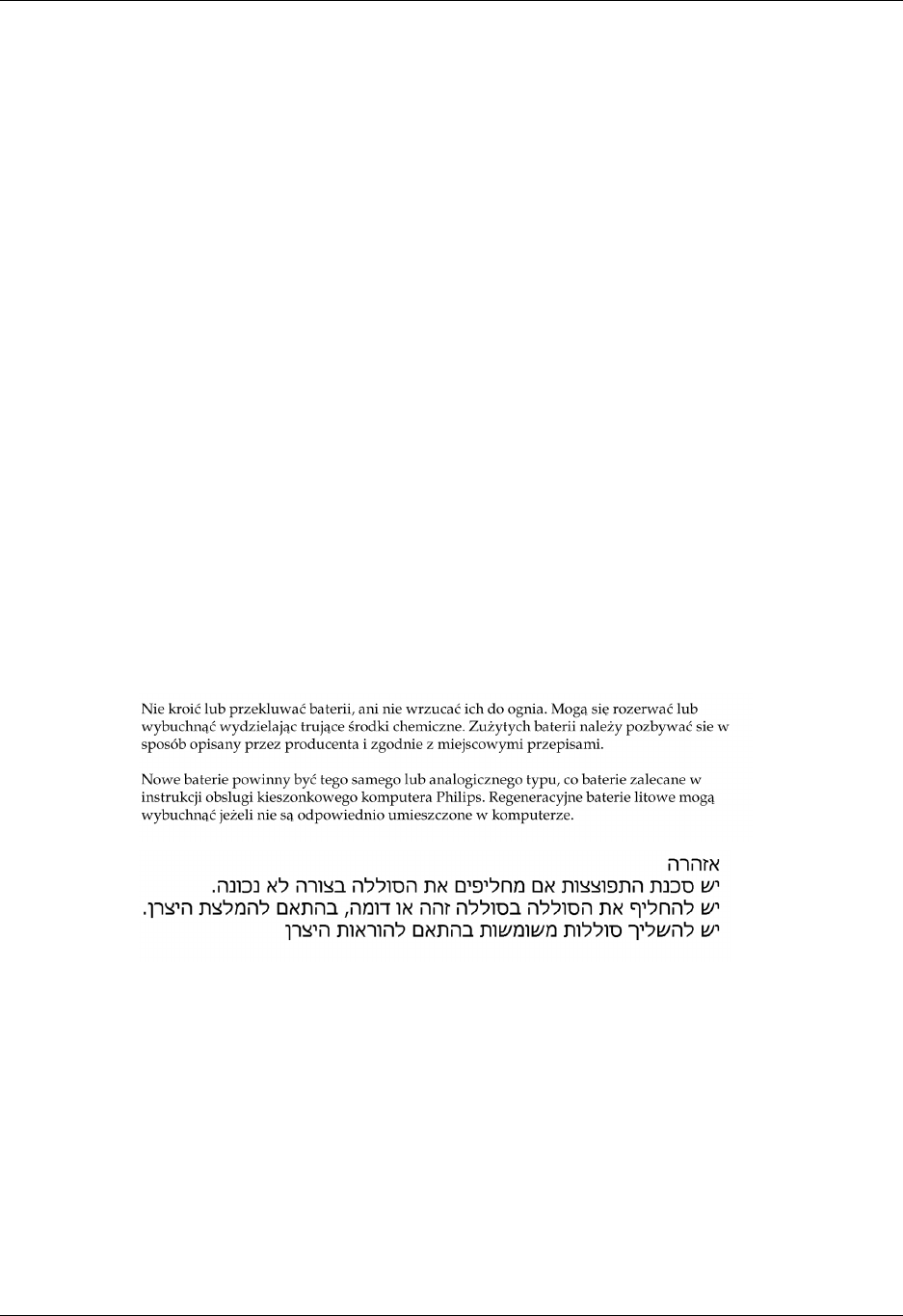
Product Regulatory Information
218
Battery Warning
Do not mutilate, puncture, or dispose of batteries in fire. The batteries can burst or explode, releasing
hazardous chemicals. Discard used batteries according to the manufacturer’s instructions and in
accordance with your local regulations.
Varning
Eksplosionsfara vid felaktigt batteribyte. Använd samma batterityp eller en ekvivalent typ som
rekommenderas av apparattillverkaren. Kassera använt batteri enligt fabrikantens instruktion.
Advarsel!
Lithiumbatteri—Eksplosionsfare ved fejlagtig håndtering. Udskiftning må kun ske med batteri af
samme fabrikat og type. Levér det brugte batteri tilbage tilleverandøren.
Varoitus
Paristo voi räjähtää, jos se on virheellisesti asennettu. Vaihda paristo ainoastaan valmistajan
suosittelemaan tyyppiin. Hävitä käytetty paristo valmistajan ohjeiden mukaisesti.
Advarsel
Eksplosjonsfare ved feilaktig skifte av batteri. Benytt samme batteritype eller en tilsvarende type
anbefait av apparatfabrikanten. Brukte batterier kasseres i henhold til fabrikantens instruksjoner.
Waarschuwing!
Bij dit produkt zijn batterijen geleverd. Wanneer deze leeg zijn, moet u ze niet weggooien maar
inleveren als KCA.
Uwaga

221
Index
A
ABA (Address Book archive file) 28
Accented characters
Graffiti writing 23
Add-on applications 67–71
Address Book
*If Found Call* entry 75
adding custom fields 77
adding e-mail address from 128
archive files (.aba) 28
business card for beaming 26
categorizing records 57
conduit for synchronizing 151
creating records 54, ??–75
deleting records 55
displaying category 77
displaying data in the Address list 76
finding records 60–61
fonts 65
menus 76
notes for records 65
opening 73
overview 73
private records 117
sorting records 63
Agenda (Date Book view) 99
Alarm
LED setting 178
lists 66
preset 101
setting in Clock 86
setting in Date Book 93
setting in Note Pad 108
sound 87, 101, 178, 205
vibrate setting 178
Alphabet
Graffiti writing 20
onscreen keyboard 14
Application buttons 11, 47, 73, 89, 174
Applications
Address Book 73
beaming 25–27
Calculator 79
categories 49
Clock 85
Date Book 89
font style 66
installing ??–71
Launcher 47–??, 48, ??–50
Memo Pad 103
Note Pad 107
opening 47
plug-in 192
preferences for 53
removing 71
security 111
size in kilobytes 215
To Do List 119
version of 215
viewing as icons 50
viewing as list 50
See also Add-on applications
Archive files
importing data from 28
for main applications 28
saving deleted records 56
saving purged records 57
Auto-off delay 177
Autotext. See Graffiti ShortCuts
B
Backlight 11, 175
Bar graph showing signal strength 35
Battery
conserving power 177
gauge 47
life and use 197
recycling 198
warning 218–219
Beaming

Index
222
information 25–27
location of IR port 10
pen stroke to activate 175
problems with 214
See also Infrared
Bold font for text 65
Business card for beaming 26
Buttons preferences 174
C
Calculator
buttons explained 79–80
memory 80
overview 79
recent calculations 79, 80
Calibration 13, 176
Call Waiting, disabling 164, 186
Calling card, using in phone settings 165,
186
Capital letters (Graffiti writing) 21
Caring for the handheld 197
Categories
application 49
assigning records to 57–58
beaming 25–26
creating 59
default 57
displaying 58, 77, 208
merging 60
renaming 59
using in Applications Launcher 49
Chain calculations 80
Characters, Graffiti 18
Check boxes 15
Clearing Calculator entries 79
Clipping. See Web clipping Applications
Clock
alarm 86
alarm preferences 87
display options 87
menus 86
opening 85, 86
Combining categories 60
Comma delimited files, importing data
from 28
Command
buttons 15
equivalents (Graffiti writing) 52
toolbar 52
Command stroke 27, 52, 63
Compressing Day view 101
Conduits
for modem HotSync operations 165
for synchronizing applications 209, 151–
152, 200, 201
for synchronizing applications,
Macintosh 153
Conflicting events 98
Connecting
service templates 187
to server or ISP 187
Connection
preferences 182
selecting for network 184
Continuous events
deleting from Date Book 56
scheduling 95
Contrast control 14
Copying
notes into other applications 107
text 55
Country default setting 176
Cradle
connecting to computer 12
for local HotSync operations 154, 160
viewing data from 177
Creating
Address Book entries 74–75
categories 49, 59
custom fields in Address Book 77
Date Book events 90
notes for records 64
records 54
To Do List items 119
Current date 208
Current time 47
Custom
fields in Address Book 77
Cutting text 55
Cycling through views 73, 89
D
Data entry. See Entering data
Date
displaying in Clock 87
setting current 179, 208

Index
223
Date Book
adding Address Book data to
records 62–63
Agenda view 99
alarm 93
archive files (.dba) 28
changing event time 93
changing event to untimed 93
conduit for synchronizing 151
conflicting events 98
continuous events 94–96
creating records 54, 90–93
Day view 96
deleting records 55
display options 101
displaying current time 97
end time for Day view 101
fonts 65
menus 100
Month view 98
notes for records 64–65
opening 89
overview 89
private records 117
purging records 56–57
repeating events 56, 94–96
scheduling events 90–93
selecting dates 91
start time for Day view 101
Sunday or Monday to start week 176
switching views 96
untimed events 90, 92
Week view 97, 177, 208
Dates
To Do List record due 121–122
Day
displaying in Clock 87
Day (Date Book view) 90, 101
DBA (Date Book archive file) 28
Decimal point 177
Default
categories 57
Deleted
data, saving in archive files 56
Deleting
applications 71
Desktop software 71
filter 143
Graffiti characters 20
passwords 112
records 55
service templates 192
text 55
See also Purging records
Desktop software
linking to external files 29
removing 72
saving deleted data to an archive file 56
Digitizer 13, 176
DNS (Domain Naming System) 189
Double-booked events 98
Dragging
memos into other applications 103
stylus to activate features 175
using the stylus 13
E
Editing
records 54–55
E-mail
address 128
composing 129
filters for 142–144
sending 44, ??–129
E-mail addresses
in Address Book 75, 76
Entering data 17–??
importing from other applications 28–30
problems with 206
using Note Pad 30
using the computer keyboard 27
using the onscreen keyboard 17
Entries. See Address Book
Euro
in Graffiti writing 23
in onscreen keyboard 18
Events. See Date Book
Exclamation marks in To Do List 123
Expansion
adding hardware 12
using cards 84
Expansion Card
applications 48
copying applications 50
formatting 84
renaming 83
External keyboard 31

Index
224
F
FCC Statement 217
Files, linking to external 29
Filters
creating 142
editing or deleting 143
turning on or off 143
Finding
applications, using Graffiti writing 48
information in applications 60
phone numbers 62–63
using the Find application 61
Fonts 65, 66
Formats preferences 176
Frequently asked questions (FAQs)
wireless problems ??–207
Frozen handheld 206
G
Games 178
General preferences 173
alarm LED setting 178
alarm sounds 178
alarm vibrate setting 178
auto-off delay 177
system sounds 178
Glossary. See Graffiti ShortCuts
Graffiti
accented characters 23
alphabet 18, 20
basic concepts 18
capital letters 21
Command stroke 52
how to write characters 19
menu commands 52
moving the cursor 24
numbers 22
online Help 55, 174
problems using 206
punctuation marks 22
ShortCuts for entering data 25, 195–196
symbols 23
tips 20
writing area 10, 19
Green indicator light 35
H
Hard reset 199, 205
Hardware add-ons 12
Help
Graffiti 55
online tips 15
Hiding records 116
History, in web clipping applications 43
HotSync
buttons preferences 175
conduits for synchronizing
applications 151–152, 200, 201
conduits for synchronizing applications,
Macintosh 153
customizing 152, 153
first-time operation 154–158, 169–171
IR operation 158–161
linking to external files 29
local operation 148, 154, 210
local operation on Macintosh 157
modem operation 148, 161–166, 211–212
modem settings 162
network operation 166–169
operations using cradle 160, 180
operations using IR port 160, 181–182
problems with 209–213
problems with IR 212
restoring data 200–201
setting options 147–148
using with another PIM 72
I
Icons
alarm 93
application 14, 50
note 65
online Tips 15
Over-the-air 40
repeating event 95
Security 46
Stop 41
Idle timeout of ISP or server connection 188
Importing data 28–30
Information
saving web clipping application 43–44
web clipping Internet 36
Infrared
connections 181

Index
225
HotSync operations 160, 181–182
port 10, 158
problems with IR HotSync
operations 212
requirements for computer 158
Initialization string 182
Installing
applications 67–71
conduit to install applications 151
International characters
Graffiti writing 23
Internet
reviewing queries 42–43
submitting queries 41
web clipping information from 36
IP address 187, 189
IR port
See also Beaming and Infrared
IR. See Infrared
IrCOMM 158, 181
IrDA (Infrared Data Association) 158
Items. See To Do List
K
Keyboard
computer 27
external 31
onscreen 14, 17, 175
L
LED alarm 178
Letters
font style 66
Graffiti 18, 20
onscreen keyboard 17
List, in Applications Launcher 50
Locking the handheld with a password 113–
115, 175, 194
Login scripts 190–192
Looking up Address Book data
to add to other records 62–63
scrolling in Address list 60
Lost
handheld, contact for 75
records 208
Lotus
Organizer, importing data from 28
M
Macintosh 190
Mail
adding Address Book data to records 62
Maintenance information 197
Memo Pad
adding Address Book data to
records 62–63
archive files (.mpa) 28
categorizing records 57
conduit for synchronizing 151
creating records 54
deleting records 55, 95
dragging memos into other
applications 103
fonts 65
menus 80, 104
opening 103
overview 103
private records 117
reviewing memos 104
sorting records 63, 208
Memory
amount of free 215
for beaming 214
Calculator 80
regaining 56, 205
Memos. See Memo Pad
Menus 51–53, 206
Address Book 76
choosing 52
command equivalents (Graffiti
writing) 52
command toolbar 53
Date Book 86, 100
Edit menu 54–55
Memo Pad 80, 104, 109
menu bar 14, 51
Network Preferences 193
To Do List 123
Microsoft
Outlook, connecting to 209
Modem
HotSync operations via 161–166, 211–
212
initialization string 182
Monday, to start week 177
Month (Date Book view) 98, 101

Index
226
Moving the cursor (Graffiti writing) 24
MPA (Memo Pad archive file) 28
MultiMail Deluxe
setting preferences for 144
MultiMediaCard
See also Expansion Card
MultiMediaCard 9
N
Network
connecting 187
connection type 188
HotSync operation 166–169
idle timeout 188
login scripts 190–192
password 184
phone settings 185
preferences 182–194
primary DNS 189
secondary DNS 189
selecting connection 184
selecting service 183
user name 183
Note Pad
alarm 108
copying notes into other
applications 107
entering data 30
menus 109
overview 107
reviewing notes 108
Notes, attaching to records 64–65
Numbers
decimal point and thousands
separator 177
Graffiti writing 22
onscreen keyboard 14, 17
O
Onscreen keyboard 17, 55
pen stroke to open 175
Opening
Address Book 73
applications 47
Calculator 79
Clock 85, 86
Date Book 89
Memo Pad 103
Organizer (Lotus PIM) 28
Outlook, connecting to 209
Overlapping events 98
Over-the-air icon 40, 46
Owner preferences 194
P
Pages (web clipping application)
saving text of 43
sending e-mail from 44
Passwords 111–115
changing 112
creating 111
deleting 112
for network 184
forgotten 115, 215
Pasting
notes into other applications 107
text 55
Pen stroke, full-screen 174–175
Peripheral hardware 12
Phone Lookup 62–63
Phone numbers
selecting for Address list 76
selecting types 75
Phone settings for ISP or dial-in server 185–
187
Pick lists 15
PIM (personal information manager)
using HotSync Manager with 72
Plug-in applications 192
Ports
IR on handheld 158
Power button 11
PPP 187
PRC (application file extension) 68, 192
Preferences
Buttons 174
choosing 53
Connection 182
cradle setting 177
Digitizer 176
Formats 176
General 173, 177
HotSync buttons 175
Network 182–194
Owner 194

Index
227
ShortCuts 195
Web Clipping 45
Preferences within applications
web clipping applications ??–45
Primary DNS 189
Prioritizing To Do List records 120, 123
Private records
displaying and creating 115–117, 208
lost with forgotten password 115
Profiles 169
Protection. See Security application
Proxy server changes 45
Punctuation marks
Graffiti writing 22
onscreen keyboard 17
Purging
records 56–57
See also Deleting
R
Radio
turning on 33
Range of times in Day view 101
Receiving data. See Beaming information
Reception 35
Recharging the battery 177
Records
beaming 25–26
choosing categories 57
creating 54
Date Book 90
defined 53
deleting 55, 95
displaying a category of 58
editing 54–55
fonts 65
hiding private 111, 116
lost 208
masking private 111
Memo Pad 103
notes for 64–65
number of 215
private 115–117
purging 56–57
sorting 63–64
To Do List 119
unmasking individual 117
Red indicator light 35–36
Reminder lists 66
Removing
applications 71
Desktop software 71
Renaming categories 59
Repeating events
deleting from Date Book 56
scheduling 95
Rescheduling events 93
Resetting handheld
hard reset 199, 205
location of reset button 12, 198
soft reset 198
Restoring data
Macintosh 201
Reviewing
stored web clippings 43
web clippings and queries 42–43
S
Saving
data 48, 54, 56
web clipping information 43
Scheduling events 90–93
Screen
backlight 11
blank 205
calibrating 13, 176
caring for 197
touching with your finger 11
Scroll
bar 15
button 11
SD card 9
See also Expansion Card
Searching. See Finding
Secondary DNS 189
Secure Digital card 9
See also Expansion Card
Security 111–115
changing password 112
deleting password 112
displaying owner’s name 194
forgotten password 115
private records 115–117
setting a password hint 111
unmasking individual records 117
Security application

Index
228
wireless transactions 46
Security icon 46
Selecting
date for event 91
phone numbers in Address Book 75
text 55
Sending
data. See Beaming information
Sending e-mail
entering address 128
Serial
port 148, 150, 151, 162, 163
Service
selecting for network 183
templates 187, 192
Settings. See Preferences
ShortCuts
backing up 151
managing 195–196
menu commands 52
predefined 25
using 25
Soft reset 198
Sorting
applications 49
records 63–64, 208
Sounds. See Alarm and System sounds
Starting applications 47
Stop icon 41
Stylus
dragging with 13
pen stroke to activate a feature 174
tapping with 12
Sunday, to start week 177
Symbols
in Graffiti writing 23
System
conduit 151
sounds 178
T
Tab delimited files, importing data from 28
Tapping 12
TCP/IP 182, 193
TDA (To Do List archive file) 28
Technical Support 203, 215
Text
copying 55
cutting 55
entry. See Entering data
files, importing data from 28, 29
fonts for 65
saving web clipping 43
selecting all 55
Thousands separator 177
Time
alarm setting 93
format 176
setting current 179
setting event 90
start and end for Date Book Day
view 101
Tips, online 15
To Do List
adding Address Book data to
records 62–63
archive files (.tda) 28
categorizing records 57, 123
checking off items 120
completed items 122
completion date 122
conduit for synchronizing 151
creating records 54, 119
deleting records 55, 95
due date 121–122, 123
fonts 65
menus 123
notes for records 64–65
overview 119
prioritizing records 120, 123
private records 117
purging records 56–57, 122
sorting records 63
Today. See Current date
Transmitting data. See Beaming information
Troubleshooting 212
Turning off handheld
automatically 177
pen stroke for 175
problems with 205
Turning on handheld
displaying owner’s name 194
power button 11
problems with 205
Turning radio on/off 33

Index
229
U
Undoing actions 55
Uninstalling Desktop software 71
Universal connector 12, 180
Unresponsive handheld 206
Untimed events 90, 92, 93, 94
User name
for ISP 183
identifying handheld 194
User profiles 169
V
VCal 28
VCard 28
Vibrate alarm 178
Views
Web Clipping Preferences 45
W
Web clipping applications
accessing 38
described 36
preferences screen 45
saving information from 43–44
working with 45
Web Clipping preferences 173
Web clippings
defining 36
example of 41–42
reviewing 42–43
Week (Date Book view) 97–98, 177, 208
Wireless button 33
Wireless security
for transactions 46
Wireless services
e-mail 44
problems with 207
Wireless transactions protection 46
Writing area 10
Writing. See Entering data

Index
230